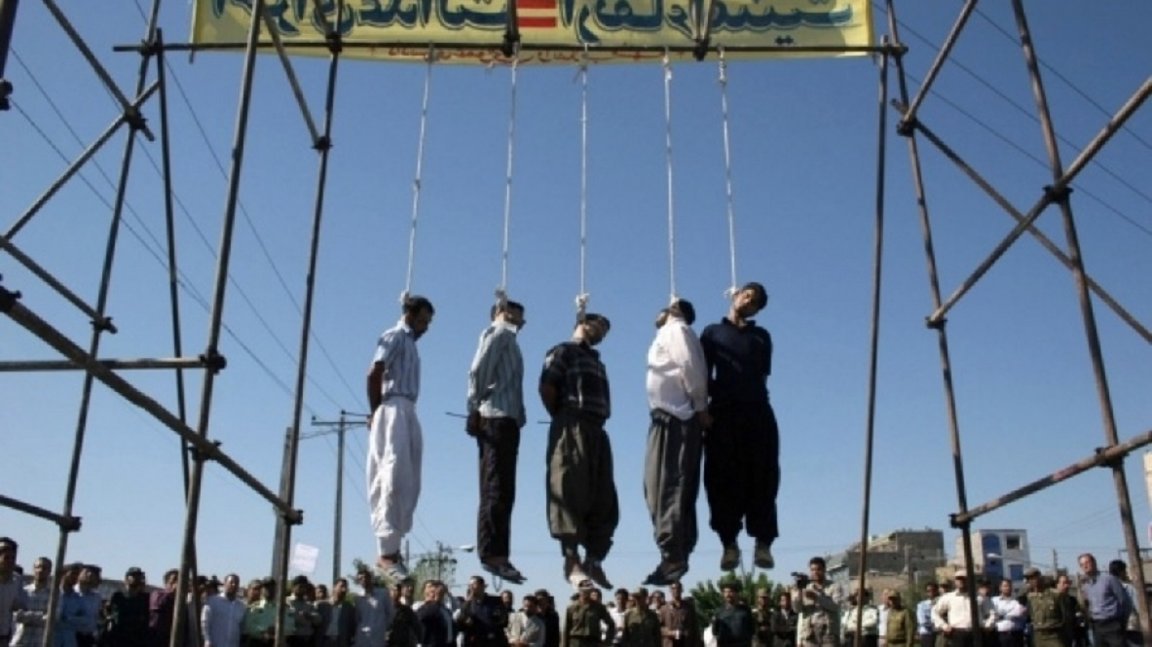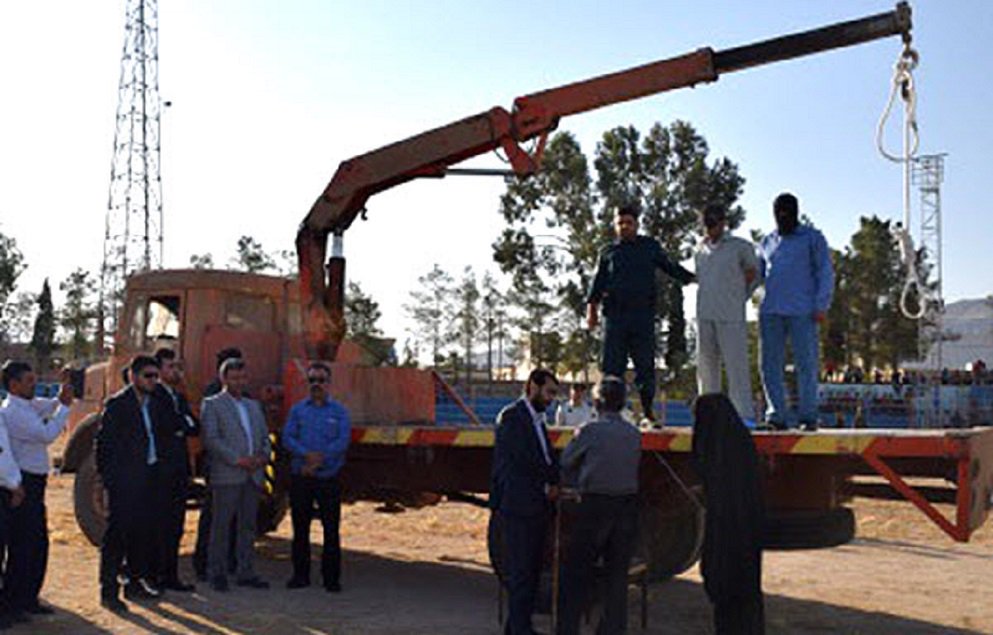ASIA - PACIFIC REGION ECONOMICS AND CONSUMER BEHAVIOUR.TRUMP'S INTERNATIONAL RATING REMAIN LOW,ESPECIALLY AMONG KEY ALLIES.ASIAN COUNTRIES HAVE LARGELY DISAGREE ON TRUMP'S POLICY.MAJORITIES ASIAN COUNTRIES ARE CONCERNED ABOUT NORTH'S KOREA'S NUCLEAR PROGRAM.
The population of the Asia-Pacific region is 4.2 billion, representing some 60% of the world's population. So while Asia's economic development promises an Asian Century, Asia has always dominated the world in terms of population.Asia has immense population diversity from countries like China (1.3 billion), India (1.2 billion), Indonesia (242 million), Pakistan (177 miilion), Bangladesh (150 million) and Japan (126 million) -- to small countries like Laos (6.3 million), Kyrgyzstan (5.4 million), Mongolia (2.8 million), Timor-Leste (1.2 million) to city states Hong Kong (7.1 million), Singapore (5.2 million) and Macao (0.6 million).The comparative political economy of East Asia, a highly dynamic region and one of critical importance to Australia's economic prosperity and security. It examines nine countries, including China, Japan, Korea, Singapore, Thailand, and Indonesia. Within these national settings, it focuses on government interventions in national economies and business involvement in politics, and activities that have helped to shape different rates of economic growth and political openness.One of the challenges commonly faced by those that work in or across the Asia Pacific region .if they are part of a US or European based organization – is to ensure their Head/Home office team understand some of the fundamental realities regarding the Asia Pacific region geography and diversity.When it comes to providing an Asia Pacific region overview the reality is there’s really no place called Asia, or Asia Pacific. It may well be that as part of a multinational organization the various markets in the region are consolidated together on one balance sheet, or it may be that there is an actual continent called “Asia” and one called “Australia” on the map, but that’s often as far as it’s possible to take the description.Companies may operate an Asia Pacific business region but the moment they forget this is theoretical only and does not actually exist, they are headed for trouble.While some definitions of Asia include the Middle East, a more common current definition takes the region from Pakistan in the west through to Japan in the east, and stretches south and south-east to Indonesia’s sprawling archipelago. It includes the former Soviet republics of Central Asia and much or Russia itself; the region of South Asia commonly describing India and the subcontinent; South East Asia which includes Thailand, Vietnam, Indonesia, Singapore, the Philippines; Greater China; and North Asia, often used to cover Japan and the Korean Peninsula.Using the term “Asia Pacific” signifies the inclusion of Australia and New Zealand, along with the Pacific Islands and states that cover a vast region from Micronesia through a list of exotic destinations as far as Tahiti.That rolls of the tongue very easily, but pause for a moment to reflect that what this describes is around half the world’s surface; half the world’s population; the world’s second and third largest economies (Japan and China); the world’s two most populous countries (China and India); the world’s most populous Islamic nation (Indonesia); and four known nuclear powers (Pakistan, India, China, and Russia with the jury still out about North Korea).But the Asia Pacific region diversity and complexity – and the perils of failing to really grasp the fact that Asia isn’t one relatively homogenous region – go so much deeper. But rather than being defeated by this, it’s possible to start to make some sense of the region by understanding just ten key concepts.Distances and travel times have a more significant impact than many realize. From Karachi in the west to Wellington in the east the Asia Pacific region has a time zone variance of up to 7 hours, and the travel distances and time to cover the region are significant. It’s an 8-10 hour flight to and from Australia’s largest cities of Sydney and Melbourne to Tokyo, Shanghai, or Bangkok. From the northern and eastern cities of Tokyo, Seoul, Shanghai or Beijing it can be 10 hours or longer to Mumbai or New Delhi, and completing the triangle from India to Australia commonly takes twice that time with a stopover somewhere.Even for a business person located within the region somewhere more central like Singapore, Hong Kong or Bangkok travel times and distances impact to a much greater extent than executives responsible for other regions.There is no common “Asian” culture or approach to business. The Asia Pacific region consists of many, widely diverse cultures with long histories and very little in common between them. This is reflected in many different ways, including in business.While there may be some overt similarities in the way some things are valued (such as education and personal relationships), it is a fundamental error to think there is any such thing as a common “Asian” culture, or that what you have learned as being appropriate in one part of the region is automatically the same elsewhere.Chinese officials like to talk about practicing “win-win” diplomacy. Their American counterparts sometime joke that this means China wins twice. From November 3 to November 14, Donald Trump will visit Japan, South Korea, Vietnam, the Philippines, and China, on the longest foreign trip of his presidency thus far. What can the Trump administration accomplish that would effectively address its priorities? What’s the likelihood of a significant breakthrough on trade, market access, or North Korean denuclearization? There is no common “Asian” culture or approach to business. The Asia Pacific region consists of many, widely diverse cultures with long histories and very little in common between them. This is reflected in many different ways, including in business.While there may be some overt similarities in the way some things are valued (such as education and personal relationships), it is a fundamental error to think there is any such thing as a common “Asian” culture, or that what you have learned as being appropriate in one part of the region is automatically the same elsewhere.
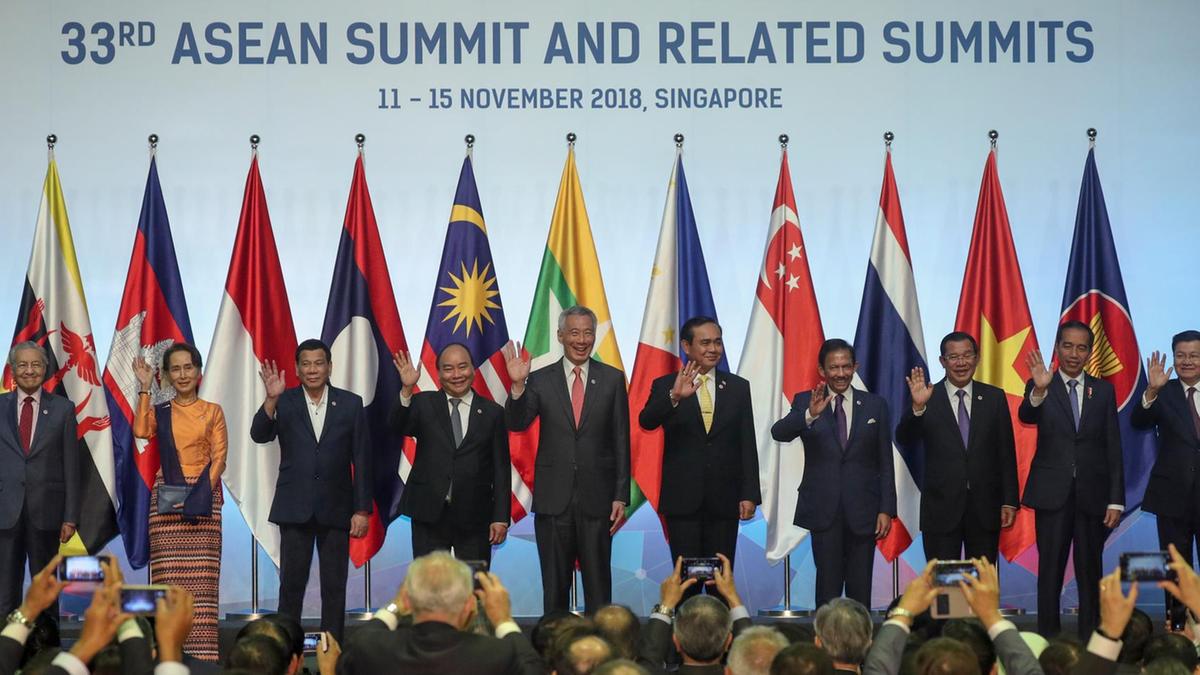 ASEAN leaders meet in Singapore as Beijing and Washington compete for investment influence.As Southeast Asian countries continue to fret over managing the perennial fear of a conflict in the South China Sea, they remain concerned about the geopolitical implications of drawing economically closer to China. Many, but not all, of these nations find appeal in a broad regional trade deal, but continue to see deals with the US as a better wager for their long-term security concerns.
ASEAN leaders meet in Singapore as Beijing and Washington compete for investment influence.As Southeast Asian countries continue to fret over managing the perennial fear of a conflict in the South China Sea, they remain concerned about the geopolitical implications of drawing economically closer to China. Many, but not all, of these nations find appeal in a broad regional trade deal, but continue to see deals with the US as a better wager for their long-term security concerns.
Asian cultures have long, proud histories. Modern China sees itself as the result of 3,000 years of unbroken civilization and culture. South Asia has a proud history of the glories of past empires and civilization stretching back to Alexander the Great and earlier. Marco Polo traversed the Silk Road of Central Asia to be amazed at the sophisticated technology he discovered.There is no common language across the region, other than English. Although Mandarin (China’s official language) is spoken by many people in Greater China and of Chinese heritage, it is a language not commonly used elsewhere in the region. Although they are the same in written form, there are many different spoken dialects in China, and a critical thing to remember is that character-based languages like Chinese require double-byte character capacity in software.Not only do languages differ across the region, the entire alphabet and writing style differs between, for example, Hindi, Thai, Japanese and Korean. English is without doubt the most common unifying language and is increasingly well studied and used, especially in business. However language still presents a major impediment to many, and is an additional layer of complexity.Asian cultures have long, proud histories. Modern China sees itself as the result of 3,000 years of unbroken civilization and culture. South Asia has a proud history of the glories of past empires and civilization stretching back to Alexander the Great and earlier. Marco Polo traversed the Silk Road of Central Asia to be amazed at the sophisticated technology he discovered.The Khmer civilization that built the amazing Angkor Wat complex flourished while Europe. languished in the Dark Ages. Japan has a proud history and reveres the Shogun tradition that unified the country. Many Asian cultures have a sense of being anchored in the past to a greater extent than many, especially those of the New World, and are sometimes bemused with western perspectives of history that overlook these facts.Between Western cultures and Asian, and from one Asian market to another, you cannot make assumptions that things operate the same way, or that the desires and motivations are the same.This extends from bureaucratic processes to the way that countries and businesses are run, and how people expect them to act and operate. It extends from the way legal agreements are viewed, to what is meant by the simple words “yes” and “no”, through to fundamental views on what is right and wrong, or what is acceptable and not acceptable in business.Australia and New Zealand are not sure how committed they are to joining the party – which. partially stems from the obvious fact that it’s not clear if they are invited, and however you play it, they will be the ‘different’ ones – like if Kenya and Zambia joined the European Community.There is so much about Australia and New Zealand that clearly differentiates these two countries from the rest of Asia; and yet their geographic proximity and increasing integration with the rest of Asia are also powerful arguments they should be seen as part of the region. Growing levels of Asian investment, immigration, and education in these countries along with growing dependence on commodity exports to Asia make additional arguments in favor of their inclusion, and this is likely to be a continuing trend.People placed in these positions typically ‘don’t know what they don’t know’ and it is knot unknown for some to carry misguided views that range from perspectives of cultural superiority more suited to the 19th Century outlook on colonialism, through to a simple inability to understand the sovereignty of other nations and their right to have policies and regulations that are not the same as other countries.This attitude can lead to the new manager appearing (and perhaps actually believing) to know better than subordinates who have worked in the region and know the lie of the land, and whose typical response to a new manager who doesn’t want to listen is to simply allow him or her to find out the hard way.The realities underpinning the mythical Asia Pacific business region should be compulsory education for every new manager given responsibilities across this region. Commencing a new responsibility with an Asia Pacific overview that provides an understanding of these ten points will go a long way towards equipping an international executive with enough of a framework of understanding to hopefully not make any major early blunders, and be able to build confidence as their own experience grows. Demographic trends are key to understanding the region’s future. While this is a complex issue, the key point is that fertility (the birth rate) is generally falling, and life expectancy is generally rising. With fewer people being born and people living longer, the average age of the population is increasing, with very significant implications on the economy as a result.This trend started several decades ago in Japan, which is now starting to experience the implications of fewer people in the work force supporting more who are in retirement, and the nations of China and South Korea can already see this will become a real issue over the next few decades.The same trends are starting to become evident in other countries however it’s likely to be mid century before this is seen as a major issue. Although the birth rate is falling, much of South and South East Asia is a very young population, and in many parts of the region more than half the entire population is under the age of 25.
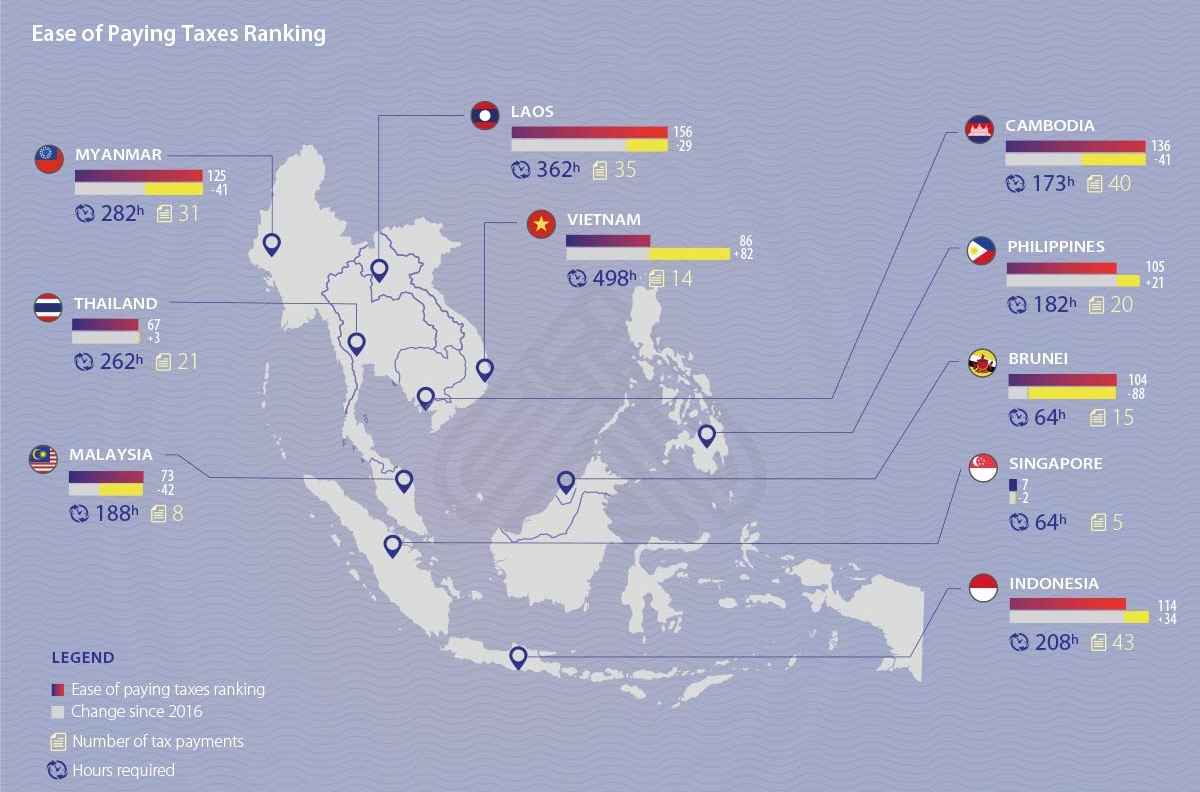 Businesses are affected not only by tax rates but also by the ease with
which taxes are paid in a jurisdiction. Therefore, it is advisable for
business and tax payers to consider aspects like time taken to calculate
taxes, to file tax returns, and effectiveness of a government’s tax
policies in a particular jurisdiction – more than tax rates – while
determining the place of doing business. For many of the ASEAN’s
developing markets, slight differences in tax rates can be more than
offset by difference in time taken to comply with tax-related
procedures.
Businesses are affected not only by tax rates but also by the ease with
which taxes are paid in a jurisdiction. Therefore, it is advisable for
business and tax payers to consider aspects like time taken to calculate
taxes, to file tax returns, and effectiveness of a government’s tax
policies in a particular jurisdiction – more than tax rates – while
determining the place of doing business. For many of the ASEAN’s
developing markets, slight differences in tax rates can be more than
offset by difference in time taken to comply with tax-related
procedures.
In the 40 years since China began opening its doors to more market-oriented economic policies, the country has experienced explosive growth that many refer to as nothing short of a miracle. The nation’s growing influence has been felt on every continent, and people have taken note that China continues to play an ever-larger role in world affairs. But more power brings more expectations and accountability, and in our most recent survey many people around the globe say they want an alternative to China as the world’s leading power.Across the 25 countries polled in a recent Pew Research Center survey, a median of 45% have a favorable view of China, while 43% hold an unfavorable view. Majorities or pluralities in 12 countries give China positive marks, with favorable attitudes most prevalent in Africa, the Middle East and parts of Asia. In the United States, 38% have a favorable opinion of China, a slight decrease from 44% in 2017, while nearly half expressed unfavorable attitudes.A global median of 70% say China plays a more important role in the world than it did 10 years ago. Russia is a distant second in this assessment, with only 41% saying that country is more important than it was a decade ago. A median of only 31% believe the U.S. plays a more important role than it did a decade ago – less than half of the share who say this of China. Only 8% of those surveyed say China plays a less important role than it did a decade ago, the lowest share across the seven countries tested. In the U.S., 72% believe China is more important now than it was a decade ago, while only 31% of Americans say the same about their own country.While most agree that China’s global role has grown over the past decade, a lack of enthusiasm for Chinese world leadership persists. A median of 34% of people around the world currently regard China as the world’s leading economic power only slightly less than the 39% who picked the U.S. Yet when thinking about the future, a 25-country median of 63% say they prefer a world in which the U.S. is the leading power, while just 19% would favor one in which China leads. Notably, four of the five countries most inclined to choose the U.S. over China are located in the Asia-Pacific region: 81% of Japanese, 77% of Filipinos, 73% of South Koreans and 72% of Australians all favor a future where Washington, not Beijing, leads.Those who are more likely to say that China does not respect the personal freedoms of its people also tend to have more unfavorable views of China (e.g. France, Sweden). Conversely, people who are less disapproving of China’s human rights record show lower unfavorable opinions of China overall (Nigeria, Kenya, Tunisia). European nations surveyed tend to be particularly critical – a median of 82% across the 10 EU countries surveyed say China does not respect personal freedoms. Among countries at the more negative end of the scale, Japan is the outlier, showing higher levels of general dissatisfaction with China that may relate to historical and political strains in bilateral relations.The concept, while still a work in progress, is designed to present an alternative vision to a China-centric regional order. This comports with a growing consensus among strategists inside the Trump Administration that the United States needs a new approach to Asia that assumes a more competitive stance toward China, one that sheds long-held aspirations for either a highly collaborative U.S.-China relationship or China’s evolution into anything approximating a “responsible stakeholder.”What is striking, however, is the degree to which Trump’s China policy to date has been nearly opposite of what would be required for a strategy dedicated to a “free and open Indo-Pacific” narrowly focused on North Korea and trade, rather than holistic and comprehensive; explicitly transactional rather than based on deeply-rooted principles and values; rejecting multilateralism, rather than supporting regional institutions and collective action; emphasizing “America First” rather than American leadership; and being forgiving even flattering of China and Xi Jinping, rather than reflecting the emergent ideological competition.In the wake of the Administration’s conspicuous “Indo-Pacific” rollout, this begs the question of whether Trump’s upcoming trip to Beijing will represent a turning point in U.S. China policy or U.S.-China relations. Will there be any evidence in Beijing of a strategic shift in Washington? Don’t count on it. The visit will be long on ceremony and short on substance. Trump isn’t interested in playing hardball with his host in public. And while the Administration will put down markers privately on areas of frustration and disappointment, it isn’t using the visit as a forcing function or negotiating session. Instead, Air Force One will depart for Vietnam with little changed and little achieved.For years, countries in the region have been moving toward closer integration rather than disintegration. For example, China’s Belt and Road Initiative (BRI) and the Asian Infrastructure Investment Bank (AIIB) have become a boon for the countries in the region looking to improve infrastructure and connectivity.China and India also have strengthened ties despite their unresolved border disputes. The two countries are key members of the BRICS. Just in September, Indian Prime Minister Narendra Modi attended the BRICS leaders meeting in Hangzhou.At the Shanghai Cooperation Organization (SCO) meeting in Astana, Kazakhstan, in June, India and Pakistan became full members of the organization.China is now India’s largest trade partner. More Chinese companies, such as Huawei, ZTE, Alibaba and Xiaomi, have invested in India, while more Indian companies, especially in software and IT services companies, have invested in China.The potential for win-win cooperation between the world’s two most populous nations is enormous, and there is no reason for them at all to engage in a zero-sum game. It is entirely OK for the U.S. to propose an Indo-Pacific strategy. However, such a strategy should not aim at a third country, such as China. And it would serve the U.S.’ interests best if its strategy is to unite all the countries in the region rather than try to divide them.
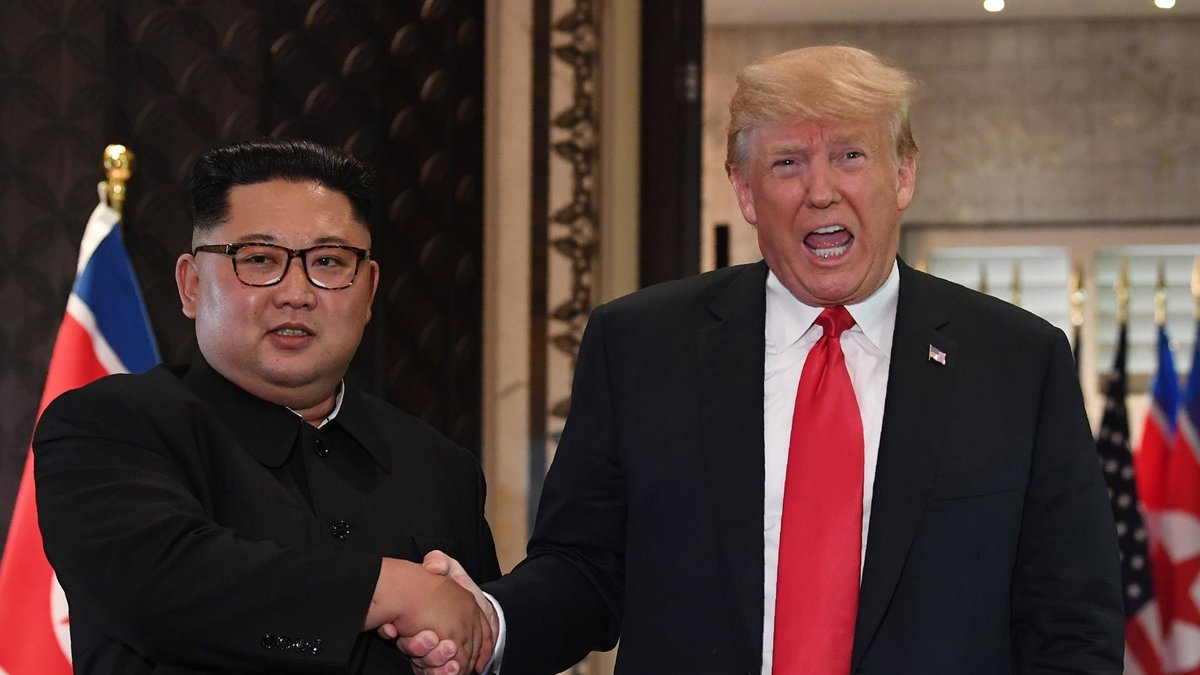 North Korea is still making nukes, and the Trump admin is taking a harder lineThe newest intelligence shows Kim’s regime has stepped up efforts to hide its nuclear weapons production, say three senior U.S. officials.As President Donald Trump issues a steady stream of praise for Kim Jong Un in interviews and on Twitter, a steady stream of evidence that North Korea is still making nuclear weapons has pushed his administration to take a much more aggressive stance toward Pyongyang.
North Korea is still making nukes, and the Trump admin is taking a harder lineThe newest intelligence shows Kim’s regime has stepped up efforts to hide its nuclear weapons production, say three senior U.S. officials.As President Donald Trump issues a steady stream of praise for Kim Jong Un in interviews and on Twitter, a steady stream of evidence that North Korea is still making nuclear weapons has pushed his administration to take a much more aggressive stance toward Pyongyang.
Trump’s International Ratings Remain Low, Especially Among Key Allies.Most still want U.S. as top global power, but see China on the riseAmerica’s global image plummeted following the election of President Donald Trump, amid widespread opposition to his administration’s policies and a widely shared lack of confidence in his leadership. Now, as the second anniversary of Trump’s election approaches, a new 25-nation Pew Research Center survey finds that Trump’s international image remains poor, while ratings for the United States are much lower than during Barack Obama’s presidency.The poll also finds that international publics express significant concerns about America’s role in world affairs. Large majorities say the U.S. doesn’t take into account the interests of countries like theirs when making foreign policy decisions. Many believe the U.S. is doing less to help solve major global challenges than it used to. And there are signs that American soft power is waning as well, including the fact that, while the U.S. maintains its reputation for respecting individual liberty, fewer believe this than a decade ago. Frustrations with the U.S. in the Trump era are particularly common among some of America’s closest allies and partners. In Germany, where just 10% have confidence in Trump, three-in-four people say the U.S. is doing less these days to address global problems, and the share of the public who believe the U.S. respects personal freedoms is down 35 percentage points since 2008. In France, only 9% have confidence in Trump, while 81% think the U.S. doesn’t consider the interests of countries like France when making foreign policy decisions.Critical views are also widespread among America’s closest neighbors. Only 25% of Canadians rate Trump positively, more than six-in-ten (63%) say the U.S. is doing less than in the past to address global problems, and 82% think the U.S. ignores Canada’s interests when making policy. Meanwhile, Trump’s lowest ratings on the survey are found in Mexico, where just 6% express confidence in his leadership.One exception to this pattern is Israel. After a year in which the Trump administration generated international controversy by moving the U.S. Embassy from Tel Aviv to Jerusalem, his positive rating jumped to 69%, up from 56% in 2017.Around the world, publics are divided about the direction of American power: Across the 25 nations surveyed, a median of 31% say the U.S. plays a more important role in the world today than it did ten years ago; 25% say it plays a less important role; and 35% believe the U.S. is as important as it was a decade ago.In contrast, views about Chinese power are clear: A median of 70% say China’s role on the world stage has grown over the past 10 years. Still, by a slim margin, more people name the U.S. as the world’s leading economic power (a median of 39% say the U.S., 34% say China).And despite the unease many feel about the U.S. at the moment, the idea of a U.S.-led world order is still attractive to most. When asked which would be better for the world, having China or the U.S. as the top global power, people in nearly every country tend to select the U.S., and this is particularly common among some of China’s Asia-Pacific neighbors, such as Japan, the Philippines, South Korea and Australia.Trade disputes have dominated relations between the world’s two biggest economies in recent weeks, as Washington and Beijing have slapped tariffs on goods from their respective countries. Although tensions over trade are hardly new, they have intensified during the Trump administration, and as a new Pew Research Center survey illustrates, American attitudes toward China have become somewhat less positive over the past year.Overall, 38% of Americans have a favorable opinion of China, down slightly from 44% in 2017. Attitudes toward China have fluctuated to some extent in recent years, becoming more negative during the 2012 election cycle, but more positive in 2017, before this year’s decline.Asian nations are divided when it comes to having confidence in Trump. Globally, a median of just 22% say they are confident Trump will do the right thing when it comes to international affairs. But of all 37 countries the Center surveyed, Trump’s greatest support comes from the Philippines, where 69% say they have confidence in him. A majority of people in Vietnam (58%) also express confidence in Trump. The shares are much smaller in Japan (24%) and South Korea (17%). In these two countries, confidence in the U.S. president is down dramatically from the end of the Obama administration. South Korea, for example, has seen a 71-percentage-point drop in confidence in the U.S. president since 2015. Many in Asia see the U.S. as the world’s leading economic power. Although many European publics view China as the world’s leading economic power, majorities in South Korea (66%) and Japan (62%) say the distinction belongs to the U.S. Around half of those in Vietnam (51%) and the Philippines (49%) also say this of the U.S., similar to the share of Americans (51%) who hold this view. Among the four Asian countries, the shares who say China is the world’s biggest economic power ranges from 17% in Vietnam to 27% in South Korea.Most oppose Trump policies that withdraw U.S. support for major trade and climate change agreements. Globally, a median of 72% disapprove of Trump’s proposal to withdraw the U.S. from major international trade pacts. Majorities in Japan (66%) and Vietnam (61%) hold this view, as do 72% in the Philippines and 80% in South Korea. The survey was conducted after Trump signed an executive order withdrawing the U.S. from the Trans-Pacific Partnership free trade agreement, of which Vietnam and Japan are signatories.Majorities in the four Asian countries also disapprove of Trump’s proposed policy to withdraw support for international climate change agreements.Concern is highest among Pyongyang’s closest neighbors – South Korea, Japan and the Philippines, where 85% or more in all three countries say they are at least somewhat concerned. Anxiety is greatest in Japan, where 66% say they are very concerned about North Korea having nuclear weapons. Within the Asia-Pacific region, people in Vietnam are least worried about North Korea’s nuclear program – only around a quarter (23%) say they are very concerned.Attitudes diverge on how to best deal with North Korea’s weapons program. A majority in Japan (61%) prefers increasing economic sanctions, as do around half of South Koreans (51%). Those in Vietnam and the Philippines, on the other hand, lean toward deepening ties with North Korea (43% and 45%, respectively).People in the region are split on how relations will change between the U.S. and their country. Many countries around the world do not expect relations between their country and the U.S. to change over the next few years with Trump as president. Globally, a median of 41% expect relations to stay about the same and 32% expect relations to get worse. Within the Asia-Pacific region, countries are split. About as many in South Korea say relations will stay about the same (45%) as say they expect relations to sour (43%). Around a third (34%) in Japan say relations will stay about the same, compared with four-in-ten (41%) who expect relations will get worse and 17% who say relations with the U.S. will get better. In the Philippines and Vietnam, people are more likely to say relations with the U.S. will stay the same or improve now that Trump is president.China, Indonesia, Malaysia, Australia, and India are the "Big Five"
largest crude oil producers in Asia, accounting for 89% of regional
production , and their dominance is likely to continue in the
near future.
DONALD TRUMP'S TRADE WAR WITHOUT FREE AND FAIR TRADE.6 - YEAR OLDS DON'T ACT LIKE TRUMP,TRUMP'S TRADE WAR WILL FAIL.TRUMP ABLE TO FILE FOR BANKRUPTCY ,HE HAS FILED CHAPTER 11 BANKRUPTCY FOR HIS COMPANIES SIX TIMES.A REPORT SAID.
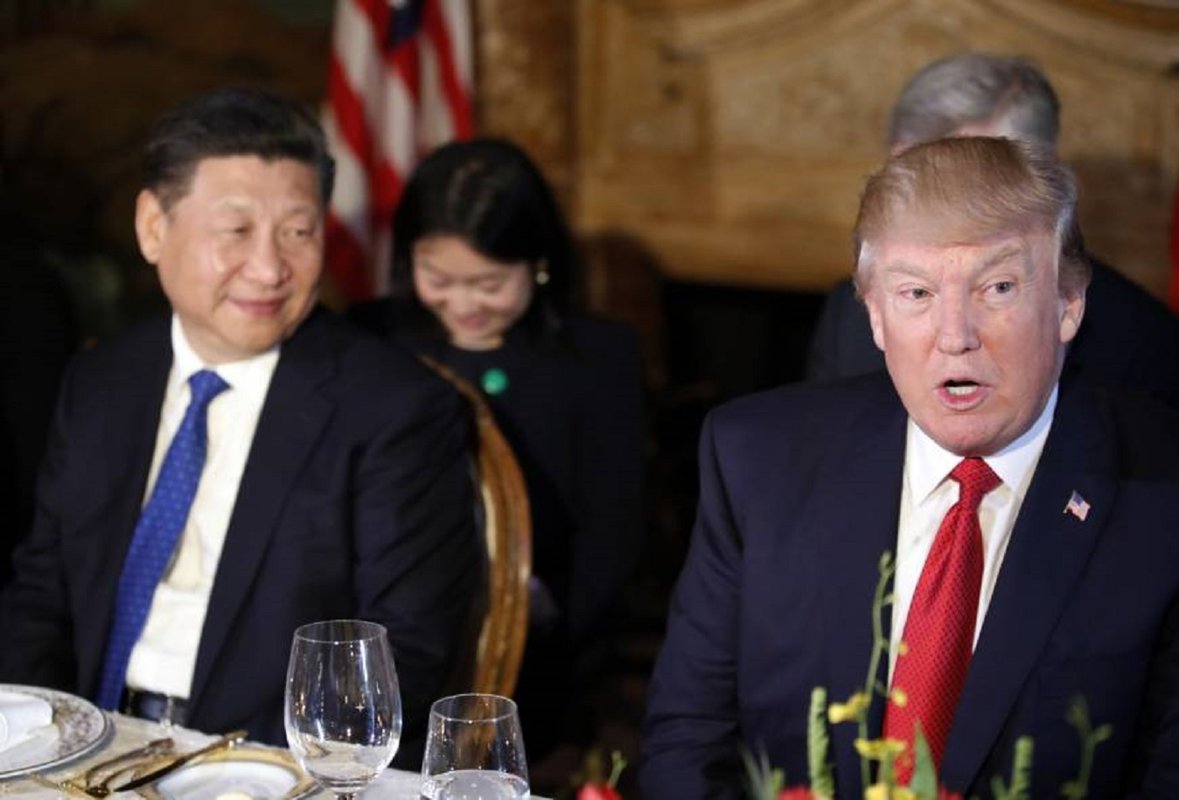 US leader praises Xi Jinping’s power grab as Beijing fuels fears of a trade war.The ruling Communist party plans to abolish term limits on the Chinese presidency, paving the way for President Xi to extend his authoritarian rule for at least another decade.
US leader praises Xi Jinping’s power grab as Beijing fuels fears of a trade war.The ruling Communist party plans to abolish term limits on the Chinese presidency, paving the way for President Xi to extend his authoritarian rule for at least another decade.
Trump set to turn all trade war fire on China after US deal with EU to suspend tariffs. America-First negotiating tactics may produce a new agreement on NAFTA , but history suggests he could be creating bad blood against the U.S. for years or longer.Next there is the future of Nafta. Canada and Mexico are caught up in the steel and aluminium tariff row, but there is a bigger game here. That is whether the North American continent can continue on the march towards a free trade zone. Nafta is by no means perfect, and there are all sorts of minor barriers to open trade. But it is a base from which you can negotiate. The US is the dominant partner in these negotiations and so does not need to throw its weight about. But it also needs a friend to the north and a friend to the south, along undefended borders. Does the president know this? Or is the drama of beating up your friends more attractive?Third, there is the long-term relationship with China. Negotiations are taking place in Beijing right now, but I am not particularly troubled by what will come out of these. Numbers matter more than words. So by how much does China’s trade surplus with the US, currently running at more than $350bn a year, come down? Does China really open up its industries to foreign ownership? The present outlook is for China to seek to cut its surplus, perhaps to $200bn a year, and that is a start. But opening up to the world is the bigger long-term issue. Clues about that are really interesting.Economists tell us the effects of the tariffs, while imprecise so far, are not pretty. Here’s a basic rundown.For workers in America’s heartland, the good news of savings from President Donald Trump’s tax cuts is getting overshadowed by concern over his disruptive trade policies.Tariffs are taxes on certain imports from another country paid by a country’s own population. They raise prices for manufacturers, which are passed onto customers, or for customers directly.When manufacturing costs up, manufacturers have to either adjust to the higher cost or find something to replace the imported good. Sometimes the replacement might create jobs domestically, but imports are not always easily switchable, like steel.With higher prices, demand goes down, and so on the retail end, jobs suffer. However, experts said jobs are the last in a series of cost-reductions that firms will take in reaction to tariffs.Other countries retaliate to U.S. tariffs by putting tariffs on U.S. goods sold in their own countries, like China’s tariff on U.S. soybeans. China still has to get soybeans from somewhere, and so far their eyes are set on Brazil. As a consequence, U.S. producers lose valuable customers they may not regain, and must drive prices down to compete with the foreign goods.The effect is lower prices and lower export levels, but some of these effects are only now starting to show. In anticipation of the tariffs, the agricultural industry pushed out more exports than usual, which postponed the price effects for months.It’s because they were doing all this advanced preparation to get around all the harm that would be coming later. So it’s going to be in the last half of the year that tariffs start showing up in producer and eventually consumer prices.Besides producer and consumer prices, the effects can be seen in the fiscal policy of the central bank. While the Fed’s interest rate hike in June cannot be attributed only to tariffs, they play a role, as tariffs accelerate inflation, which higher interest rates aim to fix. Those, in turn, trigger higher borrowing rates for consumers.Stock prices and investment are two other key indicators of the impacts of tariffs. The stock market following second quarter earning reports are a good place to look.Companies are reporting they are taking hits, and that is affecting stock prices.Even though it hasn’t shown a bad impact, it could going forward, depending on how much reports impact stock prices.
 Different views of G7 meeting paint a tense picture of Prime Minister Justin Trudeau, British Prime Minister Theresa May, French President Emmanuel Macron, German Chancellor Angela Merkel, and U.S. President Donald Trump discuss the joint statement following a breakfast meeting at the G7 summit in La Malbaie, Que. on June 9, 2018.
Different views of G7 meeting paint a tense picture of Prime Minister Justin Trudeau, British Prime Minister Theresa May, French President Emmanuel Macron, German Chancellor Angela Merkel, and U.S. President Donald Trump discuss the joint statement following a breakfast meeting at the G7 summit in La Malbaie, Que. on June 9, 2018.
Trump is ready to take the trade war with China to the next level.Asia must take a stand in dealing with Trump's trade war.Wait-and-see strategies to Trump's trade war are no longer viable. It's time for a strategic response from the region that has more stake in the global system than any part of the world.The multilateral rules-based trade regime is under assault and the liberal economic order that has underpinned trade growth and global prosperity is under threat from its chief architect, the United States.At the same time, the Trump administration seems to be doing its level best to run a competition calculated from the starting gate to lose the race, or the war, whichever it turns out to be. The US president’s latest effort was to threaten a rise in tariffs on US$200 billion worth of Chinese goods from 10 per cent to 25 per cent.Within 24 hours, China quickly reciprocated with a list of 5,207 American products, worth US$60 billion, on which it pledged to exact new tariffs ranging from 5 to 25 per cent if Trump implements his threats.The erosion of American manufacturing became a hot-button issue during the 2016 election. And for good reason. Total employment in manufacturing has fallen by 25 percent since 2001, putting about 4.5 million workers out of a job.Members of both parties now agree that free trade is largely to blame for this decline. Off-shoring and “bad” trade deals are cited as evidence that trade no longer serves America’s interests.The Trump administration’s solution is tariffs. In recent months, entry barriers have been erected, first to protect solar panels and washing machines in January and then steel and aluminum in March.Although he’s fighting these trade battles with many partners, including Canada and Europe, most of Trump’s attention is directed toward China. He claims that China manipulates its currency, fails to protect intellectual property and stunts economic innovation. Sweeping tariffs beginning with a 25 percent increase on $34 billion of Chinese imports – are an attempt to combat those issues.After months of warnings and threats and failed negotiations with China, United States officials have started collecting tariffs on $34 billion worth of Chinese goods. In response, Beijing has said that it will retaliate with levies on American pork, soybeans, and cars. In response to that response, Trump has promised to re-retaliate by applying tariffs to more than $200 billion worth of goods from China if Beijing follows through.It’s important to state that American and European companies have real gripes with China, which has spied on foreign companies and forced Western tech firms to hand over patented technology as a condition for selling into the Chinese market. Pressuring China to change course will take a coordinated global effort, a careful construction of alliances around the world, and a cautious approach to nudging China toward lowering its barriers to entry.Chinese state media kept up their criticism of U.S. President Donald Trump’s trade policies, with a newspaper on Tuesday describing as “wishful thinking” Trump’s belief that a fall in Chinese stocks was a sign of his winning the trade war.As the world’s two biggest economies remained locked in a heated tariff dispute, Beijing and Washington have kept up a blistering rhetoric with threats and counter-threats of more punitive trade measures.The editorial in the official China Daily underscored an increasingly aggressive stance adopted by Chinese state media against Trump, a shift from their previous approach of tempering any direct criticism against the U.S. president.The overseas edition of the Communist Party’s People’s Daily newspaper singled out Trump, saying he was starring in his own “street fighter-style deceitful drama of extortion and intimidation.”China proposed retaliatory tariffs on $60 billion worth of U.S. goods ranging from liquefied natural gas (LNG) to some aircraft on Friday, following the Trump administration’s plan for a higher 25 percent tariff on $200 billion worth of Chinese imports.
After a meeting at the White House between U.S. President Donald Trump and EU Commission President Jean-Claude Juncker, the two leaders declared a temporary truce to escalating trade tensions and agreed to begin negotiations to eliminate tariffs and subsidies on everything but cars. Juncker also agreed to buy billions of dollars more in U.S. soybeans and natural gas.Since to some it seems like the U.S. got more than it gave in this tentative deal, it’s a good time to ask: Is Trump winning the trade war he began with Europe? Let’s say it’s halftime and the U.S. and EU are tied at 1-1. Who wins will depend most on the strategy each team works out in the locker room and how well it’s executed in the second half.Perhaps Trump thinks that because he can impose tariffs on more goods than the Europeans, the U.S. will win the game. He may also believe that his threat of steep tariffs on cars will compel Germany to force the EU to capitulate because Chancellor Angela Merkel won’t want to hurt her export-oriented auto industry.But your favorite french fry condiment isn’t the only target. The retaliation list reportedly includes duties worth over 18 billion euro ($21.07 billion), on items such as frozen fish, raisins, suitcases, and adhesive bandages.These tariffs will only be implemented should Trump decide to go ahead with placing duties on EU cars and car parts. Europe imported American cars worth €77 billion ($90.13 billion) in 2016, while the U.S. imported €254 billion ($296.12) in cars from Europe.A big advantage enjoyed by the U,S. is that it is able to make decisions quickly since there's only one American president, while the EU has 28 leaders who all must agree to major decisions.In addition, the U.S. runs a trade deficit with the EU, which means Americans buy more stuff from the Europeans than vice versa. Armed with these advantages, Trump's strategy seems to be to use the threat of tariffs to create uncertainty, sow dissension within the EU, and extract concessions.Perhaps Trump thinks that because he can impose tariffs on more goods than the Europeans, the U.S. will win the game. He may also believe that his threat of steep tariffs on cars will compel Germany to force the EU to capitulate because Chancellor Angela Merkel won't want to hurt her export-oriented auto industry.While Trump somewhat effectively employed this strategy with South Korea, it may not work with the EU.Not surprisingly, the option to pay back the US in kind is gaining traction and may well become reality. If so, a full-blown trade war could be inevitable. This is offset by the fact that an escalation of the trade war between the EU and the US was prevented last week. Yet this is merely a temporary ‘truce’; many analysts doubt if the negotiations concerning lower trade barriers – which would be a definite solution – between the European block and the United States will be successful. Plus, a relaxed relationship between both major players could give Trump 'carte blanche' to target China.
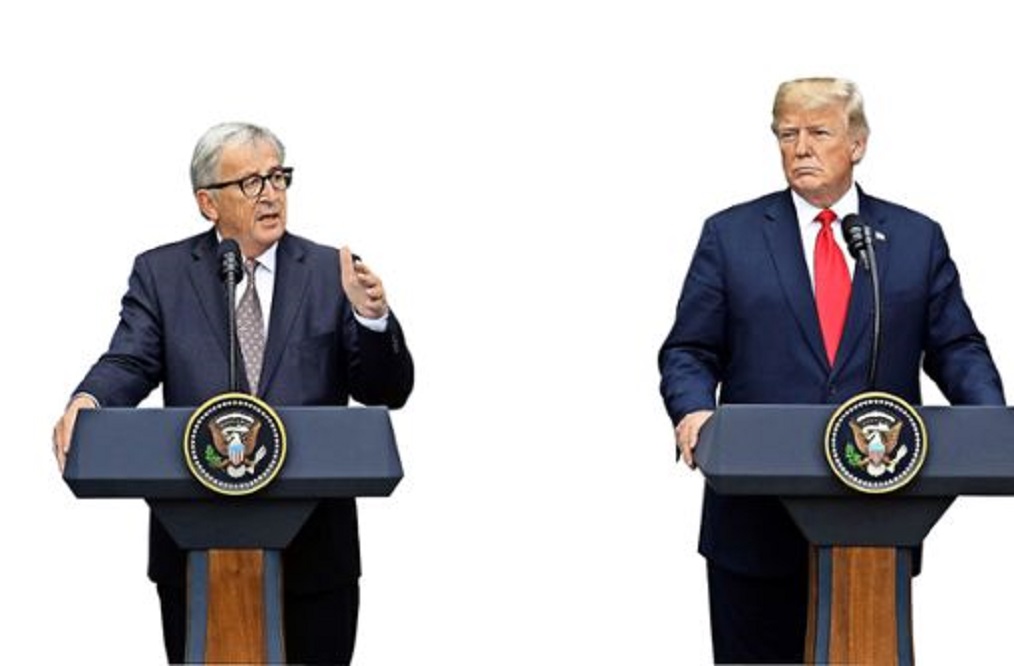 Trump and Jean-Claude Juncker agree deal to stave off trade war .Wall Street was boosted by the deal with the S&P 500 closing at its highest level since January 29, while MSCI's broadest index of Asia-Pacific shares outside Japan edged up 0.1 percent.
Trump and Jean-Claude Juncker agree deal to stave off trade war .Wall Street was boosted by the deal with the S&P 500 closing at its highest level since January 29, while MSCI's broadest index of Asia-Pacific shares outside Japan edged up 0.1 percent.
Trump has filed Chapter 11 bankruptcy for his companies six times. Three of the casino bankruptcies came during the recession of the early 1990s and the Gulf War, both of which contributed to hard times in Atlantic City, New Jersey's gambling facilities. He also entered a Manhattan hotel and two casino holding companies into bankruptcy. By allowing the business to continue, employees still have their jobs and the business is still making money. Corporate debts still need to be repaid but they may be reduced. The corporation must develop a repayment plan and corporate budget. Both must be approved by the creditors and by the bankruptcy court.he has also led some of his companies into bankruptcy, maneuvers he says were designed to restructure their massive debt.Critics have cited the Trump corporate bankruptcies as examples of his recklessness and inability to manage, but the real-estate developer, casino operator and former reality-television star says his use of federal law to protect his interests illustrates his sharp business acumen.Trump has filed Chapter 11 bankruptcy for his companies six times. Three of the casino bankruptcies came during the recession of the early 1990s and the Gulf War, both of which contributed to hard times in Atlantic City, New Jersey's gambling facilities. He also entered a Manhattan hotel and two casino holding companies into bankruptcy.Chapter 11 bankruptcy allows companies to restructure or wipe away much of their debt to other companies, creditors, and shareholders while remaining in business but under the supervision of a bankruptcy court. Chapter 11 is often called "reorganization" because it allows the business to emerge from the process more efficient and on good terms with its creditors.Trump opened the $1.2 billion Taj Mahal Casino Resort in Atlantic City in April 1990. One year later, in the summer of 1991, it sought Chapter 11 bankruptcy protection because it was unable to generate enough gambling revenue to cover the massive costs of building the facility, particularly amid a recession.Trump was forced to relinquish half of his ownership in the casino and sell off his yacht and his airline. The bondholders were awarded lower interest payments.Trump's Taj Mahal was described as the eighth wonder of the world and the largest casino in the world. The casino covered 4.2 million square feet on 17 acres of land. Its operations were said to have cannibalized the revenue of Trump's Plaza and Castle casinos.The Castle Hotel & Casino entered bankruptcy in March 1992 and had the most difficulty of Trump's Atlantic City properties in covering its operational costs. The Trump Organization relinquished half of its holdings in the Castle to the bondholders. Trump opened the Castle in 1985. The casino remains in operation under new ownership and a new name, the Golden Nugget.The Plaza Casino was one of two Trump casinos in Atlantic City to enter bankruptcy in March 1992. The other was the Castle Hotel & Casino. The 39-story, 612-room Plaza opened on the Atlantic City boardwalk in May 1984 after Trump struck a deal to build the casino with Harrah’s Entertainment. Trump Plaza closed in September 2014, putting more than 1,000 people out of work.Trump's Plaza Hotel was more than $550 million in debt when it entered Chapter 11 bankruptcy in 1992. Trump gave up a 49 percent stake in the company to lenders, as well as his salary and his day-to-day role in its operations.The hotel, overlooking Central Park in Manhattan from its location on Fifth Avenue, entered bankruptcy because it could not pay its annual debt service payments. Trump bought the hotel for about $407 million in 1988. He later sold a controlling stake in the property, which remains in operationTrump Hotels & Casino Resorts, a holding company for Trump's three casinos, entered Chapter 11 in November 2004 as part of a deal with bondholders to restructure $1.8 billion of debt.Earlier that year, the holding company posted a first quarter loss of $48 million, double its losses for the same quarter the previous year. The company said its gambling take was down nearly $11 million across all three casinos.The holding company emerged from bankruptcy less than a year later, in May 2005, with a new name: Trump Entertainment Resorts Inc. The Chapter 11 restructuring reduced the company's debt by about $600 million and cut interest payments by $102 million annually. Trump relinquished the majority control to bondholders and gave up his title of chief executive officer, according to The Press of Atlantic City newspaper. . Trump Entertainment Resorts, the casino holding company, entered Chapter 11 in February 2009 amid The Great Recession. Atlantic City casinos were also hurting, according to published reports, because of new competition from across the state line in Pennsylvania, where slot machines had come online and were drawing gamblers.The holding company emerged from bankruptcy less than a year later, in May 2005, with a new name: Trump Entertainment Resorts Inc. The Chapter 11 restructuring reduced the company's debt by about $600 million and cut interest payments by $102 million annually.
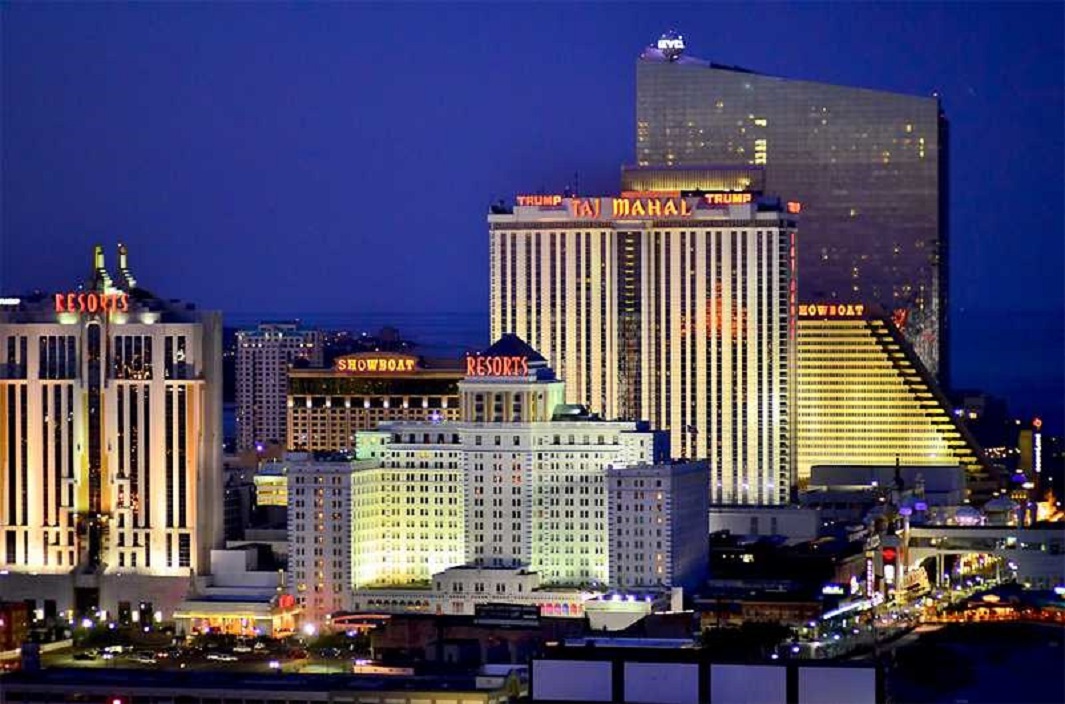 The Hard Rock Hotel & Casino Atlantic City (formerly Trump Taj Mahal) is a casino and hotel on the Boardwalk, owned by Hard Rock International, in Atlantic City, New Jersey, United States.The casino, originally known as the Trump Taj Mahal, was inaugurated by its then-owner Donald Trump in 1990.
The Hard Rock Hotel & Casino Atlantic City (formerly Trump Taj Mahal) is a casino and hotel on the Boardwalk, owned by Hard Rock International, in Atlantic City, New Jersey, United States.The casino, originally known as the Trump Taj Mahal, was inaugurated by its then-owner Donald Trump in 1990.
TRUMP HAS RECOGNIZED JERUSALEM AS THE ISRAELI CAPITAL IN DECEMBER 6, 2017.IVANKA TRUMP AND HER HUSBAND JARED KUSHNER WERE IN JERUSALEM FOR EMBASSY OPENING AS GAZA BRACES FOR BLOODSHED.MORE THAN 50 PALESTINE YOUNG PEOPLE KILLED IN CLASHES .
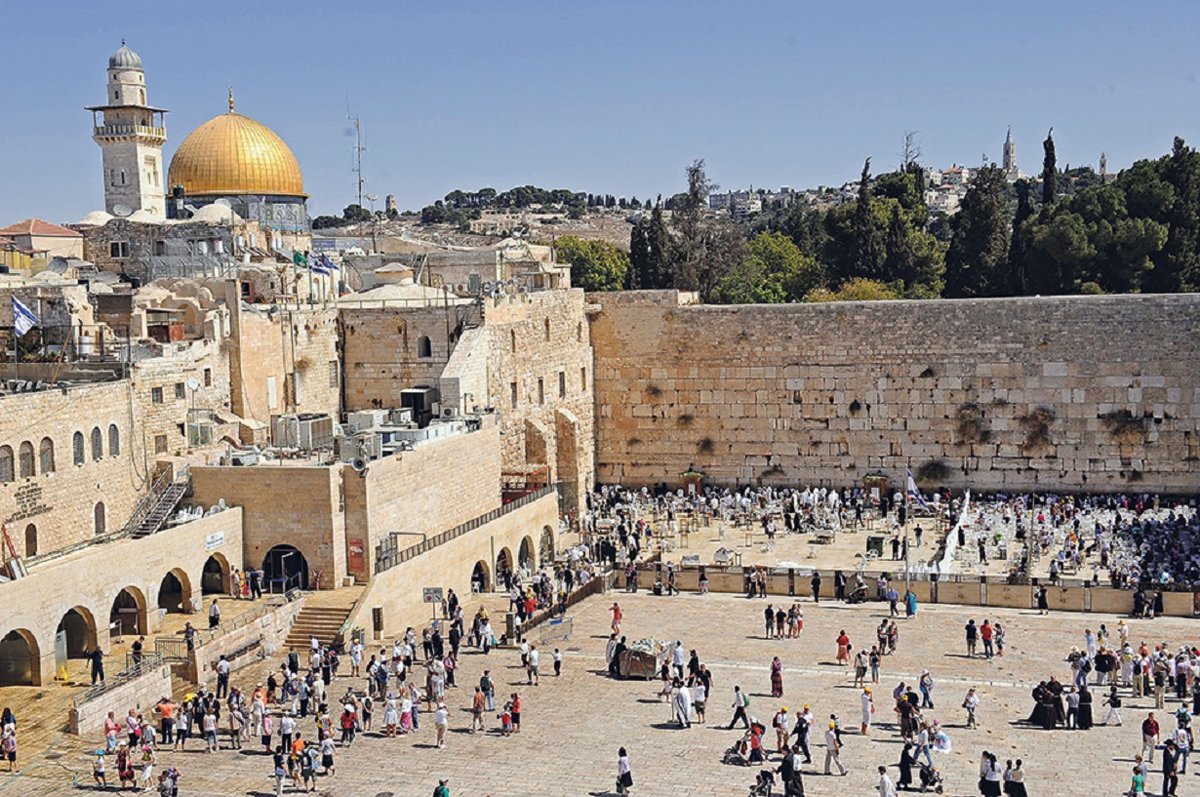 Palestinians want the capital of an independent Palestinian state to be
in the city's eastern sector, which Israel captured in the 1967 Middle
East war and annexed in a move never recognised internationally.
Palestinians want the capital of an independent Palestinian state to be
in the city's eastern sector, which Israel captured in the 1967 Middle
East war and annexed in a move never recognised internationally.
Jerusalem,its multi-religious
tradition. The scope of the book is broad, ranging from the fourth
century B.C.E. to the present a preeminent and recently
deceased Islamic historian, follows his clearly stated intention of
providing what he regards as the balance necessary to an understanding
of various religious groups' identity within Jerusalem. The essays cover
Jewish, Muslim, and, to a lesser extent, Christian heritage. The
development is purely chronological, moving from early tribal
settlements through the empires of Rome and Byzantium, the emergence of
Islam, the conflict with Christian Crusaders, and the rise of the
Ottomans to, finally, dominance by the West. A useful addition to
collections that seek to serve broad interests and Middle Eastern
history.Jerusalem was conquered by King David around 1000 BCE, establishing it
as the capital of Israel. The first Temple was built by King Solomon a
few decades later and destroyed in 587 BCE by the Babylonians. The
Second Temple was built in 516 BCE. Under Greek rule in 175 BCE, the
Temple was plundered and desecrated. Following the Maccabean revolt, it
is in this Second Temple, that story of the Hanukkah miracle takes
place.Many significant events in the life of Jesus took place in Jerusalem,
including the Temptation, Last Supper, Crucifixion, and Resurrection.The city was largely extended westwards after the Neo-Assyrian destruction of the northern Kingdom of Israel and the resulting influx of refugees. Destroyed by Nebuchadnezzar in 586 BCE, it was rebuilt on a smaller scale in about 440 BCE, during the Persian period, when, according to the Bible, Nehemiah led the Jews who returned from the Babylonian Exile. An additional, so-called Second Wall, was built by King Herod the Great. In 41–44 CE, Agrippa, king of Judea, started building the so-called "Third Wall" around the northern suburbs. The entire city was totally destroyed by the Romans in 70 CE.The northern part of the city was rebuilt by the Emperor Hadrian around 130, under the name Aelia Capitolina. In the Byzantine period Jerusalem was extended southwards and again enclosed by city walls.In the early 600's CE, significant events in the life of Muhammad take
place in Jerusalem, including the Initial Revelations, and the Night
Journey. In 620 CE Muhammad declares the Al-Aqsa Mosque as one of the
three holiest mosques in Islam. In 636 CE, Jerusalem is conquered again
and becomes part of the Arab Caliphate.The Crusaders invade Jerusalem in 1099 and control the city until Saladin's capture in 1187.The Ottomans rule Jerusalem from 1516 until after World War I when the
British Mandate begins. Following the 1948 War of Independence, the Old
City falls under Jordanian control, where it remains until the 1967
Six-Day War, when it is returned to Jewish control for the first time in
thousands of years.Muslims occupied Byzantine Jerusalem in the 7th century (637 CE) under the second caliph, `Umar Ibn al-Khattab who annexed it to the Islamic Arab Empire. He granted its inhabitants an assurance treaty. After the siege of Jerusalem, Sophronius welcomed `Umar, allegedly because, according to biblical prophecies known to the Church in Jerusalem, "a poor, but just and powerful man" would rise to be a protector and ally to the Christians of Jerusalem. Sophronius believed that `Umar, a great warrior who led an austere life, was a fulfillment of this prophecy. In the account by the Patriarch of Alexandria, Eutychius, it is said that `Umar paid a visit to the Church of the Holy Sepulchre and sat in its courtyard. When the time for prayer arrived, however, he left the church and prayed outside the compound, in order to avoid having future generations of Muslims use his prayer there as a pretext for converting the church into a mosque. Eutychius adds that `Umar also wrote a decree which he handed to the Patriarch, in which he prohibited Muslims gathering in prayer at the site.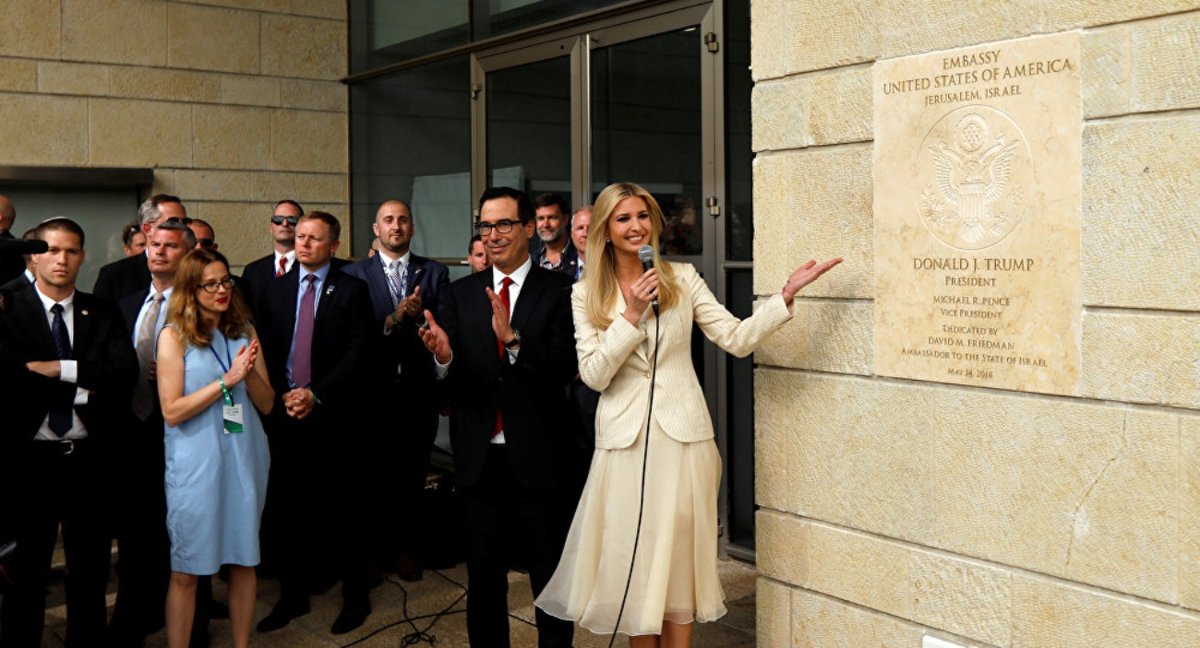
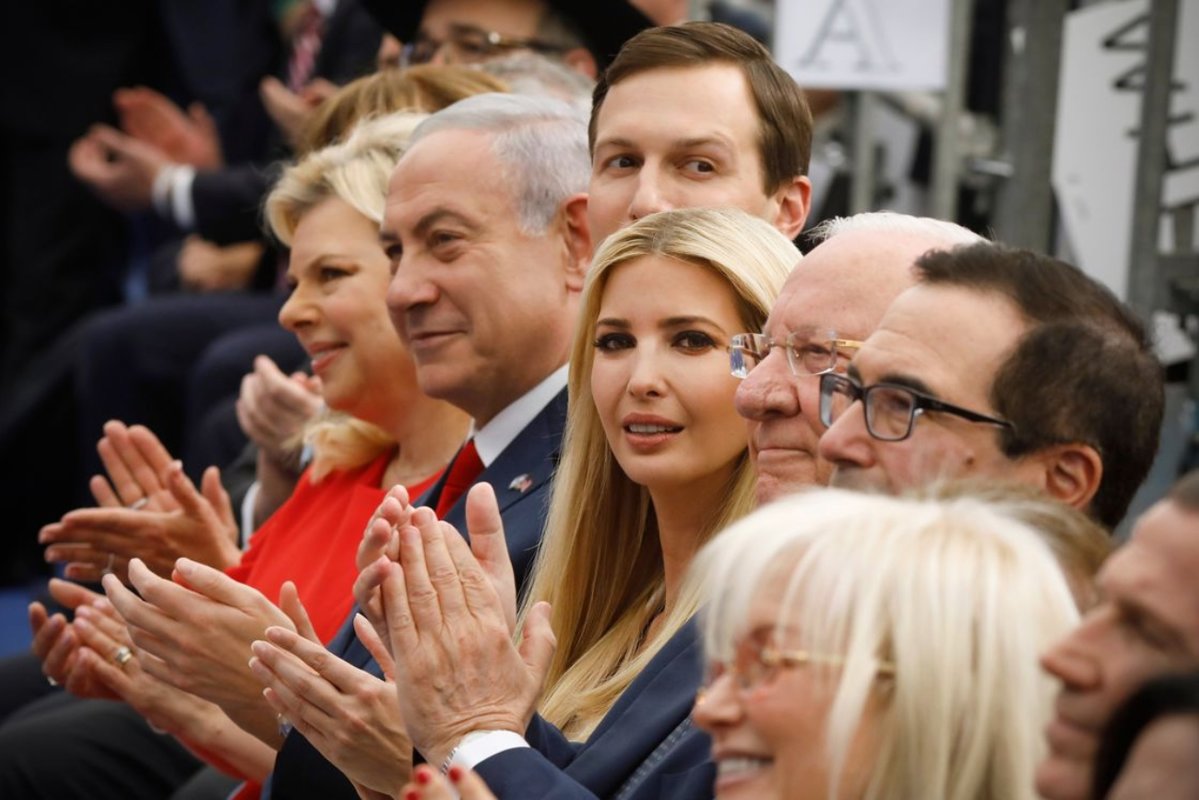 US Donald Trump's daughter Ivanka and her husband, Jared
Kushner, have arrived in Israel ahead of the opening of the new US
embassy in Jerusalem.Israel regards Jerusalem as its "eternal and undivided" capital, while
the Palestinians claim East Jerusalem - occupied by Israel in the 1967
Middle East war - as the capital of a future state.
US Donald Trump's daughter Ivanka and her husband, Jared
Kushner, have arrived in Israel ahead of the opening of the new US
embassy in Jerusalem.Israel regards Jerusalem as its "eternal and undivided" capital, while
the Palestinians claim East Jerusalem - occupied by Israel in the 1967
Middle East war - as the capital of a future state.
Trump’s recognition of contested Jerusalem as Israel’s capital in December 6, 2017 outraged Palestinians, who said the United States could no longer serve as an honest broker in any peace process with Israel.Palestinians seek East Jerusalem as the capital of a state they want to establish in the occupied West Bank and the Gaza Strip.Leaders around the world, including US allies, have condemned the move as US embassies in the Middle East and Europe braced for potentially violent protests in the wake of the announcement. UN Secretary-General Antonio Guterres, British Prime Minister Theresa May and a host of Middle Eastern leaders were among those criticising Mr Trump's "dangerous escalation" of hostilities.In Gaza, hundreds of Palestinian protesters burned American and Israeli flags, while several hundred protesters gathered outside the US consulate in Istanbul, with some throwing coins and other objects at the building.The Palestinian death toll from Israeli live fire in protests along the Gaza-Israel border at least 58 Palestinians were killed and more than 2,700 injured in Gaza as deadly protests took place ahead of, during and after the ceremony in Jerusalem.The U.S. relocation of its embassy from Tel Aviv fulfilled a pledge by President Donald Trump but it has fired Palestinian anger and drawn criticism from many foreign governments as a setback to peace efforts.Ministry officials said about 2,200 Palestinians were wounded, half of them by live bullets.France and Britain called on Israel to show restraint and U.N. Secretary-General Antonio Guterres said he was “deeply concerned” by the events in Gaza.Other responses to the violence were stronger. Regional power Turkey accused Israeli security forces of carrying out a massacre and said the U.S. Embassy move had encouraged them. The policy of Israeli authorities to fire irrespective of whether there is an immediate threat to life on Palestinian demonstrators in Gaza, caged in for a decade and under occupation for a half century, has resulted in a bloodbath that anyone could have foreseen.”Tens of thousands of Palestinians had streamed to the coastal enclave’s land border, some approaching the Israeli fence a line Israeli leaders said Palestinians would not be allowed to breach.Clouds of black smoke from tyres set alight by demonstrators rose in the air.Demonstrators, some armed with slingshots, hurled stones at the Israeli security forces, who fired volleys of tear gas and intense rounds of gunfire.The Israeli military said three of those killed were armed militants who tried to place explosives near the fence.The latest casualties raised the Palestinian death toll to 88 since the protests started six weeks ago, the worst bout of bloodshed since the 2014 Gaza war.No Israeli casualties have been reported. Thousands of people approached the barrier as the protest unfolded, some rolling burning tyres and hurling stones.Others flew flaming kites to try and torch bushes on the other side and distract Israeli marksmen.Hundreds of Palestinians were treated for tear gas inhalation. “The IDF (Israel Defense Forces) will act forcefully against any terrorist activity and will operate to prevent attacks against Israelis,” the military said in a statement.he killings have drawn international criticism since the series of protests began but the United States has echoed Israel in accusing Gaza’s ruling Hamas movement of instigating violence, an allegation it denies.More than 2 million people are crammed into the narrow strip, which is blockaded by Egypt and Israel.The Trump administration says it has nearly completed a new Israeli-Palestinian peace plan but is undecided on how and when to roll it out.Palestinian Prime Minister Rami Hamdallah, in a statement , accused the United States of “blatant violations of international law”.“Choosing a tragic day in Palestinian history (to open the Jerusalem embassy) shows great insensibility and disrespect for the core principles of the peace process,” Hamdallah wrote.French Foreign Minister Jean-Yves Le Drian said the U.S. move flouted international law. “France calls on all actors to show responsibility to prevent a new escalation,” Le Drian said in a statement.In London, the British government said it had no plans to move its Israel embassy from Tel Aviv to Jerusalem and it disagreed with the U.S. decision to do so.The Russian government said it feared the embassy move would increase tensions across the Middle East.
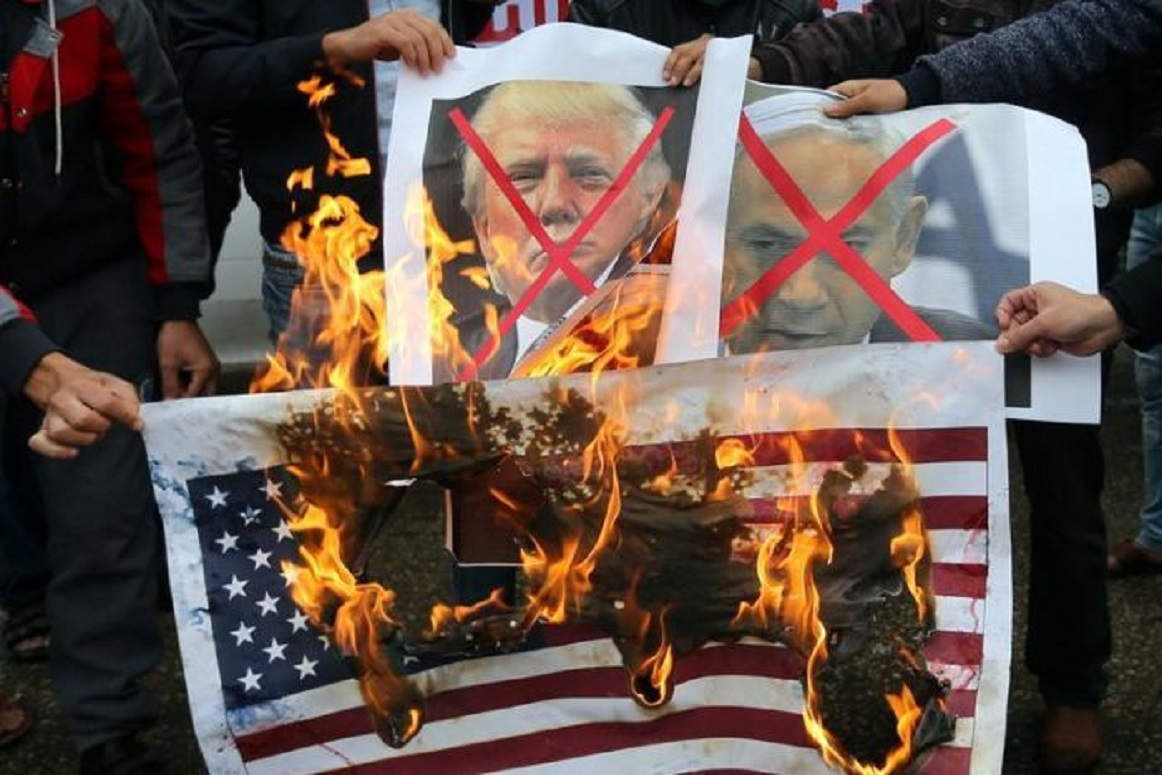 Israeli troops kill 16 protesting Palestinians as Ivanka Trump and Jared Kushner open the Jerusalem embassy.Today is the big day when we will cross the fence and tell
Israel and the world we will not accept being occupied forever," said a
protester.
Israeli troops kill 16 protesting Palestinians as Ivanka Trump and Jared Kushner open the Jerusalem embassy.Today is the big day when we will cross the fence and tell
Israel and the world we will not accept being occupied forever," said a
protester.
Protests at the Gaza-Israel border coincided with Nakba Day, the Palestinians' "day of catastrophe" a reference to Israel's 1948 founding and Palestinians' expulsion from their homes in Israel.Palestinians carry an injured protestors during demonstration to mark the 70th anniversary of Nakba and against United States' plans today to relocate the U.S. Embassy from Tel Aviv to Jerusalem, near Gaza-Israel border in Rafah southern Gaza. Dozens of people died in violence in Gaza ahead of the controversial opening of the new U.S. Embassy in Jerusalem.Ceremonies marking the embassy's move from the official capital in Tel Aviv were intended to be festive and celebratory, but authorities are preparing for demonstrations that could turn into fighting.Ivanka Trump and husband Jared Kushner, both senior White House advisers, represented the United States at the ceremony. U.S. Treasury Secretary Steven Mnuchin and Deputy Secretary of State John Sullivan also attended.While Israel lauds the transfer of the embassy, announced by President Donald Trump last year, it's been roundly condemned by many Arab countries.ens of thousands of Zionists, Israel's far right-wing, participated in the Flag March on Sunday the annual procession that marks Jerusalem Day, the end of the 1967 war and the merger of East and West Jerusalem. Fighting broke out along the route to the Temple Mount, which passes through the city's Muslim Quarter.Several Palestinians were arrested, as were six Jewish marchers who sang songs police later described as incitement. Most vendors in the Muslim Quarter kept their shops open, despite warnings that police would be unable to protect them if the Flag March turned violent.The two sides were separated by police at the Temple Mount, a sacred site to Jews, Muslims and Christians, and several Jewish marchers were removed for breaking the rules of conduct, Ynet News reported.The move of the U.S. Embassy is seen in Israel as a transformative event breaking decades of U.S. neutrality on Israeli-Palestinian relations. Palestinians regard East Jerusalem as Palestine's capital, should it ever become a sovereign state, and interpret the U.S. Embassy move as Washington taking sides with Israel.Israel effectively annexed East Jerusalem after the 1967 war, although no country recognized the takeover until Trump's declaration of the embassy move.The violent clashes cast a shadow over the inauguration of the new US embassy in Jerusalem and raised new doubts about Trump's ambitions to broker what he once said would be the Middle East "deal of the century".While the US President did not attend the opening, his daughter Ivanka and her husband Jared Kushner attended the ceremony and delivered on "a longtime promise to the American and Israeli people".Update: 5.20pm The latest death toll stands at 52 after Israeli soldiers shot and killed Palestinians during mass protests along the Gaza border.The Associated Press reports that about 1,200 others suffered other types of injuries, including from tear gas, according to the statement.Israeli soldiers have shot and killed at least 43 Palestinians during mass protests along the Gaza border, overshadowing the inauguration of the new US embassy in Jerusalem.It has been reported that the number of people wounded is in its thousands.In a show of anger fuelled by the embassy move, protesters set tyres ablaze and hurled firebombs and stones toward Israeli troops across the border.The Israeli military said its troops had come under fire, and accused protesters of trying to break through the border fence. It said troops shot and killed three Palestinians who were trying to plant a bomb.At the same time, just 45 miles away in Jerusalem, the opening ceremony of the embassy got under way, with Trump saying in a video address that the move had been "a long time coming".Palestinian leader Mahmoud Abbas said the decision was tantamount to the US abdicating its peace mediator role.Britain's PM Theresa May said she believed Mr Trump's move was "unhelpful in terms of prospects for peace in the region".Lebanon's President Michel Aoun said the decision had put back the peace process by decades.Jordan's government spokesman said the kingdom considered "all unilateral moves that sought to create new facts on the ground as null and void".
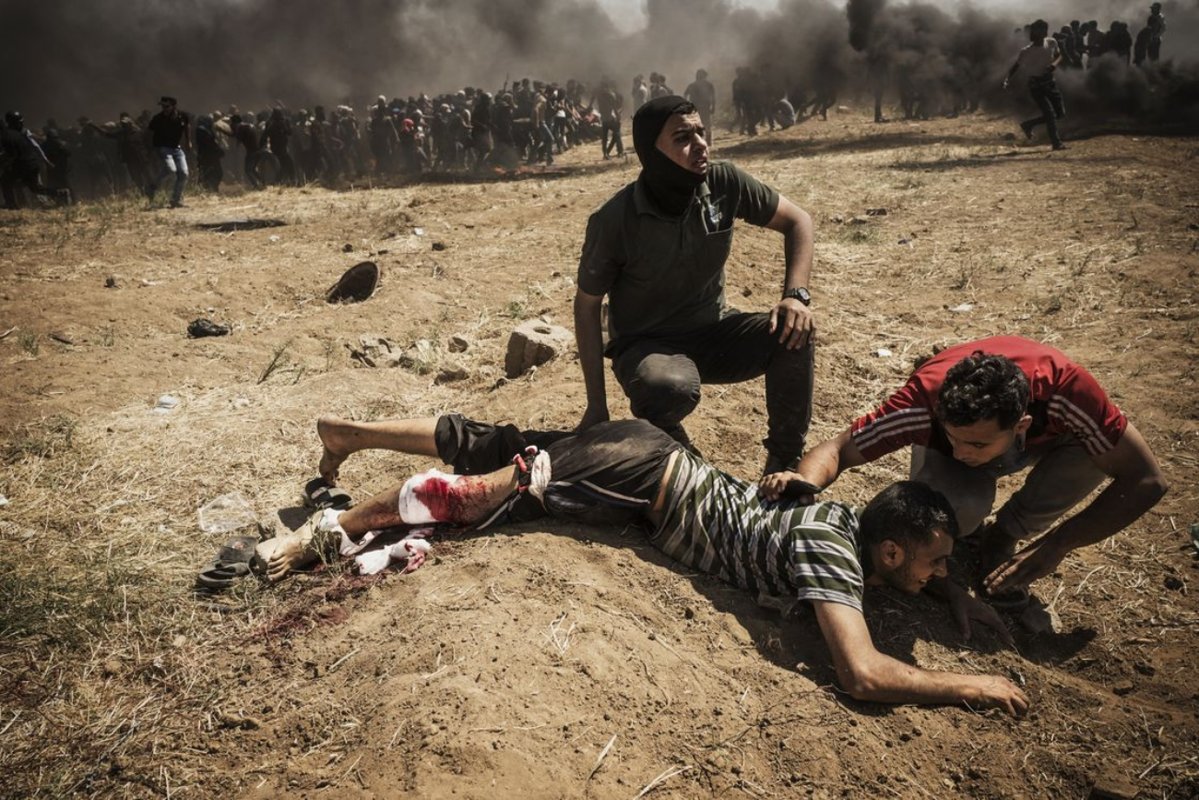
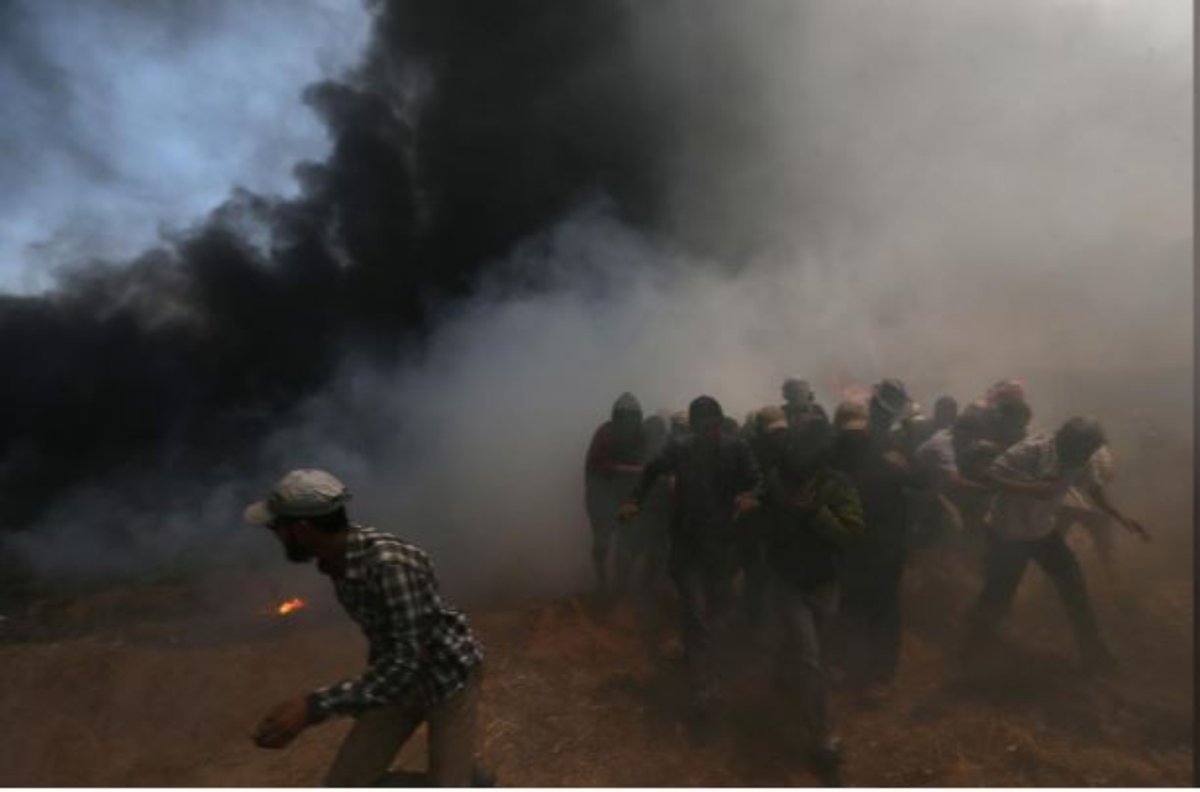
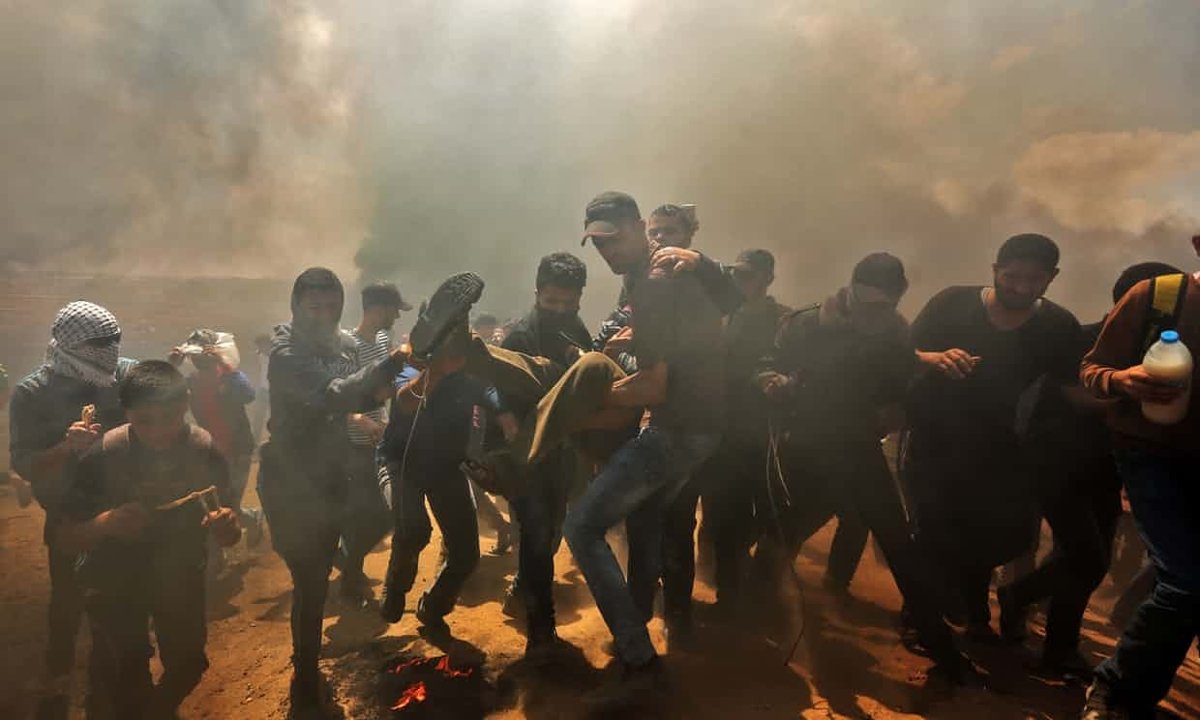 At least 58 Palestinians were killed and more than 2,700 injured in Gaza
as deadly protests took place ahead of, during and after the ceremony
in Jerusalem,including five children under the age of 18. Almost 2,000
sustained injuries, more than 900 with live ammunition,10,000 "violent
rioters" were participating in the Gaza protest.
At least 58 Palestinians were killed and more than 2,700 injured in Gaza
as deadly protests took place ahead of, during and after the ceremony
in Jerusalem,including five children under the age of 18. Almost 2,000
sustained injuries, more than 900 with live ammunition,10,000 "violent
rioters" were participating in the Gaza protest.
Thousands of demonstrators have gathered at the border, setting fire to tyres and sending thick plumes of black smoke into the air to deter Israeli snipers at several spots, while the Israeli military said the protests were being used as cover for attacks and assaults on the border fence.In the West Bank, several thousand people gathered in the centre of Ramallah, while hundreds marched to the Qalandiya crossing on the outskirts of Jerusalem, where protesters threw stones at Israeli troops.Monday marks the biggest showdown in recent weeks between Israel's military and Gaza's Hamas rulers along the volatile border.The relocation of the embassy from Tel Aviv, a key campaign promise of US president Donald Trump, has infuriated the Palestinians, who seek east Jerusalem as a future capital.At least two Palestinians have been killed and dozens more injured as Israeli troops opened fire on protesters heading for the border with Israel ahead of the inauguration of a new US embassy in Jerusalem.The march is scheduled to be the biggest yet in a long campaign against a decade-old blockade of the territory.As crowds began to swell at midday, Israeli troops began firing from across the border fence. Palestinian health officials reported two people killed and at least 69 others wounded by gunfire, nine of them seriously.A majority of Gaza’s two million people are descendants of refugees, and the protests have been billed as the “Great March of Return”.Leaflets dropped over Gaza by army jets warned that those approaching the border “jeopardise” their lives. The warning said the army is “prepared to face all scenarios and will act against every attempt to damage the security fence or harm IDF soldiers or Israeli civilians”.US treasury secretary Steven Mnuchin said that it was a US “national security priority” to move the embassy from Tel Aviv to Jerusalem. Trump’s decision to go forward with a campaign promise to move the American embassy from Tel Aviv to Jerusalem was welcomed by Israel and condemned by the Palestinians. Previous US presidents had signed a waiver postponing the move, citing national security.Chief Palestinian negotiator Saed Erekat said Mr Trump was "crossing red lines" with his decision."I think tonight he is strengthening the forces of extremists in this region as no-one has done before, this is an act, a statement that is totally uncalled for, totally unacceptable," he said.Qatar's Foreign Minister Mohammed bin Abdulrahman Al Thani said the change in policy was a "dangerous escalation and death sentence for all who seek peace".Israeli Prime Minister Benjamin Netanyahu hailed Mr Trump's announcement as a "historic landmark" and urged other countries also to move their embassies in Israel to Jerusalem.He said it was an "important step toward peace" and his country was "profoundly grateful".The UN's Mr Guterres said there was no alternative to a two-state solution between Israel and the Palestinians and that Jerusalem was a final-status issue that should be resolved through direct talks.Foreign Minister Julie Bishop made it clear that Australia does not back the Trump administration's decision."We've not ever supported unilateral action on either side. We believe that for there to be an enduring peace both sides must come together and negotiate an outcome, that includes on the status of Jerusalem," she said.Ms Bishop said Australia remained optimistic that a two-state solution was possible, but the President's decision made any negotiations over East Jerusalem "very complex".She also said Australia had no plans to move its embassy from Tel Aviv.Indonesian President Joko Widodo said Mr Trump's statement could threaten the stability of global security.He said he asked the peak body of Islamic countries, the Organisation of Islamic Cooperation, to hold a special meeting about the issue and told Indonesia's Foreign Minister to summon the US ambassador to express Indonesia's position.
CHILD TRAFFICKING ,CHILD LABOURERS AND THE PLAQUE OF MODERN SLAVERY.MORE THAN 165 MILLION CHILDREN ARE ENGAGED IN CHILD LABOUR ALL OVER THE WORLD.
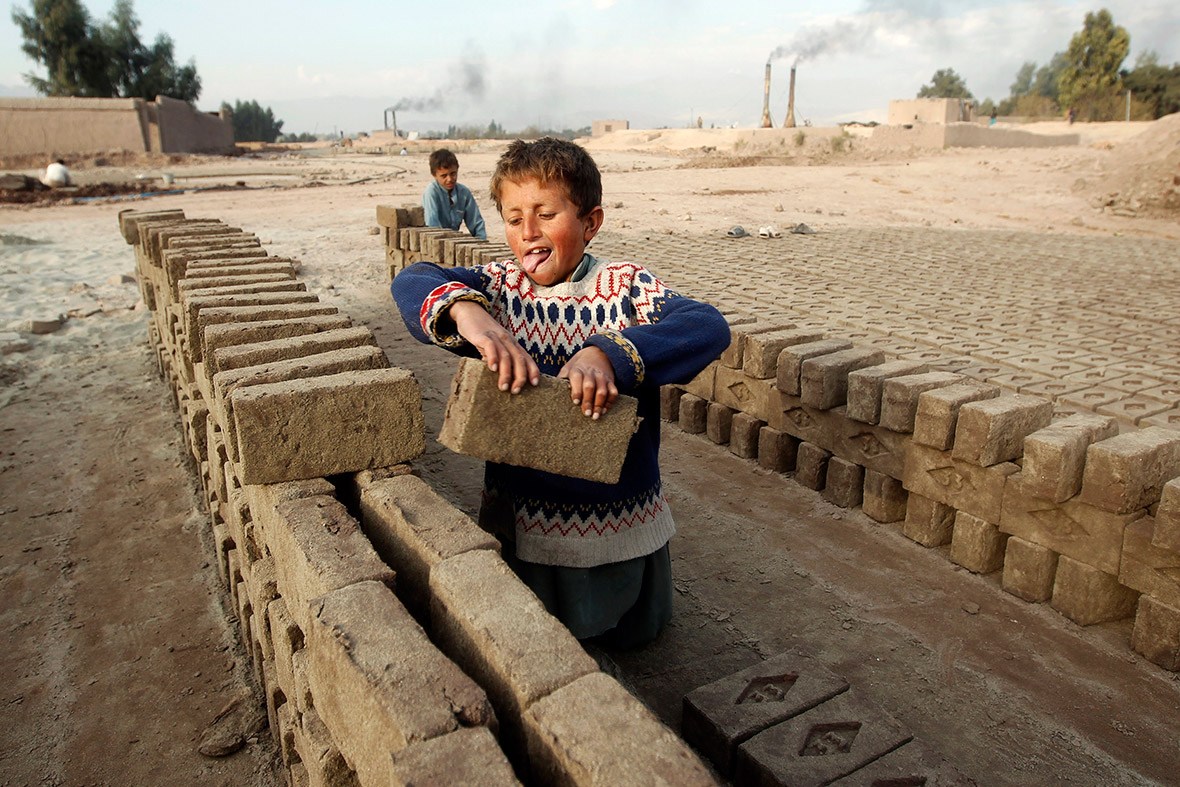
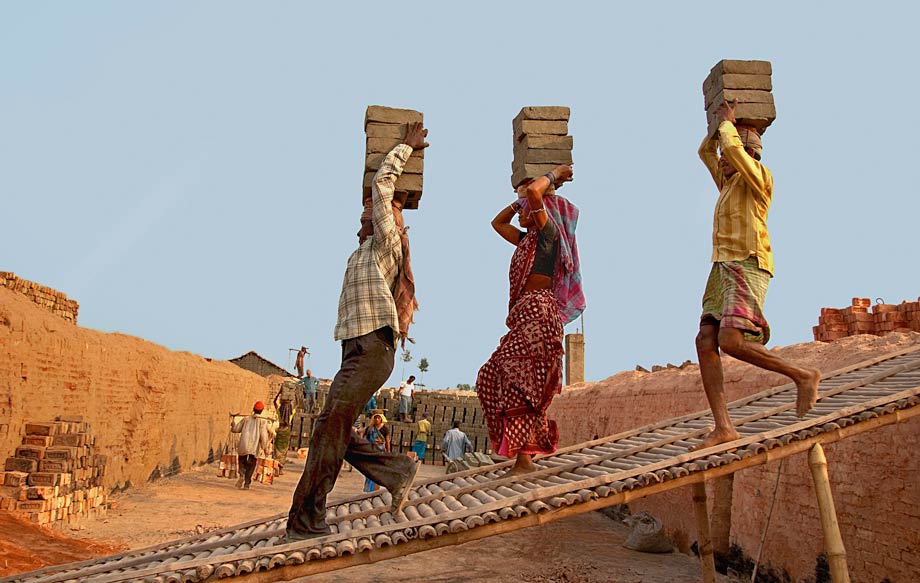 Thousands of children found working in brick kiln in Nepal, Afghanistan, Pakistan, India, Sri Lanka and Bangladesh.Girls as young as seven found carrying bricks on their head.Some of the children were as young as four.Many children end up working alongside their parents because of a lack of schools and teachers.Local officials said they would investigate why the rescued children had not been enrolled in a nearby primary school.
Thousands of children found working in brick kiln in Nepal, Afghanistan, Pakistan, India, Sri Lanka and Bangladesh.Girls as young as seven found carrying bricks on their head.Some of the children were as young as four.Many children end up working alongside their parents because of a lack of schools and teachers.Local officials said they would investigate why the rescued children had not been enrolled in a nearby primary school.
History books tell the 400-year story of one of the most unfathomable practices ever engaged in by mankind of humans being bought, sold and traded as commodities, and of men and women shackled together on slave ships destined towards a life of captivity. This is indicative of the radical transformation of the international community in its attitude towards an inhumane practice that should have never been allowed to occur.In the world of work, over 165 million children aged 5 to 14 years are going to work. Of these, 74 million are engaged in work that could be dangerous to health. Compared with other continents, child labour is more in Asian countries. Despite the fact that over the past six years the number of minors who work here fell by nearly 5 million people, yet 122 million children and adolescents aged 5 to 14 years engaged in commercial activities or in the workplace. Among all countries, child labour is more in Nepal, Afghanistan, Pakistan, India, Sri Lanka and Bangladesh.Every week, thousands of people move from their traditional communities to find work in large cities. In border towns like Siliguri in India, children are at risk of harm, exploitation and abuse. Away from the support of their extended families and communities, children are easy targets for traffickers, who transport them across India or into other countries. World Vision is working to protect, empower and educate children in Siliguri. Learn more about our work in child protection.Modern forms of slavery can include debt bondage, where a person is forced to work for free to pay off a debt, child slavery, forced marriage, domestic servitude and forced labour, where victims are made to work through violence and intimidation.Child labour in Pakistan has increased in last two decades. The main causes of child labour are large family size, and unemployment. People with low wages or earnings and too many children cannot afford in quality life. They can’t even fill the stomach of their children , rather they could send them to school. So the children in such families are sent to learn some skills and earn while learn. People with too many dependents are unable to groom themselves. They find no resources to improve them personality. Thus, they have to lose all opportunities in life. They are being replaced by quality workers, so they lose their employment. To get rid of their miserable condition, they send the children to find work. Children under age are hired at extrem low salaries and most by are abused by their employers and adult co-workers. There should be proper law for child-labour. The children working at young age need to be protected by adults of our society.Considerable differences exist between the many kinds of work children do. Some are difficult and demanding, others are more hazardous and even morally reprehensible. Children carry out a very wide range of tasks and activities when they work.Not all work done by children should be classified as child labour that is to be targeted for elimination. Children’s or adolescents’ participation in work that does not affect their health and personal development or interfere with their schooling, is generally regarded as being something positive. This includes activities such as helping their parents around the home, assisting in a family business or earning pocket money outside school hours and during school holidays. These kinds of activities contribute to children’s development and to the welfare of their families; they provide them with skills and experience, and help to prepare them to be productive members of society during their adult life.The term “child labour” is often defined as work that deprives children of their childhood, their potential and their dignity, and that is harmful to physical and mental development.In its most extreme forms, child labour involves children being enslaved, separated from their families, exposed to serious hazards and illnesses and/or left to fend for themselves on the streets of large cities often at a very early age. Whether or not particular forms of “work” can be called “child labour” depends on the child’s age, the type and hours of work performed, the conditions under which it is performed and the objectives pursued by individual countries. The answer varies from country to country, as well as among sectors within countries. All forms of slavery or practices similar to slavery, such as the sale and trafficking of children, debt bondage and serfdom and forced or compulsory labour, including forced or compulsory recruitment of children for use in armed conflict.The use, procuring or offering of a child for prostitution, for the production of pornography or for pornographic performances. The use, procuring or offering of a child for illicit activities, in particular for the production and trafficking of drugs as defined in the relevant international treaties.Work which, by its nature or the circumstances in which it is carried out, is likely to harm the health, safety or morals of children.Labour that jeopardises the physical, mental or moral well-being of a child, either because of its nature or because of the conditions in which it is carried out, is known as “hazardous work”.In order to appreciate the trafficking bill, some understanding of the history of international and domestic anti-trafficking law is essential. Against this backdrop it will soon become clear that the proposed law will do little to alleviate India’s shame of harbouring the highest number of the world’s ‘modern slaves’. It also seems to be a shallow attempt to ape a highly carceral, western approach to a juridically constructed problem of ‘trafficking’ undertaken in perfect amnesia of a richer, more systemic, and indigenous legal approach to the exploitation that has long afflicted vulnerable sections of India’s work force. Herein lies the irony of poorly thought out laws meant to act as band-aids on the long festering problem of severely unequal wealth and resource distribution.
 How we can fight child labour in the tobacco industry.Many of them complained of suffering nausea, vomiting,
headaches, and dizziness while they worked all symptoms consistent
with acute nicotine poisoning, or green tobacco sickness, from nicotine
being absorbed through the skin while handling tobacco.
How we can fight child labour in the tobacco industry.Many of them complained of suffering nausea, vomiting,
headaches, and dizziness while they worked all symptoms consistent
with acute nicotine poisoning, or green tobacco sickness, from nicotine
being absorbed through the skin while handling tobacco.
Worldwide, 60 per cent of all child labour in the age group five to 17 years work in agriculture, including farming, fishing, aquaculture, forestry, and livestock. The majority of child labour are unpaid family members. One component of providing access to education is the School Infrastructure Development programme which focuses on improving school facilities, including sanitation, potable water, sports facilities and classroom equipment.An After School Programme seeks to prevent children from dropping out of school by providing them meals and engaging them in post-school activities, particularly during peak agriculture season, when the need for working hands is higher. “Our programme has been implemented in more than 50 schools in Andhra Pradesh and Karnataka. Over the years, we have seen a significant change in the school-going patterns of children.“Students, supported by parents, prefer to go to schools which now have good facilities and infrastructure. We are pleased at the way in which local communities have joined hands with us in spreading awareness against child labour and encouraging students to attend schools“Trafficking in persons” shall mean the recruitment, transportation, transfer, harbouring or receipt of persons, by means of the threat or use of force or other forms of coercion, of abduction, of fraud, of deception, of the abuse of power or of a position of vulnerability or of the giving or receiving of payments or benefits to achieve the consent of a person having control over another person, for the purpose of exploitation. Exploitation shall include, at a minimum, the exploitation of the prostitution of others or other forms of sexual exploitation, forced labour or services, slavery or practices similar to slavery, servitude or the removal of organs: The consent of a victim of trafficking in persons to the intended exploitation set forth in subparagraph of this article shall be irrelevant where any of the means set forth in subparagraph have been used.Another layer of complexity comes from trafficking’s long history of association with prostitution. Historically, and more recently, trafficking was conflated with trafficking for sex work and, indeed, with sex work itself. When the US government then started ranking governments annually in the US State Department’s Trafficking in Persons Reports in terms of their actions to prevent trafficking and prosecute traffickers, and then withholding “nonhumanitarian, non-trade-related” aid from the worst offenders, governments scrambled to amend their anti-sex work laws in order to be placed higher up in the TIP rankings. Regions of the world like south Asia, meanwhile, became playgrounds of sexual humanitarianism, as religious evangelicals and liberals alike sought to rescue third world sex workers and purchase their ‘freedom’.Competing legal traditions and government inaction.It is in the context of these international developments that we need to assess the Indian trafficking bill. Like most countries around the world, India has a growing architecture of anti-trafficking law, put into place at different points in time to address varied manifestations of extreme labour exploitation. Yet the Indian Penal Code does not define the terms slavery, bondage, forced labour, or begary (where a person has been forced to work against his will and without payment). Many of the labour-related provisions in the IPC were a product of colonial rule, and thus they reflected the realities of that time. They also often furthered the colonial government’s interests in extracting compulsory labour from the natives.Meanwhile, the Indian Constitution, as a self-styled radical legal document reflecting postcolonial aspirations for modern nationhood, is concerned with indigenous forms of servitude. Under Part III, which deals with fundamental rights, Article 23 prohibits the traffic in human beings, begary, and other similar forms of forced labour, making the contravention of this provision an offence punishable in accordance with law.The Indian government needs to pause and dig deep into its own long and complex legal history, as well as its unique vision of dealing with extreme forms of exploitation that today travel under the conceptual banner of ‘trafficking’.In the 1970s, India, keen to live up to the aspirations of the Indian Constitution, passed several social legislations. These were the Bonded Labour System (Abolition) Act, 1976, as amended by the Bonded Labour System (Abolition) Amendment Act, 1985 (BLSAA); the Contract Labour (Regulation & Abolition) Act, 1970, as amended by the Contract Labour (Regulation & Abolition) Amendment Act No.14 of 1986 (CLRAA); and the Inter-State Migrant Workmen Act (Regulation of Employment and Conditions of Service) Act, 1979 (ISMWA).All of these laws counter extreme forms of labour exploitation that are now commonly included under the term trafficking. Their intervention models are comprehensive, multi-pronged, community-based, and aimed at systemic reform – several notches above any simplistic attempts at rescue and rehabilitation. The BLSAA, for instance, not only prohibits and penalises existing and future bonded labour; all bonded labourers are set free and, by law, their obligation to repay the debt is extinguished.The BLSAA has several elaborate provisions rendering existing and future legal action arising from the debt void. Creditors accepting any repayment for an extinguished debt can face imprisonment and fines. Local district magistrates have to ensure the act’s implementation, the eradication of bonded labour, and the rehabilitation of bonded labourers so as to prevent their becoming bonded again. Vigilance committees with representatives of the state, the affected community, social workers, rural development institutions, and credit institutions are to assist the executive in this, while also defending suits against freed bonded labourers. The CLRAA and ISMWA, meanwhile, address chronic exploitation by intermediaries and sub-contractors by imposing on them the obligations of the employer. Consider the case of India! Globalization has helped the Indian economy to stand on its own in due time but has also catapulted the need of cheap unskilled labour. Unfortunately, millions of children are included in this huge domain of unskilled labourers. Not only they are deprived of their childhood, but also they are stripped of their fundamental rights.Not to talk about their meagre wages what they receive, India is one of the countries in South East Asia where human trafficking has become a menace. The migration of children from rural areas to urban domain has always been a common feature in Indian society. The meteoric rise of urban Indian culture has necessitated huge real estate growth where millions of children are engaged in physically intensive work which is detrimental to their natural growth and development. Let’s not forget the plight of the domestic helps in India, where it has become a norm to keep little children as domestic helps. The condition of girls in the child labour sector is pathetic to say the least. Minimal education, malnutrition, early marriage, societal exploitation and even prostitution have become common in this arena.It is indeed very sad to say that last year, the central government of India amended child labour laws to allow children below 14 to work in family businesses and the entertainment industry (excluding circuses). In India 33 million children are employed in various forms of child labour. There is no denying the fact that education is the only solution to abolish child labour in a developing country like India. Migration and debt trap have always been culprits in the rural economy and thus awareness programmes are indeed necessary.
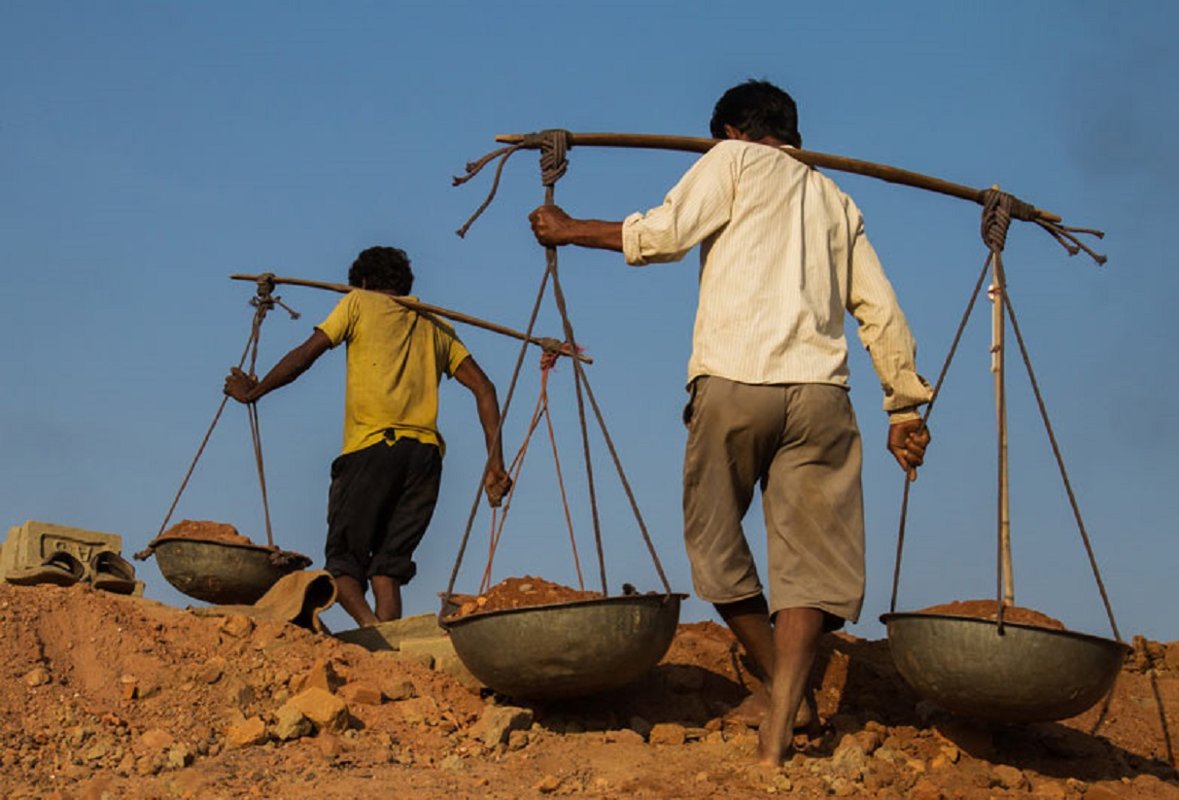 Child labourers are vulnerable to abuse, and their families are often
trapped in a cycle of poverty. In extreme cases, children are forced to
work under threat of violence or death. Children can fall ill and get
injured injuries have been as severe as loss of body parts.When children are of an appropriate age for the task, receive
appropriate pay and work in safe environments, they can be considered
“willing participants in work.” These children can balance work with
school and play, and they develop the necessary skills to transition
into adulthood.
Child labourers are vulnerable to abuse, and their families are often
trapped in a cycle of poverty. In extreme cases, children are forced to
work under threat of violence or death. Children can fall ill and get
injured injuries have been as severe as loss of body parts.When children are of an appropriate age for the task, receive
appropriate pay and work in safe environments, they can be considered
“willing participants in work.” These children can balance work with
school and play, and they develop the necessary skills to transition
into adulthood.
Lack of financial institutions for the extreme poor can push them towards unregulated money-lenders who charge high interest rates or insist on large loans that leave the poor vulnerable to debt bondage.Poverty can trap people in debt bondage, because interest may add to the debt burden as fast as the person in debt can pay it off, Money-lenders may deliberately structure credit arrangements to trap people into long term debt bondage.Poverty can make it impossible for the poor to move to an area where they can get employed as free worker.Poverty may make it impossible for a worker to challenge an 'illegal' labour situation.When children, especially young ones are exposed to long hours of work in harsh and dangerous environments, which threatens their lives and limbs as well as jeopardize their normal physical, mental, emotional and moral development, it is termed child labour. As a result, they cannot imagine bettering something. I think though Bangladesh is a developed country, so most of the lower level of peoples is involving in service-oriented sectors to earned money. Most of the children they are doing domestic very little business. As a result, they do not get educationally facilities.Child domestic service is a widespread practice in Bangladesh. The Rapid Assessment of Child Labour Situation in Bangladesh estimated that in the city of Dhaka alone there were about 120,000 child domestics. Especially in Dhaka, city employers in the urban areas usually recruit children from their village homes through family, friends or contacts. Most of the child domestic workers come from the most vulnerable families, many of them being orphans or abandoned children. The majority of child domestics tend to be between 12 and 16years old, but children as young as 5 or 6 years old can also be found working. A survey of child domestic workers found that 38 percent were 11 to 13 years old and nearly 24 percent were 5 to 1years old. Their employers usually take care of their daily necessities like clothes, oil, soap, comb, towel, bedding and sleeping materials. The child domestic workers are often the least paid in the society, their remuneration ranging from 8taka to 40taka per month. In most of the cases, they hand over all their earnings to their parents, leaving nothing for themselves.Currently, child labor in Bangladesh is a critical issue. Day by day child labor is growing in different sectors. I think scarcity of one’s income to maintain his/her family and high density of population are the two main causes of child labor in our country. Different children are involved in difference activities to earn. Some children are involved with their traditional family jobs like clay modelling. Clay modeling was a tradition of our country earlier. Now this sector is in a destroyed position in Bangladesh. However, till now parents are sending their little children at hard work to save their family tradition with encourage. However, they do not get minimum facilities from the government and any private organization. As a result, unemployment and illiteracy rate is continuously increasing in Bangladesh.Child is any person who is yet to compete fourteen years of age’’. Bangladesh has the largest number of child workers in the world. They are employed in many industries and trades, including garments, footwear, brick kilns, stainless steel, hotels, textile shops and bus contractor etc. A dense population, limited resources, and frequent natural calamities complicate the poverty situation in Bangladesh and children are the worst victims. Although child labour is not illegal in Bangladesh but government or private organization have not take any positive steps to reduce the child labour. Among them large number of child is working by Bus helper or bus contractors to early age. As a result child labour is increasing day by day in Bangladesh.This has produced a vast pool of people in need of work.International anti-slavery law is not effectively enforced.There is a lack of institutions and procedures to enforce it.Some countries don't effectively enforce anti-slavery laws.This may not always be done for completely unethical reasons - if the alternative is wholesale starvation, then a government may choose not to enforce the law against slavery.
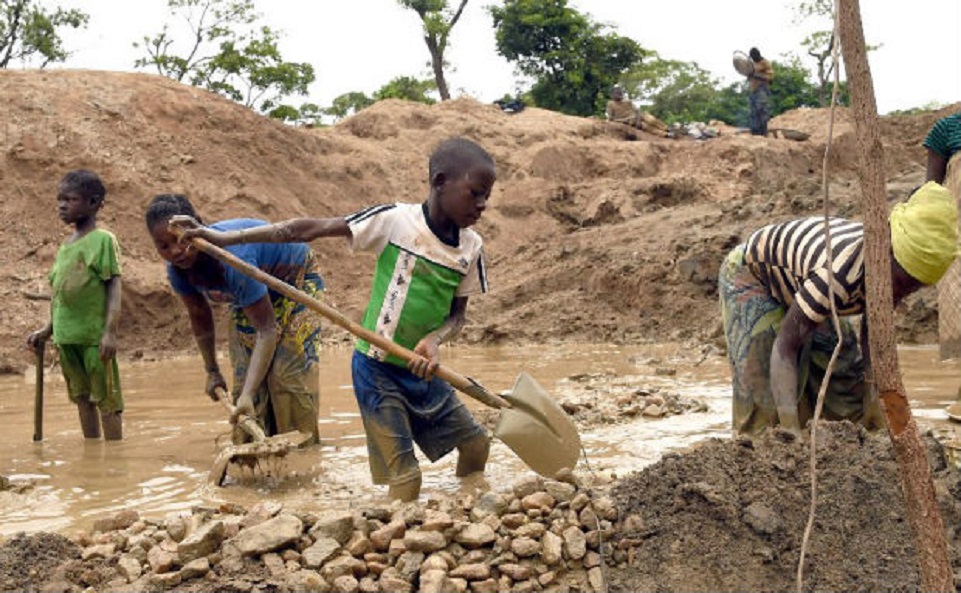 Children mining cobalt for batteries in the Congo,investigation has found child labor being used in the dangerous mining of cobalt in the Democratic Republic of Congo. The mineral cobalt is used in virtually all batteries in common devices, including cellphones, laptops and even electric vehicles.The work is hard enough for an adult man, but it is unthinkable for a child. Yet tens of thousands of Congolese kids are involved in every stage of mining for cobalt.But for the Chinese middlemen who buy the cobalt, there were no such constraints; they have free access.
Children mining cobalt for batteries in the Congo,investigation has found child labor being used in the dangerous mining of cobalt in the Democratic Republic of Congo. The mineral cobalt is used in virtually all batteries in common devices, including cellphones, laptops and even electric vehicles.The work is hard enough for an adult man, but it is unthinkable for a child. Yet tens of thousands of Congolese kids are involved in every stage of mining for cobalt.But for the Chinese middlemen who buy the cobalt, there were no such constraints; they have free access.
Global number of children in child labour has declined by one third since 2000, from 246 million to 168 million children. More than half of them, 85 million, are in hazardous work (down from 171 million in 2000).There are 13 million (8.8%) of children in child labour in Latin America and the Caribbean and in the Middle East and North Africa there are 9.2 million (8.4%).Agriculture remains by far the most important sector where child labourers can be found (98 million, or 59%), but the problems are not negligible in services (54 million) and industry (12 million) mostly in the informal economy.African children have worked in farms and at home over a long history. This is not unique to Africa; large number of children have worked in agriculture and domestic situations in America, Europe and every other human society, throughout history, prior to 1950s. Scholars suggest that this work, specially in rural areas, was a form of schooling and vocational education, where children learned the arts and skills from their parents, and as adults continued to work in the same hereditary occupation. Bass claims this is particularly true in the African contex.Africa is a highly diverse and culturally developed clan. In parts of this clan, farming societies are a system of patrilineal clans and lineages. The young train with the adults. The family and kinsfolk provide a cultural routine that help children learn useful practical skills and enables these societies to provide for itself in the next generation. Historically, there were no formal schools, instead, children were informally schooled by working informally with their family and kin from a very early age. Child labor in Africa, as in other parts of the world, was also viewed as a way to instill a sense of responsibility and a way of life in children particularly in rural, subsistence agricultural communities. In rural Pare people of northern Tanzania, for example, five year olds would assist adults in tending crops, nine year olds help carry fodder for animals and responsibilities scaled with age.In northern parts of sub-Saharan Africa, Islam is a major influence. Begging and child labour was considered as a service in exchange for quranic education, and in some cases continues to this day. These children aged 7–13, for example, were called almudos in Gambia, or talibés in Senegal. The parents placed their children with marabout or serin, a cleric or quranic teacher. Here, they would split their time between begging and studying the Quran. This practice fit with one of the five pillars of Islam, the responsibility to engage in zakat, or almsgiving.The growth of colonial rule in Africa, from 1650 to 1950, by powers such as Britain, France, Belgium, Germany and Netherlands encouraged and continued the practice of child labour. Colonial administrators preferred Africa's traditional kin-ordered modes of production, that is hiring a household for work not just the adults. Millions of children worked in colonial agricultural plantations, mines and domestic service industries.Children in these colonies between the ages of 5-14 were hired as apprentice without pay in exchange for learning a craft. Colonial British laws, for example, offered the native people ownership to some of the native land in exchange for making labor of wife and children available to colonial government's needs such as in farms and as picannins.Fast-fashion retailers such as H&M, New Look, and Sports Direct’s Lonsdale label were all found to have worked with factories which employed 14 year old children in Myanmar, according to the new report “The Myanmar Dilemma” from the Amsterdam-based organisation the Centre for Research on Multinational Corporations (also known as Somo). Some interviewed over 400 workers in 12 factories which supplied garments for international fashion brands and found workers were being paid half of the full legal minimum wage, in addition to a number of children workers as young as 14 working over-time.If a supplier doesn't live up to our standards or national legislation we - in accordance with our routines - demand that the supplier immediately establishes an action plan, which has been done also in this case. One of the measures concerning the twosuppliers in question is improved recruitment routines, which has resulted in improved handling of ID-cards."H&M said the Bangladesh Fire and Safety Accord was extremely important to the company."Although being behind the projected schedule, we are experiencing good progress. This ‘race to the bottom’ led by fashion retailers forever in search for the lowest production hub causes unhealthy competition between garment producing countries in the region, argues Some in the report. “The rule of law in Myanmar is not adequately upheld. The army still has a lot of influence. The garment industry’s operations go largely unchecked. The question is justified if the time is ripe for foreign companies to invest in Myanmar. Garment brands should think twice before they start production in Myanmar. The risk of labour rights violations is very high. Companies should make a thorough analysis of all potential problems. They must ensure that they, together with their suppliers, identify and tackle these risks before placing any orders.It in not the first time H&M has been accused of working with factories that employ workers as young as 14 in Myanmar.
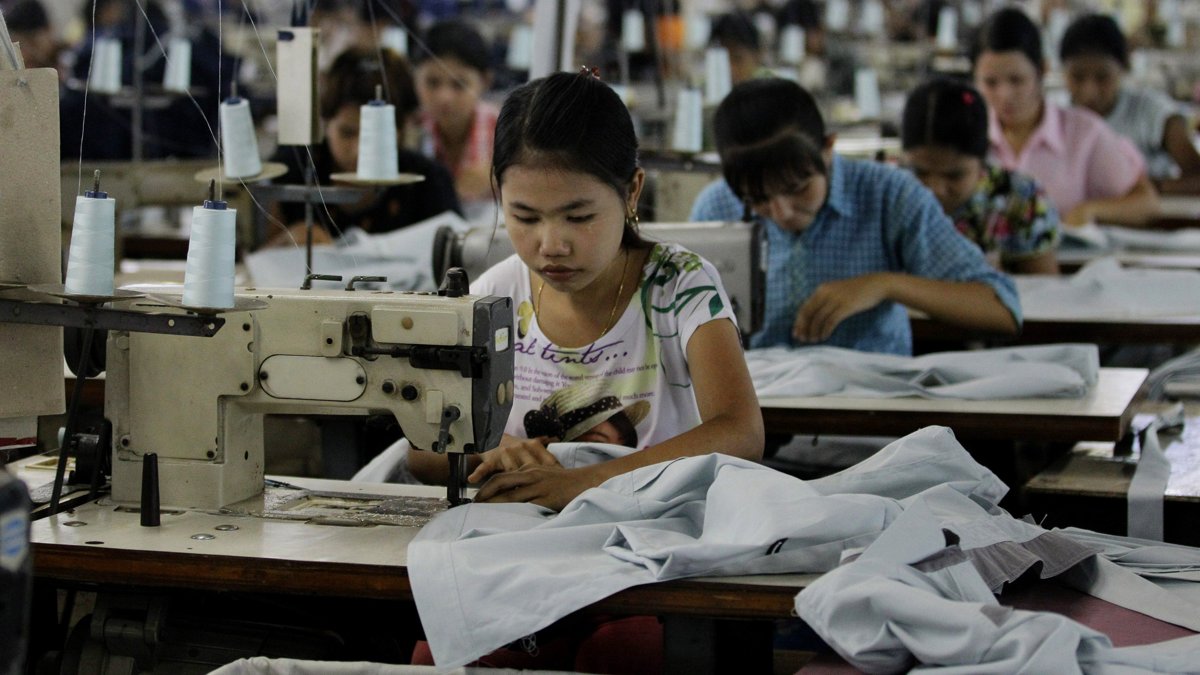
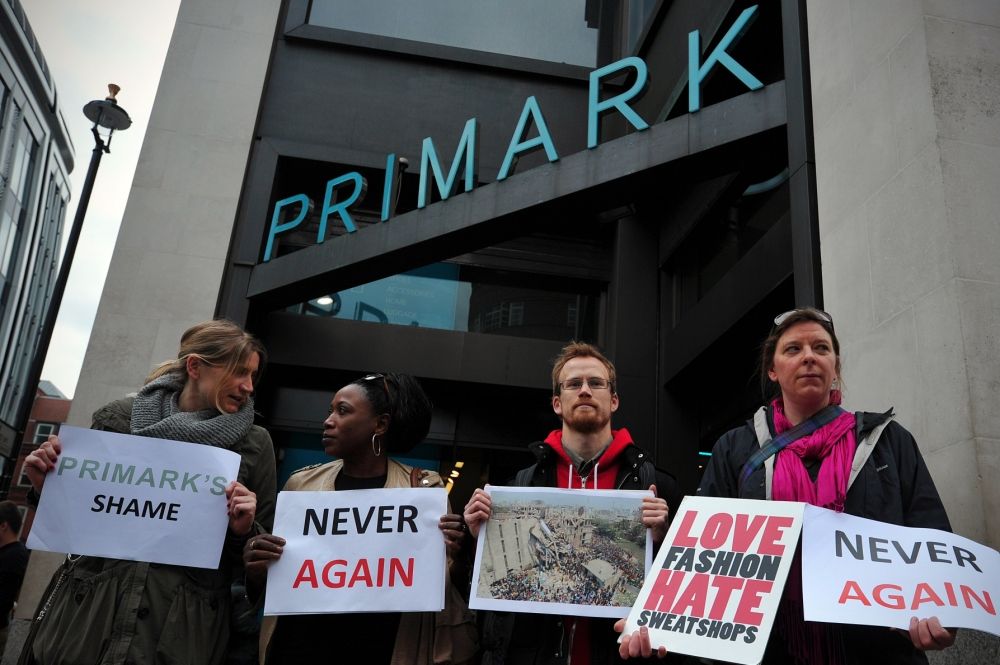 Primark axes suppliers for using child labour .Fashion chain Primark has axed three longstanding suppliers in southern India for using child labour after being alerted to the practice .The three suppliers - from the Tirapur region of the Tamil Nadu province - were sub-contracting embroidery work on dresses to child home workers. Almost its entire range is sourced from low-cost suppliers in Asia.
Primark axes suppliers for using child labour .Fashion chain Primark has axed three longstanding suppliers in southern India for using child labour after being alerted to the practice .The three suppliers - from the Tirapur region of the Tamil Nadu province - were sub-contracting embroidery work on dresses to child home workers. Almost its entire range is sourced from low-cost suppliers in Asia.
TRUMP'S IMMIGRANT POLICE ICE HAVE ALREADY ARRESTED THOUSANDS IMMIGRANTS WITHOUT CRIMINAL RECORDS.THIS WAS HITLER'S EMBARRASSING ACT TO JEWS.HITLER WOULD BE PROSECUTED BY ATTORNEYS FROM THE COUNTRIES THAT WERE HIS VICTIMS.
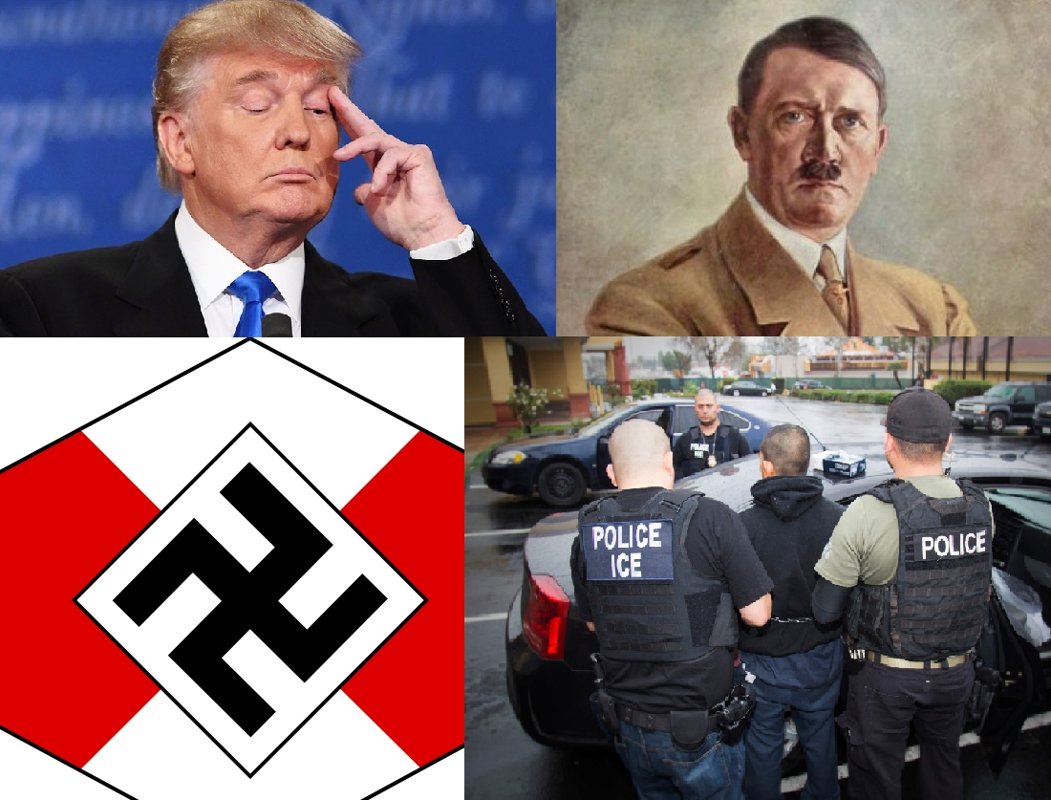 Trump is comparing to Adolf Hitler is an embarrassing act of Ignorance and also political irresponsiblility.Several times Trump has been compared to Adolf Hitler
by people in America, mainly by his political adversaries who
disagree with him passionately.
Trump is comparing to Adolf Hitler is an embarrassing act of Ignorance and also political irresponsiblility.Several times Trump has been compared to Adolf Hitler
by people in America, mainly by his political adversaries who
disagree with him passionately.
U.S. Immigration and Customs Enforcement, also known as “ICE”, is the law enforcement arm of the U.S. Department of Homeland Security that enforces American immigration laws. Among other duties, ICE is responsible for detaining and removing illegal immigrants. In many cases, however, ICE relies on local law enforcement authorities to identify, report, and turn over immigrants to them for deportation purposes.Donald Trump’s immigration crackdown has resulted in a surge of arrests. In a splashy statement, ICE said its agents arrested more than 41,000 people in the 100 days since Trump signed his executive orders on immigration a spike of nearly 40 percent when compared to the same period last year. “These statistics reflect President Trump’s commitment to enforce our immigration laws fairly and across the board,” the statement reads.The latest ICE stats have advocates particularly worried that arrests are increasingly happening away from the border, in the country’s interior.Immigration and Customs Enforcement (ICE) has listed several “sensitive locations” where they will not set up checkpoints or enter in order to arrest undocumented immigrants. These locations include schools, houses of worship, hospitals, and public demonstrations, though ICE says that arrests there are permissible under “exigent circumstances.”Courthouses are not sensitive locations, ICE states that enforcement action there “will only be executed against individuals falling within the public safety priorities of [Department of Homeland Security’s] immigration enforcement priorities set forth in the November 20, 2014, memorandum from Secretary Johnson.” However, this is not always the case – an undocumented woman was arrested outside of a courthouse in El Paso, Texas, where she was getting a protective order against an abusive ex-boyfriend. There have also been an increasing number of reports of similar arrests outside of courthouses across the country.Commission on Civil Rights, by majority vote, issued two statements: expressing concern that enforcing immigration detainers in courthouses diminishes access to justice for all persons, and urging the U.S. Department of Justice to work with police departments to ensure constitutional policing. The commission’s chairman, Catherine E. Lhamon, stated: “The Commission continues to fulfill its role in holding the federal government accountable in its efforts to enforce civil rights. Ensuring equal access to courthouses and constitutional policing are necessary parts of those efforts.”If you are stopped outside of a courthouse, you should not speak with ICE agents. You should use your right to remain silent, as well as invoke your right to legal representation. If you are worried about going to court alone, Long Island Jobs with Justice has the Accompaniment Project, which you can contact by sending an email to lijwj01@gmail.com or calling their hotline at (516) 387-2043.Instead of making our communities safer, this tactic actually puts a community at risk for increased crime. Witness who are undocumented will be afraid to testify against a defendant for fear of being picked up by ICE at the courthouse. It will be likely that the defendant will be released back into the community and go unpunished.Deportations and arrests of undocumented immigrants without criminal records soared in President Donald Trump's first year of office.The Detroit Free Press analyzed data from Immigration and Customs Enforcement (ICE) and U.S Border Patrol (USBP), and found a significant increase in the deportations and arrests of non-criminal immigrants.The Free Press reports a 117% increase in the number of deportations of undocumented immigrants with no criminal records, and 23% increase in deportations of immigrants with criminal records. Overall, deportations in Michigan and Ohio increased 56 percent.There was a 126% increase of ICE arrests of non-criminal undocumented immigrants, and a 52% increase of arrests overall.This reporting confirms the suspicions of many immigrants and immigration rights advocates, who have said that non-criminal deportations have risen, despite the Trump administration's rhetoric that they are prioritizing immigrants with criminal records.
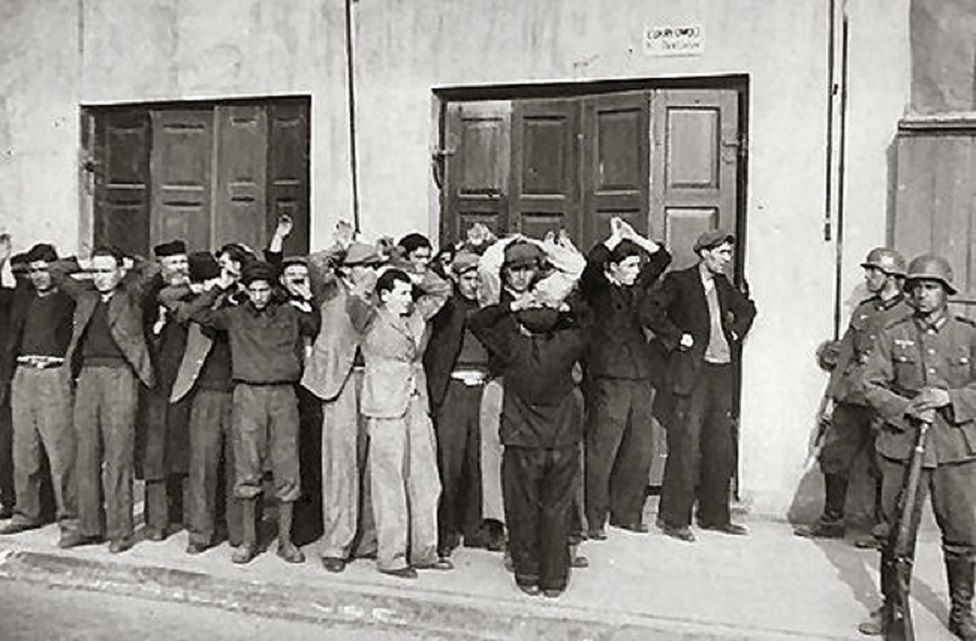 In January 1933, some 522,000 Jews by religious definition lived in Germany. Over half of these individuals, approximately 304,000 Jews, emigrated during the first six years of the Nazi dictatorship, leaving only approximately 214,000 Jews in Germany proper (1937 borders) on the eve of World WarII
In January 1933, some 522,000 Jews by religious definition lived in Germany. Over half of these individuals, approximately 304,000 Jews, emigrated during the first six years of the Nazi dictatorship, leaving only approximately 214,000 Jews in Germany proper (1937 borders) on the eve of World WarII
German Jews during the Hittler's Nazi Regime, 1939–1945
In January 1933, some 522,000 Jews by religious definition lived in Germany. Over half of these individuals, approximately 304,000 Jews, emigrated during the first six years of the Nazi dictatorship, leaving only approximately 214,000 Jews in Germany proper (1937 borders) on the eve of World War II.In the years between 1933 and 1939, the Nazi regime had brought radical and daunting social, economic, and communal change to the German Jewish community. Six years of Nazi-sponsored legislation had marginalized and disenfranchised Germany's Jewish citizenry and had expelled Jews from the professions and from commercial life. By early 1939, only about 16 percent of Jewish breadwinners had steady employment of any kind. Thousands of Jews remained interned in concentration camps following the mass arrests in the aftermath of Kristallnacht (Night of the Broken Glass) in November 1938.Yet the most drastic changes for the German Jewish community came with World War II in Europe. In the early war years, the newly transformed Reich Association of Jews in Germany (Reichsvereinigung der Juden in Deutschland), led by prominent Jewish theologian Leo Baeck but subject to the demands of Nazi German authorities, worked to organize further Jewish emigration, to support Jewish schools and self-help organizations, and to help the German Jewish community contend with an ever-growing mass of discriminatory legislation.Following the outbreak of war on September 1, 1939, the government imposed new restrictions on Jews remaining in Germany. One of the first wartime ordinances imposed a strict curfew on Jewish individuals and prohibited Jews from entering designated areas in many German cities. Once a general food rationing began, Jews received reduced rations; further decrees limited the time periods in which Jews could purchase food and other supplies and restricted access to certain stores, with the result that Jewish households often faced shortages of the most basic essentials.German authorities also demanded that Jews relinquish property “essential to the war effort” such as radios, cameras, bicycles, electrical appliances, and other valuables, to local officials. In September 1941, a decree prohibited Jews from using public transportation. In the same month came the notorious edict requiring Jews over the age of six to wear the yellow Jewish Star (Magen David) on their outermost garment. While ghettos were generally not established in Germany, strict residence regulations forced Jews to live in designated areas of German cities, concentrating them in “Jewish houses” (“Judenhäuser”). German authorities issued ordinances requiring Jews fit for work to perform compulsory forced labor.In early 1943, as German authorities implemented the last major deportations of German Jews to Theresienstadt or Auschwitz, German justice authorities enacted a mass of laws and ordinances legitimizing the Reich's seizure of their remaining property and regulating its distribution among the German population. The persecution of Jews by legal decree ended with a July 1943 ordinance removing Jews entirely from the protection of German law and placing them under the direct jurisdiction of the Reich Security Main Office. Deportation,public imagination associates the deportation of Jewish citizens with the “Final Solution,” but indeed the first deportations of Jews from the Reich albeit Jews from areas recently annexed by Germany began in October 1939 as part of the Nisko, or Lublin, Plan. This deportation strategy envisioned a Jewish “reservation” in the Lublin District of the Government General (that part of German-occupied Poland not directly annexed to the Reich). Adolf Eichmann, the German RSHA official who would later organize the deportation of so many of Europe's Jewish communities to ghettos and killing centers, coordinated the transfer of some 3,500 Jews from Moravia in the former Czechoslovakia, from Katowice (then Kattowitz) in German-annexed Silesia, and from the Austrian capital, Vienna, to Nisko on the San River. Although problems with the deportation effort and a change in German policy put an end to these deportations, Eichmann's superiors in the RSHA were sufficiently satisfied with his initiative to ensure that he would play a role in future deportation proceedings.In addition, RSHA officials coordinated the deportation of approximately 100,000 Jews from German-annexed Polish territory (the so-called province of Danzig-West Prussia, District Wartheland, and East Upper Silesia) into the Government General in the autumn and winter of 1939–1940. In October 1940, Gauleiter Josef Bürckel ordered the expulsion of nearly 7,000 Jews from Baden and the Saarpfalz in southwestern Germany to areas of unoccupied France in a second deportation of German Jews. French authorities quickly absorbed most of these German Jews in the Gurs internment camp in the Pyrenees of southwestern France.Upon Hitler's authorization, German authorities began systematic deportations of Jews from Germany in October 1941, even before the SS and police established killing centers (“extermination camps”) in German-controlled Poland. Pursuant to the Eleventh Decree of Germany's Reich Citizenship Law (November 1941), German Jews “deported to the East” suffered automatic confiscation of their property upon crossing the Reich frontier.Between October and December 1941, German authorities deported around 42,000 Jews from the so-called Greater German Reich including Austria and the annexed Czech lands of Bohemia and Moravia virtually all to ghettos in Lodz, Minsk, Kovno (Kaunas, Kovne), and Riga. German Jews sent to Lodz in 1941 and to Warsaw, the Izbica and Piaski transit ghettos and other locations in the Generalgouvernement in the first half of 1942 numbered among those deported together with Polish Jews to the killing centers of Chelmno (Kulmhof), Treblinka, and Belzec.German authorities deported more than 50,000 Jews from the so-called Greater German Reich to ghettos in the Baltic states and Belorussia (today Belarus) between early November 1941 and late October 1942. There the SS and police shot the overwhelming majority of them. After selecting a small minority to survive temporarily for exploitation as forced laborers, the SS and police interned them in special German sections of the Baltic and Belorussian ghettos, segregated from those few local Jews whose survival the SS and police had permitted, generally to exploit special occupational skills.Such “German ghettos” within a larger ghetto framework existed notably in Riga and in Minsk. SS and police officials killed most of these German Jews when they liquidated the ghettos in 1943. After late October 1942, the German authorities deported the majority of Jews remaining in Germany directly to the killing center at Auschwitz-Birkenau or to Theresienstadt.German regulations initially exempted German Jewish war veterans and elderly persons over the age of sixty-five, as well as Jews living in mixed marriages (“privileged marriages”) with German “Aryans” and the offspring of those marriages from anti-Jewish measures, including deportations. In the end, German officials deported disabled and highly decorated Jewish war veterans as well as elderly or prominent Jews from so-called Greater German Reich and the German-occupied Netherlands to the Theresienstadt (Terezin) ghetto near Prague. Although the SS used the ghetto as a showcase to portray the fiction of “humane” treatment of Jews, Theresienstadt in actuality represented a way station for most Jews en route to their deportation “to the east.” The SS and police routinely relocated Jews from Theresienstadt, including German Jews, to killing centers and killing sites in German-occupied Poland, Belorussia, and the Baltic States. More than 30,000 died in the Theresienstadt ghetto itself, mostly from starvation, illness, or maltreatment.In May 1943, Nazi German authorities reported that the Reich was judenrein (“free of Jews”). By this time, mass deportations had left fewer than 20,000 Jews in Germany. Some survived because they were married to non-Jews or because race laws classified them as Mischlinge (of mixed ancestry, or part Jewish) and were thus temporarily exempt from deportation. Others, called “U-Boats” or “submarines,” lived in hiding and evaded arrest and deportation, often with the aid of non-Jewish Germans who sympathized with their plight.In all, the Germans and their collaborators killed between 160,000 and 180,000 German Jews in the Holocaust, including most of those Jews deported out of Germany.
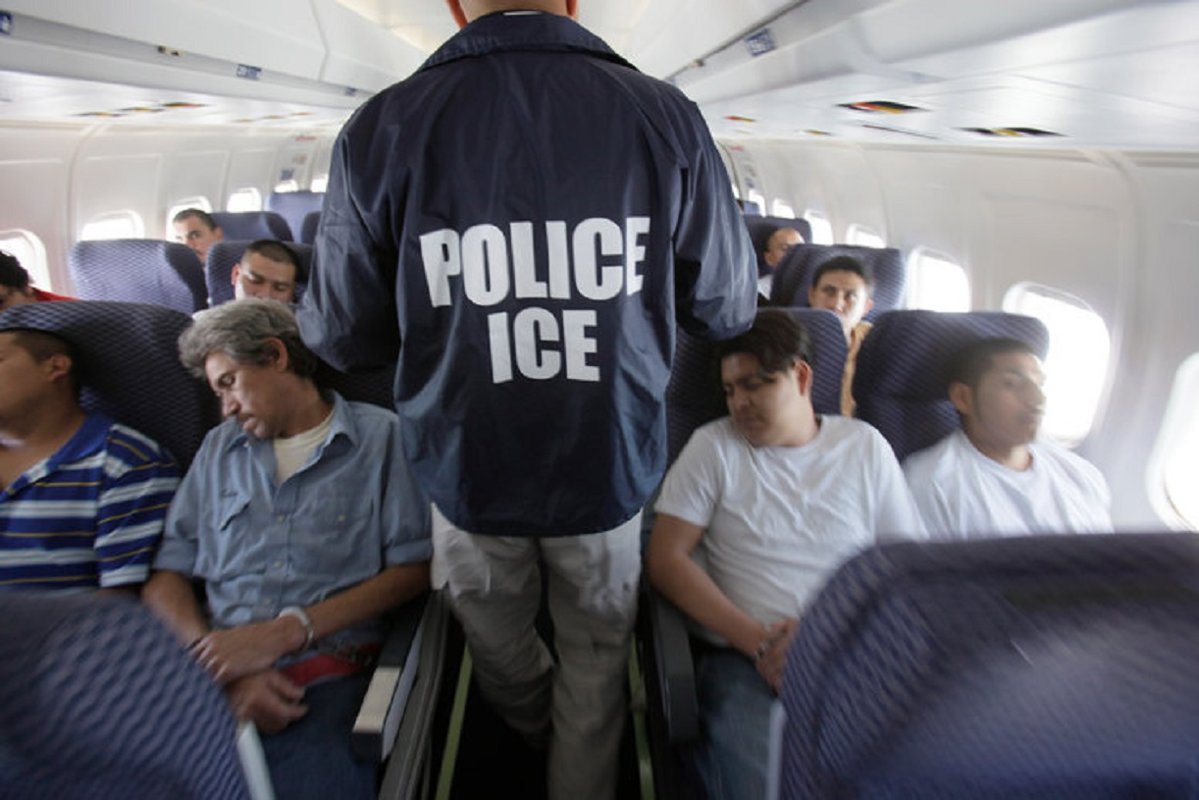
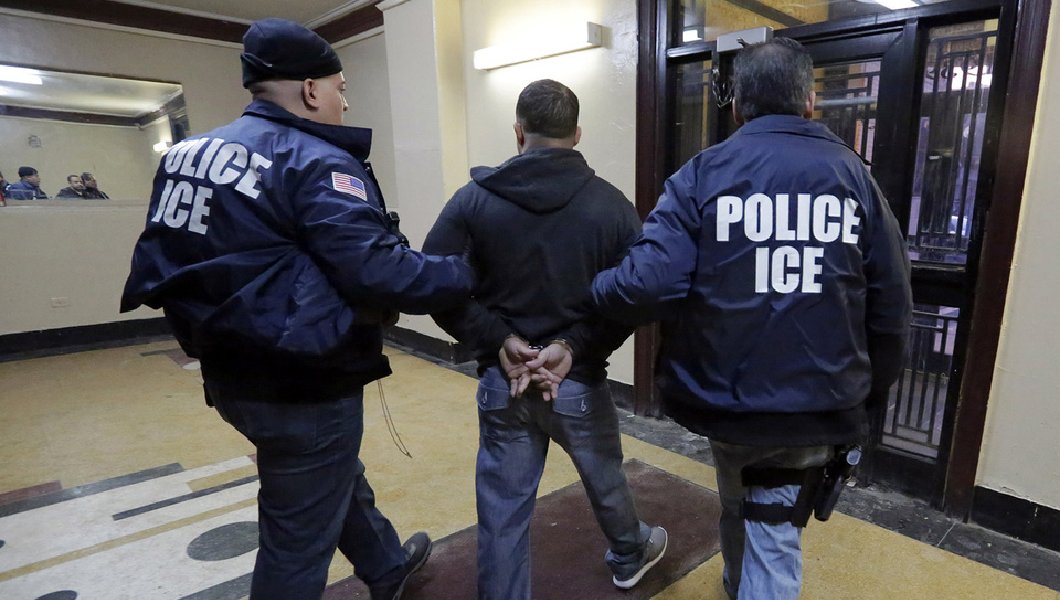
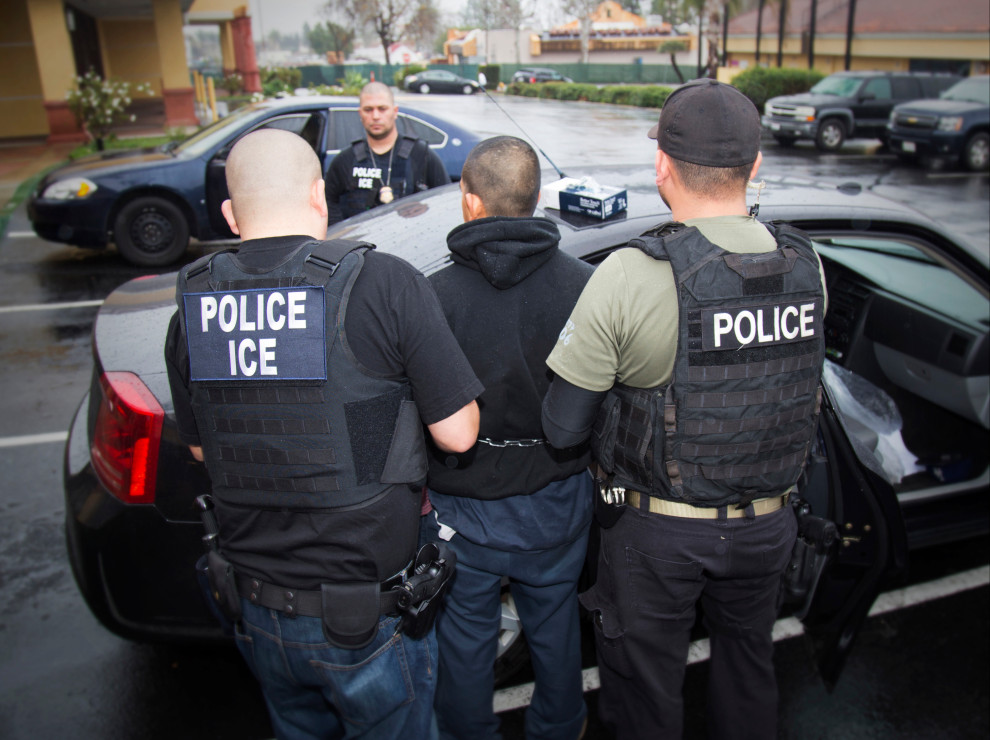 ICE arrests green card applicants in Lawrence, signaling shift In priorities.Federal immigration officers arrested five people in Lawrence when they showed up for scheduled appointments at a U.S. Citizenship and Immigration Services (USCIS) office.WBURhas confirmed that at least three of those arrested were beginning the process to become legal permanent residents. U.S. Immigration and Customs Enforcement (ICE) had orders to detain each of Thousand individuals for deportation.
ICE arrests green card applicants in Lawrence, signaling shift In priorities.Federal immigration officers arrested five people in Lawrence when they showed up for scheduled appointments at a U.S. Citizenship and Immigration Services (USCIS) office.WBURhas confirmed that at least three of those arrested were beginning the process to become legal permanent residents. U.S. Immigration and Customs Enforcement (ICE) had orders to detain each of Thousand individuals for deportation.
Congresswoman Nydia Velazquez introduced a new bill that would block Immigration and Customs Enforcement (ICE) officers from wearing clothing or protective gear with the word “police” on it. H.R. 2073 aims to amend section 287 of the Immigration and Nationality Act so that ICE agents cannot identify themselves as police by placing the term on any items they use.“Not only are ICE raids an unconscionable attack on our most vulnerable communities, any attempt by immigration officers to deceivingly pose as local police ought to be prohibited,” Congresswoman Velazquez said in a statement. “After holding various ‘Know Your Rights’ workshops in my district, I’ve heard firsthand from families who fear reporting crime or engaging with the police due to the potential of getting caught up with immigration agents. This only makes our communities less safe.”“Irrespective of whether it’s lawful to do that, that begs the question of whether it’s ethical to do it or whether it’s an appropriate policy to do it. It begs the question of whether ICE doing so endangers public safety, “ICE misidentifying itself as police officers in my city makes Los Angeles less safe for everyone.”Sarah Rodriguez, an ICE spokeswoman, argued that “It’s clear that we are a law enforcement agency…We have police authority.” She added, “It is the universally recognized term for law enforcement, and our personnel routinely interact with individuals from around the world.”Removing “police” from ICE uniforms and gear helps disassociate ICE agents from local law enforcement. This distinction is becoming increasingly important, as undocumented immigrants conflate the two and are then scared to call for help when they become the victims or witnesses of crime. When ICE agents wear “police” on their uniforms, the relationship between the immigrant community and local law enforcement agencies is damaged and the fear of authority increases.Immigration and Customs Enforcement chief John Morton has been quick to deny the agency sets quotas for deportations after a Washington Post story revealed an internal memo stating just that. The head of ICE’s detention and removal operations, where he complained that the overall number of immigrant removals was down.Non-criminal Removals are Falling Short of our Goal,” a headline said in the document.Police Union Head Says NYC Cops Want to Help ICE Deport More People.New York City Police Commissioner James O’Neill sent out a memo on how his department should respond to president Trump’s new immigration executive orders. The note was 431-words long, but could be summarized in just three: This changes nothing.“It is critical that everyone who comes into contact with the NYPD, regardless of their immigration status, be able to identify themselves or seek assistance without hesitation, anxiety or fear,” O’Neill reminded New York’s finest. “The NYPD does not conduct civil immigration enforcement .For example, the NYPD does not arrest or detain individuals for immigration violations such as overstaying a lawfully issued visa. However, the NYPD does and will continue to honor federal immigration detainers when there is a risk to public safety.”Those arrested represented many countries throughout the world, including: Bahamas, Chile, Colombia, Costa Rica, Cuba, Dominican Republic, Ecuador, El Salvador, Guatemala, Haiti, Honduras, India, Israel, Italy, Jamaica, Mexico, Nicaragua, Panama, Peru, South Africa, St. Kitts, Ukraine, Vietnam.Arrested individuals who have outstanding orders of deportation, or who returned to the United States illegally after being deported, are subject to immediate removal from the country. The remaining individuals are in ICE custody awaiting a hearing before an immigration judge, or pending travel arrangements for removal in the near future.All of the targets in this operation were amenable to arrest and removal under the Immigration and Nationality Act.
Since November 2014, the NYPD has refused to enforce administrative warrants from Immigration and Customs Enforcement, except in cases involving undocumented defendants accused of serious crimes. At the time that policy was enacted, it created relatively little friction with federal authorities midway through its second term, the Obama administration narrowed ICE’s deportation priorities to felons and recent arrivals.But the latest guidance from the Trump administration broadens ICE’s priorities to include nearly every undocumented immigrant in the United States. The Department of Homeland Security has instructed immigration enforcement to prioritize the deportation of anyone who engages in “fraud or willful misrepresentation in connection with any official matter” a description that fits any undocumented immigrant who has used a fake social security number to qualify for gainful employment.The NYPD’s disinterest in helping the White House with this project is shared by many other big city police departments.But it may not be shared by most rank-and-file NYPD officers. On Sunday, the Sergeants Benevolent Association president Ed Mullins discussed the Big Apple’s “sanctuary city” status on Gristedes owner John Catsimatidis’s AM-radio show. Here’s how Mullins summarized his union members’ position on cooperating with ICE (per Gothamist’s transcription):Make no mistake about it, the members of law enforcement in the NYPD want to cooperate with ICE. I speak to cops every day. They want to cooperate with ICE, they want to work with fellow law enforcement agents…There is a point where there is a moral obligation, and as the chief law enforcement officer of the city, you yourself have to be able to follow the direction of law.
We don’t get to participate in the laws that we want. If that’s the case, then we’re waiving all the federal laws for law enforcement officials then they can go out and break the law. I mean, that’s total lunacy that something like that could possibly happen.Here, Mullins argues that it is wrong for police officers to pick and choose which laws to abide by while also suggesting that cops have a “moral obligation” to aid immigration authorities in defiance of municipal law.When New York City decided to withhold resources from immigration enforcement, it did not nullify federal immigration law. Rather, it asserted its 10th Amendment right not to be “commandeered” by the federal government into enforcing such laws. Ed Mullins may object to the prevailing interpretation of federal powers on this matter, but when he substitutes his judgement for that of the Supreme Court, he is the one encouraging cops to flout the law.Whether Mullins truly speaks for the average cop on the beat is unclear. But Donald Trump did enjoy outsize support from law-enforcement groups across the country during his campaign.And the enthusiasm for the president and his policies among rank-and-file law enforcement agents has already led some to pick which Constitutional protections they wish to honor.
There definitely seems to be recklessness in the way ICE is operating. In recent days, its agents have taken a woman with a brain tumor out of a hospital, almost deported a distinguished French scholar flying into Houston to deliver a university lecture and scared the daylights out of an Australian children’s author who vowed after the experience never to visit the United States again.This isn’t being done solely to foreigners. The son of the boxer Muhammad Ali, a citizen, was questioned upon arriving in Florida from Jamaica about his religion, which would seem to be a clear violation of the First Amendment’s guarantee of religious freedom. And passengers on a domestic flight from San Francisco to New York were required to show their identity documents, a violation of the Fourth Amendment and an overreach of ICE’s mission of dealing with entry to the country.As a wise union representative once said, “If that’s the case, then we’re waiving all the federal laws for law enforcement officials I mean, that’s total lunacy.”ICE deportation officers carry out targeted enforcement operations daily nationwide as part of the agency’s ongoing efforts to protect the nation, uphold public safety, and protect the integrity of our immigration laws and border controls. These operations involve existing and established Fugitive Operations Teams.During the targeted enforcement operations, ICE officers frequently encounter other aliens illegally present in the United States. They are evaluated on a case-by-case basis, and, when appropriate, they are arrested by ICE officers.In fiscal year 2016, ICE conducted 240,255 removals nationwide. Ninety-two percent of individuals removed from the interior of the United States had previously been convicted of a crime.
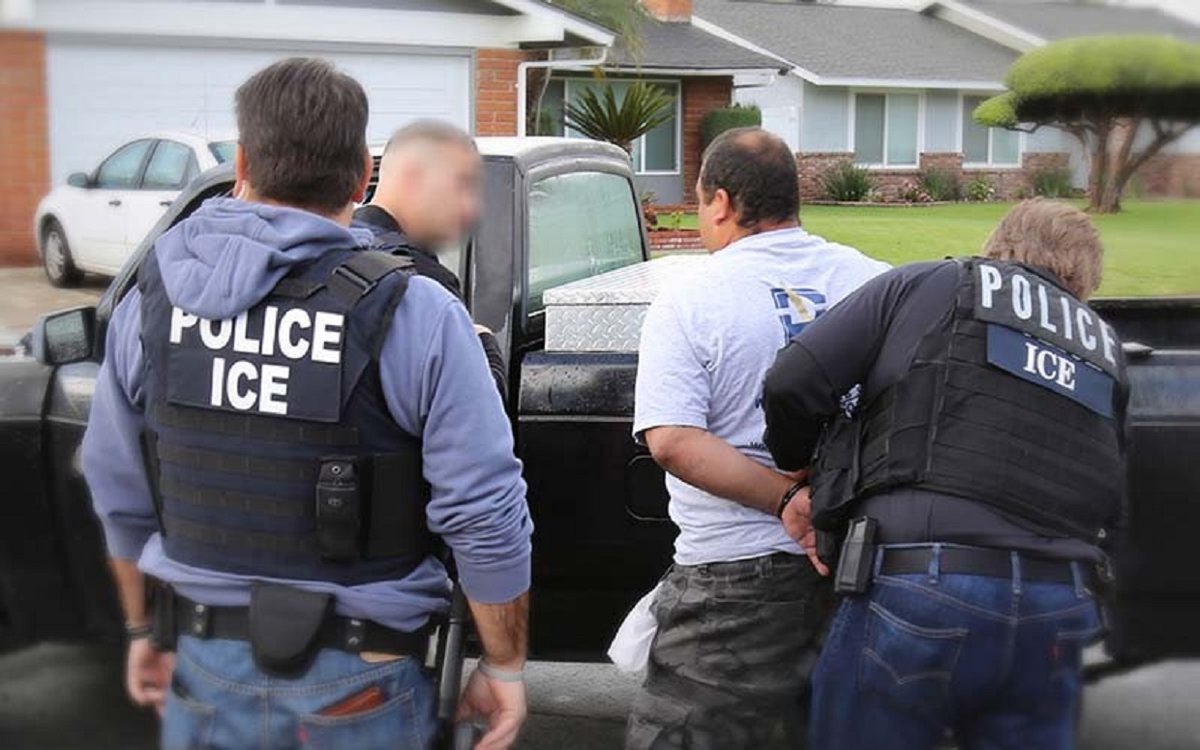

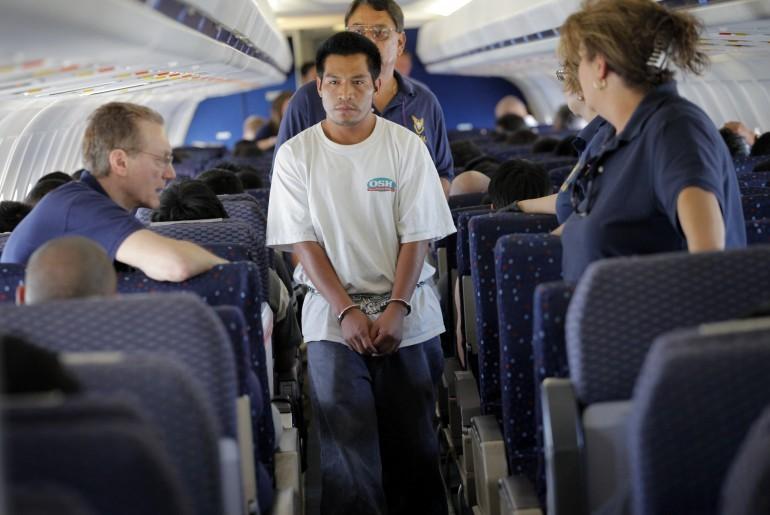
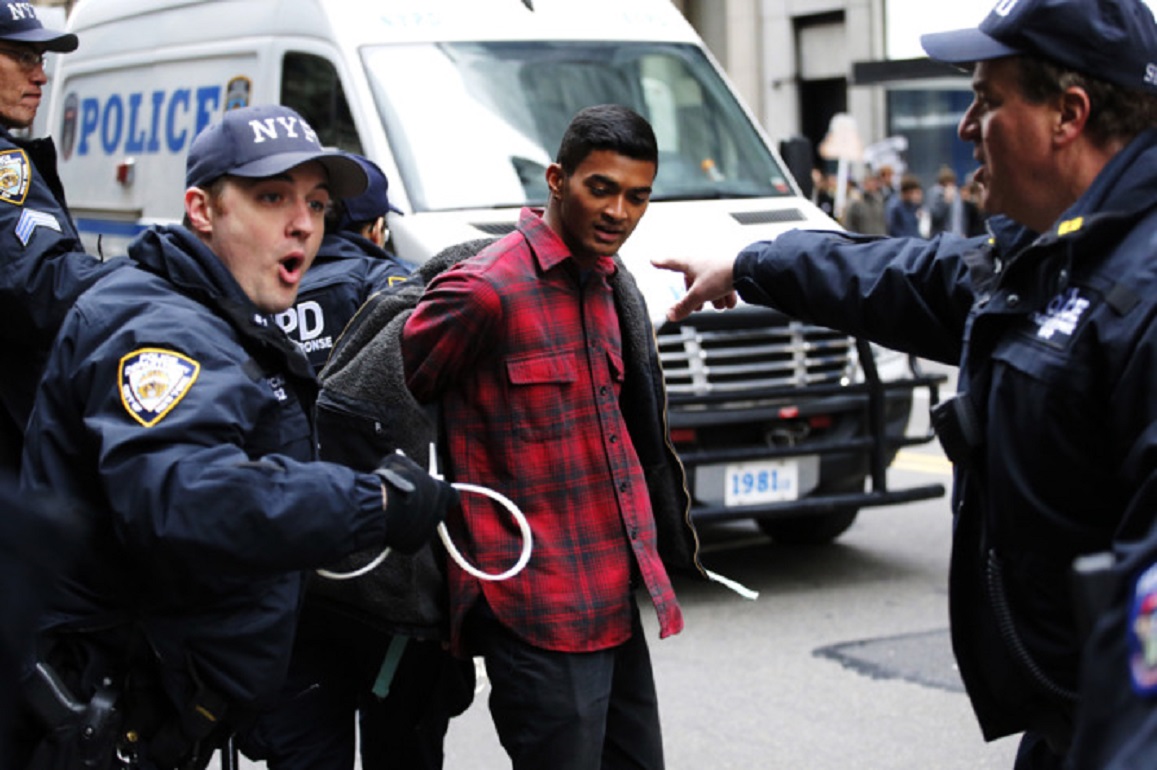 U.S. Immigration and Customs Enforcement (ICE) officers arrested many people. ICE Enforcement and Removal Operations (ERO) officers made the arrests,those arrested represented many countries throughout the world, including: Bahamas, Chile, Colombia, Costa Rica, Cuba, Dominican Republic, Ecuador, El Salvador, Guatemala, Haiti, Honduras, India, Israel, Italy, Jamaica, Mexico, Nicaragua, Panama, Peru, South Africa, St. Kitts, Ukraine, Vietnam.
U.S. Immigration and Customs Enforcement (ICE) officers arrested many people. ICE Enforcement and Removal Operations (ERO) officers made the arrests,those arrested represented many countries throughout the world, including: Bahamas, Chile, Colombia, Costa Rica, Cuba, Dominican Republic, Ecuador, El Salvador, Guatemala, Haiti, Honduras, India, Israel, Italy, Jamaica, Mexico, Nicaragua, Panama, Peru, South Africa, St. Kitts, Ukraine, Vietnam.
CHINA'S ENVIRONMENTAL AIR - POLLUTION ,THE TEXTILE INDUSTRY IS THE FOUGHT - LARGEST CONTRIBUTOR OF CHEMICAL OXYGEN DEMAND( COD).WHICH HAS CAUSED WIDESPREAD ENVIRONMENTAL .TOXIC CHEMICAL POLLUTION IS DEADLY FOR PEOPLE IN CHINA.
China faces three major environmental health hazards: air pollution, water pollution, and soil contamination. As early as 2007, a study found that the health costs of air and water pollution in China amounted to about 4.3 percent of China’s GDP. In 2012, PM2.5 particulate pollutants, considered to be the most hazardous to human health, were linked to 670,000 premature deaths from strokes, lung cancer, coronary heart disease, and chronic obstructive pulmonary disease. A 2013 study also found that air pollution is associated with a reduction in life expectancy at birth of about 5.5 years in northern China. Meanwhile, the widespread production and use of toxic chemicals in agriculture and manufacturing industries have contaminated water and farmland, contributing to the emergence of more than four hundred “cancer villages,” areas where cancer rates are unusually high.China's rapid economic development has come at the cost of severe environmental degradation, most notably from coal combustion. Outdoor air pollution is associated with >300000 deaths, 20 million cases of respiratory illness, and a health cost of >500 billion renminbi (>3% of gross domestic product) annually. The young are particularly susceptible to air pollution, yet there has been only limited recognition of its effects on children's health and development.China relies on coal for ∼70% to 75% of its energy needs, consuming 1.9 billion tons of coal each year. In addition to CO2, the major greenhouse gas, coal burning in China emits vast quantities of particulate matter, polycyclic aromatic hydrocarbons, sulfur dioxide, arsenic, and mercury. Automobiles emit nitrogen dioxide and benzene in addition to particulate matter and polycyclic aromatic hydrocarbons. Seventy percent of Chinese households burn coal or biomass for cooking and heating, which contaminates indoor air. Adverse effects of combustion-related air pollution include reduced fetal and child growth, pulmonary disease including asthma, developmental impairment, and increased risk of cancer. A prospective molecular epidemiologic study of newborns in Chongqing has demonstrated direct benefits to children's health and development from the elimination of a coal-burning plant.The human and fiscal cost of air pollution is irrefutable. Since 2013, the World Health Organization (WHO) has tracked air quality to measure its effect on heart disease, strokes, lung cancer, and other respiratory illnesses. China and India each had 1.1 million air pollution-related deaths in 2015, accounting for half of the world’s total air pollution deaths that year.Recognition of the full health and economic cost of air pollution to Chinese children and the benefits of pollution reduction should spur increased use of renewable energy, energy efficiency, and clean-fuel vehicles. This is a necessary investment for China's future.The communist party’s central leadership issued an “opinion” that proposed to evaluate officials on both their economic and environmental record. Yet this new policy rhetoric appears to contradict China’s performance-based legitimacy, which relies on delivering sustained economic growth. Since 1989, China has been governed by an implicit social contract: the regime commits to improving the material well-being of the people in exchange for the latter’s support of the party’s monopoly over political power. Herein lies in the dilemma for Chinese leaders: The party must keep economic growth above 7 percent to ensure employment and keep the people happy. Yet, these new measures to combat pollution are likely to undermine efforts to sustain GDP growth (at least in the short run). The recent economic slowdown exacerbates this dilemma. In January 2015, China’s growth rate edged down to 7.4 percent, its weakest expansion in over two decades. The International Monetary Fund recently revised down China’s 2015 GDP growth forecast to 6.8 percent. Just last month, the Chinese finance minister warned that unless China maintains a growth rate above 6.5 percent, the country has a greater-than 50 percent chance of slipping into the so-called middle-income trap, which occurs when a a country with middle-income status gets stuck at that level, instead of being elevated to the income levels of the truly developed countries.

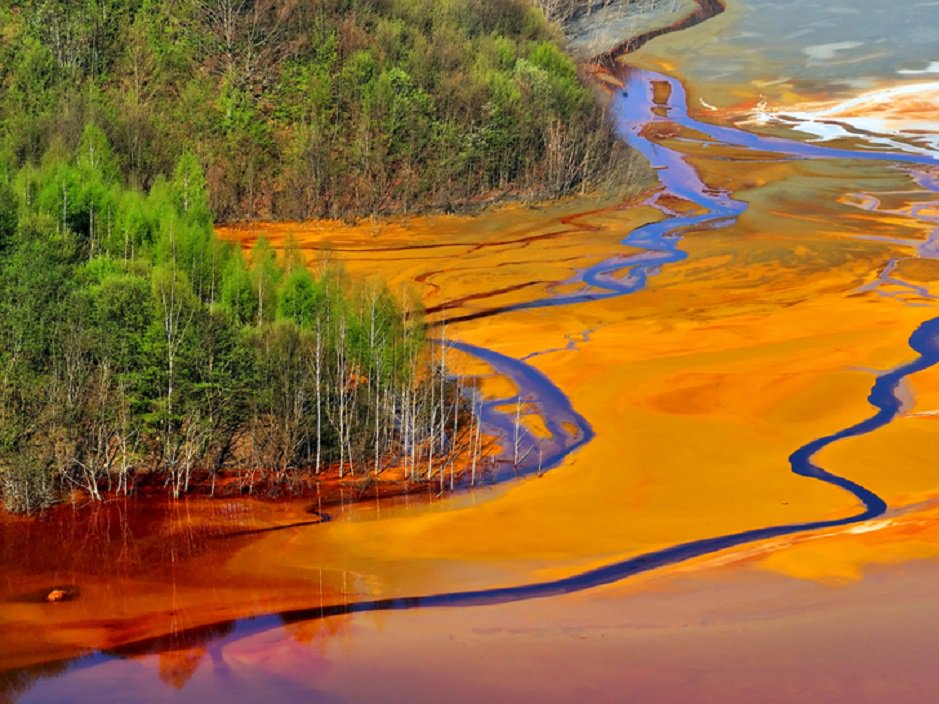
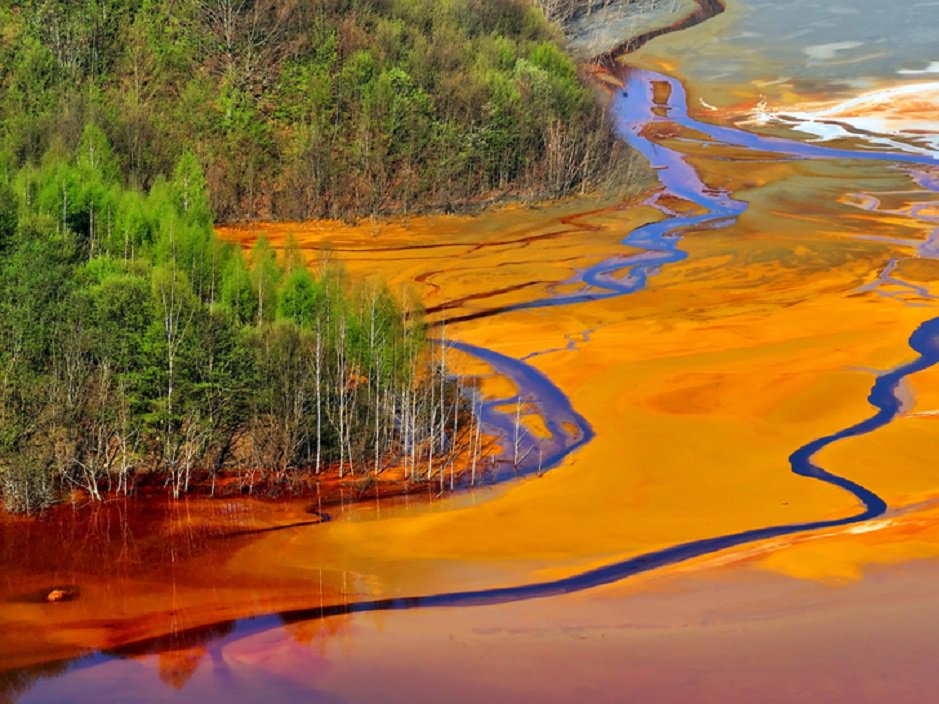 After more than three decades of rapid industrialization and modernization, China is on the cusp of becoming the world’s largest economy. Yet China’s economic miracle has imposed tremendous social costs. One third of China’s major rivers and 60 percent of its underground water supplies are polluted due to poor environmental regulation and unbridled Industralization. Such environmental problems pose a serious and sustained threat to the health and well-being of the Chinese people.
After more than three decades of rapid industrialization and modernization, China is on the cusp of becoming the world’s largest economy. Yet China’s economic miracle has imposed tremendous social costs. One third of China’s major rivers and 60 percent of its underground water supplies are polluted due to poor environmental regulation and unbridled Industralization. Such environmental problems pose a serious and sustained threat to the health and well-being of the Chinese people.
Chinese Government efforts to address the environmental health crisis are further complicated by an increasingly polarized Chinese society. Establishing the relationship between the environment and health is notoriously complex. Given the range of hazards individuals may be exposed to on a daily basis, it is extremely difficult to establish a causal relationship. Despite the indiscriminate nature of an environmental health problem, health effects are not felt equally in every community or even by each person within a community.As with all public policy issues, proactive government responses to the health crisis run the risk of creating both winners and losers. Departments and nongovernmental actors promoting environmental protection would see their power and prestige increase, while polluting industries (including those who work for them) stand to lose. When Under the Dome, a TED Talk-style documentary investigating China’s air pollution went viral in China in March 2015, the newly appointed minister of environmental protection personally thanked the producer, Chai Jing, for her work. Still, petrochemical industry insiders disputed Chai’s claims that lax quality standards for petroleum were a primary contributor to China’s worsening air pollution.The tension between environmental protection organizations both official and nongovernmental and powerful vested interests reflects an increasingly polarized Chinese society. Despite the popularity of Chai’s video, a large number of Chinese Netizens debated the validity of its arguments about the relationship between business practices and pollution and the role of the state vis-à-vis the market. Many officials and intellectuals questioned Chai’s motives and integrity. Although initially there seemed to be government approval for the documentary, Under the Dome’s pointed criticism of the resistance of powerful interests to tougher fuel standards and the failure of government agencies to implement strong regulatory standards soon led top leaders to have second thoughts. Within a week of its release, the video was blocked by government censors.Thousands die each day from breathing the toxic air in China, according to the World Health Organization. The air quality in Beijing was so bad in 2015 that simply breathing on a high-pollution day could do as much damage as smoking 40 cigarettes. On an average day, breathing is equivalent to smoking four cigarettes, according to a Berkeley Earth study.But one man is on a mission to help clean up China.China’s Water Crisis” was the first major book on the country’s environmental crisis. He is the director of the nonprofit Institute of Public and Environmental Affairs, which tracks air and water pollution on a website and mobile app, and pushes the government and manufacturers on environmental issues.That exploding growth in manufacturing and industry has contributed to the environmental crisis in China. Despite newer environmental rules, nearly 70 percent, or 13,875 companies, were found to be violating China’s own standards. The Chinese government’s most recent environmental report reveals that 75 percent of Chinese cities can’t meet the nation’s new air quality standards. Despite an effort to clean China’s polluted skies, it actually became 5 percent worse in October. In addition to air pollution, groundwater supplies in more than 60 percent of major Chinese cities were categorized as “bad to very bad”, according to China Water Risk. Air pollution is measured by the Air Quality Index (AQI), which scales pollution levels from 0 to 500 and assigns a color to different number levels to measure how hazardous the air quality is on any given day . Levels of 100 or below are known as “Blue Sky Days”, when smog is not easily visible.However, levels now reach up to 755, as measured by the United States Embassy in Beijing, which employs its own pollution reading device. This is the highest level of air pollution since recording began in 2008, and was appropriately deemed “Beyond Index”. The World Health Organization suggests that scores near 500 contain more than twenty times the safe level of particulate matter in the air.
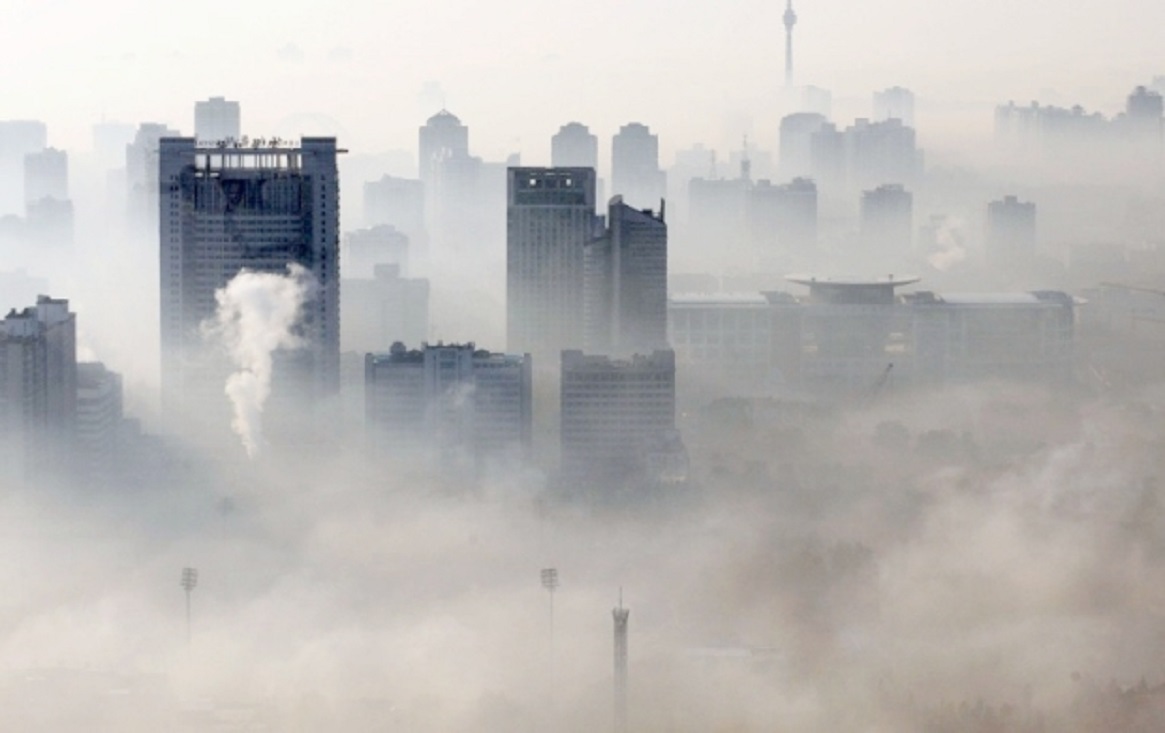 China has been the world’s biggest emitter of carbon dioxide for more than a decade. It is responsible for nearly 30 percent of the Earth’s carbon emissions, according to the Emissions Database for Global Atmospheric Research.
China has been the world’s biggest emitter of carbon dioxide for more than a decade. It is responsible for nearly 30 percent of the Earth’s carbon emissions, according to the Emissions Database for Global Atmospheric Research.
The shorter lifespans of Beijing’s citizens has been connected to high pollution levels.7,8 Compared to citizens living in southern China, the average life span for Beijing’s citizens is five to six years shorter. The air pollution in Beijing causes lower birth rates and higher adult mortality from respiratory related diseases. Lung cancer rates have risen over 60% in the past decade, although the smoking rate has not increased.The Chinese Academy for Environmental Planning determined that air pollution was responsible for 411,000 premature deaths across China. The 2008 Olympic Summer Games in Beijing was the catalyst leading to many new policies to address air pollution. Emergency measures were enacted depending on the pollution levels, but the most important factor in curbing air pollution is the implementation of new laws and reformation of old laws. The Olympics were crucial in raising awareness about reform of environmental regulations. Many factories, industries, and manufacturing plants were shut down for the duration of the games and driving restrictions were imposed on millions of vehicles.1,9 Although this was a temporary solution for the Olympics, city officials promised to spend over $12 billion dollars on improving the environment. City officials converted coal furnaces in tens of thousands of homes to natural gas and relocated factories to other provinces in China.Emergency measures have also been enacted in Beijing. Mandatory factory closures and bans on motor vehicles entering the city are implemented on days of heavy air pollution. In 2013, the Heavy Air Pollution Contingency Plan was passed.10 This plan consists of four warning levels based on air pollution levels. Depending on the warning level, different actions are executed, which include school closures, removing 80% of government vehicles from the road, allowing certain private cars on the roads based on registration plate numbers and day of the week, barring freight and construction vehicles from the roads, utilizing watering carts and sprinkler trucks, shutting factories down, halting construction sites, and even forbidding barbecues and fireworks.10 To most effectively address air pollution would require reform in government laws and behavior.The State Environmental Protection Administration (SEPA) was established in 1998. The organization has the difficult task of reforming environmental laws that are often ignored by leaders. Another problem of environmental laws is the fines are so minuscule that offending corporations would rather pay the penalty, rather than change their business practices.Openness in reporting true pollution levels by municipal governments would also lend clarity to the condition of air quality. The government only reports AQI numbers up to 500. The Chinese government also prefers to release information only on PM10 particles and not larger PM particles. These larger PM particles may be more dangerous than PM10 particles. The United States Embassy did release such information, but was asked by the Chinese government to limit the release of information to Americans.Beijing’s air pollution affects the health of its citizens and threatens to limit the future success and expansion of the city. Though the contamination is extensive, there are possible solutions which can address the problem. By analyzing the sources of pollution, studying its consequences, and by reforming inadequate regulations and laws, Beijing can salvage its environment and create a healthier atmosphere for future generations.With this amplified wealth, individuals are more capable of affording motor vehicles.The number of motor vehicles on Beijing’s roads has doubled to 3.3 million with nearly 1200 added each day. Emissions from motorized vehicles contribute to nearly 70% of the city’s air pollution. The four most dangerous pollutants that are emitted include: sulfur dioxide (SO2), nitrogen dioxide (NO2), carbon monoxide (CO), and particulate matter (e.g. PM10).Newly introduced vehicles have lower emission standards, and thereby emit more of these pollutants into the atmosphere than their older counterparts. Motorized vehicles are only one contributor to air pollution. Population growth in China and Beijing contributes to extensive pollution. Beijing’s population has swelled from 11 million to 16 million in just 7 years, and has doubled over the past century.Coal burning factories also contribute to the smog present in Beijing. These factories rely on outdated and inefficient technologies. The factories are located on the outskirts of Beijing and the nearby cities of Harbin and Hebei. Beijing is a victim of its own topography because it is surrounded by mountains, ensuring that pollution remains trapped within the city limits.Air quality worsens in spring and summer when temperature and humidity levels rise, and winds contribute to the smog by carrying pollutants from industrialized southern regions.There are a variety of consequences of air pollution in Beijing. Along with health consequences, high levels of harmful emissions have led to hundreds of flight cancellations and frequent road closures due to low visibility levels.Air pollution has increased substantially over the years, resulting in thick smog that often engulfs the entire city.
 The 190 most important Chinese cities sample were recorded with an Air Quality Index (AQI) value around 130. Most affected areas were the industrial North region including Harbin, Beijing and Tianjin.Particulate Matters (PM2.5 and PM10) were almost always the principal pollutants determining the value of Air Quality Index, PM2.5 with 68% of the city-month records being mostly concerned with PM10 only 29%. As a consequence, the PM2.5 inclusion in the new AQI definition has dramatically changed the Air quality perception
The 190 most important Chinese cities sample were recorded with an Air Quality Index (AQI) value around 130. Most affected areas were the industrial North region including Harbin, Beijing and Tianjin.Particulate Matters (PM2.5 and PM10) were almost always the principal pollutants determining the value of Air Quality Index, PM2.5 with 68% of the city-month records being mostly concerned with PM10 only 29%. As a consequence, the PM2.5 inclusion in the new AQI definition has dramatically changed the Air quality perception
Farmers' fields are a bigger source of water contamination in China than factory effluent, the Chinese government revealed today in its first census on pollution.Senior officials said the disclosure, after a two-year study involving 570,000 people, would require a partial realignment of environmental policy from smoke stacks to chicken coops, cow sheds and fruit orchards.Despite the sharp upward revision of figures on rural contamination, the government suggested the country's pollution problem may be close to - or even past - a peak. That claim is likely to prompt scepticism among environmental groups.The Environment Tax Law was approved at the end of the National People's Congress (NPC) Standing Committee meeting which concluded .The law, to enter into force on Jan 1, 2018, will be key to fighting pollution, according to Wang Jianfan, director of the Ministry of Finance tax policy department.China has collected a "pollutant discharge fee," since 1979. In 2015, it collected 17.3 billion yuan ($2.5 billion) from some 280,000 businesses, Wang said.However, some local governments exploit loopholes and exempt enterprises which are otherwise big contributors to fiscal revenue. For years, regulators have suggested replacing the fee system with a law."The new law will reduce interference from government," Wang told a press conference. It will also improve tax payers' environmental awareness, forcing companies to upgrade technology and shift to cleaner production, Wang said.Under the new law, companies will pay taxes ranging from 350 yuan to 11,200 yuan per month for noise, according to their decibel level. It also set rates of 1.2 yuan on stipulated quantities of air pollutants, 1.4 yuan on water pollutants and a range of five to 1,000 yuan for each ton of solid waste.For instance, polluters will pay 1.2 yuan for emission of 0.95 kilograms of sulfur dioxide and 1.4 yuan for one kilogram of chemical oxygen demand (COD). Carbon dioxide (CO2) is not included in the levying list.Provincial-level governments can raise the rates for air and water pollution by up to ten times after approval by the people's congresses. Lower rates may also be applicable if emission is less than national standards.The law only targets enterprises and public institutions that discharge listed pollutants directly into the environment.Punishment for evasion or fraud are not specified, but offenders will be held liable in line with the law on administration of taxation and the environmental law.With more than a year still to go before the law comes into effect, Wang said authorities will make preparations including drafting a regulation for implementation of the law.He added that revenue will all go to local governments, and will not reduce their capability to spend on environment protection.The release of the groundbreaking report was reportedly delayed by resistance from the agriculture ministry, which had previously insisted that farms contributed only a tiny fraction of pollution in China.
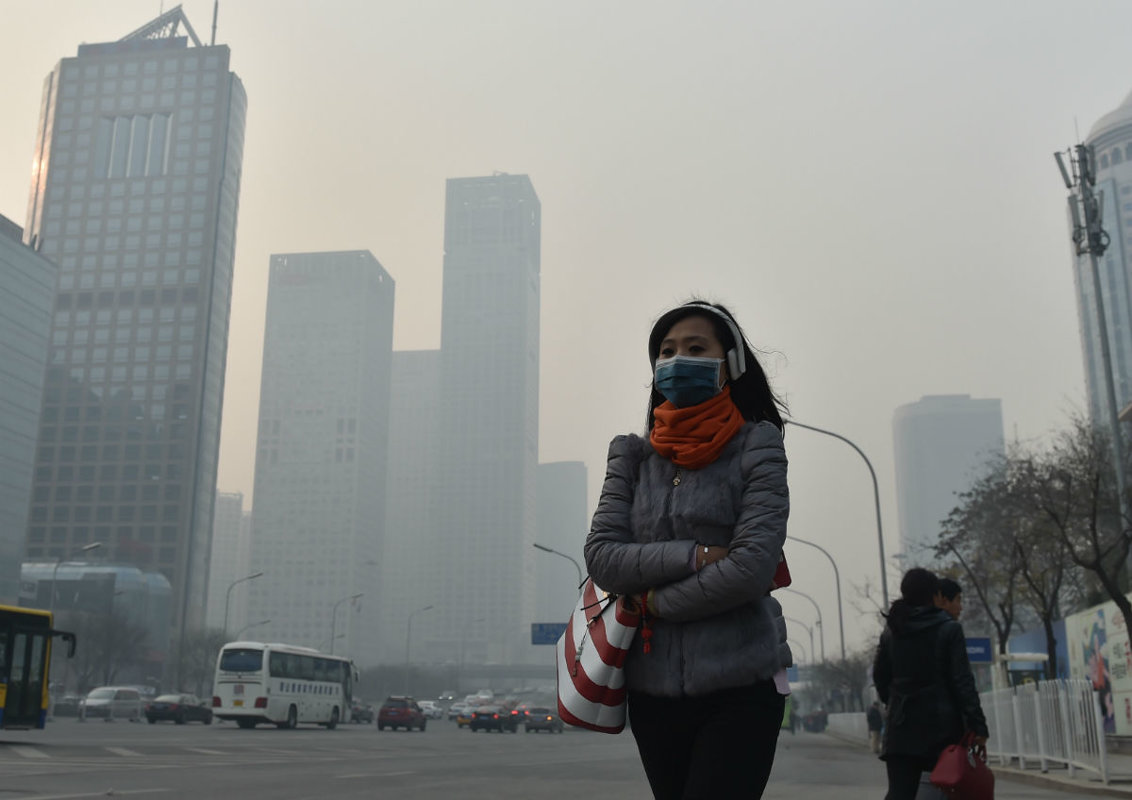
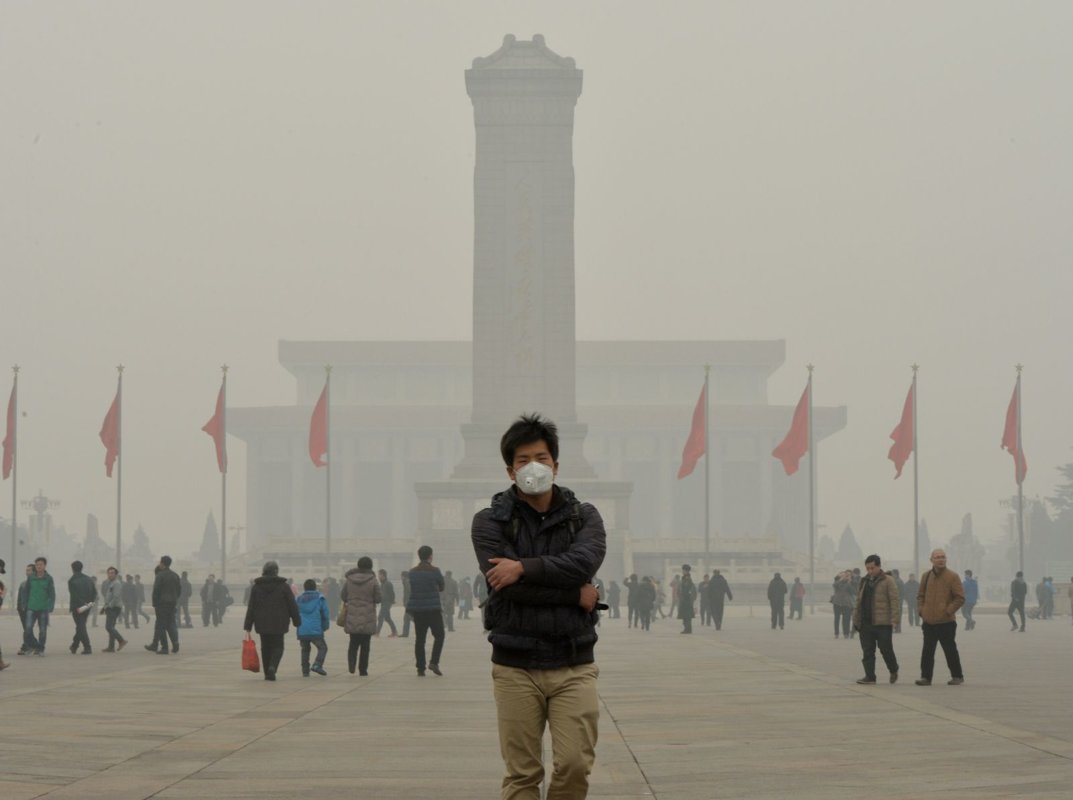
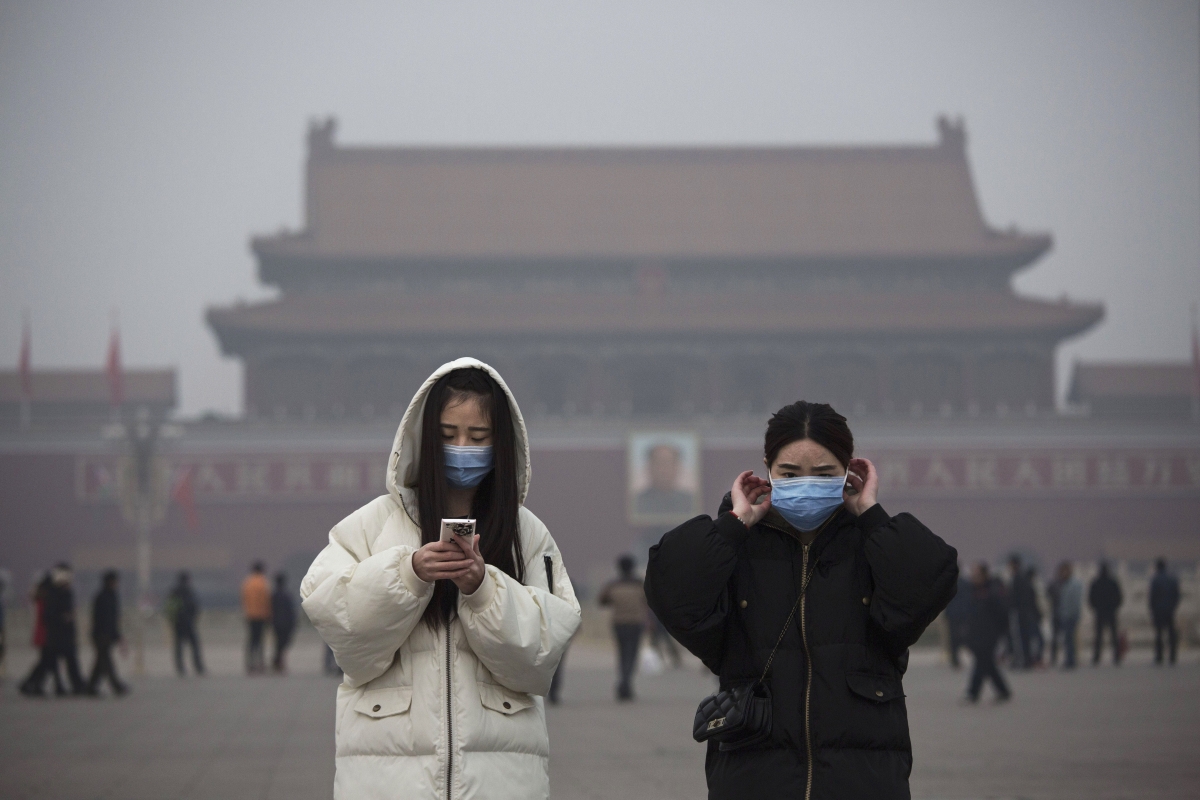 Toward the end of last year through the beginning of this year, a dense haze containing toxic substances covered up to 25 percent of the Chinese mainland, affecting close to half the country’s population, or 600 million people. The number of people who developed air pollution-related diseases was 20-30 percent greater compared to previous years.China exceeds global limits for air pollution, but the government has been hesitant to monitor the health impacts.For the first time, China’s environmental watchdog will monitor, investigate and evaluate public health risks posed by environmental pollution.
Toward the end of last year through the beginning of this year, a dense haze containing toxic substances covered up to 25 percent of the Chinese mainland, affecting close to half the country’s population, or 600 million people. The number of people who developed air pollution-related diseases was 20-30 percent greater compared to previous years.China exceeds global limits for air pollution, but the government has been hesitant to monitor the health impacts.For the first time, China’s environmental watchdog will monitor, investigate and evaluate public health risks posed by environmental pollution.
ALBERT EINSTEIN WAS A GERMAN JEW,AMERICAN CITIZENSHIP, HE WAS EXPERT, PHYSICIST AND GENIUS.HE NEVER RETURNED TO HIS BIRTHLAND GERMANY.HITLER CONSIDERED HIM PUBLIC ENEMY NUMBER ONE.
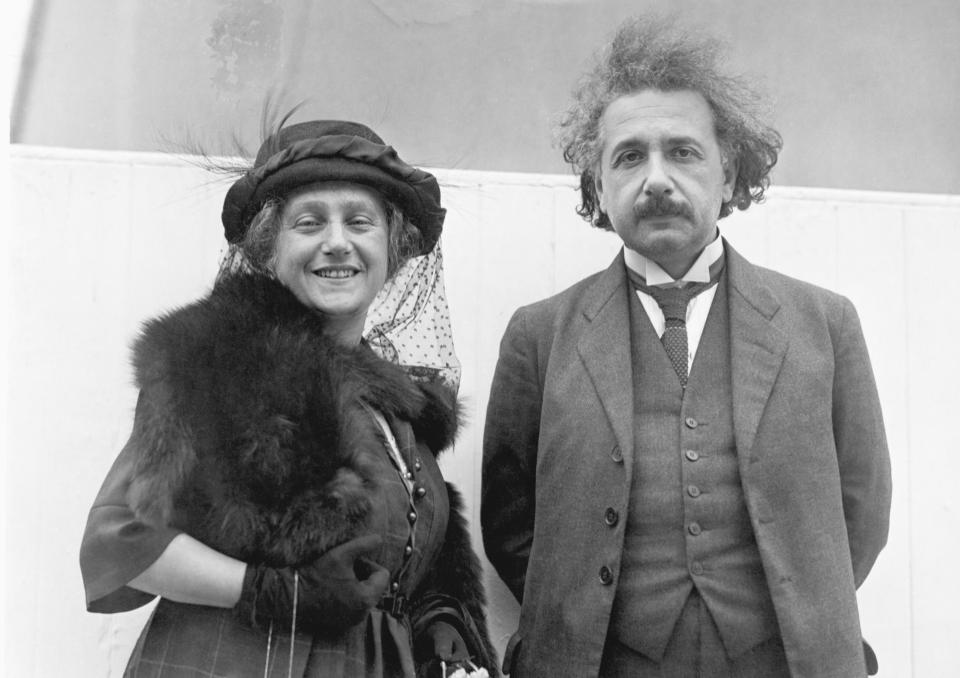 Albert
Einstein with his first wife Mileva Maric.So pragmatic was Einstein's
approach to love that when he found his 11 year marriage to Mileva Maric
floundering, he issued a list of outrageous rules he said would allow
them to stay together.
Albert
Einstein with his first wife Mileva Maric.So pragmatic was Einstein's
approach to love that when he found his 11 year marriage to Mileva Maric
floundering, he issued a list of outrageous rules he said would allow
them to stay together.Albert Einstein was born at Ulm, in Württemberg, Germany, on March 14, 1879. Six weeks later the family moved to Munich, where he later on began his schooling at the Luitpold Gymnasium. Later, they moved to Italy and Albert continued his education at Aarau, Switzerland and in 1896 he entered the Swiss Federal Polytechnic School in Zurich to be trained as a teacher in physics and mathematics. In 1901, the year he gained his diploma, he acquired Swiss citizenship and, as he was unable to find a teaching post, he accepted a position as technical assistant in the Swiss Patent Office. In 1905 he obtained his doctor's degree. During his stay at the Patent Office, and in his spare time, he produced much of his remarkable work and in 1908 he was appointed Privatdozent in Berne. In 1909 he became Professor Extraordinary at Zurich, in 1911 Professor of Theoretical Physics at Prague, returning to Zurich in the following year to fill a similar post. In 1914 he was appointed Director of the Kaiser. As the consequence of overworking, in 1928 Einstein developed a heart disease which took him almost a year to recover from. At the age of 17 Einstein also renounced his German citizenship to avoid military service. During his schooling with Jost Winteler, he became very close to the family and fell in love with Marie – Winteler’s daughter. He also enrolled in Zürich’s school after renouncing his German citizenship.At Zürich Einstein met some of his lifelong loyal friends. He also met Mileva Maric, a Serbian woman and his fellow student. Maric later became Einstein’s wife but their relationship was not really accepted by Einstein’s family because of the religious differences.Einstein and Maric had a daughter named Lieserl. Nothing is known about their daughter. Some say that the kid died of sickness while others say that the couple gave her up for adoption. Lieserl was born in 1902. When Lieserl was born, Einstein and Maric were not married.In 1902, Einstein’s financial conditions were awful. He did not have a job and his father’s company went bankrupt. That is when Einstein started tutoring children.Einstein eventually grabbed a Swiss clerical job after a recommendation from Marcel Grossman’s father. Marcel Grossman was Einstein’s lifelong friend.Einstein’s father died shortly after that because of illness but before death, approved of Einstein’s and Maric’s wedding. The couple got married in 1903. The next year they had a son named Hans Albert and in 1910 they had a second son named Eduard.The clerical job that Einstein actually took was in a Swiss patent office. His job was to evaluate patent applications for various electromagnetic devices. Einstein quickly mastered the job and had enough time to think about electrical-mechanical synchronization and electrical signal transmissions.During his study at the polytechnic school, Einstein went through the electromagnetic theories that were developed by James Maxwell – a Scottish Physicist.In 1929 after his 50th birthday he built a summer house in the municipality of Caputh where he lived with his family each year between spring and late autumn until the December of 1932.Even so, Albert Einstein is nowadays mostly associated with just one simple formula: E = mc2. Many call it the most famous formula in the world, and even people who have no idea what mass-energy equivalence is still know that one formula.However, as these 25 surprising Albert Einstein facts prove, there was a lot more to the man than a mathematical formula which he doesn’t even deserve total credit for. From his hatred of socks to the theft of his brain, these Albert Einstein facts reveal a lot you don’t know about history’s greatest thinker.He moved to the United States at a time when the Nazi regime put a $5,000 bounty of his head. He was even featured in a German magazine listing a roster of enemies of the state along with the phrase "Not yet hanged."In 1952, the state of Israel offered Einstein the position of president, but he declined saying in part.
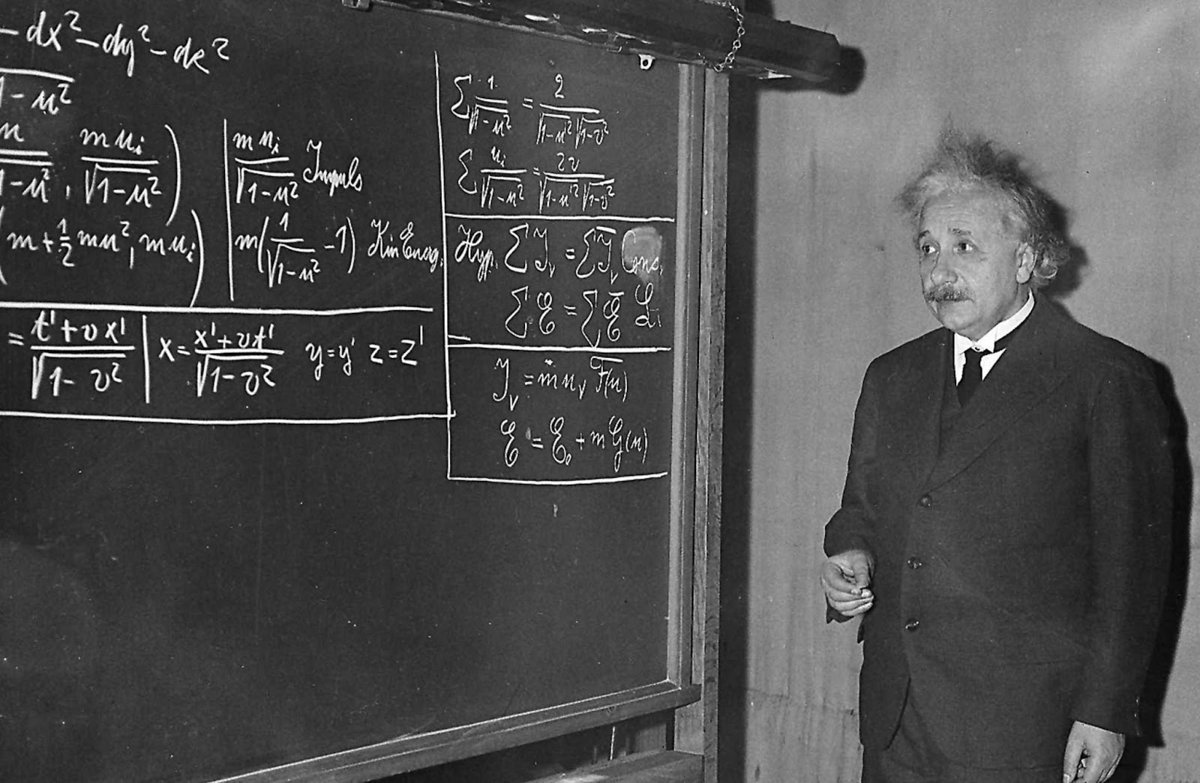 Einstein's
work is also known for its influence on the philosophy of science.
Einstein is best known in popular culture for his mass–energy
equivalence formula E = mc2 (which has been dubbed "the world's most
famous equation"). He received the 1921 Nobel Prize in Physics for his
"services to theoretical physics", in particular his discovery of the
law of the photoelectric effect, a pivotal step in the evolution of
quantum theory.
Einstein's
work is also known for its influence on the philosophy of science.
Einstein is best known in popular culture for his mass–energy
equivalence formula E = mc2 (which has been dubbed "the world's most
famous equation"). He received the 1921 Nobel Prize in Physics for his
"services to theoretical physics", in particular his discovery of the
law of the photoelectric effect, a pivotal step in the evolution of
quantum theory.
Einstein always appeared to have a clear view of the problems of physics and the determination to solve them. He had a strategy of his own and was able to visualize the main stages on the way to his goal. He regarded his major achievements as mere stepping-stones for the next advance.At the start of his scientific work, Einstein realized the inadequacies of Newtonian mechanics and his special theory of relativity stemmed from an attempt to reconcile the laws of mechanics with the laws of the electromagnetic field. He dealt with classical problems of statistical mechanics and problems in which they were merged with quantum theory: this led to an explanation of the Brownian movement of molecules. He investigated the thermal properties of light with a low radiation density and his observations laid the foundation of the photon theory of light.Apart from all his work Einstein still found time for playing music. Since his youth he played the violin and later he frequently was seen on the street carrying his violin case. He was an admirer of Bach and Mozart and, through continuous practice, he became a good violinist. Apart from his love for music he was a devoted sailor. Doing this just for fun, here did he find the time to think about problems of physics.His Theory of Relativity were much talked of. He received invitations and honours from all the world. There was rarely a magazine which did not report on his achievements with the highest praise. On the other hand, since 1920 Einstein and his Theory of Relativity became subject to vigorous attacks which mostly were founded on anti-Semitism. Even Nobel-prize laureates like Philipp Lenard and Johannes Stark publicly took up a hostile attitude towards Einstein and his theory and pleaded for a "German physics"From 1909 to 1916 Albert Einstein worked on a generalization of his Special Theory of Relativity. The results of his efforts were published in March 1916 in the paper "The Foundation of the General Theory of Relativity". This theory investigates coordination systems which experience acceleration relative to each other and also the influence of gravitational fields to time and space. Whereas the Special Theory of Relativity was still intelligible to the layman, this did not apply to the General Theory of Relativity. Moreover, due to the relatively small relativistic effects, this theory was difficult to verify experimentally. Einstein - or his General Theory of Relativity - predicted the perihelion motion of mercury, the gravitational red shift as well as the deflection of light in a gravitational field. He was convinced that light deflection by the gravitational field of the sun could be observed during a total solar eclipse. After several failed observations of total solar eclipses proof came in 1919: On May 29 of that year the English astronomer Arthur Stanley Eddington confirmed Einstein's prediction of light deflection when he observed a total solar eclipse on the volcanic island of Principe in the Gulf of Guinea in western Africa. A second expedition, led by Andrew Crommelin, observed this eclipse in Sobral, Brazil.Apart from all his work Einstein still found time for playing music. Since his youth he played the violin and later he frequently was seen on the street carrying his violin case. He was an admirer of Bach and Mozart and, through continuous practice, he became a good violinist. Apart from his love for music he was a devoted sailor. Doing this just for fun, here did he find the time to think about problems of physics.Einstein’s fame brought him lectureships throughout the world,it also made him the focus of attacks in an increasingly anti-Semitic and militaristic Germany. Fearing for his safety, he and his wife, Elsa, immigrated to the United States on October 17, 1933, where Einstein accepted a position at the Institute for Advanced Study in New Jersey. Although some Americans opposed Einstein’s immigration for his "radical” views, Einstein embraced the opportunities and freedom of his new nation. He cowrote a famous letter to President Franklin D. Roosevelt in 1939 advising him of the possibilities of developing an atomic bomb. On June 22, 1940, Einstein took his American citizenship test and gave a talk for the government’s I Am an American radio series; he was naturalized on October 1, 1940. After World War II, Einstein advocated nuclear disarmament and international cooperation. Once in the United States, Einstein and his wife helped other Jewish refugees to emigrate to the America. Einstein expressed mixed feelings about living in the United States. He felt privileged to live in a place as peaceful as Princeton, New Jersey, but at the same time felt guilty for being able to live peacefully while so many others had lives destroyed by the war. Nevertheless, Einstein remained in Princeton until his death in 1955.
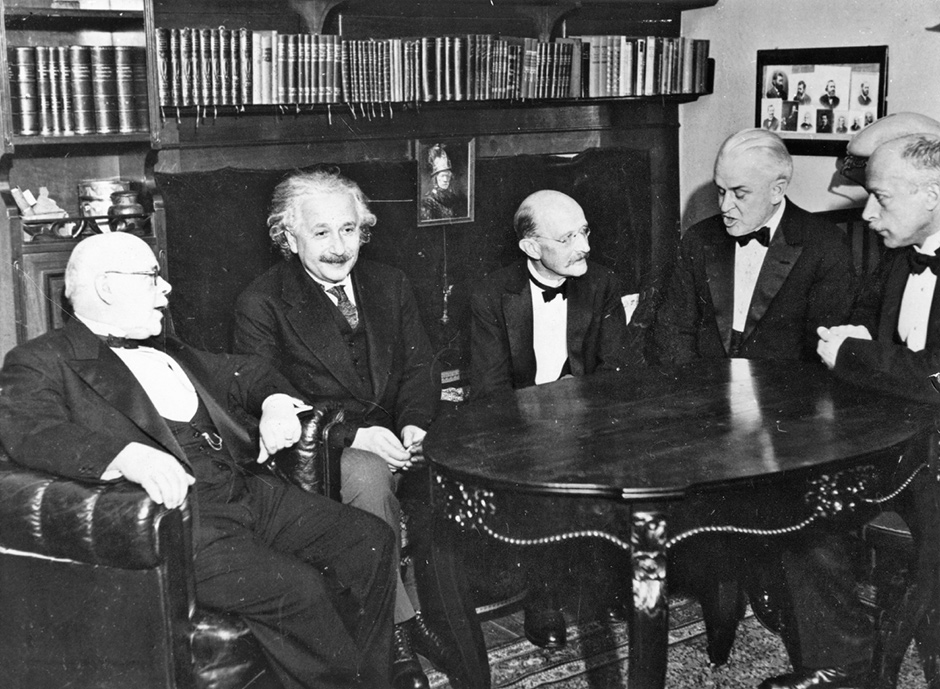 Max Planck, center, with Walther Nernst, Albert Einstein, Robert Andrews
Millikan, and Max Laue, all physicists and winners of the Nobel Prize,
Berlin, 1928.
Max Planck, center, with Walther Nernst, Albert Einstein, Robert Andrews
Millikan, and Max Laue, all physicists and winners of the Nobel Prize,
Berlin, 1928.
In the summer of 1946, as soon as possible after the end of World War II, the Royal Society of London organized a celebration for the three hundredth birthday of Isaac Newton. Newton was born on Christmas Day 1642, laid the foundations of modern physics with his masterpiece, Mathematical Principles of Natural Philosophy, in 1686, and served as president of the Royal Society from 1703 until his death in 1727. The birthday party had been postponed because of the war. Surviving in the ruins of defeated Germany were many distinguished scientists, all of them loyal to their country and many of them tainted by active collaboration with the Nazi regime. The Royal Society invited only one man to represent Germany at the celebration. The chosen representative, serving as a symbol of the glorious past and the tragic downfall of German science, was Max Planck.Planck was then eighty-eight years old, devoting the last years of his life to the rebuilding of German science. When he entered the auditorium at the Newton celebration, the leaders of British science gave him long and emotional applause. He had laid the foundations of quantum theory with his masterpiece, the paper “On the Theory of the Energy Distribution Law of the Normal Spectrum,” in 1900, and had served as president of the Prussian Academy of Sciences, the German equivalent of the Royal Society.In that paper he had explained the observed intensity of light of various colors emitted from the surfaces of hot objects at various temperatures. His explanation involved a new and revolutionary idea: that energy could move around only in little packets rather than continuously. The little packets were later called quanta, and Planck’s idea was called quantum theory. Planck’s quantum theory and Einstein’s theory of relativity became the twin foundation stones on which the science of the twentieth century was built.Besides inventing quantum theory, Planck had made another great contribution to science by welcoming and generously supporting the young Albert Einstein. In 1905, when Einstein, then an unknown employee of the Swiss patent office in Bern, sent five revolutionary papers to the physics journal that Planck edited in Berlin, Planck immediately recognized them as works of genius and published them quickly without sending them to referees. He did not agree with all of Einstein’s ideas, but he published all of them. He helped Einstein to move ahead in the academic world, and in 1913 invited him to a full professorship in Berlin. For twenty years Planck and Einstein were friends and colleagues in Berlin, leaders of a scientific community that remained creative and vibrant, in spite of the political and economic disarray that surrounded them. Planck was the rock-solid central figure of German .In February 1920 Einstein's mother died in Berlin. Between 1921 and 1923 he travelled, among others, to the US, Britain, France, Japan and Palestine. Since that time he began commenting on political issues more and more frequently, based on a pacifist point of view. In 1922 Einstein became member of the League of Nations' International Committee on Intellectual Cooperation which he left one year later even though he supported the aims of the League of Nations. With a revived belief in the ideals of this organisation Einstein re-joined the commission in May 1924. Opposed to any kind of violence Einstein supported pacifist movements whenever he had the chance. In addition, he supported the cause of the Zionists. He spoke up for the Hebrew University to be founded in Jerusalem to which he later also bequeathed his entire written legacy. In November 1952 Einstein even received the offer to become President of Israel which, however, he turned down.After his death, Einstein's brain was removed during the autopsy, against his wishes. It later took a bizarre cross-country tour in the trunk of a car and remains an object of morbid fascination.Einstein died in his sleep at Princeton Hospital on April 18, 1955. He suffered a ruptured aneurysm and refused surgical treatment. He explained, “I want to go when I want. It is tasteless to prolong life artificially. I have done my share, it is time to go. I will do it elegantly.” Before dying, Einstein said a few words to the nurse, but he spoke in German and the nurse did not understand.
FORMER SOUTH KOREAN PRESIDENT PARK GEUN - HYE JAILED FOR 24 YEARS OVER CORRUPTION SCANDAL ALLEGED BRIBERY.SHE WAS IMPEACHED IN MARCH 2017 FOLLOWING MASS PROTESTS.
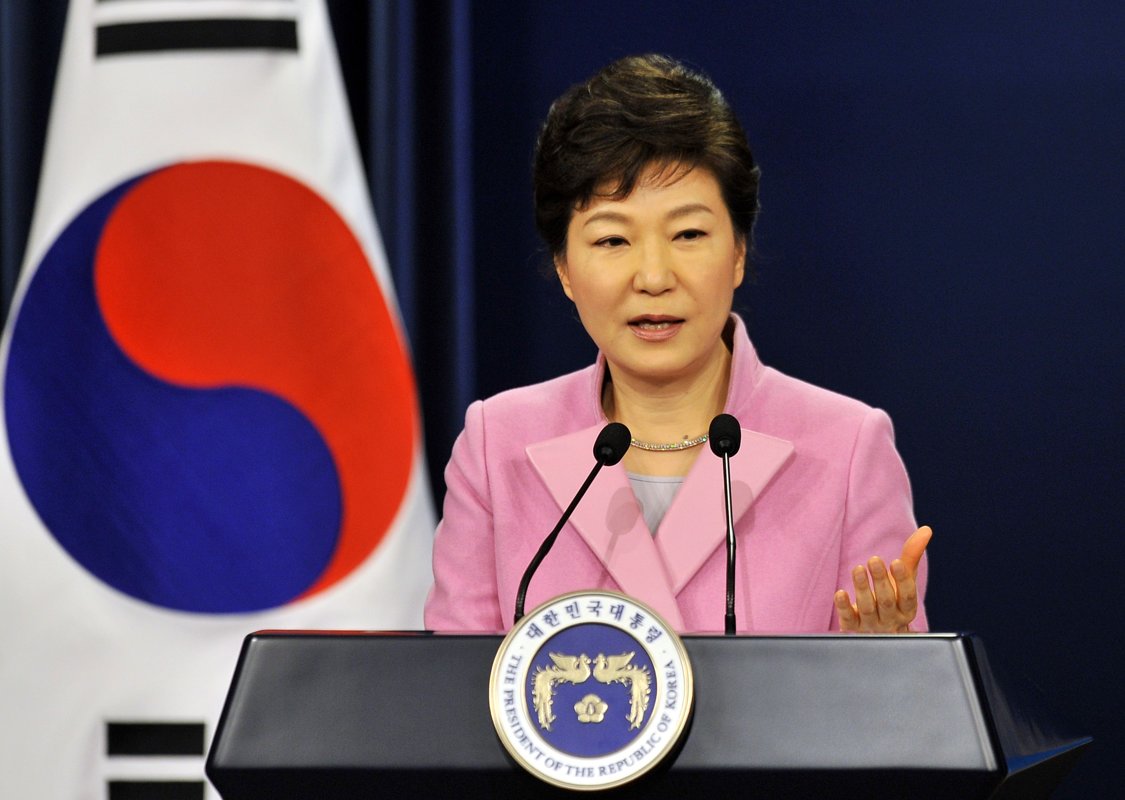 Park Geun-Hye: 1952; was the current President of South Korea. She was the first woman to be elected to that position and South Korea’s first woman head of state in modern history. Prior to her presidency, she was the chairwoman of the conservative Grand National Party and a member of the Korean National Assembly. She was considered to be one of the most influential politicians in Korea since the presidencies of Kim Young-sam and Kim Dae-jung.
Park Geun-Hye: 1952; was the current President of South Korea. She was the first woman to be elected to that position and South Korea’s first woman head of state in modern history. Prior to her presidency, she was the chairwoman of the conservative Grand National Party and a member of the Korean National Assembly. She was considered to be one of the most influential politicians in Korea since the presidencies of Kim Young-sam and Kim Dae-jung.
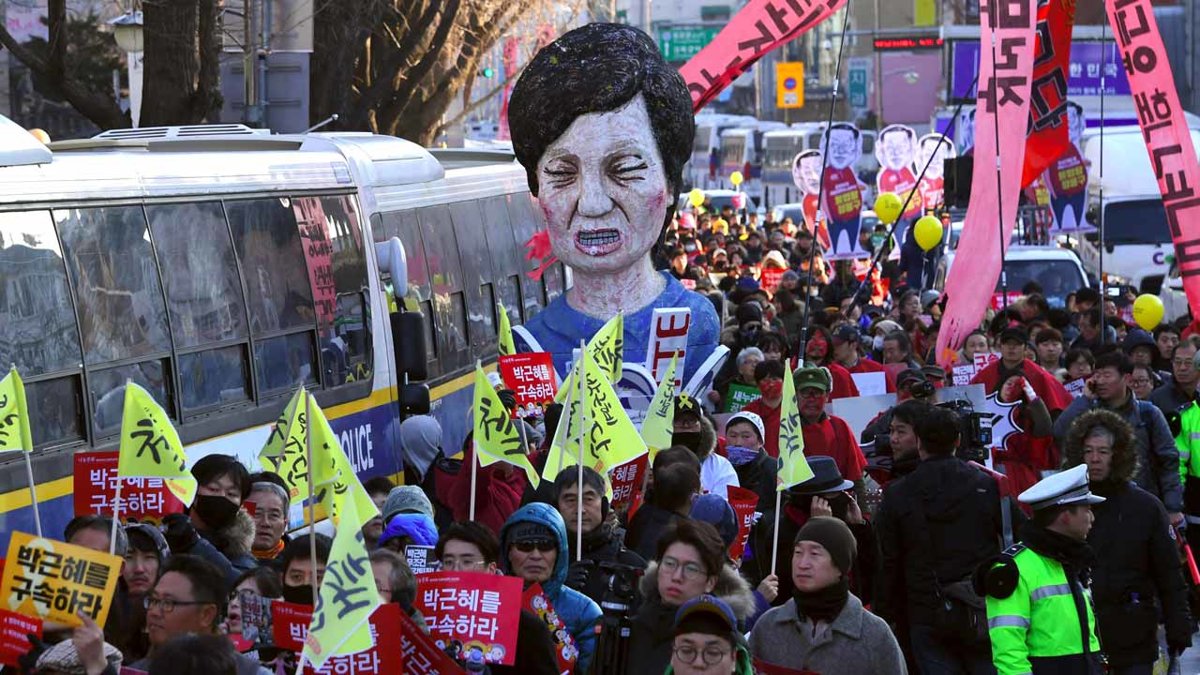
Park Geun-hye was impeached by parliament in December 2016 after mass demonstrations - fuelled by economic and social frustrations - demanding her removal over a scandal centred on Choi, her friend of 40 years, and implicating some of the country’s top businessmen.
South Korea’s disgraced former president Park Geun-hye was jailed for 24 years Friday for corruption, closing out a dramatic fall from grace for the country’s first woman leader who became a figure of public fury and ridicule.She was found guilty on charges of bribery, coercion and abuse of power, and ordered to pay a fine of 18 billion won ($17 million).“The amount of bribery the accused received or demanded in collaboration with Choi amounts to more than 23 billion won,” Judge Kim Se-Yoon said, referring to Park’s secret confidante and long-time friend Choi Soon-sil.Park Geun-Hye: 1952; was President of South Korea. She was the first woman to be elected to that position and South Korea’s first woman head of state in modern history. Prior to her presidency, she was the chairwoman of the conservative Grand National Party and a member of the Korean National Assembly. She was considered to be one of the most influential politicians in Korea since the presidencies of Kim Young-sam and Kim Dae-jung.The ousted president faces charges including bribery, abusing state power and leaking state secrets.Police escorted Park, in handcuffs with her eyes downcast, into court for her first public appearance since she was jailed on March 31 based on the same corruption allegations that led to her removal from office.In her first appearance in public since her arrest in March 2017, she arrived at court handcuffed in a prison van.The maximum sentence for corruption in South Korea is life.Ms Park is accused of colluding with her friend, Choi Soon-sil, to extort money from some of South Korea’s biggest companies, including Samsung, in return for political favours.Ms Choi Soon-sil, who is also facing charges, sat alongside Ms Park at the opening of the trial. She also denies wrongdoing.As the trial opened in Seoul, the ex-president’s lawyers said there was “no reason for President Park to force companies to donate money which she was unable to use for herself”.At the start of the trial which will determine whether she completes a transition from the presidential palace to a prison cell, Park Geun-hye was asked what her occupation was. She replied “unemployed”.She faced months of trying to persuade the judges that she didn’t pressure companies into giving millions of dollars to the life-long friend who sits alongside her in court number 417, the two separated only by a lawyer. They did not greet each with either a word or even a glance.Ms Park wore a black suit rather than her prison garb. On her chest, worn like a broach: a badge with the number 503 her prison number. She had a hairclip provided by the prison because her normal hairpins were taken away as potentially dangerous.Ms Park is facing a total of 18 charges, with the charge sheet running to about 120,000 pages, South Korean media report.Prosecutors say she allowed Ms Choi to use her presidential connections to pressure companies to give money to a foundation she established, earning them tens of millions of dollars.In exchange, the companies would receive favourable treatment from the government, it is alleged.Ms Park is also accused of leaking state secrets by giving Ms Choi access to her work including asking her to edit her speeches and of running a blacklist of media figures who were to be barred from receiving state support because they had been critical of her government.Ms Park is the third South Korean leader on trial for corruption but the first democratically elected one.The two previous cases involved former military dictators imprisoned on corruption in the 1990s.Ms Park’s hearing takes place in the very same court room as the previous trials.Dozens of people have now been investigated or arrested in connection with the scandal. All have maintained their innocence.Ms Choi, who also denies wrongdoing, has been on trial since December, while her daughter, Chung Yoo-ra alleged to have received help getting a university placement was arrested in Denmark in January.The acting head of Samsung Group, Lee Jae-Yong, and four other Samsung executive are on trial for allegedly giving bribes to Ms Park and Ms Choi in exchange for government support for a controversial merger.Former health minister Moon Hyung-pyo and the chief investment officer of the National Pension Service (NPS) Hong Wan-seon are on trial for allegedly pressuring the NPS to accept the merger.And two plastic surgeons who treated the image-conscious former president including one who injected her with human placenta extracts were convicted of lying about having treated her.
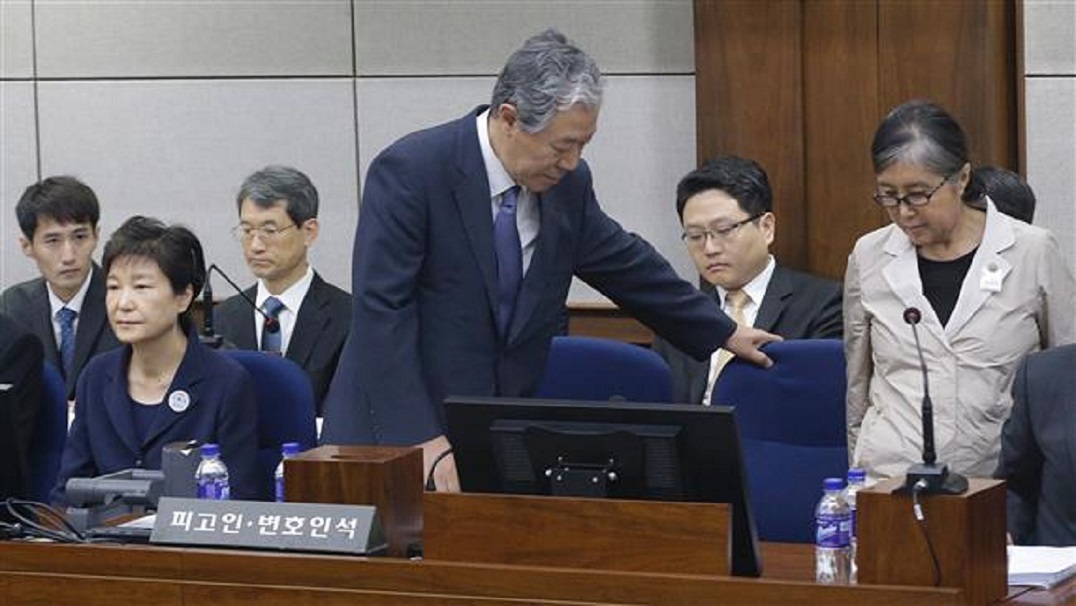
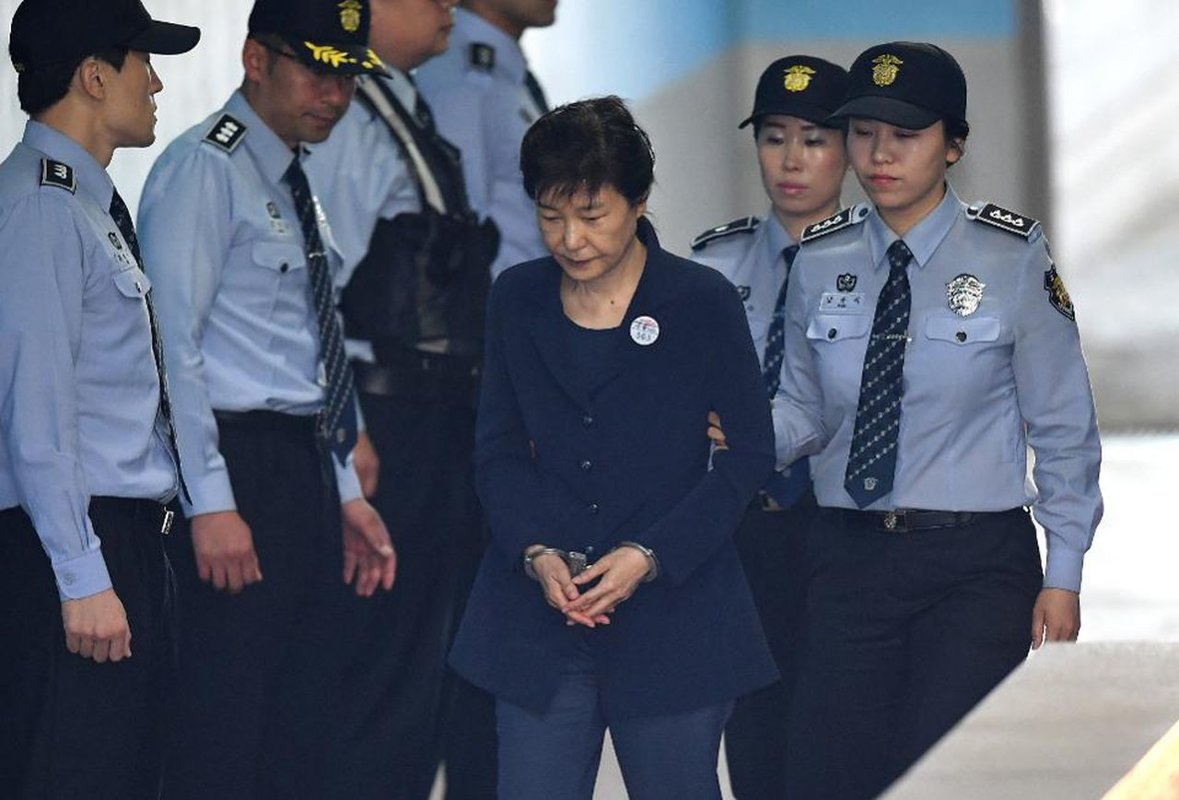 Former President Park Geun-hye stared straight ahead in court and denied that she engaged in bribery and leaking government secrets at the start of a criminal trial that could send South Korea’s first female leader to prison for life if convicted.Police escorted Park, in handcuffs with her eyes downcast, into court for her first public appearance since she was jailed on March 31 2017 based on the same corruption allegations that led to her removal from office.
Former President Park Geun-hye stared straight ahead in court and denied that she engaged in bribery and leaking government secrets at the start of a criminal trial that could send South Korea’s first female leader to prison for life if convicted.Police escorted Park, in handcuffs with her eyes downcast, into court for her first public appearance since she was jailed on March 31 2017 based on the same corruption allegations that led to her removal from office.
Cameras flashed as Park emerged from a bus, her inmate number 503 attached to her dark-colored jacket, and walked into the Seoul Central District Court. Her hands were then un-cuffed, and she entered the courtroom and sat before a three-judge panel while a throng of journalists captured images, often in extreme close up, of her somber face.When Judge Kim Se-yun asked Park, “What is your occupation?” she replied: “I don’t have any occupation.”Her longtime confidante, and the woman she is accused of conspiring with, Choi Soon-sil, sat near Park. The two had been friends for four decades but did not acknowledge each other.Choi sobbed as she answered questions about her address and occupation. But Park stared straight ahead as prosecutors read out the charges.“The accused Park Guen-hye, in collusion with her friend Choi Soon-sil, let Choi, who had no official position, intervene in state affairs … and they abused power and pressured business companies to offer bribes, thus taking private gains,” said senior prosecutor Lee Won-seok.Park’s lawyer, Yoo Young-ha, denied any wrongdoing. Asked whether she had anything to add, Park said in a calm, measured voice: “I will say afterward.”The judge also directly asked Park whether she denies all charges. “Yes,” Park replied, “I have the same position as the lawyers.”Choi, according to local media, said in court: “I am a sinner for forcing former President Park, who I have known and watched for 40 years, to appear in a courtroom.” She also said, “I hope this trial truly frees former President Park of fault and lets her be remembered as a president who lived a life devoted to her country.”“I am here to witness a new chapter of history being unfurled,” spectator Lee Jae-bong, 70, told a pool reporter. “I think Park must be punished thoroughly and never be pardoned so that such a bad thing may never happen again.”Park’s arrest came weeks after she was removed from office in a ruling by the Constitutional Court.Prosecutors boast of having “overflowing” evidence proving her involvement in criminal activities. They say Park colluded with Choi to take about $26 million in bribes from Samsung and was promised tens of millions of dollars more from Samsung and other large companies. Park also allegedly allowed her friend to manipulate state affairs from the shadows.A spokesman from the presidential Blue House said the office has no official statement to make on Park’s trial. New liberal President Moon Jae-in took office this month after winning a special election to replace Park.The scandal has led to the indictments of dozens of people, including former Cabinet ministers, senior presidential aides and billionaire Samsung scion Lee Jae-yong, who is accused of bribing Park and Choi in exchange for business favors. Lee faces a separate trial.Park has apologized for putting trust in Choi but denied breaking any laws and accuses her opponents of framing her. Choi also denies wrongdoing.The judges are expected to decide whether to try Park and Choi together or to split their cases. Park’s lawyers have alleged the combined hearings could create bias.Park has spent the past weeks locked in a small cell with a television, toilet, sink, table and mattress. She reportedly sees only a few visitors and her lawyers and mostly avoids television and newspapers. She avidly reads an English-Korean dictionary, according a report by a South Korean cable news channel, which cited an unnamed detention center source.Park, who won the 2012 presidential election over Moon by more than a million votes, enjoyed overwhelming support from conservatives who recalled her dictator father lifting the nation from poverty in the 1960-70s; critics recall his severe human rights abuses.As president, Park was criticized for what opponents saw as her imperial manner, her refusal to tolerate dissent, and her alleged mishandling of a 2014 ferry disaster that killed more than 300 people, mostly schoolchildren. The scandal involving Choi also destroyed Park’s carefully-crafted image as a selfless daughter of South Korea and inspired an angry public to push for her ouster and then elect Seoul’s first liberal government in a decade.Opinion surveys show a majority of South Koreans back the prosecution of Park, but she still has staunch supporters.About 150 people gathered near the court and reportedly waved national flags and raised placards that read, “Park is innocent! Release her immediately!” Some screamed and cried when a bus carrying Park passed by.The most damning allegation is that Park and Choi took bribes from Samsung, the country’s largest business group. Lee, Samsung’s de facto chief, is under suspicion of using millions in corporate funds to sponsor companies, sports organizations and nonprofit foundations controlled by Choi.In exchange, Park ensured government backing for a contentious merger of two Samsung companies in 2015 that was a key step in passing corporate control to Lee from his ailing father, prosecutors say.Prosecutor Hwang Woong-jae said that Park met Lee in July 2015 and “Park said she hoped the Samsung succession issue would be resolved smoothly under her government and asked Lee Jae-Yong to support the two foundations.”Lee has denied using the payments to win support for the 2015 deal, saying Samsung was just responding to Park’s requests to support culture and sports.Park’s lawyer, Yoo, said Park could not have benefited from the foundations because individuals could not freely take away money.Lee Jae-yong is far from being the only South Korean business tycoon to face a hefty jail term.The country’s powerful, family-run business empires chaebols have close political connections and a long history of their top figures being charged with bribery, embezzlement or tax evasion, among other offenses.But even if convicted, many see their sentences significantly reduced on appeal or suspended, leaving only a few actually spending time behind bars. Some have received presidential pardons in recognition of their “contribution to the national economy.”Such outcomes have driven increasing public frustration with cozy and corrupt ties between regulators and businesses in Asia’s fourth-largest economy.Here are a few examples of prominent court cases involving the country’s rich and powerful.SamsungLee Kun-hee, chairman of Samsung Group and Lee Jae-yong’s father, was embroiled in a huge corruption scandal in 2007 and accused of managing a slush fund, bribing politicians and making illegal attempts to smooth out the power succession for his son.Prosecutors initially demanded a seven-year jail term for the elder Lee, who was convicted of tax evasion in 2008 and given a three-year suspended prison sentence and a 110 billion won (now $98 million) fine.He was pardoned the following year by business-friendly then-President Lee Myung-bak.HyundaiIn 2007, prosecutors sought a six-year jail term for Chung Mong-koo, chairman of Hyundai Motors, for embezzlement and bribery.Chung was found guilty of siphoning hundreds of millions of dollars into a slush fund to bribe government officials and was given a three-year jail term, which was latersuspended on appeal. The tycoon received a full presidential pardon from then-President Lee Myung-bak in 2008.SKProsecutors demanded six years in prison for Chey Tae-won, chairman of chipmaker and telecom service provider SK Group, for embezzling nearly 50 billion won in 2013.Chey was sentenced to four years and spent about two years in jail, one of the longest sentences served by a South Korean chaebol leader.He was eventually released in 2015 along with thousands of others on a controversial presidential pardon by now ousted Park Geun-hye to mark the 70th anniversary of the end of Japanese colonial rule over Korea.HanwhaConstruction to hotels group Hanwha’s Chairman Kim Seung-youn was given four years behind bars and a 5.1 billion won fine in 2012 after he was convicted of embezzling hundreds of millions of dollars. It was a lighter sentence than the nine-year jail term sought by prosecutors but the decision was hailed as one that broke the pattern of light punishment for convicted chaebol leaders. Kim served only a few months in prison before the sentence was reduced to a suspended jail term.
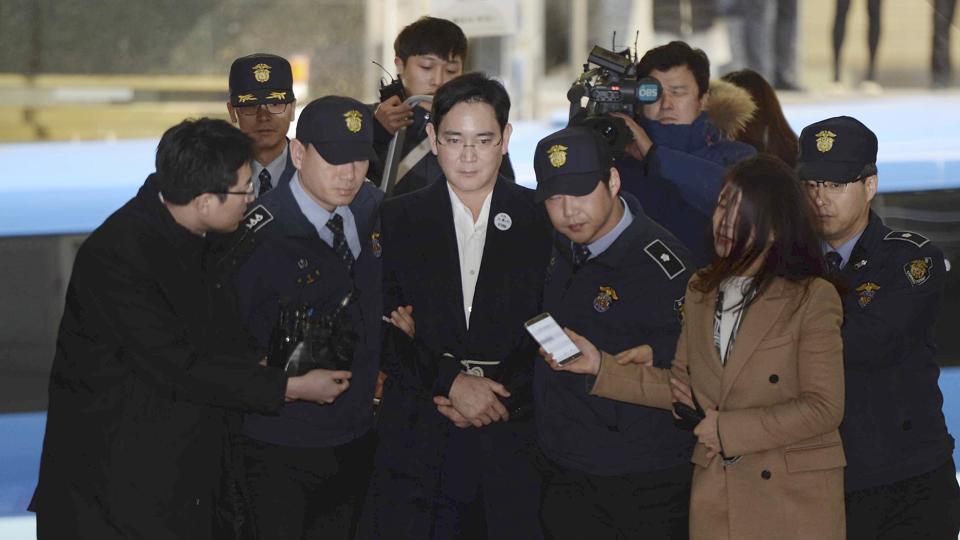 Lee Jae-yong (centre), vice-chairman of Samsung Electronics Co., over his alleged involvement in the corruption scandalcurrently engulfing South Korean President Park Geun - Hye.Among other allegations, Lee is accused of paying nearly $40 million in bribes to a confidante of the impeached president to secure policy favours.
Lee Jae-yong (centre), vice-chairman of Samsung Electronics Co., over his alleged involvement in the corruption scandalcurrently engulfing South Korean President Park Geun - Hye.Among other allegations, Lee is accused of paying nearly $40 million in bribes to a confidante of the impeached president to secure policy favours.
ISRAEL USES SYSTEMATIC VIOLATIONS,UNUSUAL PUNISHMENT,ATTACKED, ARRESTED THOUSAND OF PALESTINE CHILDREN,IT'S SINCE ISRAEL - PALESTINE WAR (1948) .STOLEN CHILDHOOD PALESTINIAN CHILDREN AND THE STRUCTURE OF GENOCIDAL DISPOSSESSION
Israel has not only been detaining Palestinian minors over stone throwing , the occupying force in Palestine has also been torturing most of those Palestinian children including beatings and sexual assaults, the Palestinian Committee of Prisoners’ Affairs said.An estimated 7,000 Palestinian children aged between 12 and 17 have been arrested, interrogated and detained since 2002. Palestinian children 'routinely tortured & used as human shields by Israeli forces',children arrest, settler colonialism, and the Israeli Juvenile system: A case study of occupied east Jerusalem. Minors are systematically subjected to physical and verbal abuse, threatened with death, physical violence and sexual assault.Israel tortures Palestinian children kept in prison for Months.Palestinian children in Occupied East Jerusalem (OEJ) have faced high rates of arrest. The article examines violence against children during arrest by juxtaposing state official documents recording debates and analyses of children’s rights with published reports by human rights and civil society organizations. The article suggests that arrested children in OEJ suffer from three intersecting discriminatory regimes: structural discrimination that targets them as criminals based on their ethnicity; a lack of assistance as they fall under the responsibility of neither the Palestinian nor the Israeli socio-legal systems; and limited access to welfare, justice, and educational oppor- tunities. The article concludes by suggesting that Palestinian children face severe structural violence that amounts to state-hate criminality and civil society resources. The article argues that criminologists must be attentive to the politics of targeting and marking children in the context of past and present structural violence . Borrowing from scholarly work addressing state violence against colonized chil- dren, mainly in settler-colonial contexts such as Australia, Canada and the US the following paper adopts Shalhoub-Kevorkian’s (2014) critique of the control of Palestinian childhood and draws upon Ward’s work on the state’s employment of violence to estab- lish and maintain relations of racial domination and subordination. Although Ward’s theorization pertains to minority children, Shalhoub-Kevorkian (2015) invokes it in the settler-colonial context, claiming that Israel’s violation of children’s rights, particularly through the political work of child arrest, could be considered a form of state-hate criminality Children's Rights.The group said most of the children are interrogated and questioned by Israeli police and investigators for hours without any legal representation or a parent present. Before the beginning of the new wave of unrest last October, Israel had reportedly not used indefinite detention against Palestinian minors.Tamir Abu Salem, a 14-year-old Palestinian boy from Aida refugee camp in the West Bank who was arrested last year by Israeli forces, told Ukka that soldiers shot him in the head with a rubber-coated steel bullet before he was taken into custody when he was also punched in the face.Tamir said the bullet fractured his skull. "When I breathe part of my scalp puffs up and down," he added.
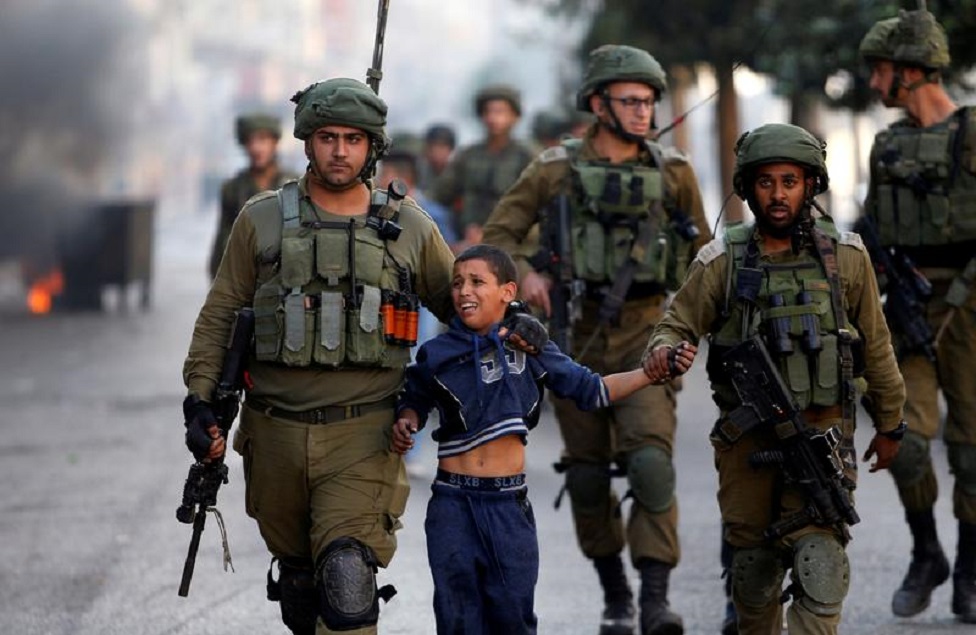
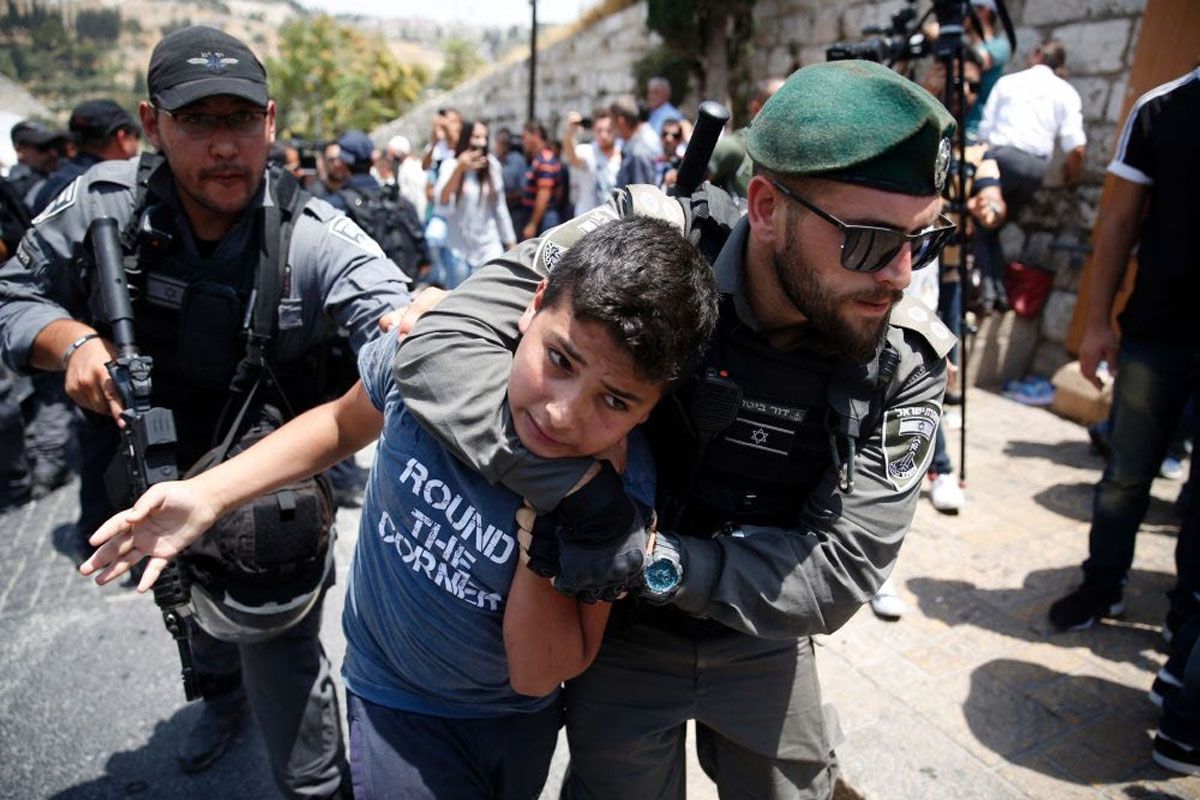
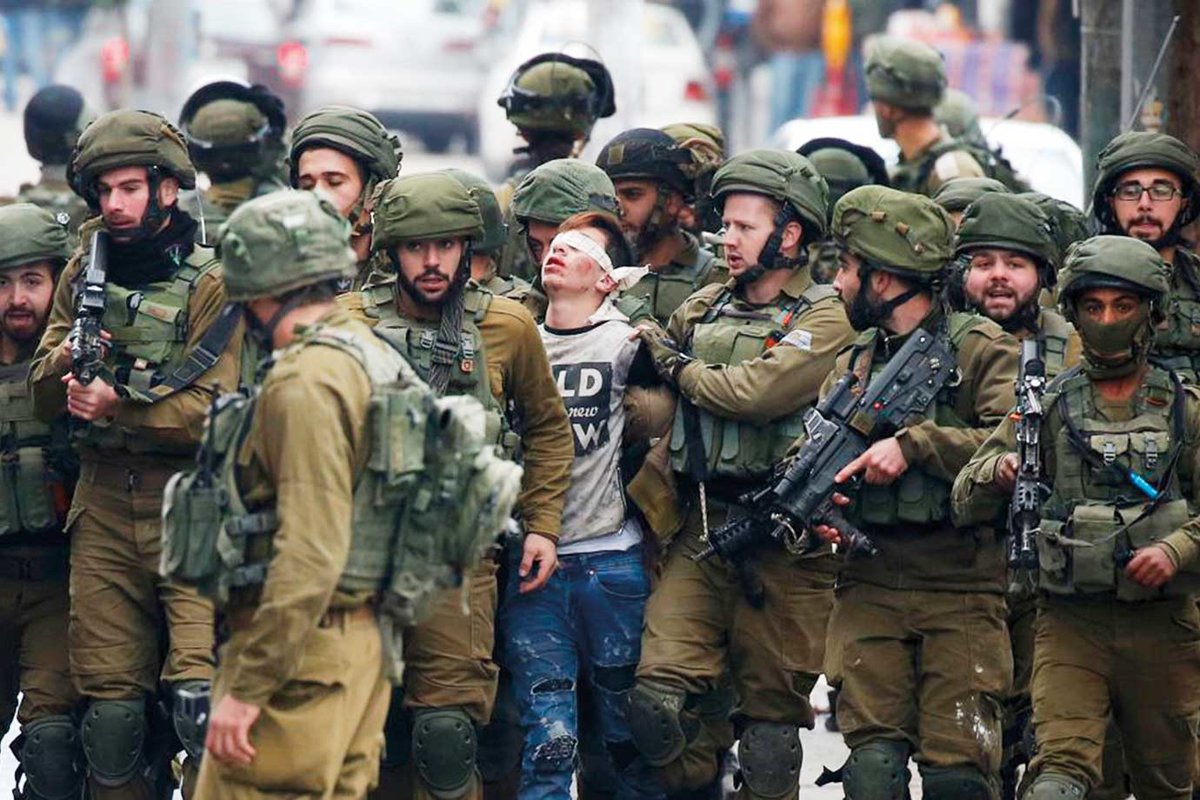 IDF soldiers testify to ill-treatment of Palestinian children.The report features 47 testimonies highlighting the harassment, arrest,
and mistreatment of Palestinian children living under Israeli
occupation.Once the children lit the Molotov cocktails, they “were free game,” according to a soldier’s testimony.Each of these deaths is abhorrent, let there be no mistake. The question is, how can we address the most systemic and pervasive offenses, including the documented abuses of children put under arrest and imprisoned by the Israeli military forces.
IDF soldiers testify to ill-treatment of Palestinian children.The report features 47 testimonies highlighting the harassment, arrest,
and mistreatment of Palestinian children living under Israeli
occupation.Once the children lit the Molotov cocktails, they “were free game,” according to a soldier’s testimony.Each of these deaths is abhorrent, let there be no mistake. The question is, how can we address the most systemic and pervasive offenses, including the documented abuses of children put under arrest and imprisoned by the Israeli military forces.
There's no beautifying Israel's treatment of Palestinian children.The central problem at the heart of Israel’s half-century old military court system is clear: these courts will never reflect the interests of the defendants, but rather that of the regime of occupation.Palestinian children have suffered disproportionately as a result of the Israeli Occupation.During the first Intifada in Israel-Palestine, one of the most controversial aspects of the Israeli reaction to the uprising in 1987 was Yitzhak Rabin’s reputed policy of ordering soldiers to break the bones of those throwing rocks, as shown in this video. While Rabin denied having soldiers break the bones of demonstrators, he did admit to ordering the extra-judicial application of ''force, might and beatings'' upon civilians. Since that time, whether it be an official policy or not, such practices emphatically illegal under international human rights law continue unabated. What has recently been brought into the public eye is that such illegal beatings and other acts of violence continue to be aimed not only at adults, but also at Palestinian children, some as young as 11 years old.Palestinian children detained by Israeli forces in the occupied West Bank last year fell victim to a pattern of abuse designed to coerce confessions.Among the most troubling experiences were prolonged periods of solitary confinement, a correctional tactic primarily reserved for adult prisoners and, even then, only after they are convicted. In 2014, the average time an individual child spent in solitary confinement for interrogation purposes was 15 days, according to DCIP research. In one case, Israeli authorities kept a child in isolation for 26 total days.Israeli military, police and security agents held 54 Palestinian children in solitary confinement for interrogation purposes prior to charging them with any offense.Data compiled by DCIP from 107 affidavits of Palestinian children showed the vast majority had to fend for themselves. Unlike their Israeli counterparts, Palestinian children have no right to be accompanied by a parent during an interrogation. In 93 percent of cases, children were deprived of legal counsel, and rarely informed of their rights, particularly their right against self-incrimination.Settlers living in the West Bank carrying out violence against Palestinians is no new phenomenon, Israeli human rights NGO B’Tselem refer to it as having “long since become part of Palestinians’ daily life under occupation.” Yet a rise in aggressive incidents is still a cause for concern for Palestinians living in close proximity to illegal settlements. B’Tselem felt unable to offer any reasoning for the increased attacks.Incidents of settler violence are coupled with hollow accountability and poor law enforcement by Israeli authorities, while Palestinian police are forbidden from responding. Standing amid rubble of what was Abu a-Nawar’s 3rd and 4th grade classrooms, the disparities between the 650 person Bedouin village and the 21st century Israeli settlement, Ma’ale Adumim are undeniable.The village behind is an assorted collection of wood-framed shelters on concrete slabs, covered with a patchwork of cloth, metal and plastic. There are small pens to keep in the goats, and a crisscrossing web of wires bringing electricity, 'illegally’, from the nearest town a kilometer away. A knobby dirt road is the only way in or out.Ma’ale Adumim creeps over the edge of the butte and down into the ravine directly adjacent to Abu a-Nawar. The multi-story homes loom over the village, neatly spaced floodlights midway down the side of the gulch, satellite dishes, paved roads in what is clearly a tight suburban development. A security tower, is perched, overlooking everything.In fact, from the rubble, there are three visible security towers. One to the north, Ma’ale Adumim, one to the immediate south, and one to the east, all on the edges of the low foothills leading into the valley below.
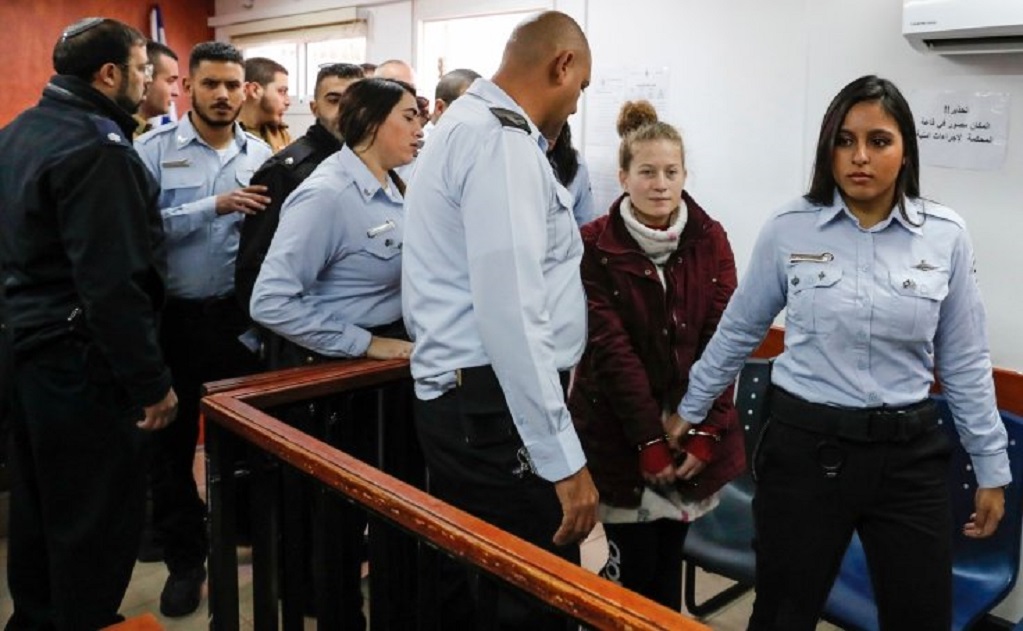
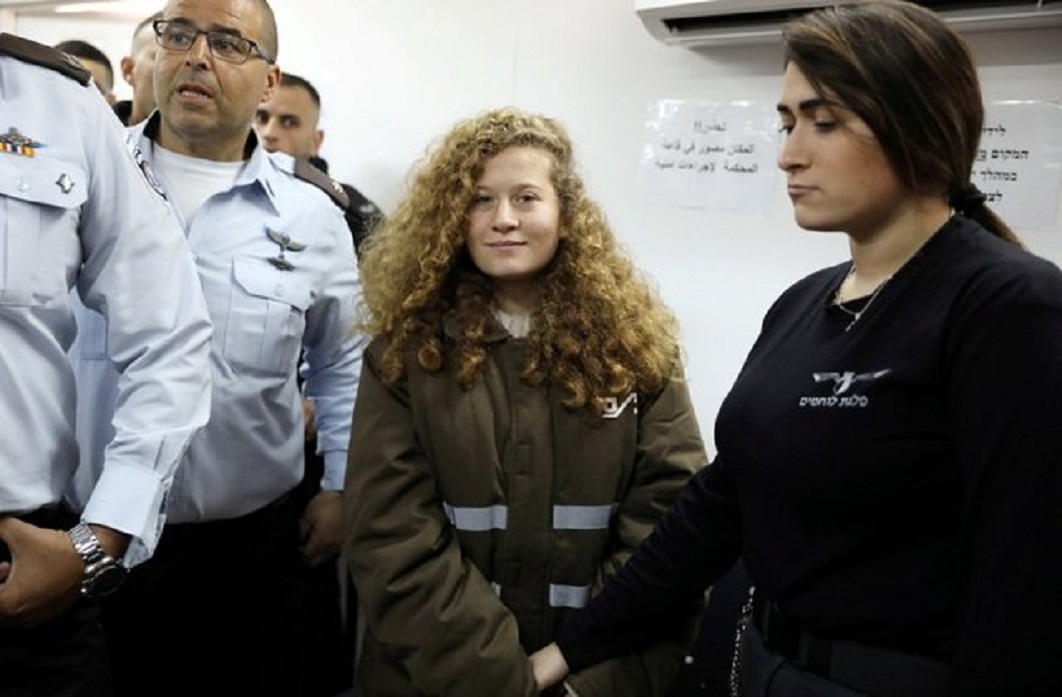 Judge orders trial of Palestinian girl, 17, filmed slapping and punching two Israeli soldiers to be held behind closed doors as she appears at military court.Ahed Tamimi's story, will come as news to you, despite the mainstream media's best efforts.Tamimi was arrested early on 19 December following a confrontation with two Israeli soldiers a few days earlier at her family home in Nabi Saleh near Ramallah.The 16-year old, along with her cousin, was telling the soldiers to leave her house before things eventually escalated to the use of physical force, when one of the soldiers slapped her. The situation escalated and led to the shooting of Ahed's 14-year-old cousin, Mohammed, in the face.
Judge orders trial of Palestinian girl, 17, filmed slapping and punching two Israeli soldiers to be held behind closed doors as she appears at military court.Ahed Tamimi's story, will come as news to you, despite the mainstream media's best efforts.Tamimi was arrested early on 19 December following a confrontation with two Israeli soldiers a few days earlier at her family home in Nabi Saleh near Ramallah.The 16-year old, along with her cousin, was telling the soldiers to leave her house before things eventually escalated to the use of physical force, when one of the soldiers slapped her. The situation escalated and led to the shooting of Ahed's 14-year-old cousin, Mohammed, in the face.
On April 9, footage of Ahed Tamimi’s interrogation, following her arrest last December, showed a police interrogator and an Israeli military intelligence officer, both male, soliciting various tactics to coerce Ahed into speaking.The entire incident was filmed and the footage has since been viewed and shared globally with both solidarity and admiration over these young girls' uncompromising stand, as well as outrage from Zionists who have demanded punishment ranging from imprisonment to crude violations of human rights.Ahed Tamimi is facing 12 charges made by the Israeli authorities, including incitement, making threats, assault, and stone-throwing which relate to six different incidents.To make matters worse, more of the family members have since been arrested including her 43-year old mother Narimen Tamimi who faces five charges, as well as her 21-year-old cousin, Nour Naji Tamimi. During a protest demanding their release from Ofer prison, Ahed Tamimi's cousin Manal Tamimi was also arrested.The targeting of this family is, in many ways, unsurprising. Indeed, the family is known for its long standing opposition and resistance to the Israeli occupation, as well as its regular participation in various protests in the West Bank, often captured through images and video streaming.She responded largely with silence.Ahed Tamimi’s father, Bassem Tamimi addressed a press conference held in Ramallah, stating his daughter “understands what it means to resist this occupation.”He called her silence during interrogation a strategy of resistance. Bassem told press that by refusing to even answer her name, she showed resistance to occupation in all its forms.Ahed demonstrated this rejection of the entire system of occupation by telling reporters “there is no justice under occupation and this court is illegal,” after her sentencing.Ahed’s treatment mirrors the findings of B’Tselem’s recent report on the systematic violations of minors in Israeli courts which found, for instance, Palestinian minors to be deprived of food, sleep and water before interrogations.Bassem said Ahed was deprived of sleep for over 34 hours in the final round of interrogations.Other psychological tactics employed were isolation; continuous transportation through what he described as “essentially a metal box” and intimidation and threats from other criminals.Bassem contextualised the interrogation footage by saying it shows “how Israel targets the Palestinian child” and “the occupation targets childhood.”45,000 Palestinian children have been detained by the military in the last 50 years and human rights organisations have reported violent arrests, traumatising interrogations, the use of solitary confinement and even reports of electric shocks, strangulation and being kept naked in the cold.Efforts to elicit a response from Ahed also involved threatening to take people known to her into custody if she did not speak about them.“It’s in your hands,” the interrogators told her, after listing some names.In another portion of the footage interrogators remarked to Ahed about her appearance.One officer told her her white skin reminded him of her sister. “How are you in the sun?” he asked, “Like my sister? Red, red, red?”Ahed’s Israeli lawyer, Gaby Lasky, has accused interrogators of sexual harassment following the footage, based upon the questioning being inappropriate for a female minor and the lack of another female in the room.“I see you as my sister, she [Nariman Tamimi, Ahed’s mother] is like my mother because you know she is older,” the officer continued, trying to evoke a personal response.When Ahed did speak, it was usually to repeat the refrain, “I hold the right to remain silent.”Otherwise the footage shows her sitting steadfast and defiant, appearing unflapped, avoiding eye contact and looking straight ahead.At one point she stretches her neck. An interrogator meanwhile sits with his chair facing her, shouting and gesticulating.Baseem concluded that the footage shows “Ahed and her generation are not victims but fighters.”In sharing this video, he hopes they can teach children “how to confront the interrogator without fear entering their hearts” while hoping parents watching can see how their children, collectively, are strong and able to confront occupation.Three other Palestinians were reported injured with rubber-coated steel bullets during the clashes.The teenager is a distant relative of Ahed Tamimi, the 16-year-old Palestinian activist who is currently facing charges in an Israeli military court after she was filmed slapping a soldier .The Israeli army told Israeli media Musaab Firas Tamimi was carrying a gun, but that this was "not immediately confirmed," according to the Times of Israel.
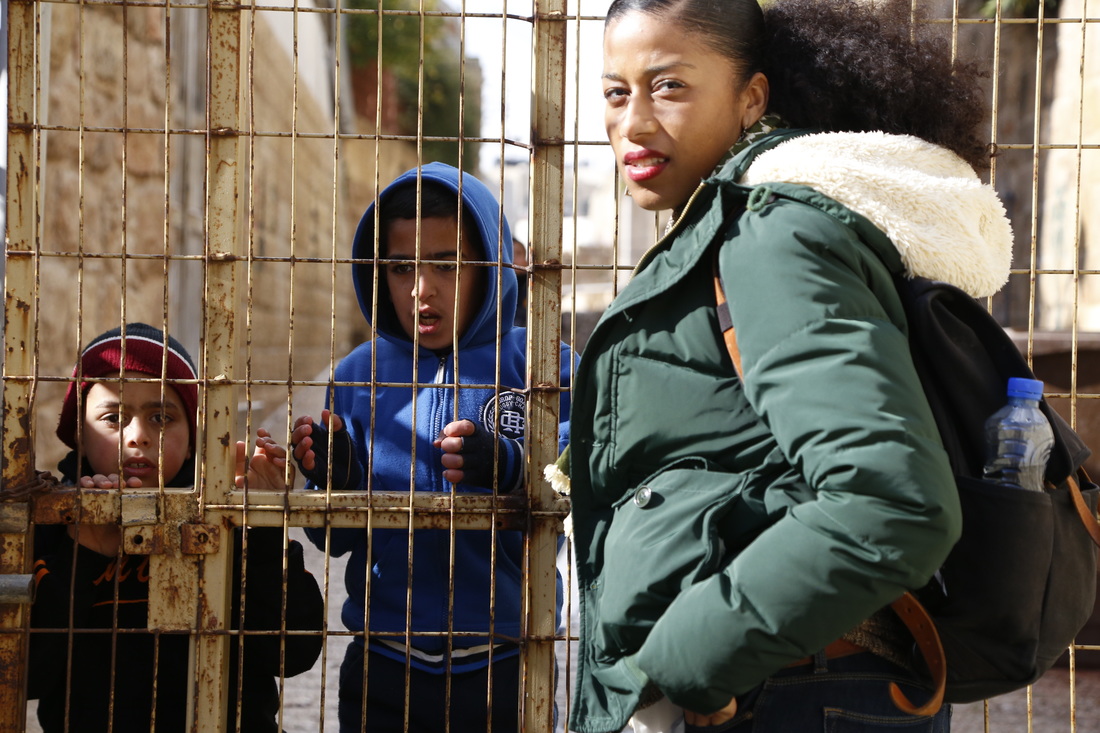
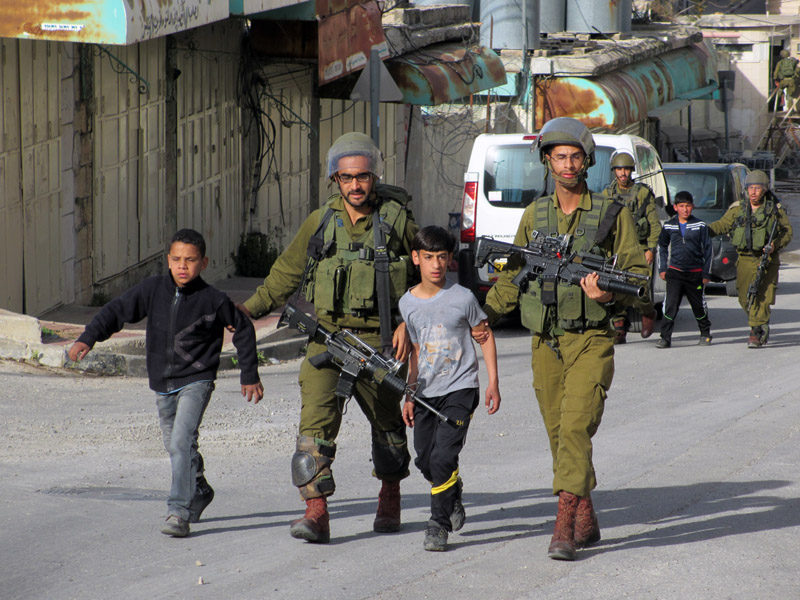
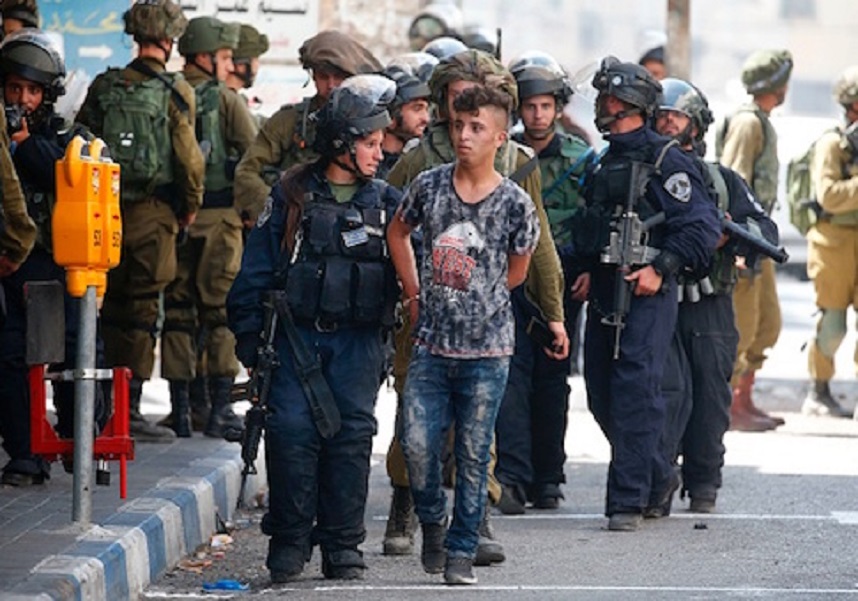 According to Defense for Children International (DCI), a Geneva-based
non-governmental agency, 700 Palestinian
children in the West Bank
alone are detained and imprisoned by Israel
every year. Furthermore, based
on a survey of 100 of these children,
lawyers found that 69% were
beaten and kicked, 49% were threatened, 14% were
held in solitary confinement, 12% were threatened with sexual assault,
including rape, and
32% were forced to sign confessions written in
Hebrew, a language they do
not understand. Such institutionalized and
systematic mistreatment
is considered torture by the United Nations
under international law and
specifically contravenes the Convention on the
Rights of the Child to which
Israel is a signatory.
According to Defense for Children International (DCI), a Geneva-based
non-governmental agency, 700 Palestinian
children in the West Bank
alone are detained and imprisoned by Israel
every year. Furthermore, based
on a survey of 100 of these children,
lawyers found that 69% were
beaten and kicked, 49% were threatened, 14% were
held in solitary confinement, 12% were threatened with sexual assault,
including rape, and
32% were forced to sign confessions written in
Hebrew, a language they do
not understand. Such institutionalized and
systematic mistreatment
is considered torture by the United Nations
under international law and
specifically contravenes the Convention on the
Rights of the Child to which
Israel is a signatory.
FORMER POLAND'S FOREIGN MINISTER WITOLD WASZCZYKOWSKI SAYS ,GERMANY SHOULD PAY IN POLAND AS $1 TRILLION IN WAR WORLD WAR II REPARATIONS
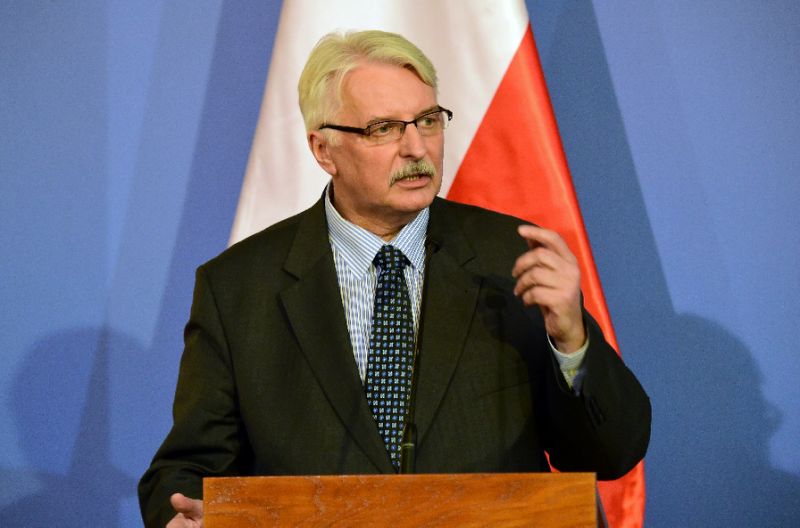 Poland’s
government has shed the country’s “negro mentality” when it comes to
relations with the United States, former Foreign Minister Witold Waszczykowski
said on Polish public television.
Poland’s
government has shed the country’s “negro mentality” when it comes to
relations with the United States, former Foreign Minister Witold Waszczykowski
said on Polish public television.What are Warsaw’s worries these days?As in most countries, domestic issues like the economy are the biggest day-to-day concerns for most people. When it comes to foreign policy, the behemoth to the east Russia overshadows everything. Polish officials are keenly aware that they have Trump’s ear as he heads into bilateral talks with Russian President Vladimir Putin on Friday on the sidelines of the summit in Hamburg. Like all NATO allies that have Russia as a near neighbor, Poland has a keen interest in the degree of Trump’s commitment to the NATO alliance’s fundamental principle, which states that an attack on one is an attack on all.The new committee was formed after Polish lawmakers Arkadiusz Mularczyk and Jozef Menes dug out a 1969 UN document, which they claim proves Poland, has in fact, not relinquished its right to war compensation from Germany. Waszczykowski was interviewed by a local radio station RMF when he said that “serious talks” were needed with Poland’s neighbour to “find a way to deal with the fact that German-Polish relations are overshadowed by the German aggression of 1939 and unresolved post-war issues”. He added that Germany was “shirking” its moral responsibility.Polish defense minister Antoni Macierewicz similarly accused European critics of his government that they were busy “erasing” the fate that Poles suffered at Nazi hands during the war “from the historical memory of Europe”. The war killed a fifth of the Polish population.In 1953, Poland’s former communist government said claims to reparations from Germany were no longer possible. Some six million Polish citizens were killed during the war and much of Warsaw wasdestroyed. Waszczykowski did not expand his demand to include a time frame on a public formal position on repatriations from Poland, suggesting that his comments were rather a criticism of Germany’s role in the EU. The European Union launched legal action in July against a number of East European states over migrant quotas, and the PiS says Berlin wields too much influence within the EU.
 Polish president Andrzej Sebastian Duda, former the Prime Minister, Beata Szydło,Poland's populist government has harnessed, legitimized, and the ruling right-wing Law.Polish a right-wing, populist, anti-immigrant government sees an ally in Trump.
Polish president Andrzej Sebastian Duda, former the Prime Minister, Beata Szydło,Poland's populist government has harnessed, legitimized, and the ruling right-wing Law.Polish a right-wing, populist, anti-immigrant government sees an ally in Trump.
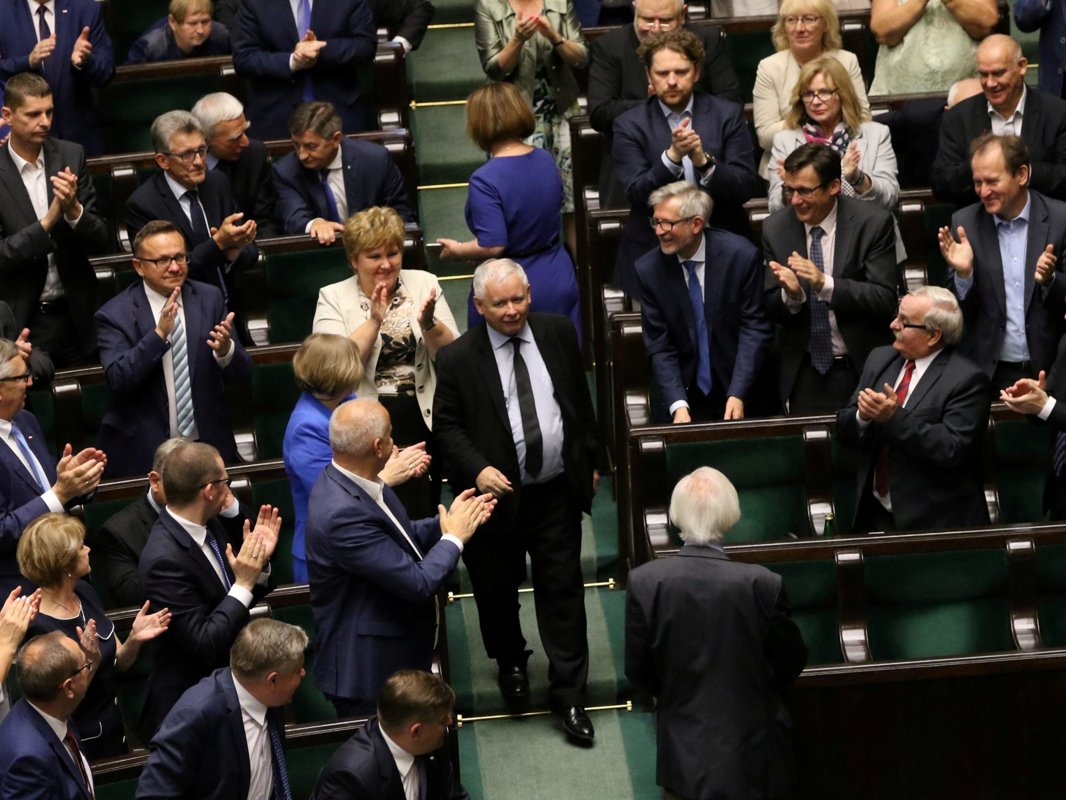 Polish MPs set up committee to calculate potential WWII reparations from Germany. A
senior Russian Communist Party MP also recently described the Polish
initiative as “empty words” and noted that he did not expect this issue
to have any tangible effect on international relations.
Polish MPs set up committee to calculate potential WWII reparations from Germany. A
senior Russian Communist Party MP also recently described the Polish
initiative as “empty words” and noted that he did not expect this issue
to have any tangible effect on international relations.
The Communist Workers’ Party of Poland,as the final machinations of the warring nations played out, a revolutionary wave was on the horizon. The havoc and destitution which followed the First World War rallied the working classes, and for many the events in Russia served as an inspiration. Poland was no different. In 1918, workers’, peasants’ and soldiers’ councils formed across the land. Some were quickly neutered by reformist and patriotic tendencies, others formed their own militias, the red guards, and openly challenged the rising Polish state for control. 1 All manner of militants got involved in their structures, vying for influence. Among these was the Social Democracy of the Kingdom of Poland and Lithuania (Socjaldemokracja Królestwa Polskiego i Litwy, SDKPiL), a sister party of the RSDRP, and the PPS-Left, an internationalist split from the social-patriotic Polish Socialist Party (Polska Partia Socjalistyczna, PPS). After years of common struggle, these two groups, the SDKPiL and the PPS-Left, would merge in 1918 to form the Communist Workers’ Party of Poland (Komunistyczna Partia Robotnicza Polski, KPRP). A year later, the KPRP, represented by the delegate Józef Unszlicht (in the absence of Julian Marchlewski), took part in the founding congress of the Communist International (Comintern). From that point onwards, the future of the Polish party was directly linked with developments in the International.Thousands of protesters in Poland gathered outside of parliament in Warsaw to voice opposition to a draft law reforming the judiciary.Fascist MPs sneak into parliament under banner of rock star’s party Poland’s hardcore fascist parties – the National Radical Camp (Obóz Narodowo-Radykalny, ONR) and the All-Polish Youth (Młodzież Wszechpolska, MW) – have traditionally been paramilitary and streetfighting organisations. But they launched an electoral alliance, the National Movement.The Communist Left in Poland,we can point towards two main currents on the left of the KPRP. The more forgotten, but also more interesting, were the so-called Grzechists (‘Grzechiści’) of the 1918-23 period, rallied around one of the KPRP founders Władysław Kowalski-Grzech. The label has been used to denote sympathisers of Grzech, but was most likely not the way they identified themselves. 5 The other was a group which in the years 1924-25 became known as the Berlin Four (‘czwórka berlińska’), consisting of Henryk Stein-Domski, Julian Leszczyński-Leński, Zofia Unszlicht-Osińska and Ludwik Henryk Prentki-Damowski.What follows is a short biographical sketch of Grzech and Domski prior to the formation of the KPRP. Before that however, a brief note to keep in mind: the politics of Grzech and the Grzechists should not be conflated with the politics of Domski (and especially the later Berlin Four). They were all on the left of the party and came to similar conclusions on a number of issues, but they never quite constituted the same faction.
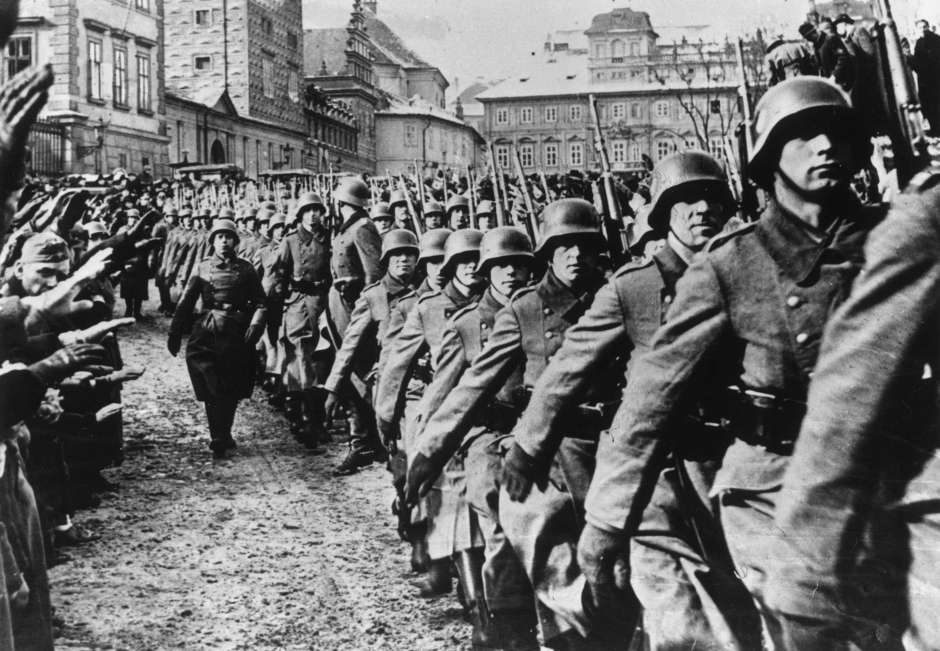
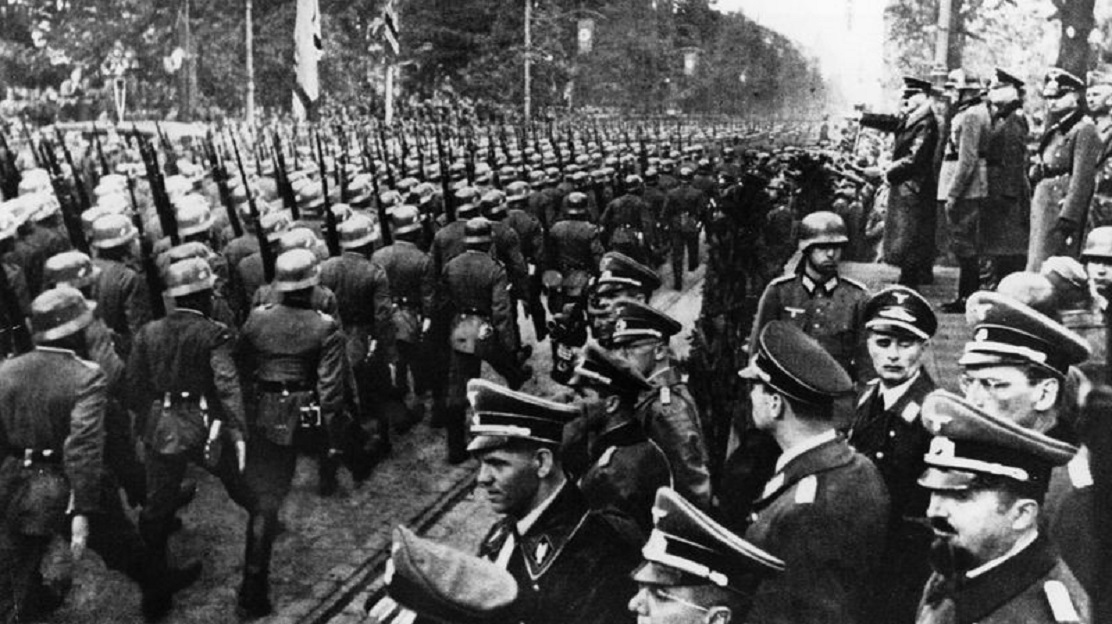 Poland has set up a parliamentary investigative committee to
calculate the amount of World War II reparations the country believes
it’s still owed by Germany following the invasion and consequent
occupation during World War II.The new committee was
formed after Polish lawmakers Arkadiusz Mularczyk and Jozef Menes dug
out a 1969 UN document, which they claim proves Poland, has in fact, not
relinquished its right to war compensation from Germany.
Poland has set up a parliamentary investigative committee to
calculate the amount of World War II reparations the country believes
it’s still owed by Germany following the invasion and consequent
occupation during World War II.The new committee was
formed after Polish lawmakers Arkadiusz Mularczyk and Jozef Menes dug
out a 1969 UN document, which they claim proves Poland, has in fact, not
relinquished its right to war compensation from Germany.
FORMER THAI PRIME MINISTER YINGLUCK SHINAWATRA'S RICE SCANDAL, FLED INTO EXILE TO DUBAI AHEAD OF CORRUPTION VERDICT TO AVOID A JAIL SENTENCE
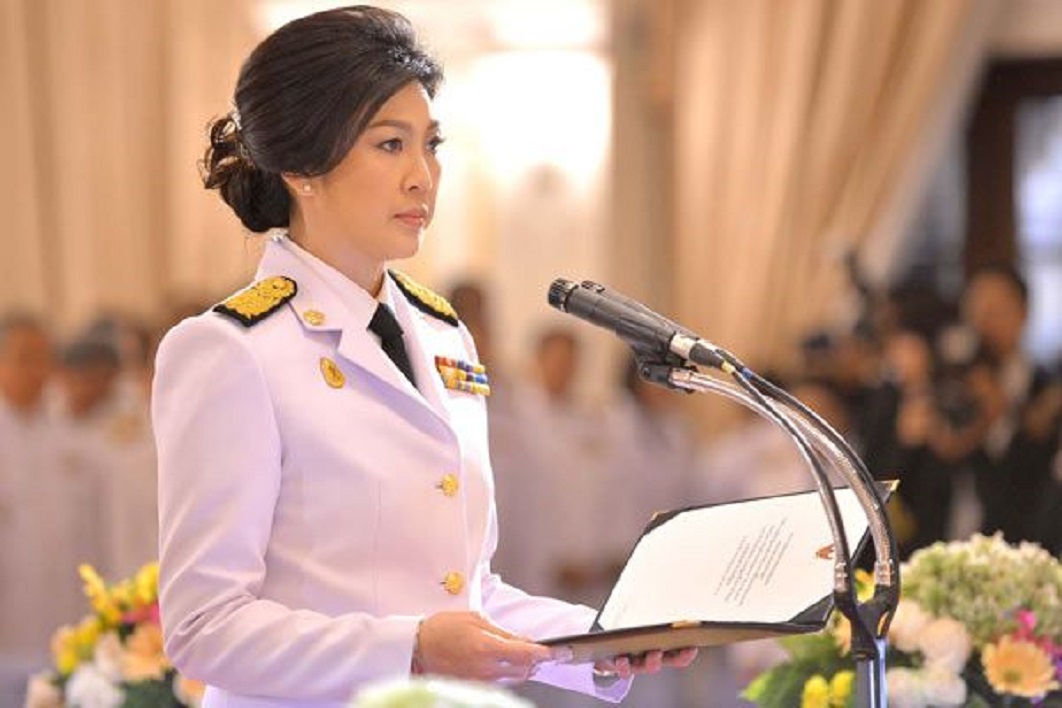 Yingluck became Thailand's first female prime minister when she was elected into office , and at 44 at the time became the youngest prime minister of Thailand in more than 60 years. She's also an accomplished businesswoman, and earned her master's degree from Kentucky State University.
Yingluck became Thailand's first female prime minister when she was elected into office , and at 44 at the time became the youngest prime minister of Thailand in more than 60 years. She's also an accomplished businesswoman, and earned her master's degree from Kentucky State University.
Thailand's first female Prime Minister Yingluck Shinawatra has been named as the first female Prime Minister of Thailand,the former businesswoman drew hordes of supporters whenever she toured her electoral heartlands, taking endless selfies and being showered with red roses.The 50 -year-old businesswoman is the sister of former premier Thaksin Shinawatra, who is currently in exile.This was Shinawatra’s first time running in an election for the Pheu Thai party and she was a political novice.After her nomination , her campaign received lots of coverage
and she quickly stole attention from the outgoing premier Abhisit
Vejjajiva.Shinawatra comes from a political family but was not thought to have wanted to pursue the role of Prime Minister.She graduated from university in Thailand before attending Kentucky State University in the United States in 1991.After entering the business world, she became CEO of Advanced Info
Service Pcl and then president of the family’s property firm, SC Asset
corporation.Shinawatra has a partner and nine-year-old son, the latter of whom often accompanied her on campaign events.Her election comes after a turbulent five years for Thai politics.She will have to find a delicate equilibrium between the coup-prone
army and the elite establishment on one side, and the so-called Red
Shirt movement on the other.Her brother Thaksin was exiled in 2006.Her campaigning strategy - dubbed fighting with smiles - and her propensity to shed tears in public forged an image far removed from that of the stern junta generals who ousted her from office in a 2014 coup.In private she wielded authority among her party and entourage, in a country where deference is expected towards wealth and power.Her weakness was her elder brother Thaksin, whose deep networks hoisted her to power despite his long absence from Thailand.The billionaire telecoms tycoon has lived in self-imposed exile since 2008 to avoid jail in Thailand for corruption convictions.He was ousted as prime minister by an army coup in 2006, which opened a seemingly unbridgeable chasm between his supporters and enemies.Yingluck's premiership was scuttled in 2014 by a court ruling over a technicality.Weeks later the army shunted aside the rest of her administration.For her first two years in office, the outlook seemed very different.The photogenic former businesswoman charmed many of her critics and for a period maintained the peace across Thailand's bitter political divide.She reached out to the military and worked to appease political opponents within Thailand's Bangkok-based establishment, which loathes Thaksin and wants to curb the Shinawatras' 13-year influence on Thai politics.But the shaky truce collapsed in November 2013 after a failed bid to pass an amnesty bill which would have enabled Thaksin's return.The move outraged government opponents who flooded the streets for months-long protests marked by violence that left dozens dead and hundreds wounded.Yingluck became the focus of caustic - and often explicitly sexist - tirades by protest leaders.But the mother-of-one refused to joust with her detractors and held off on a violent crackdown.She took a leaf out of Thaksin's playbook, launching lavish welfare schemes aimed at the rural poor, including the rice subsidy programme.The bungled scheme was a lightning rod for anger among protesters and also became her ultimate undoing after the court deemed her guilty of failing to stop corruption.Yingluck, who graduated in political science before earning a master's degree in business administration in the United States, spent much of her career working in her brother's empire.Rising from trainee status, she eventually became president of the mobile telephone unit of Shin Corp, the telecoms giant founded by Thaksin that was at the centre of a tax scandal in 2006.
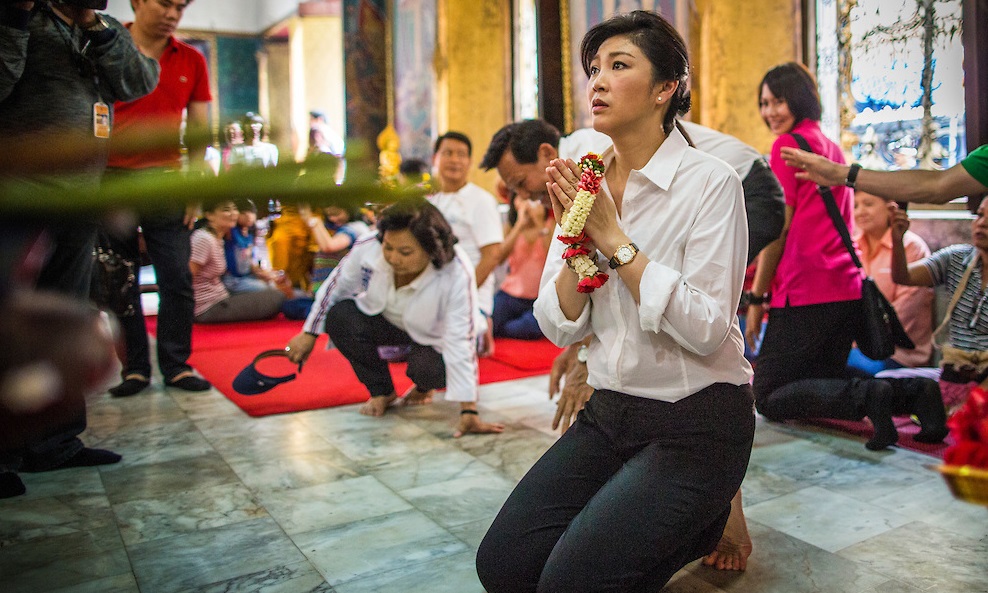 Ex Thai prime minister Yingluck Shinawatra impeached.Thai legislature has voted to impeach former prime minister Yingluck Shinawatra over an allegedly corrupt rice purchasing scheme.Thailand’s junta-appointed legislature impeached former prime minister Yingluck Shinawatra and banned her from politics for five years, while the attorney general’s office announced it will file criminal charges against her.
Ex Thai prime minister Yingluck Shinawatra impeached.Thai legislature has voted to impeach former prime minister Yingluck Shinawatra over an allegedly corrupt rice purchasing scheme.Thailand’s junta-appointed legislature impeached former prime minister Yingluck Shinawatra and banned her from politics for five years, while the attorney general’s office announced it will file criminal charges against her.
Thai Supreme Court has taken former Thai Prime minister Yingluck Shinawatra to court over rice’s scandal.Yingluck, whose family has dominated Thai politics for more than 15 years, failed to show up at court for judgment in a case centred on the multi-billion dollar losses incurred by a rice subsidy scheme for farmers.She has definitely left Thailand,” said one source, who is also a member of her Puea Thai Party. The sources did not say where she had gone.The struggle between that movement and a Bangkok-centered royalist and pro-military elite has been at the heart of years of turmoil in Thailand. The verdict against Yingluck could have reignited tension, though the army has largely snuffed out open opposition.The charges against Thailand’s first female prime minister, who was removed from office for abuse of power in May days before a military coup, concern her role in scheme that paid farmers above market prices for rice and cost Thailand billions of dollars.The National Anti-Corruption Commission investigating the case says Ms Yingluck was negligent for failing to stop losses from the programme. Yingluck was impeached by a vote of 190-18 in the 220-member National Legislative Assembly (NLA), which was hand-picked by the junta and is dominated by active or former military officers.There were eight “no votes”, three invalid ballots and one member was absent.Yingluck argues the allegations are politically motivated and has defended the rice program as a way to boost incomes in rural areas.“Banning me for five years would be a violation of my basic rights,” Yingluck said in an almost hour-long address to the NLA , prior to the vote.“This case that is aimed solely against me has a hidden agenda, it is politically driven.What are the real reasons why former Thai Prime Minister Yingluck Shinawatra stay in Thailand to face trial over rice subsidies, instead she has chosen to flee?According to Thai media sources, she fled the country while facing trial over agricultural subsidies through Cambodia, and then took personal jet direct flight to Singapore where her brother, Mr. Thaksin Shinawatra, also former Thai Prime which fled Thailand over the allegation of real estate misconduct, and then flew to Dubai in the United Arab Emirates. The Thai Supreme Court has seized Mr. Thaksin Shinawatra's family asset of around $1.5 billion in contested assets, over allegations of corruption and conflict of interest. This makes both of the brother and sister the first two Thai Prime Minister ever to flee court case and court ruling.Mr. Thaksin's sister, Yingluck is in the same boat as her brother facing political backlash, but her whereabouts is still remain a mystery. According to Thai media source she said that both of Thai constitutions, the new one which is still needed the approval from Thai king before it comes into effect as well as the current one is not balanced and neutral due to the repealing system that could put her in jail for decades.Thai official saw this incidents as a bad example for those powerful people who committed crimes and then can go free but punishing the small fish instead, which does not do its justice.However, the Thai communities and Thai Junta government disagree, arguing that she and her government are at fault from leaving a big mess and hardship for Thai farmers' livelihood and Thai rice industries which lost it competitive advantage due to the overpricing of rice.Even though she has freed herself, and don't have to worry about being extradited back to Thailand to serve her time, many of her then senior officials were sentenced to many decades in jail time. If she stay in Thailand and fight this case, Thai Ministry of Justice could put her in jail over the negligence of rice-buying scheme, which cost the country a fortune.Those
were apparently the last words from Thailand's ousted prime minister
Yingluck Shinawatra to a close aide, trying to make sure her son was
cared for, before she left Thailand ahead of the court verdict on her
criminal negligence trial.Various
unconfirmed reports in Thai media say she crossed the land border into
Cambodia last Wednesday evening, before taking a flight - possibly on a
private plane - to Singapore and then onward to Dubai, where her
billionaire brother and former Thai premier Thaksin Shinawatra keeps a
home, while living in self-imposed exile.The court decides criminal case against Thailand's former PM,for
a trial on criminal negligence looking into her role in a debt-ridden
rice subsidy scheme during her administration, in Bangkok, Thailand,
January 15, 2016.Yingluck,
whose government was overthrown in a 2014 coup, is the sister of ousted
populist Prime Minister Thaksin Shinawatra, who was himself deposed in
2006 and, though now in self-exile, remains at the heart of a decade of
divisive politics.The
charges Yingluck faces in the Supreme Court stem from her management of
a rice subsidy scheme, a flagship policy that helped sweep her to
office in a 2011 landslide but which critics say haemorrhaged billions
of dollars.Yingluck,
ousted shortly before the 2014 military coup, could have been jailed
for up to 10 years, if found guilty. Supporters denounced her case as
political persecution designed to drive the Shinawatra family out of
politics.The verdict is generally seen as a political judgment as much as a
criminal one.
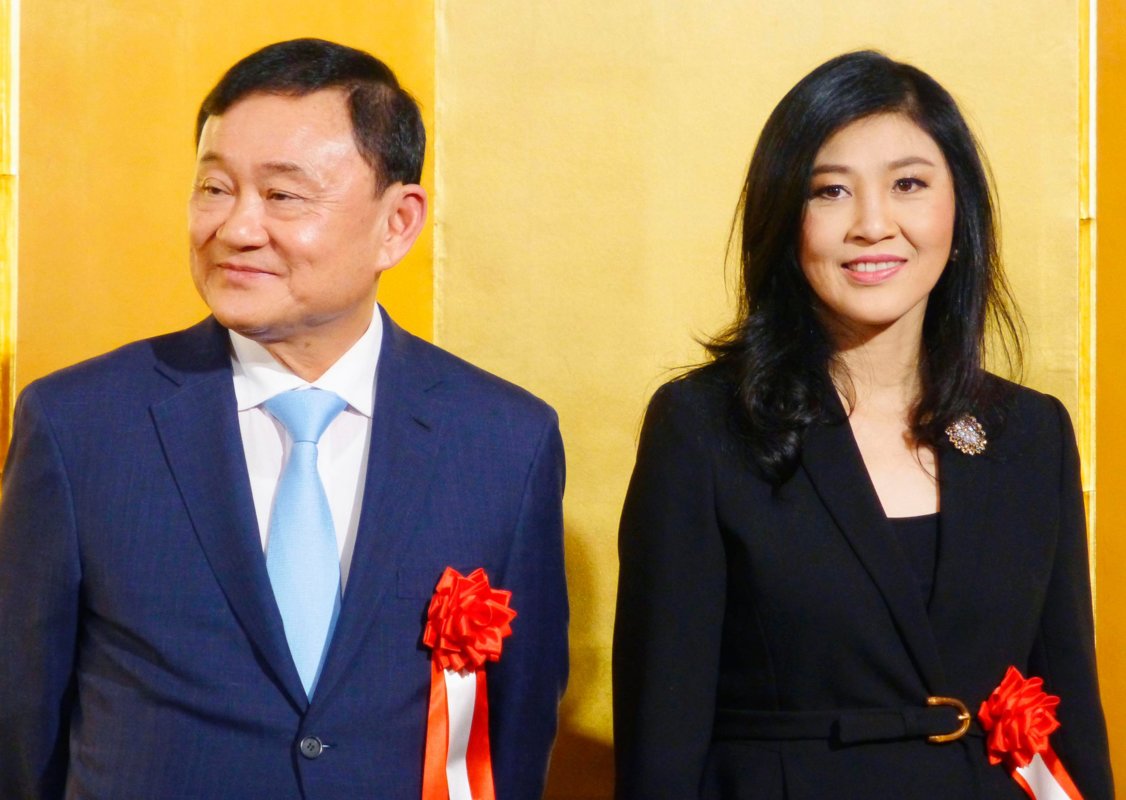 Ousted Thai prime minister Yingluck Shinawatra has fled the country ahead of a verdict against her in a negligence trial brought by the junta that overthrew her, sources close to the Shinawatra family .The case against Yingluck is the latest in a decade-long
offensive against the political machine founded and directed by her
brother, former Prime Minister Thaksin Shinawatra, who was ousted in a
2006 coup for alleged corruption and disrespect for the monarchy.
Ousted Thai prime minister Yingluck Shinawatra has fled the country ahead of a verdict against her in a negligence trial brought by the junta that overthrew her, sources close to the Shinawatra family .The case against Yingluck is the latest in a decade-long
offensive against the political machine founded and directed by her
brother, former Prime Minister Thaksin Shinawatra, who was ousted in a
2006 coup for alleged corruption and disrespect for the monarchy.
THE 128 COUNTRIES WHO WERE AGAINST US AMBASSADOR NIKKI HALEY AND TRUMP'S REGIME AND REJECTED TRUMP-HALEY OVER THEIR ISRAEL CAPITAL JERUSALEM DECISION (THANK GOD). NUMBERS OF PALESTINIANs KILLED IN GAZA SINCE TRUMP'S JERUSALEM DECLARATION ON DECEMBER 6.
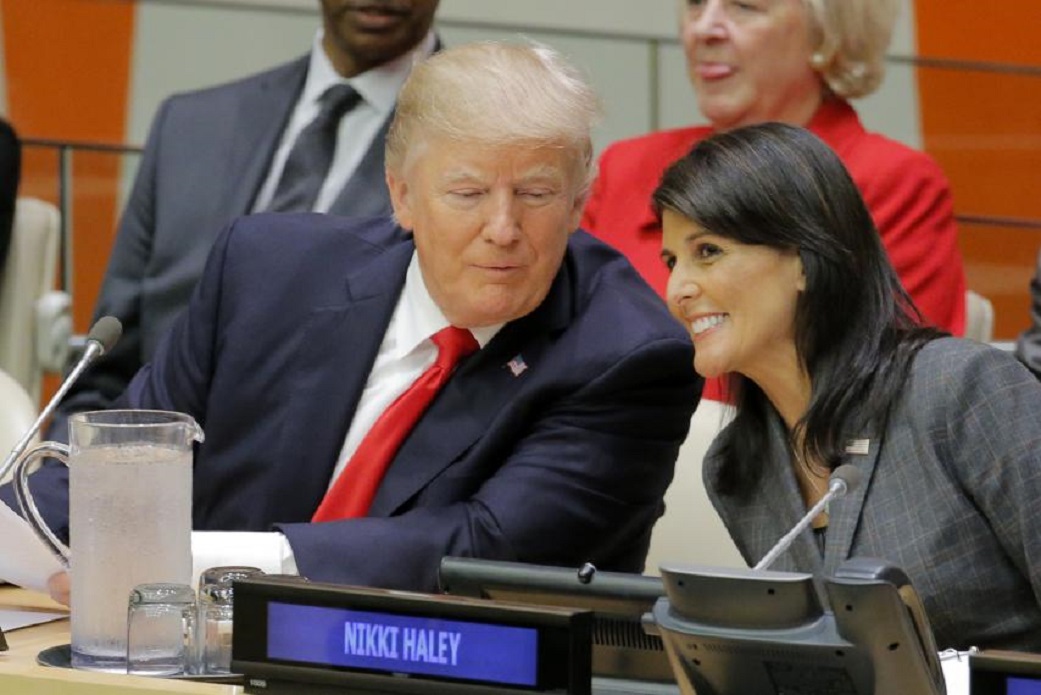 Does
it matter that a UN ambassador has no foreign policy experience? South
Carolina Governor Nikki Haley has been picked by President-elect Donald
Trump to be US envoy to the United Nations.Haley, the daughter of
Indian immigrants, was a vocal critic of the property mogul on the
campaign trail.The 45-year-old governor later voted for Trump,
lamenting that she was "not a fan" of either candidate.Mrs Haley was the
first minority and female governor of South Carolina, a deeply
conservative state with a long history of racial strife.
Does
it matter that a UN ambassador has no foreign policy experience? South
Carolina Governor Nikki Haley has been picked by President-elect Donald
Trump to be US envoy to the United Nations.Haley, the daughter of
Indian immigrants, was a vocal critic of the property mogul on the
campaign trail.The 45-year-old governor later voted for Trump,
lamenting that she was "not a fan" of either candidate.Mrs Haley was the
first minority and female governor of South Carolina, a deeply
conservative state with a long history of racial strife.
Trump announced on December 6 that he would recognise Jerusalem as Israel’s capital and move the US embassy there from Tel Aviv.Among the Gazans killed in the December 15 clashes. The UN’s human rights chief saying he was “truly shocked” demanding an “independent and impartial investigation”.Most of the world is not happy about Trump's decision to declare Jerusalem as the Israeli capital. But the U.S. ambassador to the U.N.Nikki Haley just doesn't want to hear it.Trump Cuts Funding to UN After Israel Vote
Trump's Jerusalem declaration sparks fear,US
President Trump’s December 6 announcement that he would break with
decades of American policy and move his embassy to Jerusalem has stirred
international condemnation, as well as protests across the Palestinian
territories and Arab world.Trump said the move was necessary for
achieving peace, casting it as a simple “recognition of reality” and
giving assurances that the decision was not a departure from the United
States’ commitment to facilitating peace talks in the Middle East.Some
supporters applauded Trump for doing what his predecessors did not. But
many Jews and Muslims alike expressed concern that the president’s
decision will spark violence in an already unstable region and threaten
the possibility of a two-state peaceful solution.Jerusalem is sacred to
three major religions. Trump’s move reverses 70 years of U.S. policy.
His power to move the embassy comes from a 1995 act passed by Congress
that recognized Jerusalem as Israel’s capital and said the U.S. embassy
must be moved there by 1999. But President Clinton used a waiver to
extend the life of the U.S. embassy in Tel Aviv by six months, and every
president since has done the same every six months. Now, the Trump
administration has said the president will sign the waiver for the next
six months, because moving the embassy will take several years.Haley
sent a letter around to all 193 members of the UN, warning that the US
is "taking names" of those who vote against the US's decision.U.S. ambassador to the U.N.Nikki Haley sent
a letter around to all 193 members of the UN, warning that the US is
"taking names" of those who vote against the US's decision. Ambassador
Haley threatened on Wednesday that Trump would be closely watching to
see who voted in favor of a UN resolution on Trump's Jerusalem decision.
It didn't work. None
of the countries that voted with the United States and Israel against
the resolution are diplomatic powerhouses Guatemala, Honduras, Togo and
the Pacific island states of Micronesia, the Marshall Islands, Nauru
and Palau. Among those voting in favor were Russia, China and several
U.S. allies, notably Britain, France, Germany, Italy, Greece, Japan and
Turkey. The abstaining nations included Canada, Mexico, Australia,
Colombia, Haiti, Poland and the Philippines.Despite the warning,
128 members voted on Thursday in favour of the resolution supporting the
longstanding international consensus that the status of Jerusalem
which is claimed as a capital by both Israel and the Palestinians can
only be settled as an agreed final issue in a peace deal. Countries
which voted for the resolution included major recipients of US aid such
as Egypt, Afghanistan and Iraq.Although
largely symbolic, the vote in emergency session of the world body had
been the focus of days of furious diplomacy by both the Trump
administration and Israel, including Trump’s threat to cut US funding to
countries that did not back the US recognition.But only nine states including the United States and Israel voted against the resolution.
 The 193-member United Nations General Assembly will hold a rare
emergency special session on Thursday at the request of Arab and Muslim
states on U.S. President Donald Trump’s decision to recognise Jerusalem
as Israel’s capital, sparking a warning from Washington that it will
“take name Outnumbered Over Jerusalem, Haley Tells World That US Will Be "Taking Names" During UN Vote"Trump regime exposes contempt for democracy through its threats against those who dare resist its thuggish demands at the UN.While
not quite as lopsided as predicted beforehand, the final result was a
clear condemnation of the Trump decision. Many diplomats were reportedly
unswayed by the vision of Trump as some kind of bizarro Santa Claus as
depicted in Haley's letter. The Canadian delegation actually reportedly
changed their vote from a "no" in support of the US to abstaining from
the vote.It didn't quite work.
The 193-member United Nations General Assembly will hold a rare
emergency special session on Thursday at the request of Arab and Muslim
states on U.S. President Donald Trump’s decision to recognise Jerusalem
as Israel’s capital, sparking a warning from Washington that it will
“take name Outnumbered Over Jerusalem, Haley Tells World That US Will Be "Taking Names" During UN Vote"Trump regime exposes contempt for democracy through its threats against those who dare resist its thuggish demands at the UN.While
not quite as lopsided as predicted beforehand, the final result was a
clear condemnation of the Trump decision. Many diplomats were reportedly
unswayed by the vision of Trump as some kind of bizarro Santa Claus as
depicted in Haley's letter. The Canadian delegation actually reportedly
changed their vote from a "no" in support of the US to abstaining from
the vote.It didn't quite work.
As United Nations members prepare for an emergency session to discuss the status of Jerusalem, President Donald Trump vowed on to cut aid to countries that vote against his decision to disregard international law and recognize the ancient city as the capitol of Israel."They take hundreds of millions of dollars and even billions of dollars, and then they vote against us," said Trump. "Well, we're watching those votes. Let them vote against us. We'll save a lot. We don't care."His remarks were met with condemnation by Amnesty International."Trump is doubling down on his reckless policies by coercing other countries into accepting his decision to recognize the unlawful annexation of East Jerusalem by Israel," said Raed Jarrar, the group's advocacy director for the Middle East. "The Trump administration’s bullying tactics will only serve to further isolate the United States on the global stage. Rather than threatening those who depend on U.S. aid, the Trump Administration should abide by its legal obligations not to recognize an illegal situation and reverse its course on Jerusalem."While support for the resolution was somewhat less than Palestinian officials had hoped, the meagre tally of just nine votes in support of the US and Israeli position was a serious diplomatic blow for Trump.Immediately after the vote the Palestinian president, Mahmoud Abbas, described the result as a “victory for Palestine”. The Palestinians’ UN envoy, Riyad Mansour, described the result as a “massive setback” for the US.“They made it about them,” Mansour told AFP. “They did not make it about Jerusalem, so when you make it about them and to only be able to get nine votes to say ‘no’ to it, I think it was a complete failure for their campaign.”GAZA CITY, Palestinian Territories: Palestinians were killed and hundreds wounded in violence with Israeli forces across the Palestinian territories, as tens of thousands of people joined new protests against Washington’s recognition of Jerusalem as Israel’s capital.Although its significance is purely symbolic, the resolution carries political resonance, particularly in the Middle East, where the U.S. decision has sparked protests and drawn condemnation from Arab governments. Underscoring the U.S. isolation on the issue, even many allies have publicly appealed to the administration to reverse its position and leave Jerusalem’s status undecided until Israelis and Palestinians negotiate terms.Palestinian killed , 82 wounded in Gaza clashes over Trump's Jerusalem ,by Israeli fire and dozens more wounded, along with an Israeli officer, in clashes across the West Bank and near Gaza's border. Which departed from decades of US policy that the fate of Jerusalem should be decided through negotiations, have yet to relent across various Arab and Muslim countries in the region.
AMERICAN AND ALLIES AIR STRIKES IN SYRIA WOULD DO NOTHING TO FURTHER JUSTICE FOR THE VICTIMS OF ATTACK ON DOUMA.THE SYRIAN REFUGEES HAS FLED WAR TO EUROPE (ESPECIALLY GERMANY) BECAUSE POLITICAL INSTABILITY IN SYRIA'S FIVE-YEAR CIVIL WAR ALONE DRIVEN 4,8 MILLION FROM THE COUNTRY.

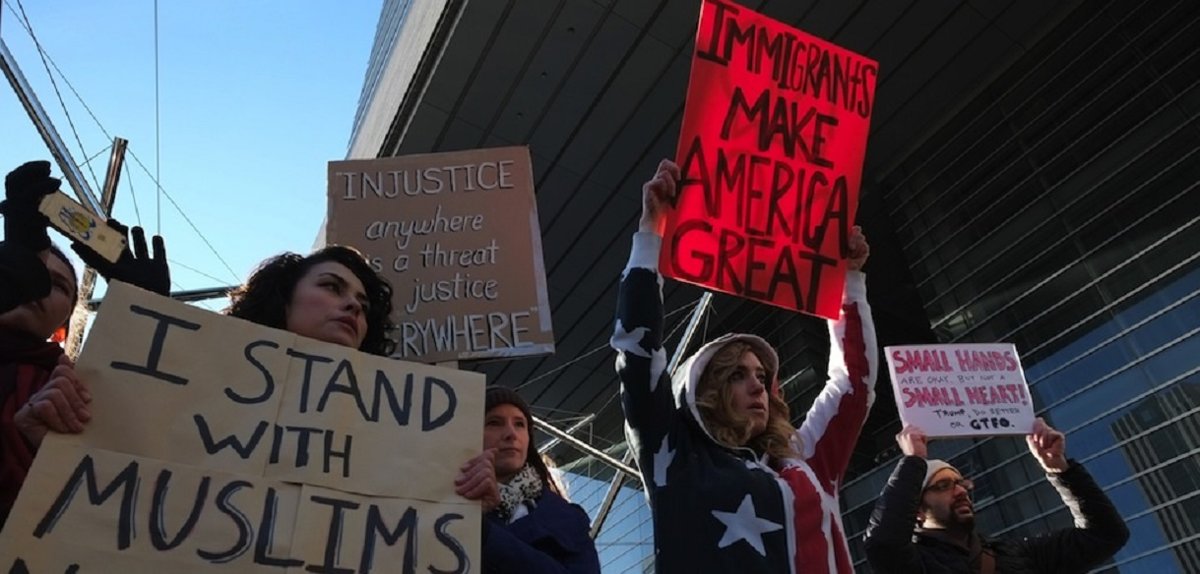
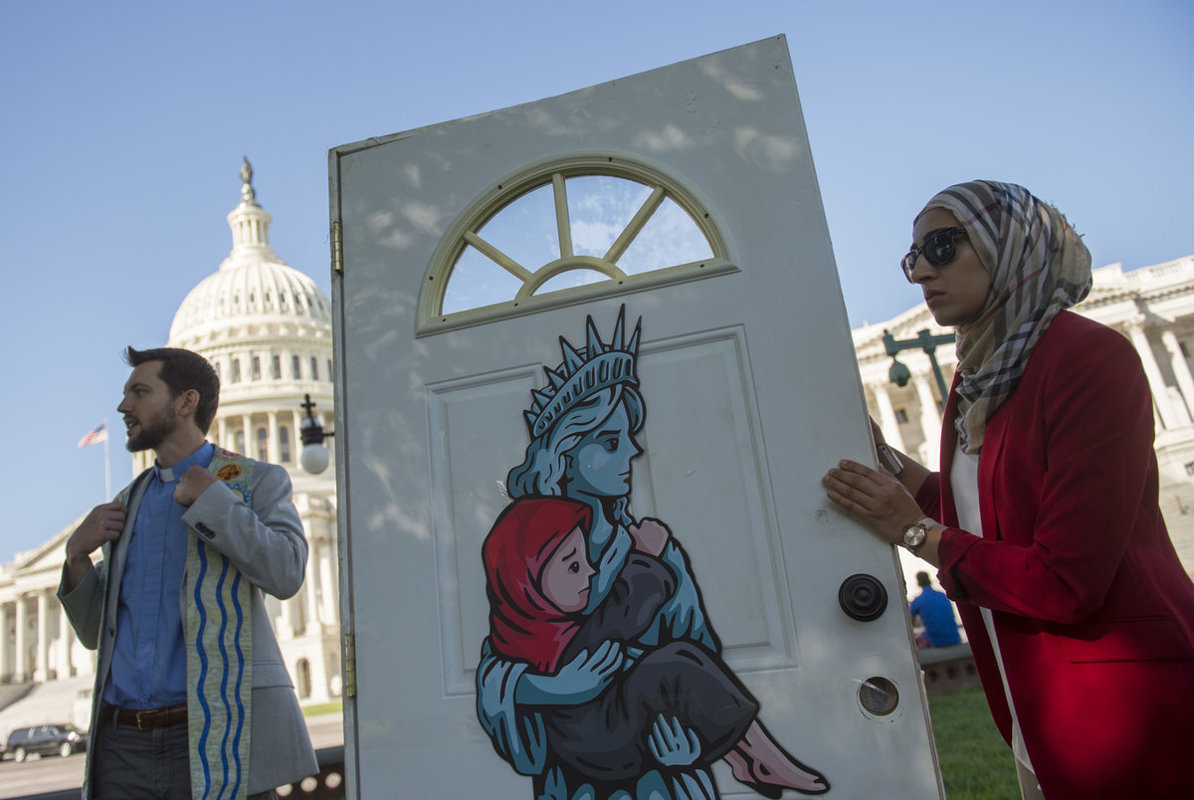 How the Trump administration has sabotaged America’s welcome,Trump signed three executive orders on January 23 last year which offend the dignity and threaten the rights of immigrants and refugees both in the United States and globally. On January 25 at the Department of Homeland Security (DHS), Trump signed executive orders on border security and interior enforcement. On January 27, he signed an executive order at the Pentagon on refugees and visa holders from designated nations.
How the Trump administration has sabotaged America’s welcome,Trump signed three executive orders on January 23 last year which offend the dignity and threaten the rights of immigrants and refugees both in the United States and globally. On January 25 at the Department of Homeland Security (DHS), Trump signed executive orders on border security and interior enforcement. On January 27, he signed an executive order at the Pentagon on refugees and visa holders from designated nations.
Trump’s campaign-era neo-isolationism is long over. He seems to want a war now, and if he can’t have one with North Korea because the pesky possibility of a diplomatic solution got in the way, Syria will do, and the recent alleged chemical-weapons attack by Bashar al-Assad’s army on the city of Douma, near Damascus, seems to have provided the pretext. But war with Syria means the potential for war with Iran, and even with nuclear-armed Russia so this is serious. And it’s not just talk. Trump has been assembling a war cabinet and recruiting security advisers John Bolton, Mike Pompeo, Gina Haspel known for choosing war over diplomacy and torture over international law. In many cases, Trump has an anti-immigrant rhetoric as well, as they accuse migrants of threatening the national identity of the country that receives them, abusing welfare benefits, and stealing jobs from locals.Trump has decided to allow the resettlement of no more than 45,000
refugees in the United States next year, according to a former and a
current U.S. official, ending months of contentious debate inside the
administration. That will bring the number of refugees allowed into the
United States to the lowest level since establishment of the
resettlement program in 1980.The Trump administration has so far declined to name the countries officially and publicly but two officials one from the administration and the other from an advocacy group separately confirmed that the countries were Egypt, Iran, Iraq, Libya, Mali, North Korea, Somalia, South Sudan, Sudan, Syria, and Yemen. All of those countries except North Korea and South Sudan are predominantly Muslim.They were also on the latest version of the administration's travel ban that was announced last month and is currently blocked by the courts. But that travel ban also included the citizens of Chad and Venezuela. Tuesday’s refugee list, on the other hand, included the citizens of Iraq, Mali, Sudan, South Sudan, and Egypt. The restrictions imposed last month were an outright ban on travelers but not refugees from those countries.In Syria, headlines tell us, America and its allies have all
but terminated ISIS’ misbegotten “caliphate.” Thus does triumph conceal
tragedy and shame.Recently, Donald Trump informed the
United Nations that – despite an unprecedented flood of refugees from
disaster – the United States would admit but few. Far better, he
asserted, to help them “in their home region.” This from a president who
would slash our budget for humanitarian assistance. But nothing better
dramatizes his comprehensive callousness than the people of Syria.
The country is a charnel house. Half the population needs humanitarian
aid simply to survive. Three million children are not attending school.
Life expectancy has cratered by 15 years. Nearly a half-million Syrians
have died; at least 1.5 million have been injured or disabled. Half of
all Syrians are displaced; over 5 million are refugees from horror.The long-awaited decision comes less than a week after Trump told the
United Nations General Assembly that the United States prefers to
prevent refugees from leaving their region and resettling in the United
States. It comes at a time when the ranks of the world’s refugees have swelled to more than 22 million, placing an enormous burden on countries from Bangladesh to Turkey.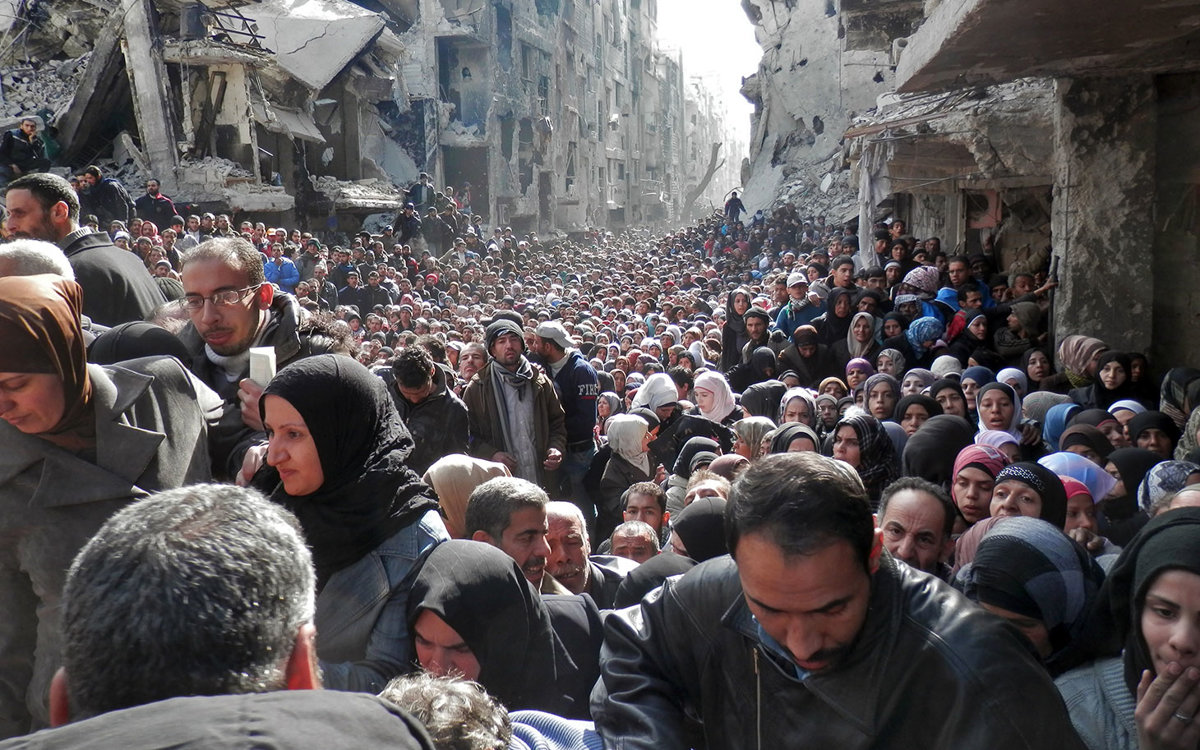
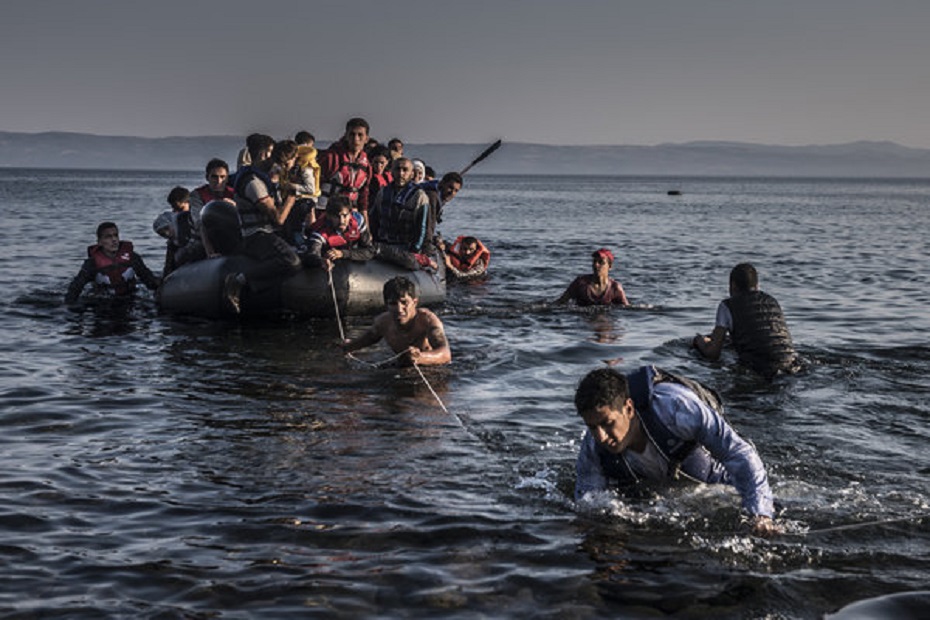
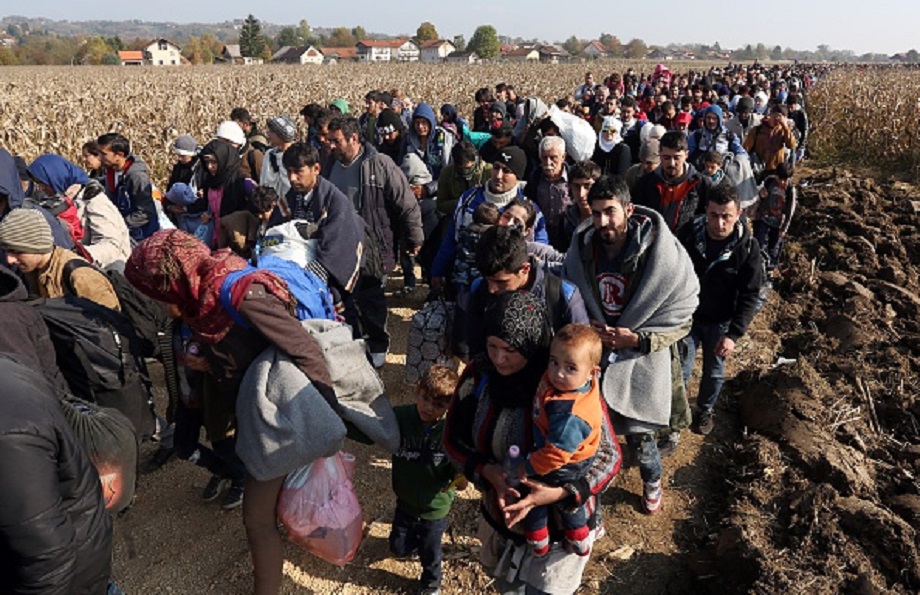
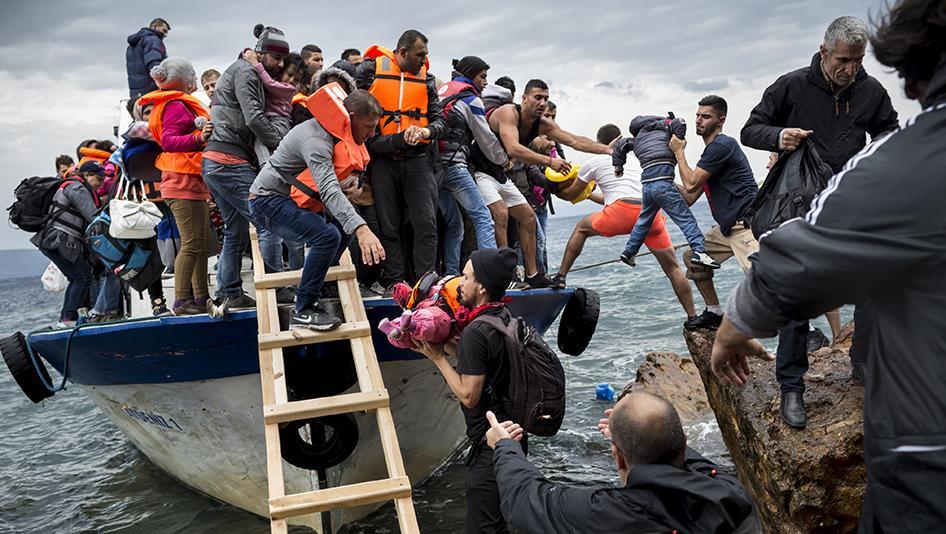 That this is not a matter of capacity or system but rather a crisis of politics and conscience is made clear by the fact that Europe is the largest economic unit in the world and has a population of about 500 million people and yet fails to manage the refugee crisis. It has many institutions and mechanisms to absorb any large number of refugees.Some European leaders and anti-immigration groups claim that EU countries should not accept refugees because the influx of refugees from Muslim countries will undermine Europe's Christian values. This is wrong both politically and morally.
That this is not a matter of capacity or system but rather a crisis of politics and conscience is made clear by the fact that Europe is the largest economic unit in the world and has a population of about 500 million people and yet fails to manage the refugee crisis. It has many institutions and mechanisms to absorb any large number of refugees.Some European leaders and anti-immigration groups claim that EU countries should not accept refugees because the influx of refugees from Muslim countries will undermine Europe's Christian values. This is wrong both politically and morally.
The flood of refugees entering Europe is endless. Nobody knows exactly how many there are and where they go and went. In 2015, estimates vary from the low of 750,000 to a high of 2 million. Most of them went to Germany, or want to go to Germany. Up to a million, perhaps more may end up in Germany by the end of this year. For 2016 predictions are for up to 2 million. They are the direct results of the Washington-NATO driven wars and conflicts in the Middle East which keep raging on; creating chaos. Complete deliberate and manmade chaos.One of the major international stories of the past several weeks has been the flood of refugees heading towards Europe to escape the civil war in Syria. On a daily basis, thousands of men, women, and children have made their way across the Meditteranean and to the shores of Europe, with vast numbers of them arriving in nations like Serbia and then trying to make their way to one of the nations that is part of the European Union. Many have not made it all, with overloaded boats capsizing while at sea, and other migrants reaching the shore only to die in the effort to get to land. For those who have made onshore, the reception has not always been welcoming. Many of the nations in which they have initially arrived have essentially transported to their border and sent them on their way. Hungary, which has received a large amount of the refugees trying to make their way to Germany and elsewhere, has begun imposing restrictions on migrants including erecting a border fence, which has proved futile in stemming the tide of migrants, and using tear gas and water cannons on refugees and government officials have demeaned the refugees by tossing food at them. Additionally, right-wing political leaders in the country have protested against the migrants and provided scenes such as the one the world saw earlier this month showing a Hungarian journalist linked to a right-wing outlet physically stomping on migrants as they tried to made their way through a border crossing. Hungary’s Prime Minister has said that the policies are designed to discourage the refugees from crossing into Hungary, and their seems to be little sympathy for them in the country. The migrant crisis has also led to calls for other nations to accept these war refugees, including the United States.The German Government has made a commitment to accept a comparatively extra-large contingent of refugees, to give them shelter, to feed them. But where and with what? This flood of refugees, ordered by Turkey at the tune of 2.5 million or more in camps with full infrastructure that have cost some 6 billion dollars to build not counting their maintenance and then let lose in huge hordes at the appropriate times, like now, in stormy fall weather, followed by harsh European winters, also by orders of the Dictator. He, in turn, is comfortably protected between two oceans, oblivious to the pain of far-away others – creating purposely more confusion, destabilization and havoc within the EU which has never really been a union, with or without refugees. The refugees are used as a weapon of destabilization.One by one of these un-solidary union members are pushing and shoving the stream of forced migrants, desperate hungry and sick people – on to the next country. Some build walls, or lock their borders with barbed wire fences, patrolled by armed police, military and vicious dogs. Sea-water or rain-soaked refugees are beaten, families pulled and pushed apart, dragged in the dirt. Police and military hatred and brutality in Serbia, Hungary the Czech Republic and others know no limits. Blood is flowing, small children in the arms of their hopeless and hapless parents crying, not understanding the cruel world they have been born into – and will have to endure. Misery for millions in a world where injustice is ever more becoming the order of the day. And we are blinded to it. Cohabitation with misery and injustice by millions has become the new normal.Refugees are becoming the new slaves. Many are highly educated, but poor, hungry and without shelter. Eastern European countries like Hungary and Poland have opposed an EU plan adopted in 2015 to take in 160,000 Syrian, Eritrean and Iraq asylum seekers from Greece and Italy.Poland's interior minister played down fresh warnings of European Union sanctions over Warsaw's refusal to accept migrants, saying accepting them would have been "worse" than the EU rebuke.
Europe is faced with its largest refugee crisis since World War II. Thousands of men, women and children from Syria, Somalia, Afghanistan, Eritrea, Libya and other places are risking their lives to find safety outside war zones. Close to 3,000 refugees have already died in the Mediterranean , trying to go to Europe. In contrast to the claims to the contrary, this is not a problem of capacity or system in the EU countries; this is a crisis of political leadership and consciousness.After much precious time lost, European leaders are finally stepping up to the table. German Chancellor Angela Merkel is leading the way to deal with the crisis. This move seems to be the least that the United States can do in response to this crisis. As it is, the fact that we have only taken in 1,500 Syrian refugees since the start of the civil war is atrociously absurd on a humanitarian level. Between them, Jordan, Lebanon, and Turkey have taken in some four million refugees in that same period. Germany has said it is prepared to accept as any as 800,000 refugees in the coming months and years on top of the roughly 3.5 million already in the country. When the government of Iceland announced that the island nation would take in 50 refugees, some 10,000 citizens signed a petition urging the government to do more, with many of the offering to put up refugees in their own home. It hasn’t been easy for many of these nations to accept refugees. Syria’s neighbors in particular have been overwhelmed with the rush of refugees and the United Nations has been brought in to help the situation. In some parts of Europe, such as Britain and France, there has been some resistance to taking in even small numbers of refugees. For the most part, though, many nations in Europe have stepped up to the plate to help these people, most of whom left Syria to avoid war and because the homes they lived have been destroyed by one side or another.All of these nations that have taken in refugees are smaller than the United States, some of them much smaller, and they have limited resources to house and help care for these people, but they have done it anyway. Given that, it seems clear that the United States can and should do much more to abide by its international obligations to help these war refugees. In some cases, that help can come in the form of material aid and personnel to assist nations in Europe with the processing and treatment of the refugees that have arrived in their borders. Beyond that, though, it seems clear that the United States needs to do its part to give these people a home, even if it just a temporary home until the war ends in their home country.
IRANIAN REGIME EXECUTED YOUNG AL AHWAZI ARABS,AND THE CRIMES AGAINST THEM.AHWAZI ARABS ARE AN ARAB NATIONALIST AND SEPARATIST WHOSE GOAL IS TO ESTABLISH AN INDEPENDENT STATE CALLED AHVAZ IN IRAN.
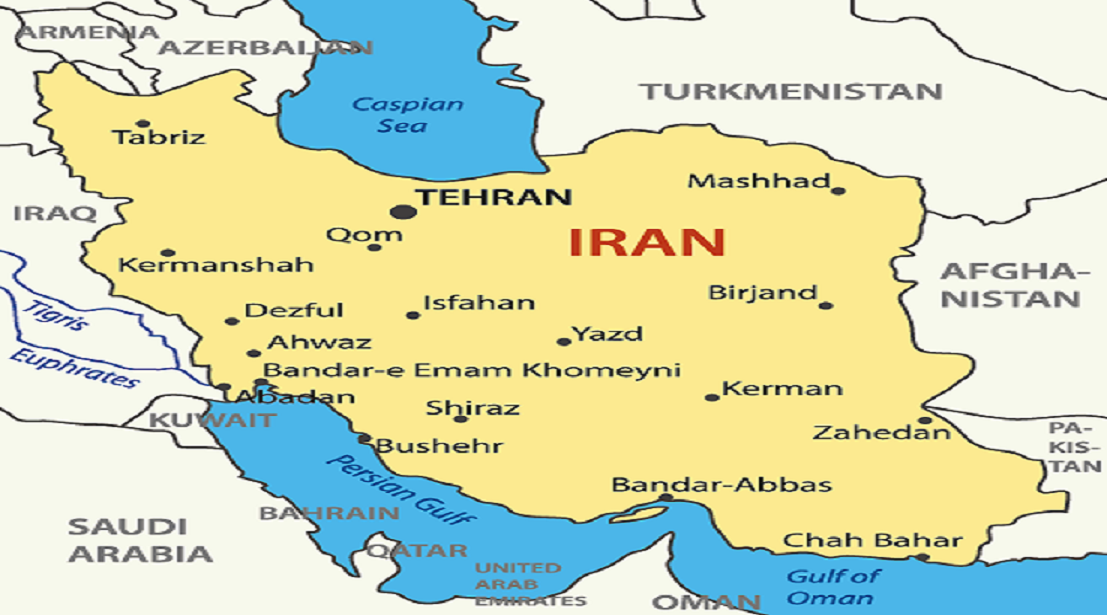 Since the Persian army entered Muhammarah City in 1925 in a bid to
remove the Al-Kaabi state and consolidate Iran's control on Ahwaz,
Iranian authorities have been pursuing a systematic policy to wipe out
the Arab identity of the Ahwazi Arab people. This policy includes
changing the demographics of the region by bringing in non-Arab people
and changing the Arab names of cities, towns and rivers, forcing Arab
Ahwazis out of the region through oppressive security measures and
continuous crack down on Ahwazi activists, and even buying the loyalty
of some Arab tribal leaders.
Since the Persian army entered Muhammarah City in 1925 in a bid to
remove the Al-Kaabi state and consolidate Iran's control on Ahwaz,
Iranian authorities have been pursuing a systematic policy to wipe out
the Arab identity of the Ahwazi Arab people. This policy includes
changing the demographics of the region by bringing in non-Arab people
and changing the Arab names of cities, towns and rivers, forcing Arab
Ahwazis out of the region through oppressive security measures and
continuous crack down on Ahwazi activists, and even buying the loyalty
of some Arab tribal leaders.
In 1925, the British had control of Ahwaz, known then as Arabistan renamed by Iran as Khuzestan after the colonialists bartered the Arab fertile land for interest in the rich oil and gas fields. Ahwaz, thirty-two times the size of Lebanon, had a population of 10 million made up of mostly Arab Sunnis and Shia with Christians, Kurds, Turkish Azeris, Turkmen and Baluchis minorities. Ninety years of Iranian oppression, murder, confiscating land and property, and building settlements for Farsi families have reduced the Ahwazi population to a half.Al-Ahwaz region of Iran is currently witnessing a wave of mass protests and demonstrations demanding freedom and an end to the Iranian regime’s multifaceted oppression of the Ahwazi people, which has been continuous since Iran first occupied the region by the use of military force.Ahwazi Arabs are among the most brutally oppressed peoples in the Middle East. The population of the region in the south and southwest of Iran totals around 10 million, with the people united by race, culture and language. The Ahwazi Arab dialect strongly resembles the dialect in neighboring Iraq. The majority of Ahwazis are Shia and Sunni Muslim, although there are other sects and creeds, including Christian and Mandaean.Ahwaz is a Persian-occupied Arab country located in the north and the east of the Arabian Gulf to the east of Shat Al-Arab waterway which has been occupied by Iran for more than eight decades and renamed ‘Khuzestan.’The entire territory of Ahwaz, covering 324,000 square kilometers, is bounded to the west by Iraq, to the south-west by the Arabian Gulf and Arabian Peninsula and to the north, east and south-east by the Zagros Mountains, the natural boundary between Ahwaz and Iran. With an Arab population of ten million, Ahwaz is among the most resource-rich territories occupied by Iran, holding more than 80 percent of the country’s oil and gas resources.The region has three major rivers, the Karoon, Jarrahi and Karkheh, which play a vital role in the lives of its people, with most Ahwazis long economically dependent on the three waterways for their income from both fishing and agriculture, with the waters used to irrigate the rich arable land.Historically the Semitic Elami tribes, the first known peoples of the Arabian Peninsula and Iraq, settled on Ahwaz’s riverbanks and valleys, establishing a great civilization, particularly the ancient city of Susa, now known as Shush.Since the initial annexation of Ahwaz by Iran, then known as Persia, 90 years ago, the humanitarian situation of the Ahwazi Arab people has steadily worsened, with the level of murderous repression by the current regime rising daily, extending to the level of systemic ethnic cleansing as policy, forcible eviction of the Ahwazi indigenous people, and the construction of exclusive apartheid-style settlements for non- Ahwazi, non-Arab settlers; these settlers are offered multiple economic and social incentives to move there and given guarantees of a promising future, while the Ahwazi Arab indigenous peoples are further marginalised, alienated and denied the most basic rights in every field.Historically the catastrophic suffering of the Ahwazi people first began after Reza Khan, the then-ruler of Persia, now called Iran, and invaded the Emirate of Al-Ahwaz in 1925, overthrowing the last independent Arab ruler of the region, Sheikh Khazaal Alkaabi, who was subsequently imprisoned in Tehran for 10 years before being murdered in 1936 by strangulation on the orders of Reza Khan.The current theocratic Iranian regime has imposed authoritarian rule on Al-Ahwaz region by the harshest measures, in a bid to isolate the Ahwazi Arab people from their origins and their historical association with the Arab nations, simultaneously imposing an absolute media blackout on any reporting of the suffering of Ahwazis.As is widely known, the Iranian regime provides no official statistics on the number of Ahwazi Arabs in Iran, but studies conducted by Ahwazi activists confirm that the current total Ahwazi population stands at between 8 and 10 million. American historian William Theodore Strunk in his work about Ahwaz: The Reign of Sheikh Khazal ibn Jabir and the Suppression of the Principality of Arabistan.


 Ahwazi Community in the UK demonstrated against the persecution of the Arabs by the
Iranian regime. Following the protest a group of Ahwazi activists.Abdulrahman Al-Ahwazi, from
the Patriotic Arab Democratic Movement in Al-Ahwaz, highlighted the
environmental crisis in the region which caused by building water dams
in the area of Al-ahwaz (Khuzestan). Al-Ahwazi stated that climate in
the province of Al-ahwaz is dependent on the main rivers such Karoun,
Karkheh and Jarrahi. The Iranian authority built more than 40 water
dams, and 36 are under construction while 176 are planned to be built in
future. Consequently, these dams led to dry international marshlands
such Fallahiya and Hur-alazim and disruption of biodiversity.
Ahwazi Community in the UK demonstrated against the persecution of the Arabs by the
Iranian regime. Following the protest a group of Ahwazi activists.Abdulrahman Al-Ahwazi, from
the Patriotic Arab Democratic Movement in Al-Ahwaz, highlighted the
environmental crisis in the region which caused by building water dams
in the area of Al-ahwaz (Khuzestan). Al-Ahwazi stated that climate in
the province of Al-ahwaz is dependent on the main rivers such Karoun,
Karkheh and Jarrahi. The Iranian authority built more than 40 water
dams, and 36 are under construction while 176 are planned to be built in
future. Consequently, these dams led to dry international marshlands
such Fallahiya and Hur-alazim and disruption of biodiversity.
Iran was the first to exercise gruesome apartheid. White Rulers (British descents) of South Africa rushed to the new found oppression college and enrolled thousands of potential terrorists and military personal. The Zionist Organization also had studiedapartheid curriculum in Iran, graduating with high grades and cloned the repressive college and established branches in Israel. Iran’s psychopath deans established institutions In Iraq, Syria, Yemen, Lebanon and other Gulf and North Africa countries. No one should wonder anymore which is the biggest terrorist state in the world. Since Khomeini’s 1979 Revolution, Iran has exercised the worse apartheid practices with intentions never to stop. Ahwaz territories hold 80% of Iran’s oil and gas;to the west of which is Iraq, and to the south-west is the Arabian Gulf and Arabian Peninsula; the Zagros Mountains to the north, east and south-east sit between Iran and the Arab territories. Ahwaz wealth didn’t just stop at oil and gas. It has the rich arable land; three major rivers, the Karoon, Jarrahi and Karkheh played a vital role in the livelihood of the people, provided agriculturally and fishing revenues until the apartheid regime redirected the three rivers to Iran’s territories. Only one percent of the oil and gas revenues returned to the indigents.Iran’s Mullahs blocked all possible world connection and communication with Ahwaz territories to mask the daily murderous repression. The ethnic cleansing policy routinely exercised by settlers, mullahs and soldiers; forcible eviction and bulldozing homes and properties go on like an endless marathon. The indigents live without clean water; electricity and food are scarce; most of them live in tents and water mains. World human rights and humanitarian organizations have said little and did little to expose the war crimes and crimes against humanity committed for 90 years and counting. The Arab neighbors of the same skin and language also have done little.If we compare Israel’s apartheid against Iran’s using skin burn gauge, the Israeli repression measures one degree; Iran’s gruesome repression means third degree.Historically, Ahwazis belong to Elami Arab tribes who settled in these vast Arab territories four thousands of years and established a high civilization in the ancient city Susa, now known Shush. In 639, Iran came under the Muslim Rule. Ahwaz changed hands between Arabs and Persians multiple times from the 15th century to the second half of the nineteen century.Pre-Islamic Iran’s art, education, literature, poetry and philosophy stayed at particle progress. Under the Islamic Rule, the country embraced Arabic language for 200 hundred years, putting the Farsi language on hold. Iran saw a notable surge of great thinkers, philosophers, scholars, poets and writers. Most people don’t know that the works of these great minds were all produced in Arabic and continued beyond the two hundred years. The present regime in Iran denies these facts. Their curriculum, media and propaganda mullahs credit Iran for all Arab progress before and during the Islamic Rule. Iran has gone as far as forging the principles of Islam, classifying all Arabs and Sunnis infidels. Ancient Persia incubated hatred and venom against Arabs; the Romans carried the great terror for centuries; then the West expanded wars to reach the region and are still doing it. Zionism is the latest by-product that had nurtured and raised traitors like Assad family, the Iraqi and Houthi Mullahs; it also nurtured and raised Sunni, Shia and Christian collaborators. These traitors remain far worse than land mines.The region where the Ahwazi Arab community is most present in Iran has been troubled by a deep economic crisis that has hindered its indigenous Arab population from securing its most basic needs.Until a century ago, Arab Ahwaz was a primarily autonomous region in Iran until the Pahlavi monarchy took over and made an effort to end ethnic autonomy across Iran in 1925. The Ahwaz region is responsible for some of Iran's biggest oil and gas fields, and some of the most nourishing and arable lands for Iran's agricultural industry. Despite these valuable resources, the region's economy continues to struggle, and the indigenous population see little of the rewards of this wealth. They are often the victims of untreated illness, hunger and deprivation.The Iranian regime systematically denies Ahwazi Arabs jobs in the local oil, gas and petrochemical industries. The government has also constructed a multitude of dams diverting water from Arab areas to Persian areas such as the Isfahan, Yazd, Kerman, and Qom provinces. These dams have only served to worsen the devastation from a drought currently plaguing the region, destroying the local agriculture, fishing, and palm industries.The unemployment rate among the Ahwazi Arab youth has now risen to 81%. Iran's general director of cooperatives, work, and social welfare, stated that 5% of Ahwazis looking for jobs have pre-high school education, 55% of those seeking work only completed secondary school, and 45% of those Ahwazi job seekers hold university degrees.The
Ahwazi quest for independence remains a source of growing concern for
the Iranian regime because of the ethnic diversity of the country where,
in addition to Arabs, the mosaic includes Persians, Azeris, Kurds and
Baluchs and others. Each of these ethnic groups retain their own
traditions and culture that have extensions beyond the Iranian border.
In addition, several organizations are seeking to restore the national
gains that these ethnic groups lost in different historical eras,
including the Arab national identity of Ahwaz where relevant
organizations run active political arms beyond the control of the
Iranian regime. The activity of these organizations are well-received by
human rights groups interested in championing the causes of minorities
suffering oppression in home countries.Iran's
concern emanates from the fact that raising such issues negatively
impacts the stability of the state, its unity and territorial integrity.
The continuity of the Ahwazi movement and difficulties hindering the
Iranian regime's attempt for suppression will tempt other ethnicities to
follow suit. This is particularly important because the state in Iran
used to praise the "Islamic" revolutionary regime for its stability,
strength and ability to assimilate and accommodate for all the country's
ethnicities, despite the fact that such events and their aftermath
stand in stark contrast with the claims that the Iranian regime is
attempting to promote.This
is being further affirmed by senior Iranian officials. These officials
blame the interference of Iran's foreign enemies for instigating ethnic
strife as part of "conspiracy theory" mantra that the Iranians are good
at promoting whenever they seek to mobilize the support of the crowds
for the regime on the pretext that the state is facing external threats
to its very existence.This
was made clear by a special adviser to Supreme Leader Ayatollah Ali
Khamenei during a press conference on 9 May 2015 in Tehran. Major
General Yahya Rahim Safavi accused "17 regional and trans-regional
intelligence services affiliated to the Arab and western states” of
running operations “in support of ethnic separatist groups to sow
discord among the local people” in the south-western province of
Khuzestan (Ahwaz). The top Iranian military aide expressed his concern
that the ongoing war in Syria and Iraq would spill over to "Khuzestan"
endangering the territorial integrity of Iran. On 2 September 2014, Imam of Ahwaz city, Ahmed Reza Hajati, stressed that 35
intelligence services run operations in the province. The cleric's
claims show how concerned the Iranian regime is about any movement in
this region (Ahwaz), and also show that its concerns are persistent and
not associated with a particular happening.
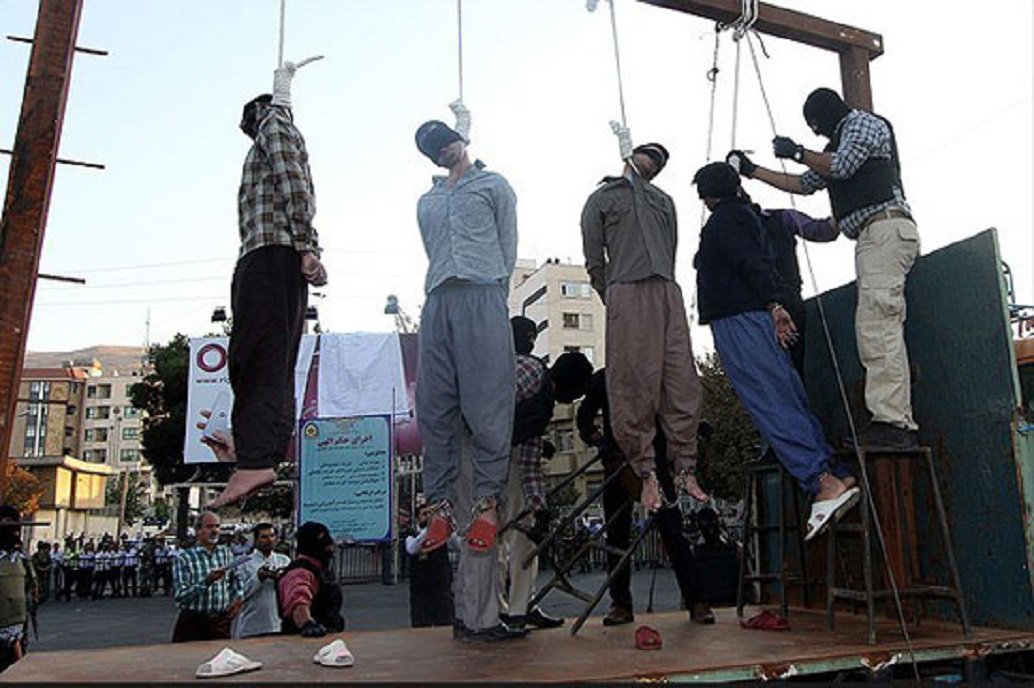 After trials human right activists described as grossly unfair Iran has executed members of its Ahwazi Arab minority."The Iranian authority informed their families that they were executed by hanging and in secret ... The AHRO condemns this criminal act against these activists who did not have fair trial.Ahwazi Arabs in Iran often face state discrimination in areas including education, employment politics and culture. In recent years, many members of the community have taken to the streets to protest at the discrimination against them.
After trials human right activists described as grossly unfair Iran has executed members of its Ahwazi Arab minority."The Iranian authority informed their families that they were executed by hanging and in secret ... The AHRO condemns this criminal act against these activists who did not have fair trial.Ahwazi Arabs in Iran often face state discrimination in areas including education, employment politics and culture. In recent years, many members of the community have taken to the streets to protest at the discrimination against them.
ROHINGYA CRISIS: DEMOCRACY DOESN'T WORK IN MYANMAR, THE MILITARY - BACKED LAWMAKERS ARE CASTIGATING THE COMMISSION AS AN AFFRONT TO THE CITIZENRY,CLAIMING THAT IT IGNORES THE SOVEREIGNTY OF THE STATE.WHAT HAS HAPPENED TO HUMANITY ICON AUNG SUN KYI OF MORALITY?
 Aung San Suu Kyi has been under fire internationally for her public silence about a military crackdown in Myanmar’s Rakhine state that has seen nearly 700,000 of the Muslim Rohingya minority flee to Bangladesh.
Aung San Suu Kyi has been under fire internationally for her public silence about a military crackdown in Myanmar’s Rakhine state that has seen nearly 700,000 of the Muslim Rohingya minority flee to Bangladesh.
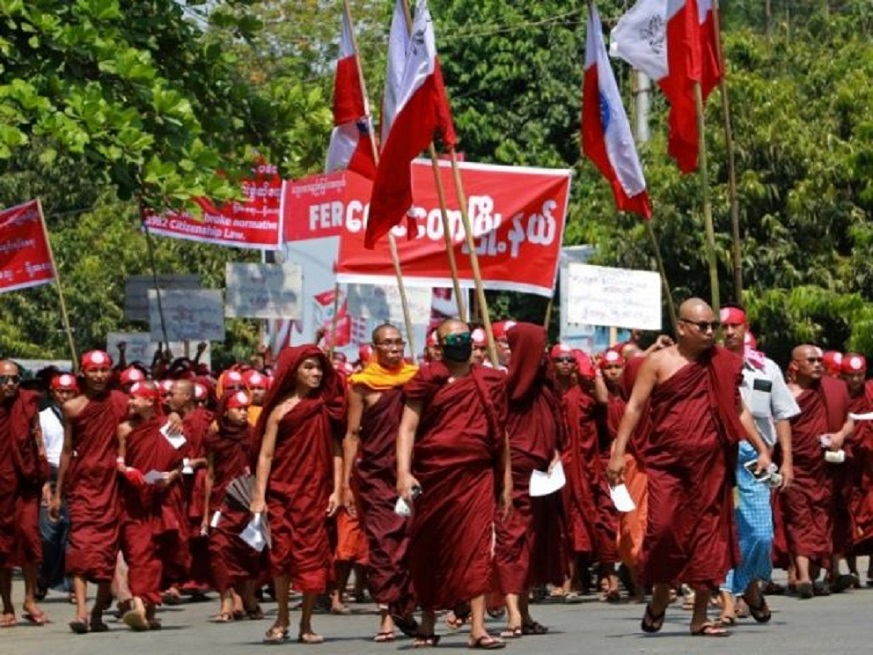
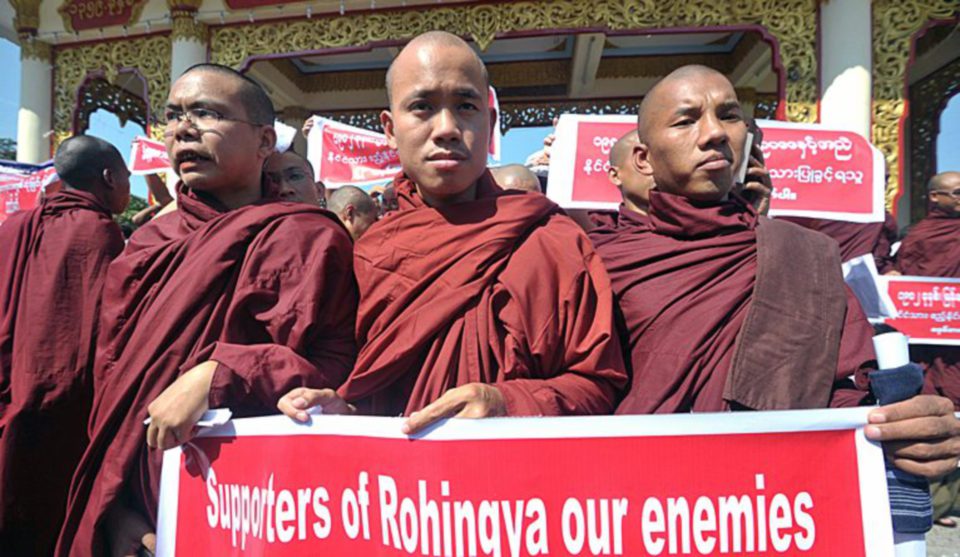
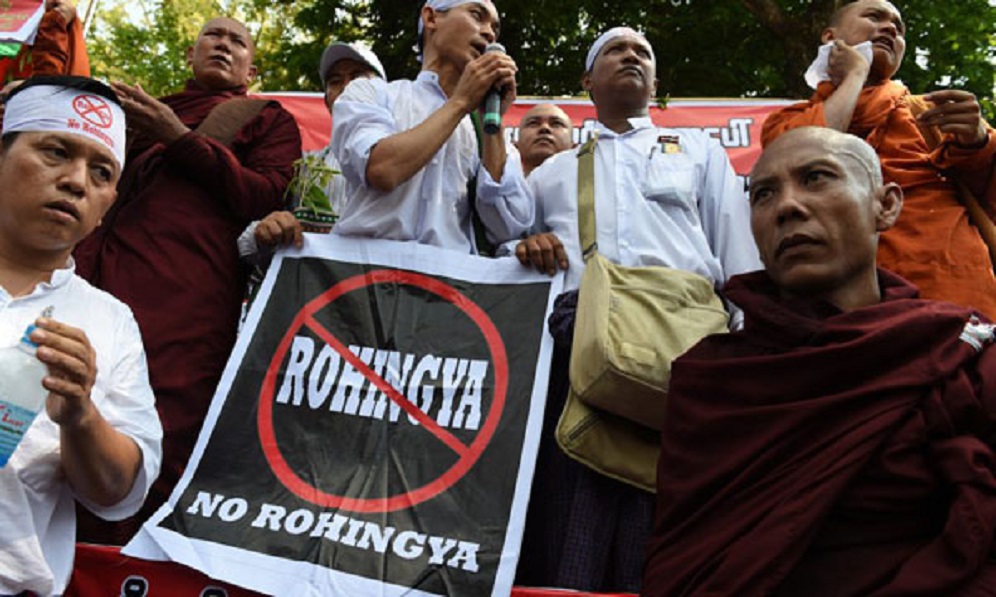 The leader of the Buddhist atrocities is Buddhist monk Ashin Wirathu, who says that he is just trying to protect Burma from Muslims. He calls his movement the “969” movement, where 969 is a historic Buddhist sign, referring to the nine qualities of Buddha, the six qualities of Buddha’s teaching, and nine qualities of the Buddhist community. 969 is supposed to promote peace and happiness, although Wirathu’s 969 movement is a vehicle promoting violences.
The leader of the Buddhist atrocities is Buddhist monk Ashin Wirathu, who says that he is just trying to protect Burma from Muslims. He calls his movement the “969” movement, where 969 is a historic Buddhist sign, referring to the nine qualities of Buddha, the six qualities of Buddha’s teaching, and nine qualities of the Buddhist community. 969 is supposed to promote peace and happiness, although Wirathu’s 969 movement is a vehicle promoting violences.
How do we respond to another genocide in the 21st century? First, we witness. Then, we act in solidarity. Solidarity requires our government to recognize this as genocide.The Rohingya are a largely Muslim ethnic minority in Myanmar at the center of a humanitarian catastrophe. But the Myanmar government won’t even use the word “Rohingya,” let alone admit they’re being persecuted. Instead, the government calls them Bengalis, foreigners, or worse, terrorists.This difference between these two terms Rohingya and Bengali is crucial to understanding the crisis unfolding in Myanmar, where more than 500,000 Rohingya have recently fled following a government crackdown and which has been called a “textbook example” of ethnic cleansing by the top United Nations human-rights official. Many of those ended up sheltering in makeshift camps in Bangladesh, telling tales of the killings, rape, and massacres.Before the massacres, there were thought to be around 1.1 million Rohingya living in the country. The Rohingya have existed in Myanmar a Buddhist majority country for centuries. It was known as Burma under British colonial rule (from 1824-1948) and there was significant migration between today’s Myanmar, India, and Bangladesh. Once Burma won independence in 1945, the government passed the Union Citizenship Act , which detailed the ethnicities “indigenous” to Myanmar. The Rohingya were not considered to be one of the country’s 135 official ethnic groups.That said, the Rohingya were able to carve a place for themselves in newly independent Burma; with some serving in parliament and other high offices. And their ethnicity was included in the 1961 census.The situation quickly deteriorated for the Rohingya, however, following the 1962 military coup, when the government driven by Bamar-supremacist ideology (paywall) gave fewer official documentation to the Rohingya and refused to fully recognize new generations of the Rohingya population. In 1974, all citizens in Burma were required to get national registration cards, but the Rohingya were only allowed to obtain foreign registration cards.By 1982, a new citizenship law was passed that prevented Rohingya from easily accessing full citizenship, rendering many of them stateless. In 1989, the country was renamed Myanmar.It’s not just the Rohingya, outbreaks of violence have affected non-Rohingya Muslims across Myanmar. Certain extremist monks have intensified the Islamophobic rhetoric in the country, claiming Myanmar’s dominant Buddhist faith is under threat from Muslims (pointing to Afghanistan and Indonesia as examples). These monks were crucial in passing “race and religion” laws that targeted Muslims and attempted to stem their population growth.In 2009, the Rohingya as “probably the most friendless people in the world” and it’s easy to see why. In 2015, the plight of the Rohingya was brought to the forefront when boats packed with Rohingya migrants were left stranded at sea. The Rohingya collectively dubbed across international media as “boat people”were stuck because they were turned away from a number of Southeast Asian countries, including Malaysia, Indonesia, and Thailand. Unwanted in Myanmar, the Rohingya are also often rejected from the countries they hope to flee to.Since the late 1970s, nearly one million Rohingya are estimated to have fled Myanmar. The demand, in a statement issued on November 28, said a meeting of the NDSC was needed because the crises had put the country’s territorial sovereignty was at stake.It is hardly a secret that the ruling National League for Democracy and an overwhelming majority of the people do not like the 2008 Constitution, which provides for the military to hold 25 percent of hluttaw seats and a majority on the 11-member NDSC. The NLD had promised to amend the constitution if it was elected.Section 417 of the constitution provides for the President to convene a meeting of the NDSC and order a national state of emergency if the Union faces potential disintegration or loss of sovereignty through violence. The NDSC comprises five senior military officers and six civilians, including President U Htin Kyaw and Daw Aung San Suu Kyi, in her capacity as foreign minister.However, the civilian cohort includes the vice presidents, one of whom is nominated by the military, giving the armed forces an effective majority. The NDSC holds legislative, executive and judicial powers during a state of emergency.Why did the 13 parties issue their statement calling for a meeting of the NDSC? Is the NLD government able to overcome the problems described in the statement? Is it probable that the Tatmadaw would try to return to the political stage? The 13 parties said a meeting of the NDSC was needed because the country was facing a crisis over the security situation in Rakhine and the fighting in northeastern Shan State. Their statement said the country’s territorial situation was at stake because of the situation in Rakhine. In Shan, the fighting between the Tatmadaw and the Kachin Independence Army, Ta’ang National Liberation Army, Myanmar National Democratic Alliance Army and Arakan Army has resulted in death and destruction and disrupted trade with China.The security operation in northern Rakhine began after Muslim militants attacked Border Guard Police posts in early October, leaving nine officers dead and seizing arms and ammunition. However, the attackers were armed only with swords and sticks, not with modern weapons.Bangladesh deserves praise for its response to the situation across the border in Rakhine. It has not interfered in Myanmar’s affairs and has cooperated in a good-neighbourly way. It has handed over militants and has promised it will never allow its territory to be used as a base for attacks against Myanmar. The cooperation from Bangladesh will help the Tatmadaw in its operation to restore peace and security to northern Rakhine sooner or later.In northeastern Shan, the KIA and its Northern Brotherhood allies said they launched their attacks in Muse and Kutkai townships to draw attention to recent “pressure” from the Tatmadaw. Although the Tatmadaw suffered casualties, there was no move by the Northern Brotherhood to seize towns or villages.The main objective of the attacks was to disrupt border trade and the movement of the people. The Tatmadaw is meeting its responsibility to restore law and order in the affected area. Myanmar is not in danger, or even on the brink of danger.State Counsellor Aung San Suu Kyi and Tatmadaw Commander-in-Chief Senior General Min Aung Hlaing meet occasionally, when the circumstances require it. The ministers of defence, home affairs and border affairs, all of whom are military officers and members of the NDSC, are consulted during cabinet meetings.Section 213(a) of the constitution says that the President has the right to take military action, in coordination with the NDSC, in the event of aggression against Myanmar.It is within the authority of the President to call a meeting of the NDSC. However, there is no need to do so at the moment. Myanmar is not being invaded and government ministers who are members of the NDSC, as well as senior members of the Tatmadaw, are closely following and discussing the national situation.The USDP is the creation of military dictators. A USDP government, comprised of former generals, led by President U Thein Sein and created by former dictator Senior General Than Shwe, took power in 2011 under the terms of the military-drafted 2008 Constitution.The NLD landslide in the 2015 delivered a humiliating defeat to the USDP and most of the other 12 parties that signed the statement. Could it be that in criticising the NLD government’s handling of the crises in Rakhine and northeastern Shan, and calling for a meeting of the NDSC, the USDP-led group is hoping for a U-turn to a military government? Is it possible that they want to reverse history and take Myanmar back to dictatorship?

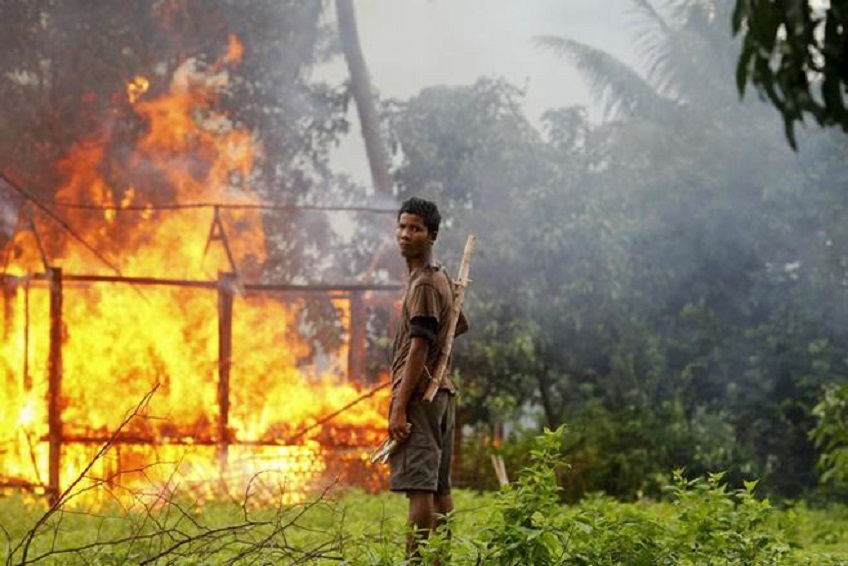
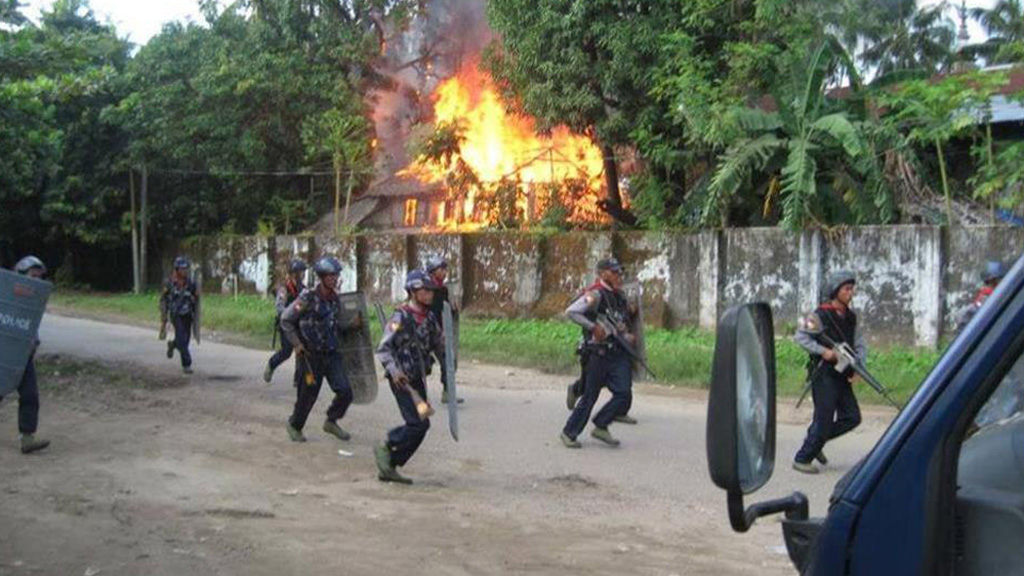
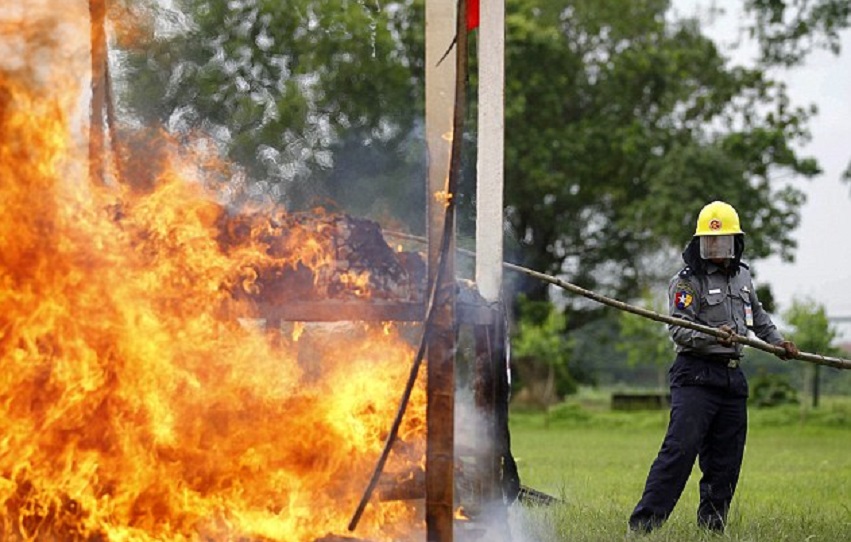 Rohingya Muslims flee as more than 2,600 houses burned in Myanmar’s Rakhine.The treatment of Myanmar's roughly 1.1 million Rohingya is the biggest challenge facing leader Aung San Suu Kyi, accused by Western critics of not speaking out for the Muslim minority that has long complained of persecution.
Rohingya Muslims flee as more than 2,600 houses burned in Myanmar’s Rakhine.The treatment of Myanmar's roughly 1.1 million Rohingya is the biggest challenge facing leader Aung San Suu Kyi, accused by Western critics of not speaking out for the Muslim minority that has long complained of persecution.
In the Burmese government’s rendition, the Burmese military-led murders, gang rapings, and village burnings which have led to more than 600,000 Rohingya fleeing to neighbouring Bangladesh were simply a retaliation for ARSA’s (Arakan Rohingya Salvation Army) attacks on military outposts .This is a diverting tactic that is meant to turn the international community’s attention away from the fact the Rohingya have been facing genocide for decades. Denied citizenship since 1982 in a land they have called home for centuries, the Rohingya have had little to no access to basic human rights, such as education and health care.The Burmese military cut off her breast. Then they stabbed her in the abdomen so many times her nari bhoori (intestines) could be seen. Then they stabbed her over and over again in the vagina,” the woman said quietly, as tears silently streamed down her face, referring to her neighbour.Under British colonial rule, the country’s Burmese-speaking majority population was largely excluded from middle-ranking and senior civil service roles. Indeed Indians and colonial Britons imported from the Indian sub-continent were recruited to the civil service while members of Burma’s many ethnic minorities made up much of the police and the army.One reason for this was that, although Burma formed part of British India, its Burmese-speaking heartland was one of the last regions to be conquered and incorporated into the Raj.Consequently it had far fewer western-educated, English-speaking inhabitants than India. Also, the Depression of the 1930s destroyed the embryonic Burmese middle class – the class that would otherwise have laid the foundations of civil society.Another factor behind the military’s strength is the Burmese nationalist fear of the disintegration of the country. In the 17th–19th centuries, prior to the British conquest, the kings of the Burmese-speaking lowland region had expanded the size of their state by assuming at least nominal control over vast areas of non-Burmese-speaking territory.Indeed, as a direct result of that process, around two-thirds of Burmese territory is still inhabited by non-Burmese native-speaking minorities who account for around a third of Burma’s total population.There are dozens of separate ethno-linguistic minorities in Burma – the largest being the five million-strong Shan, the four-million strong Karen, the two-million strong Arakanese and the Mon, Chin, Karenni and Kachin peoples.Nationalist fears of the disintegration of the country have been bolstered by numerous ethnic minority armed insurgencies, two of which (the Karen and Shan revolts) continue today. Immediately post-independence, the Burmese government faced more than a dozen armed rebellions and even today the central government’s writ does not run in around five to 10 per cent of Burma’s territory.Nationalist fear of the disintegration of the Burmese state is integrally linked with a parallel fear of foreign intervention – a fear that has generated an unusually high level of xenophobia among the military.Certainly Burma has suffered a substantial number of foreign invasions and conspiracies – from the Chinese invasions of the 1760s through to the three Anglo-Burmese wars of the 19th century, Japan’s refusal to allow genuine independence (1943–45).In addition to all these historically-driven factors, military dictatorship has benefited from Burma’s ancient tradition of political deference. Many scholars see this as stemming, at least in part, from the Buddhist belief that political power (or indeed any other form of personal success) is a direct consequence of merit gained in previous lives. It is a form of meritocracy where karmic merit is ‘inherited’ through reincarnation.Today, with the military having yielded some powers to an elected government, Myawady Sayadaw peppers his sermons with references to human rights and interfaith understanding. But when it comes to Myanmar's most explosive political issue the army-led purging of Rohingya Muslims the outspoken monk becomes taciturn.Buddha loves all people and teaches us to try to resolve suffering, but we have a duty to protect our country at the same time.Democracy can be a messy business. Liberal democratic reforms often bring new freedoms and allow for the opening up of civil societies. But the freedoms that come with the transition from dictatorship to democracy not only empower the oppressed and marginalized, they also allow for new forms of repressions in the forms of resurgent nationalisms, xenophobia and hate speech masquerading as free speech. For transitioning states, liberal democracy comes with the good, the bad and the ugly. The real challenge is how to manage the contradictory freedoms that democracy unleashes.The government of Myanmar under the leadership (even if nominal) of Nobel Peace laureate and democracy icon Aung San Suu Kyi has been involved in the systematic ethnic cleansing of the minority Muslim Rohingya population. Under the excuse of cracking down on insurgents in the western Rakhine state, Myanmar’s military and security forces have engaged in rapes, killings and house burnings that have driven thousands of Rohingya from their homes into neighbouring Bangladesh. Human rights organisations have reported mass atrocities that match the violations which the country witnessed under decades of repressive military dictatorships.So, here is the question: Wasn’t the transition to democracy and the ascension to power of the peace and democracy icon, Aung San Suu Kyi, supposed to usher in an era of freedom and civil liberties in Myanmar? Evidently it hasn’t. What we see in Myanmar is the classic paradox of democratic transition.One the perverse consequences of democracy in Myanmar is that it has unleashed old antagonisms against the Rohingya Muslims, many of whom migrated to Myanmar (then Burma) when the country was ruled by the British colonists as part of greater India. Although some Rohingya were resident in the country long before colonial rule, they have largely been seen as foreigners. Separatist insurgency in the region reinforced suspicion of the Rohingya.The interesting point here is that the military dictatorship that ruled Myanmar for much of its history keep things in check. Democratic reforms, beginning with a Constitutional referendum in 2008, unleashed long repressed grievances and animosities. Part of the result is the human tragedy that we see in the country today.This paradox of democratic transition is evident elsewhere - in Iraq and in the Arab Spring revolutions, from Egypt to Libya. Democracy brings freedoms and opens up civil socisteies. But it also frees up repressed grievances and ignites new conflicts. Without the strong hand of dictatorships to rein these in, they can quickly engulf transitioning states which typically have weak institutions and democratic cultures. The lesson of Myanmar is not the failure of liberal democratic transition. It is a lack of recognition of, and preparedness for the powerful reactionary and exclusionary forces that are also unleased by democratic reforms.
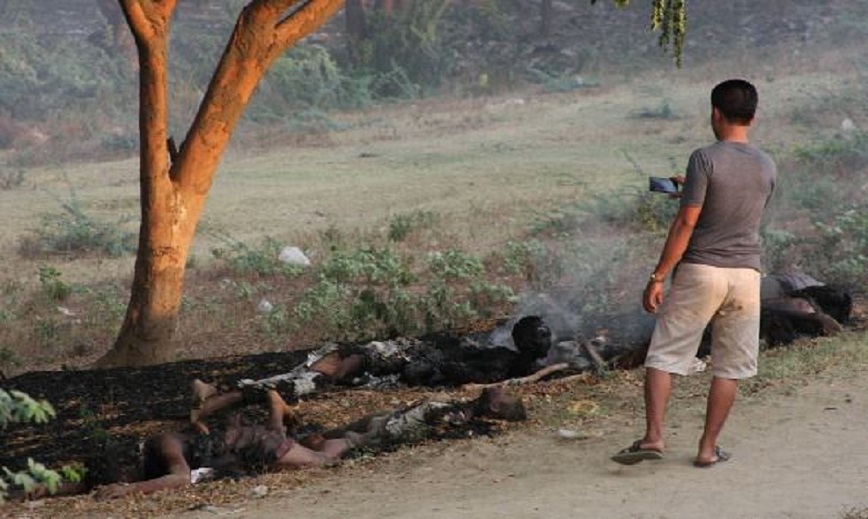
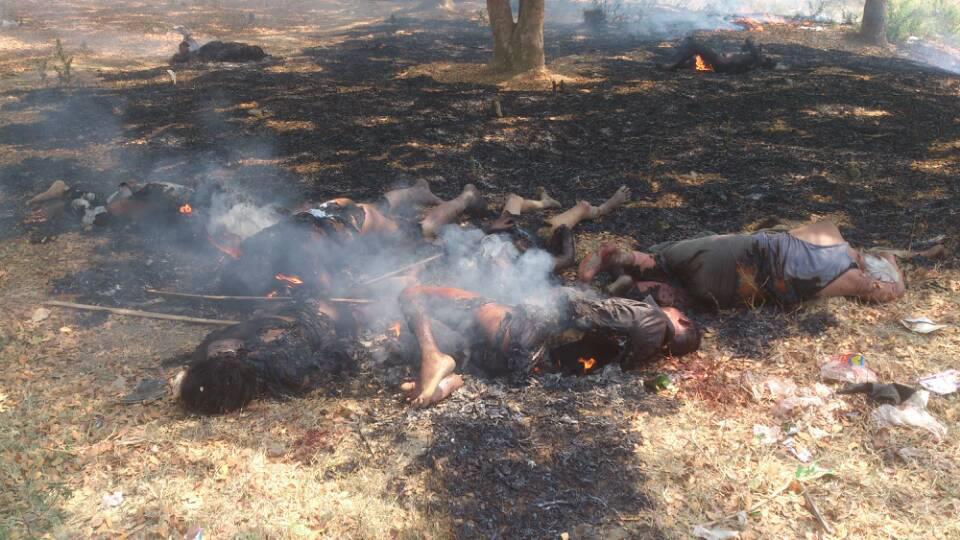
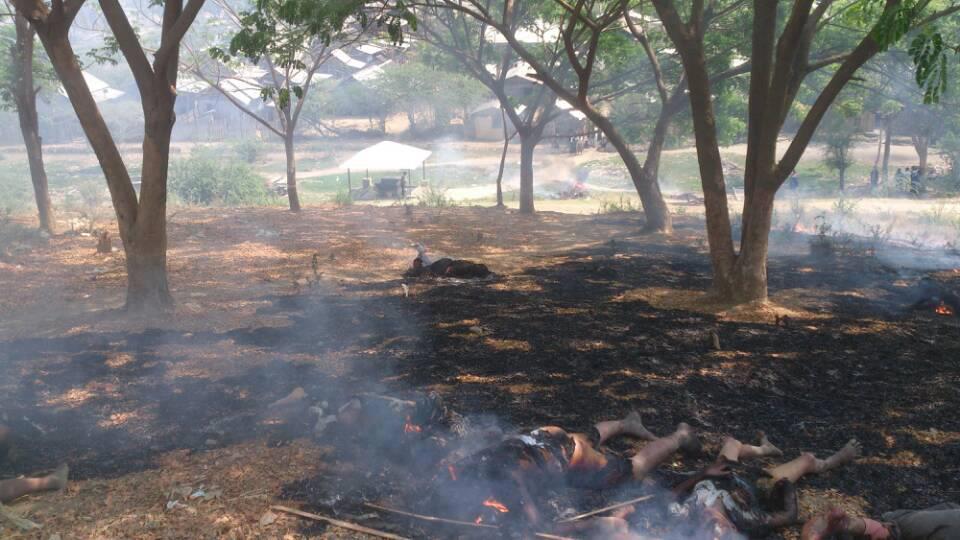 Myanmar’s army is burning down villages and shooting Rohingya Muslim civilians as part of an alleged crackdown on insurgents in the Muslim-majority Rakhine state, witnesses have said.Understanding the Rohingya genocide, and Aung San Suu Kyi's deadly silence.The Paradox of Democracy in Aung San Suu Kyi’s Myanmar.
Myanmar’s army is burning down villages and shooting Rohingya Muslim civilians as part of an alleged crackdown on insurgents in the Muslim-majority Rakhine state, witnesses have said.Understanding the Rohingya genocide, and Aung San Suu Kyi's deadly silence.The Paradox of Democracy in Aung San Suu Kyi’s Myanmar.
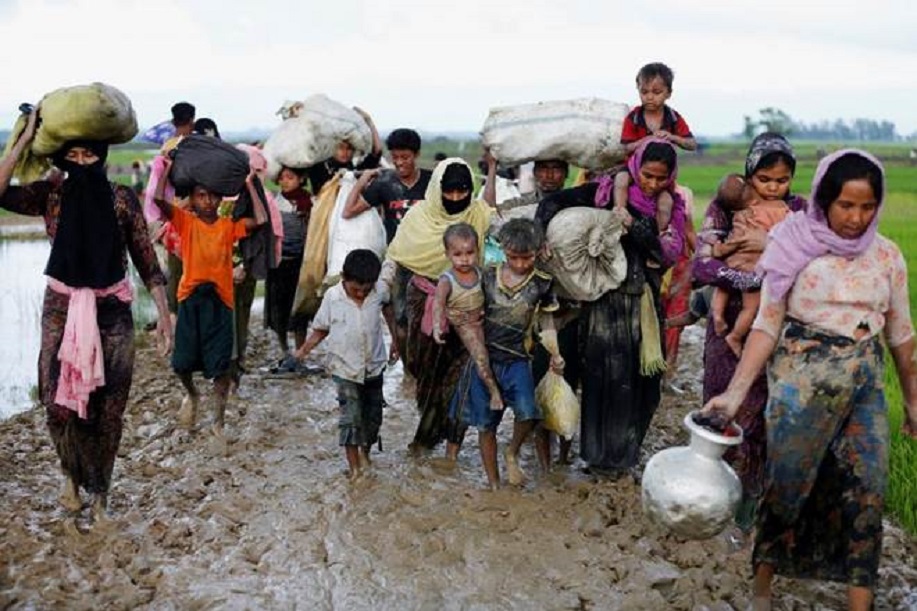
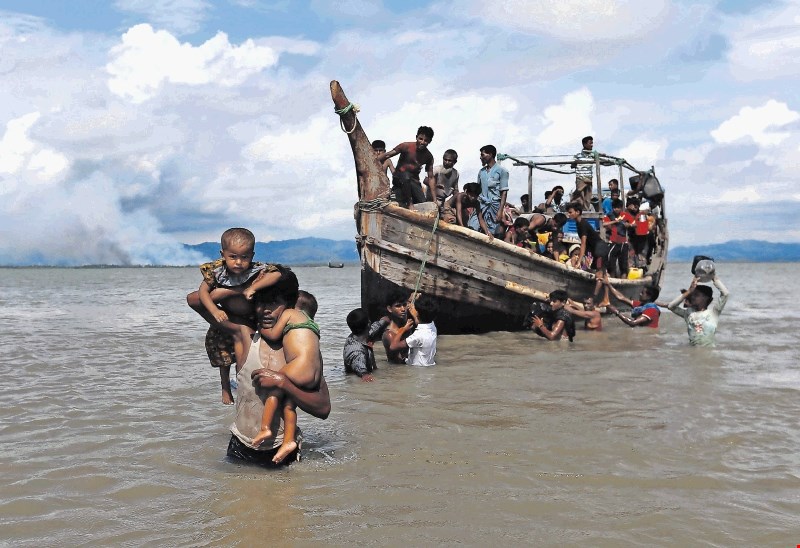
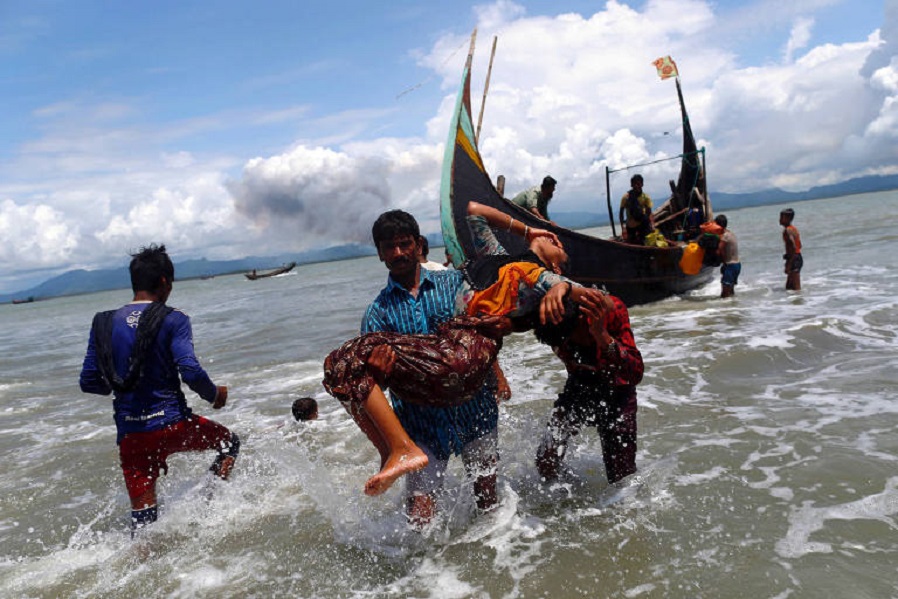 Discrimination against the Rohingya goes back to the government of Ne
Win in the 1960s, which declared them foreigners in 1982. Although the
Myanmar government has exhibited signs of reform since 2011, systematic
discrimination and persecution of the Muslim group by the Burmese
authorities continues.
Discrimination against the Rohingya goes back to the government of Ne
Win in the 1960s, which declared them foreigners in 1982. Although the
Myanmar government has exhibited signs of reform since 2011, systematic
discrimination and persecution of the Muslim group by the Burmese
authorities continues.
THOUSANDS DIE IN YEMEN IN FIGHT OVER WATER.YEMEN'S WATER CRISIS,THERE'S TEARING ITSELF OVER WATER.WATER SHORTAGE BECOME BIGGER PROBLEM THAN WAR.
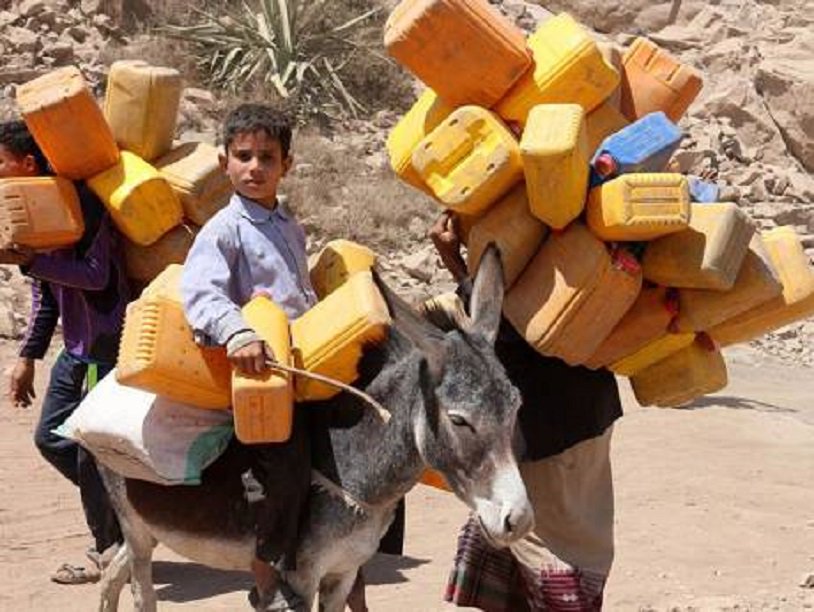 Some boys wait for their turn to fill buckets with water from a public tap amid an acute shortage of water, on the outskirts of Sanaa, Yemen. The war has taken a heavy toll on Yemen. More than 4,000 people have been killed, and the humanitarian crisis has left the impoverished country on the brink of famine.
Some boys wait for their turn to fill buckets with water from a public tap amid an acute shortage of water, on the outskirts of Sanaa, Yemen. The war has taken a heavy toll on Yemen. More than 4,000 people have been killed, and the humanitarian crisis has left the impoverished country on the brink of famine.Sanaa may be the first capital city in the world to run out of water. If that happens, it will be a signpost to the conflicts over shrinking resources that scientists and sociologists see coming in the decades ahead.The crisis in Yemen is described as the world's largest humanitarian disaster. Today, Yemen is on the brink of a famine, and in the coming months, thousands are expected to die due to lack of food and medicine.The conflict is deep-rooted. Since 2004, there has been fighting between the internationally-recognised government and members of the Ansar Allah group, also known as the Houthi movement. The group is affiliated with a local sect of Shia-Islam, and constitutes about one-third of Yemen's population. In September 2014, members of Ansar Allah and troops loyal to deposed President Saleh swept in and took control of the capital, Sana'a.Over 1.4 million people have fled their homes in Yemen and are now struggling to find food and water. Oxfam teams in Yemen are helping by providing tanks of clean drinking water to internally displaced people and through direct cash payments which allow families to buy food and basic supplies.Since the beginning of the current conflict women and children have had to walk long distances just to collect a few litres of water for their families. We are helping by providing internally displaced people with 7.5 litres of water per person per day.Yemen is one of the most water stressed countries in the world. In fact, some hydrology experts warn that it could be the first modern country to run out of usable water, and that this could occur within a decade. Yemen is also in the midst of a major civil war and humanitarian disaster, similar to the conflict in Syria. Yemen is just one of several countries in the Middle East dealing with water shortages, making the issue critical to regional stability. Studies have drawn links between the civil war in Syria and a major drought in the mid-2000s, which drove many farmers from fields to cities and fueled the uprisings that led to the current war. Recent scientific studies show decreasing water levels across the region, including Iraq, Turkey and western Iran.Yemen’s water crisis is the worst in the Middle East. Yemen is located on a dry, semi-arid portion of the Arabian Peninsula. Yemen has no rivers unlike Syria, Egypt, Iraq and other Middle Eastern nations. The country relies completely on ground water and rain water . On average, Yemen gets 500 to 800 mm of rain each year in the high lands, 40 to 100 mm of rain in the coastal areas and 50 mm in the desert areas. The water shortage has gotten worse each year. In 1990, 71% of Yemenis had access to water. In 2004 this figure had decreased to 67%. Generally, urban areas have greater access to water than rural areas. However the decrease of water in urban areas has been more severe . Water availability in urban areas has gone from 84% in 1990 to 71% in 2004. In rural areas water availability went from 68% to 65% . Therefore, if this trend continues rural areas will eventually have greater access to water than the urban areas.As a hot country, Yemen has always experienced water troubles to some extent, but the problem has worsened due to an increasing population and poor water management; instead of collecting and storing rainwater, drilling for limited groundwater has become the norm. No one really knows how much is left. Various estimates predict that the capital Sana’a could run out of water within a decade.Only a tiny proportion of Yemeni families are connected to the municipal supply. State-run water companies only supply some households in the major cities and 70% of Yemenis live in rural areas. Even in the capital Sana’a only 40% of the houses are connected – and they’re lucky if water comes out of their taps more than twice a week. The pipe network is old and an estimated 60% of water is lost through leaks. The situation is worse in the industrial city of Taiz, where water may come out of the tap only once a month. But the municipal supply is heavily subsidised and much cheaper than buying water from trucks, as everyone else does.
The humanitarian situation continues to deteriorate with fuel shortages, rising food prices and a severe lack of basic services, such as health, water supply and education, making daily survival a painful struggle for millions.More than 17 million Yemenis were already going hungry every day. Nearly 7 million of these people are starving – they don’t know where their next meal is coming from. Yemen was the poorest country in the Middle East and poverty and inequality was increasing.Over 4.5 million people are malnourished, including nearly half a million children who are in a life-threatening condition. Nearly 19 million people - 70 per cent of the population - need some sort of humanitarian aid. More than 3 million people have been forced to flee their homes due to the bombing and fighting.Over 46,000 people have been killed or injured since the escalation of the conflict in March 2015. A cholera outbreak has worsened significantly, with 2,000 suspected cases arising each day. There have been over 360,000 confirmed cases and near 2,000 deaths since April 2017. These are expected to number in the millions in the next few decades as global warming melts polar icecaps, floods coastal regions, accelerates the spread of deserts and destroys farmland.Much of Yemen's water problem is self-inflicted. An estimated 40 percent of available water is consumed by the cultivation of qat, a leafy stimulant that is chewed by 70 percent of Yemeni males daily. Farmers prefer to grow it for the high profit involved in the narcotics trade.The government in Sanaa has been unable to do much to ameliorate the crisis. Its authority does not run much beyond Yemen and other major urban centers, and its oil reserves, never particularly big, are running out like the water resources.It is also grappling with a tribal insurgency in the lawless north, an increasingly volatile secessionist movement in the south and the resurgence of al-Qaida forces in the east.The water shortage is starting to cause civil unrest. Water available across the country, much of it rocky highlands, amounts to 100-200 cubic meters per person per year, well below the international water poverty line of 1,000 cubic meters.Yemen has had one of the highest population growth rates in the world in recent years, growing by nearly 25% from 2006 to 2014. This massive growth has put a strain on an already stressed water supply. An extra five million people need food and water, and there has been no equal increase in economic growth. A high youth population is understood as a major contributing factor to political unrest across the Middle East, and Yemen is no exception. Roughly 60% of Yemen’s population is under the age of 24. This statistic, combined with large unemployment and significant water insecurities, set the stage for unrest. The new methodology has practical applications for those involved in water management. For instance, utility operators can use the geodatabase as a third-party certified feedback mechanism to help improve services.The growth in population and increased water usage in Yemen coincided with the development of a cash economy in Yemen, which led to farmers relying more heavily on water-intensive cash crops. Qat, a mild stimulant chewed by many in Yemen, is a cornerstone of the Yemeni economy. A report from 2010 estimated that “Qat production now accounts for 37 percent of all water used in irrigation” and makes up roughly 6% of Yemen’s GDP. However, Qat does not fill the stomachs of hungry Yemenis. With fewer edible crops being grown domestically, access to food drops in step. With more water being used up by agriculture, there is less to drink. Many have predicted a severe crisis in Yemen, with some even predicting the country being completely dry by 2015, and others predicting that the capital Sana’a will be dry by 2020.The war in Yemen has led to the worst cholera outbreak in the world.The cholera epidemic in Yemen has now become "the largest ever recorded in any country in a single year" .There are more than 360,000 suspected cases and 5,000 more being added per day. 1,800 victims have already died, a quarter of them children. Hard as this may be to believe, these numbers will only continue to worsen in the coming months as Yemen struggles with its rainy season spanning July to September.Right now, far from halting the spread of Iran’s influence, the war has deepened the Houthis’ reliance on Iran, which has an easy and cheap means of tormenting the Saudis. And because Saudi Arabia is bogged down in Yemen, Iran has a freer hand to set the terms of a settlement in Syria. The war is a drain on the Saudis at a time of austerity and wrenching economic reforms at home. They should therefore learn another lesson from Israel’s experience of fighting Hizbullah. If wars are to be fought at all, they should be short, and have limited aims. Deterrence is better than debilitating entanglement.
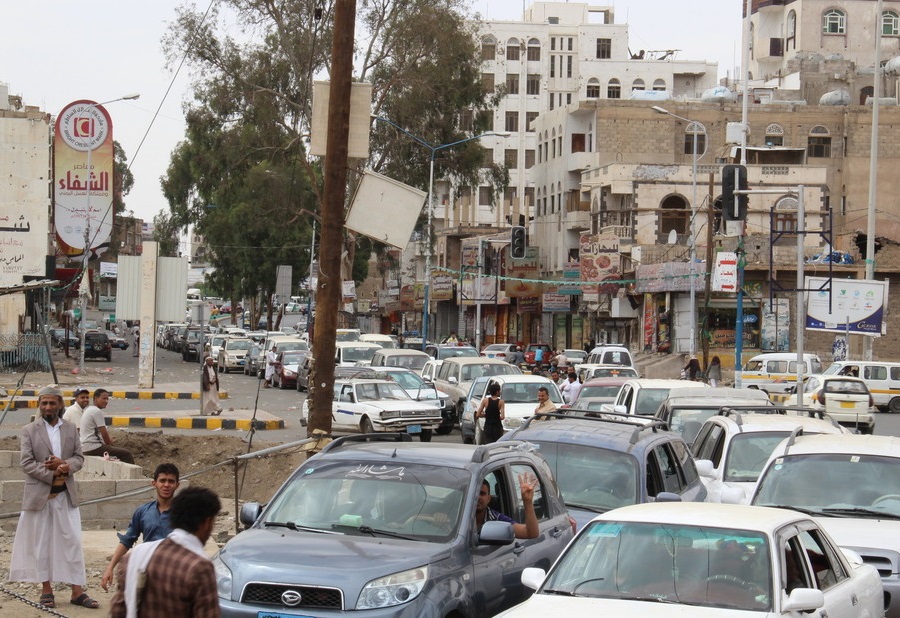 Cars wait for fuel in Al Hasaba district, in Sana'a, the capital of Yemen. The oil crisis has escalated as a result of the conflict and siege imposed on Yemen.The oil crisis has also worsened the food shortages because farmers are unable to pump water to their fields. Oxfam is providing direct cash payments to families which allow them to buy food and basic supplies.
Cars wait for fuel in Al Hasaba district, in Sana'a, the capital of Yemen. The oil crisis has escalated as a result of the conflict and siege imposed on Yemen.The oil crisis has also worsened the food shortages because farmers are unable to pump water to their fields. Oxfam is providing direct cash payments to families which allow them to buy food and basic supplies.
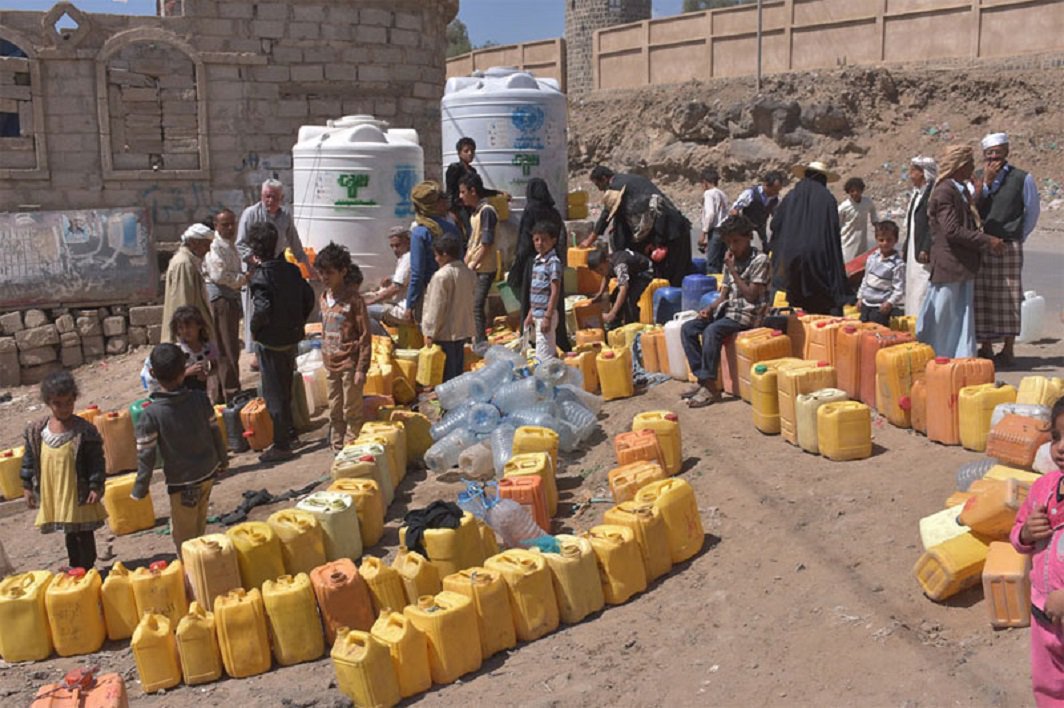
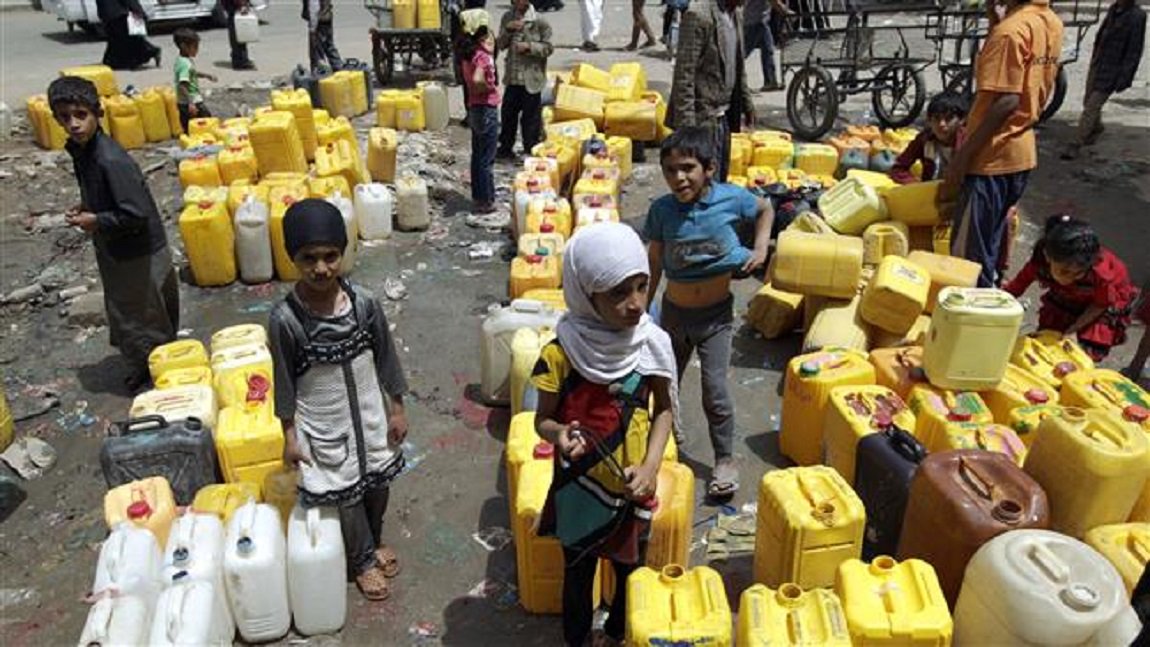
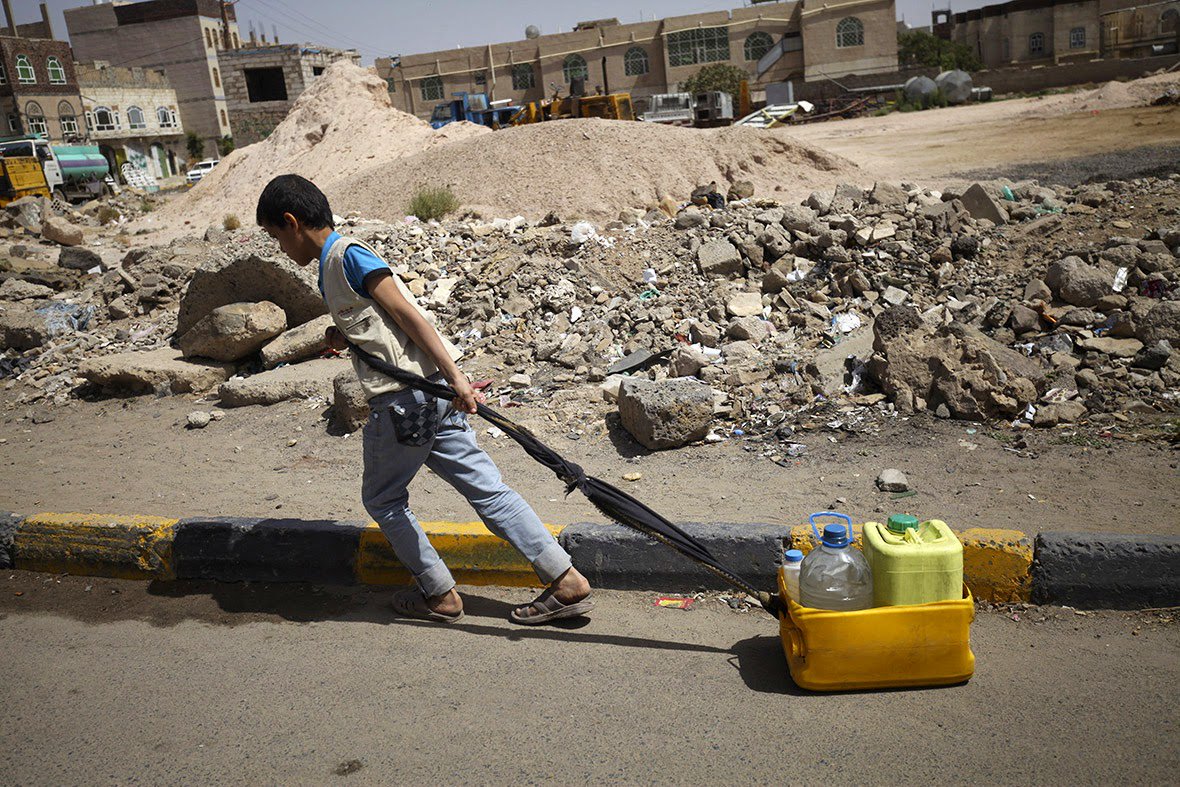 The water shortage is starting to cause civil unrest. Water available across the country, much of it rocky highlands, amounts to 100-200 cubic meters per person per year, well below the international water poverty line of 1,000 cubic meters.
The water shortage is starting to cause civil unrest. Water available across the country, much of it rocky highlands, amounts to 100-200 cubic meters per person per year, well below the international water poverty line of 1,000 cubic meters.
TURKEY' FAILED MILITARY COUP 2016,TURKEY HAS SO FAR DETAINED OVER 7,500 AND SACKED ALMOST 9000 OFFICIALS IN IT'S RELENTLESS PURGE OF SUSPECTED PLOTTERS AND SENTENCED 40 PEOPLE TO LIFE IN PRISON OVER PLOT TO KILL ERDOGAN .TURKEY'S DEMOCRACY WAS ALWAYS PROBLEMATIC ONE ,IN COUNTRY ONCE DOMINATED BY GENERAL.
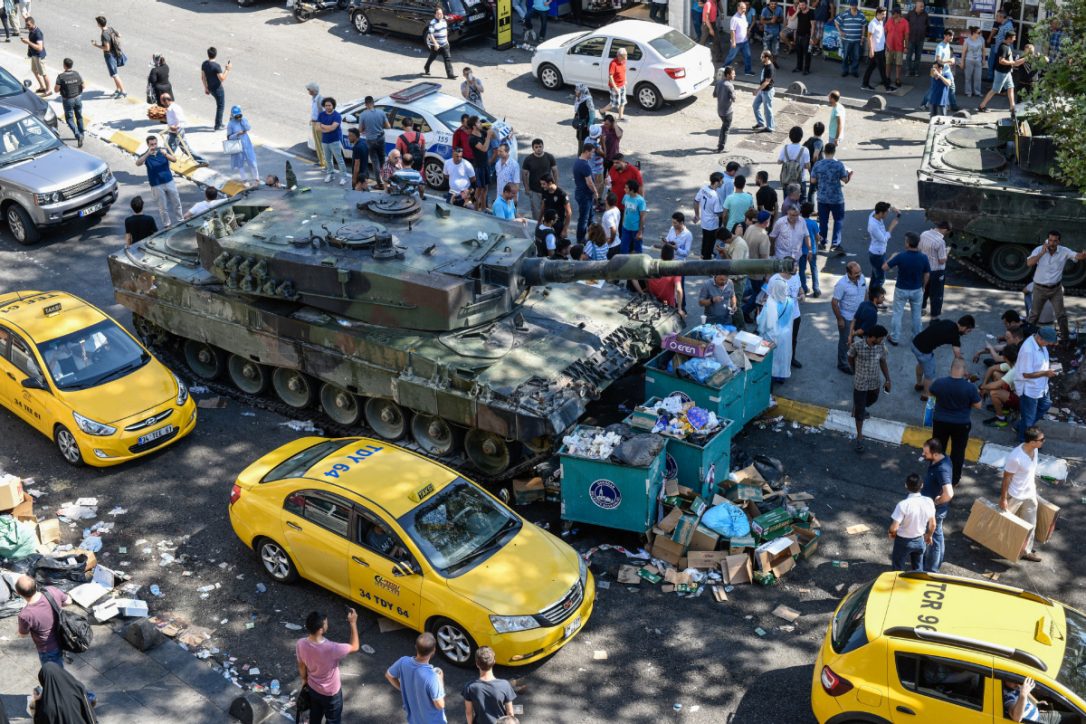
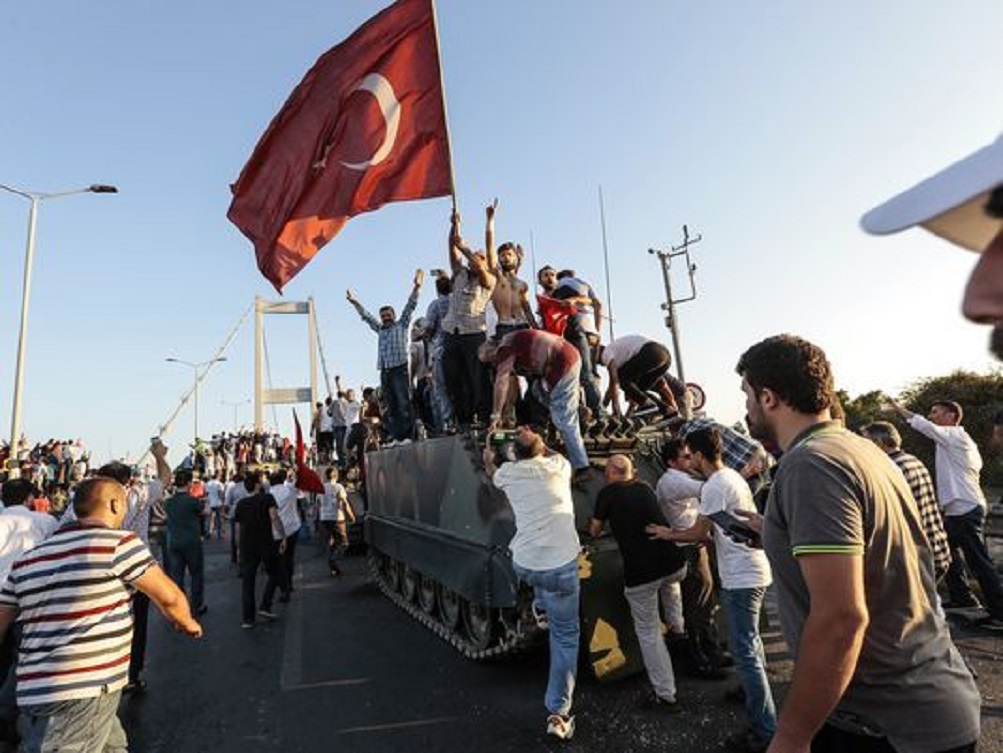
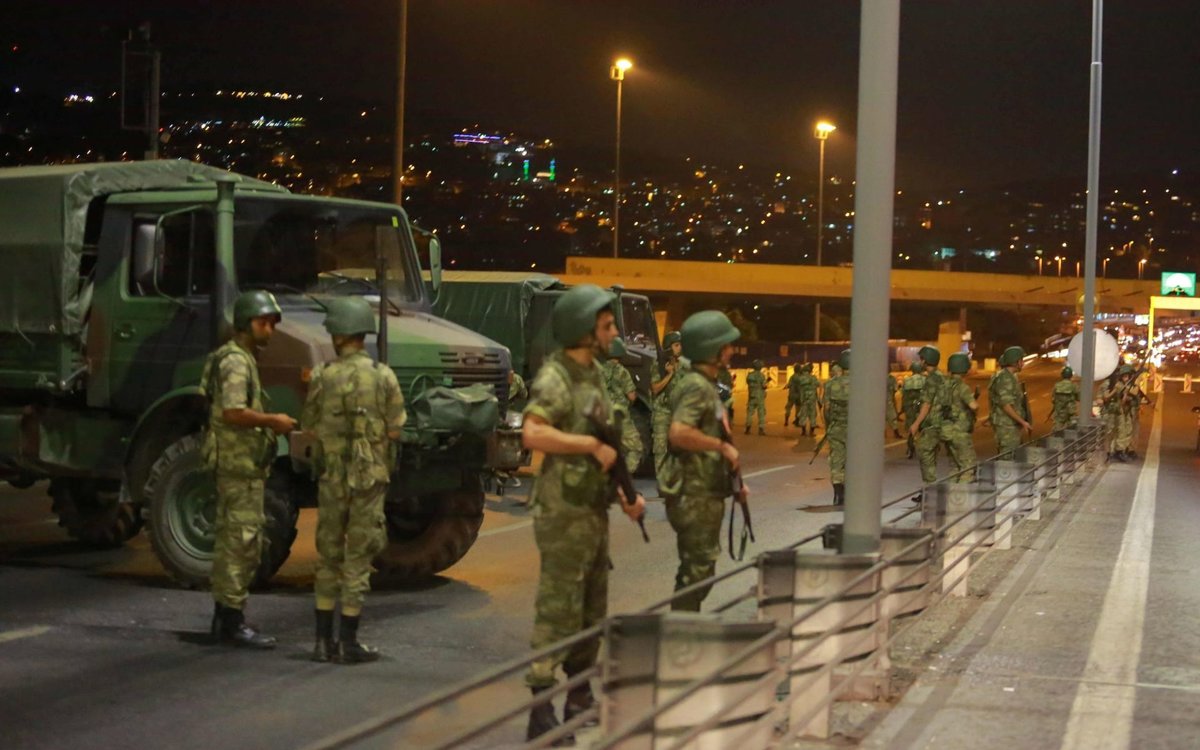 Failure to arrest Erdogan is a very important indication of the real intentions to overthrow the government. The Erdogan was on vacation in a resort on the Mediterranean, as soon as he learned about the coup, he immediately took off in his private jet. While he continued to fly unobstructed in the Turkish skies, many mosques in Ankara and Istanbul began to convey similar messages calling on the population to take to the streets.
Failure to arrest Erdogan is a very important indication of the real intentions to overthrow the government. The Erdogan was on vacation in a resort on the Mediterranean, as soon as he learned about the coup, he immediately took off in his private jet. While he continued to fly unobstructed in the Turkish skies, many mosques in Ankara and Istanbul began to convey similar messages calling on the population to take to the streets.
The drama that began unfolding in Turkey late Friday evening in 2016 with the beginning of a failed coup attempt by rebel Turkish soldiers was graphically captured on videos that have gone viral on the internet.The onset of the coup caught Turkish President Recep Tayyip Erodogan on vacation in the Turkish resort of Maramris. "They bombed places I had departed right after I was gone," he said. "They probably thought we were still there," said the president, whose Islamic principles are at odds with the secular political ideology on which modern Turkey was founded.The failure to appoint a credible representative may be attributable to poor planning and experience, or something deeper, perhaps linked to a sabotage of the coup. Forces and political representatives probably withdrew at the last moment. We can continue speculating on this aspect, but for the meantime this decision remains simply a big mistake made by the military junta.The third, fifth and sixth points are most likely related to a strong unwillingness of men and inexperience (only 3 generals and 29 colonels). The bulk of the troops, made up of simple soldiers and tanks were deployed around the parliament (the seventh point) and in the vicinity of two bridges very strategic in the city of Ankara. A lot of speculation still remains on the reasons regarding the enormous lack of availability in terms of resources. Probably this can be explained by withdrawal of some participants at the last moment. The same can be said about the statements of some soldiers arrested after the government overthrow who claimed in many cases to not know why they were there and claiming they had only obeyed the orders from above (it’s also a great excuse to put out during a failed coup). Another common excuse mentions soldiers believing to be part of an exercise.The death penalty was abolished in 2002 under judicial reforms made by Turkey while negotiating for entry to the European Union, but supporters of Erdogan and relatives of those who died in the coup attempt have called for it to be reinstated to punish those responsible.In the Marmaris case, 37 of the 46 defendants were special forces commandos. One officer was acquitted, 40 received life sentences, and two others received lesser sentences: A former military aide to Erdogan received a sentence of 18 years, and another officer 15 years.During the trial, which took place in the town of Mugla, some defendants admitted to taking part in the coup attempt but denied trying to assassinate the president. Major Seymen, the commander of the attack, said in testimony on the first day of the trial that the aim was to detain Erdogan.A former political ally of Erdogan’s, Mr. Gulen fell out with the president in 2013 over accusations of corruption. Since the coup attempt, thousands of his followers have been imprisoned and Turkey has demanded his extradition from Pennsylvania.Mr. Gulen was among those indicted in the Marmaris case, but no verdict was reached on the charges against him or two others also being tried in absentia. The judge announced that their trial will continue, news agencies reported.The Marmaris case is of personal interest to Erdogan. It is the only one in which he has formally applied to be considered an interested party.
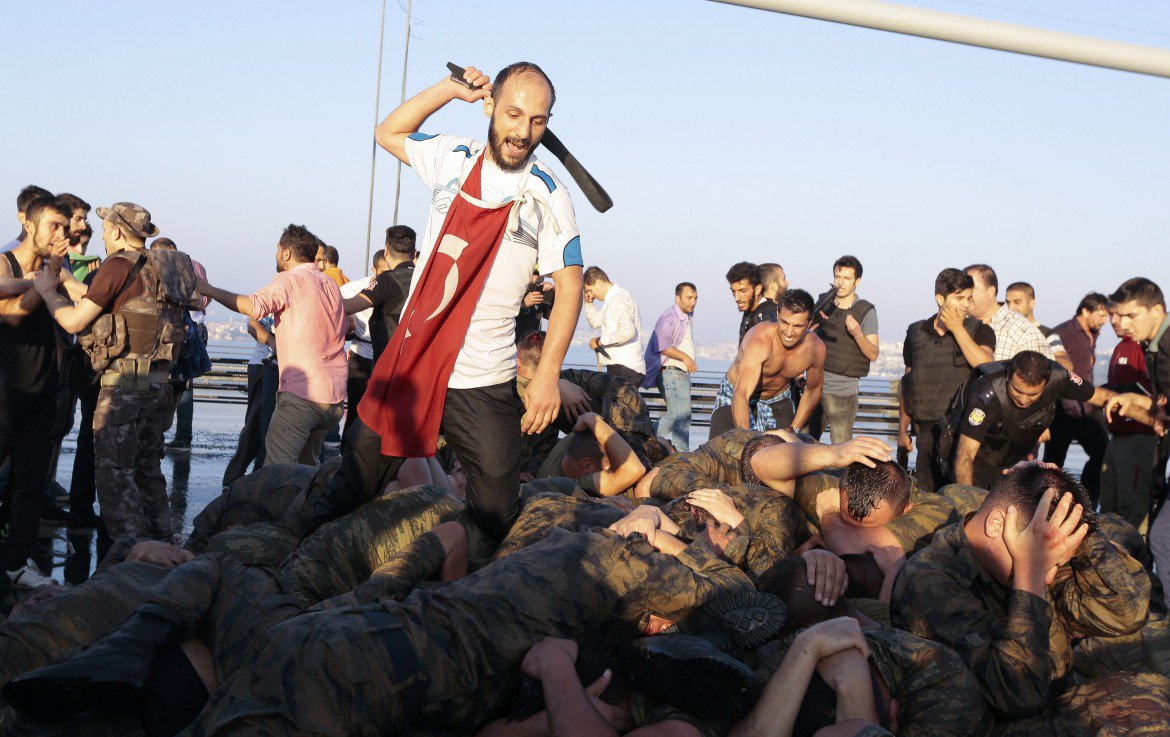
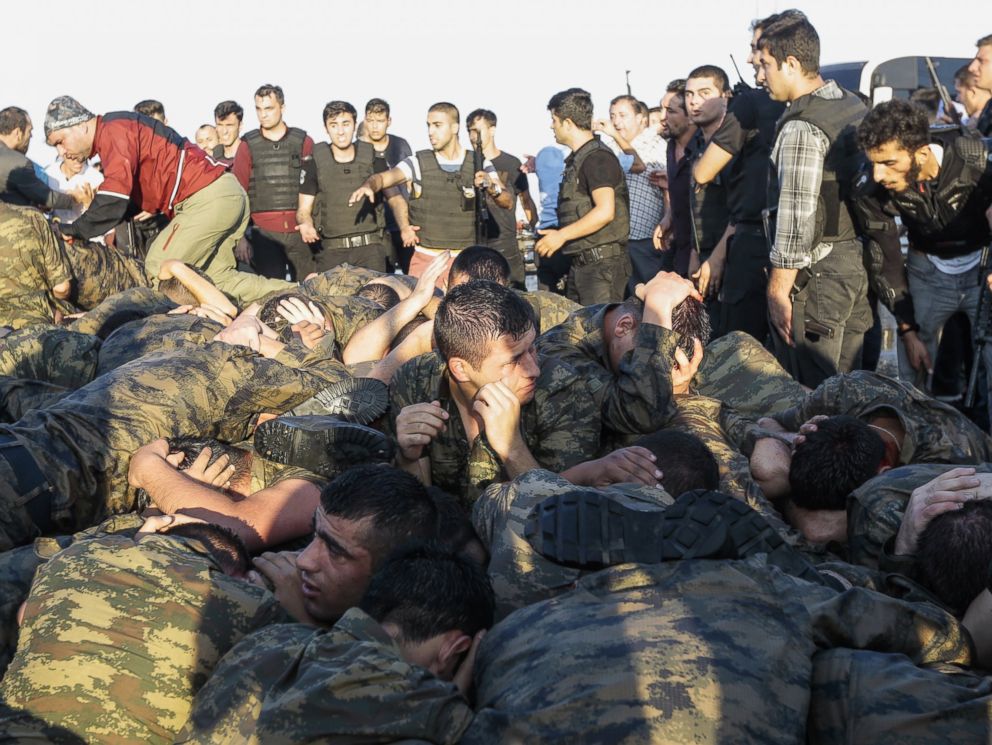
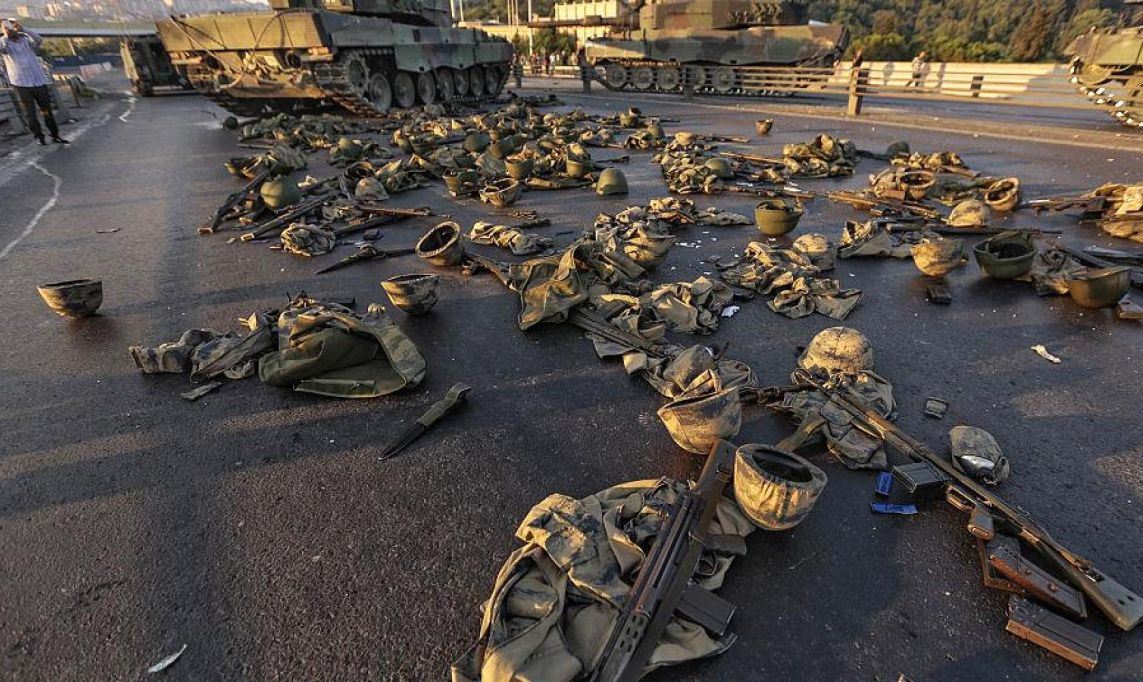 Surrendered Turkish soldiers who were involved in the coup are surrounded by people on Bosphorus bridge in Istanbul, Turkey, July 16, 2016.There have been fears that many of the over 7,400 soldiers detained in the wake of the coup were young conscripts who had no idea what was going on. But also when there were no military coups the democracy itself had its own challenges with respect to the quality of human rights.
Surrendered Turkish soldiers who were involved in the coup are surrounded by people on Bosphorus bridge in Istanbul, Turkey, July 16, 2016.There have been fears that many of the over 7,400 soldiers detained in the wake of the coup were young conscripts who had no idea what was going on. But also when there were no military coups the democracy itself had its own challenges with respect to the quality of human rights.
To understand the coup in Turkey, we have to analyze the reasons that led the plot to fail. A premise: was there really an intention to overthrow and shut down Erdogan’s government? And who are those behind the coup? Starting from these questions and exploring the possible answers, we get a reasonable and authentic framework for a story still very confusing.Let’s start from here. Assuming the existence of a manual of the ‘Perfect Coup’, it is very likely it would thoroughly explain the importance of the first goals to pull off for the success of a government overthrow.The opposition is concerned that the purge and the state of emergency decrees might turn into a witch-hunt targeting all dissident voices. The government claimed that the decrees would merely be used to root out illegal organizations inside the state bureaucracy. However, instances like the detention of human rights lawyer Orhan Kemal Cengiz (Cengiz was later released and banned from traveling) and the detention warrant issued for journalists prove that the opposition’s concerns are not unwarranted. The closure of newspapers, radio, and television stations is a signal of more pressure on civil society. Also, images of abused military officials and the Amnesty International report on the torture of detainees create legitimate concerns about respect for the rule of law during detention and interrogations. A state of emergency has been declared for three months, but its extension might lead to severe human rights violations and increased suppression of the opposition.The vast number of suspensions, detentions, and arrests have also robbed many institutions of key personnel. Particularly concerning are the purges in the key security institutions. Thousands of army officials, including more than 40 percent of generals, have been arrested, and the police and intelligence service are focused on the fight against Gulenists. These purges are likely to create a security vacuum at a time when Turkey is facing several national security challenges domestically and regionally. They will hurt the operational capability of these institutions to fight effectively against the P.K.K. and the Islamic State.The government’s efforts to restructure the military are likely to leave the military weak, divided, and politicized. The measures the government is taking are likely to break the military chain of command and create divided loyalties and competition within both the military and the security establishment.In the following months, there will be several appointments to fill emptied positions in the state bureaucracy and the security apparatus. For years, the opposition tried to draw the government’s attention to the Gulenists’ strategy of appointing other Gulenists to key positions by violating the principle of merit. Now, the government has the opportunity to reintroduce merit as the main principle of appointment. If the government chooses not to use merit, but rather loyalty, as the main determinant of appointments, it will only lead to more ineffective institutions and add to the feeling of marginalization that is already present among certain segments of the society.Before the coup attempt, Turkey had signaled that it could recalibrate its Syria policy. In return for Russia’s commitment to prevent an autonomous Kurdish region in northern Syria, Turkey might soften its approach to Bashar al-Assad’s role in a transition. The Turkish government already seemed to test the waters to gauge the reaction to rapprochement with the Assad regime. On July 13, Yildirim stated, “In order for counterterrorism efforts to succeed, there has to be stability in Syria and Iraq. We normalized our relations with Israel and Russia. I’m sure we will go back to normal relations with Syria as well.” And on August 11, the Turkish ambassador to Russia was quoted as saying, "We want the existing political leadership of the country to take part in the negotiation process.”But, it is uncertain how willing Russia will be to stop working with the Syrian Kurds whom Moscow considers a tool not just against Turkey, but also the United States.A positive outcome of the July 15 coup attempt was the unified stance from the people, and all political parties, against it. Given Turkey’s recent history of four military coups, the unified objection against the military intervention, which cost more than 200 lives, is significant. Erdogan’s decision to reach out to opposition parties was also a positive development for a country that has been extremely polarized in recent years. But the president’s refusal to include the pro-Kurdish H.D.P., which has also voiced its strong stance against the coup in the national unity effort, raises questions about his agenda in dealing with the Kurdish issue, one of the main fault lines of Turkey’s democracy. A coalition of parties that intends to write a new constitution on the basis of equal citizenship should cannot exclude the H.D.P.
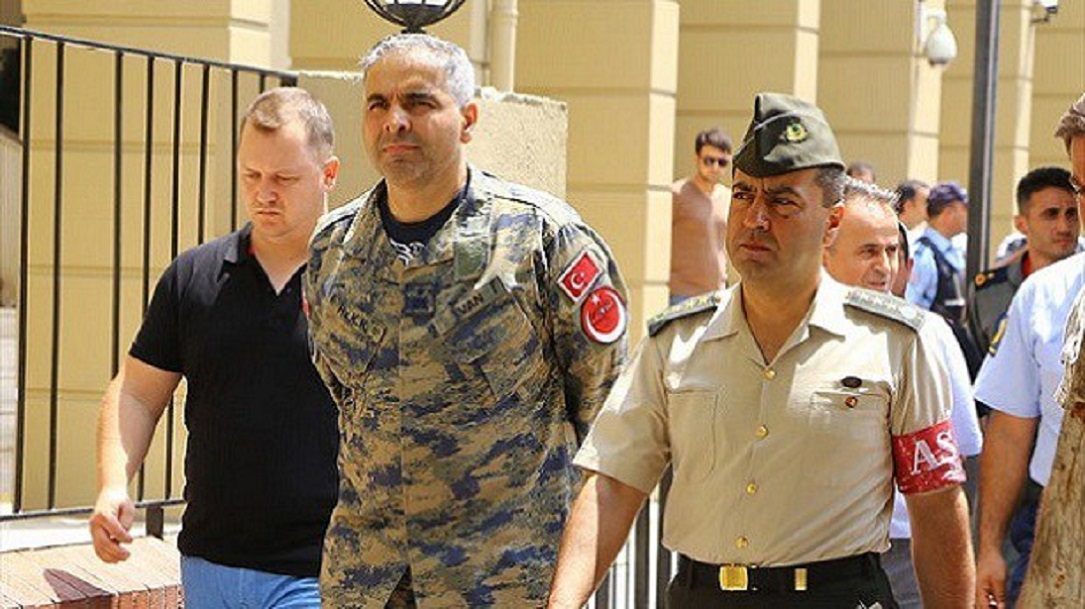

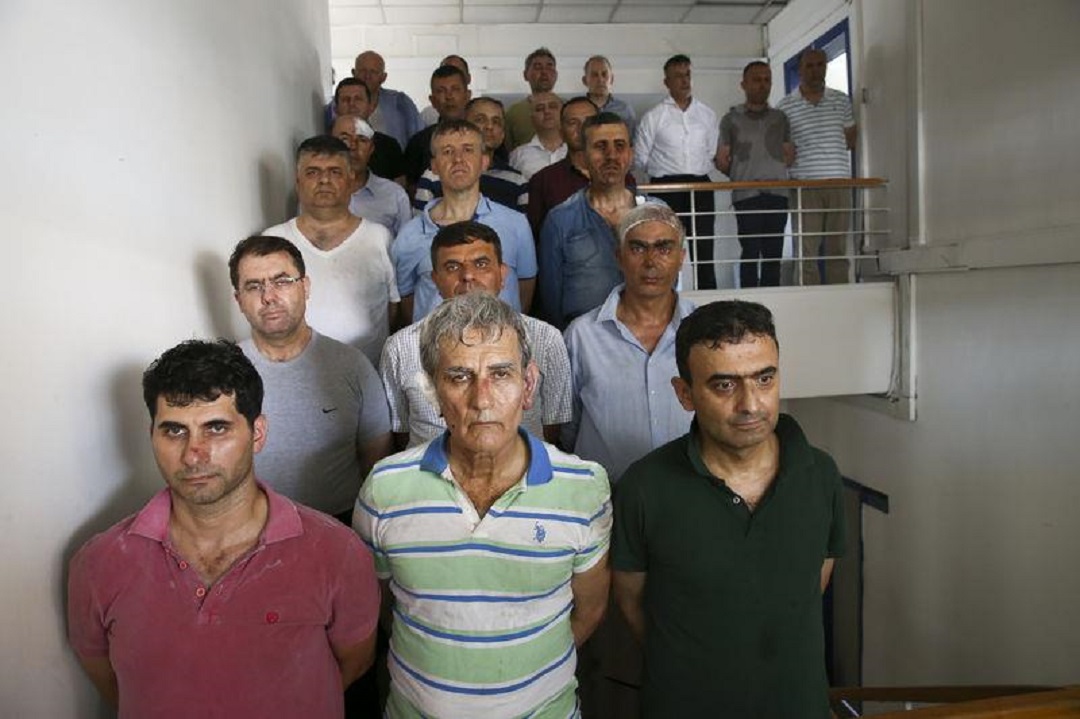
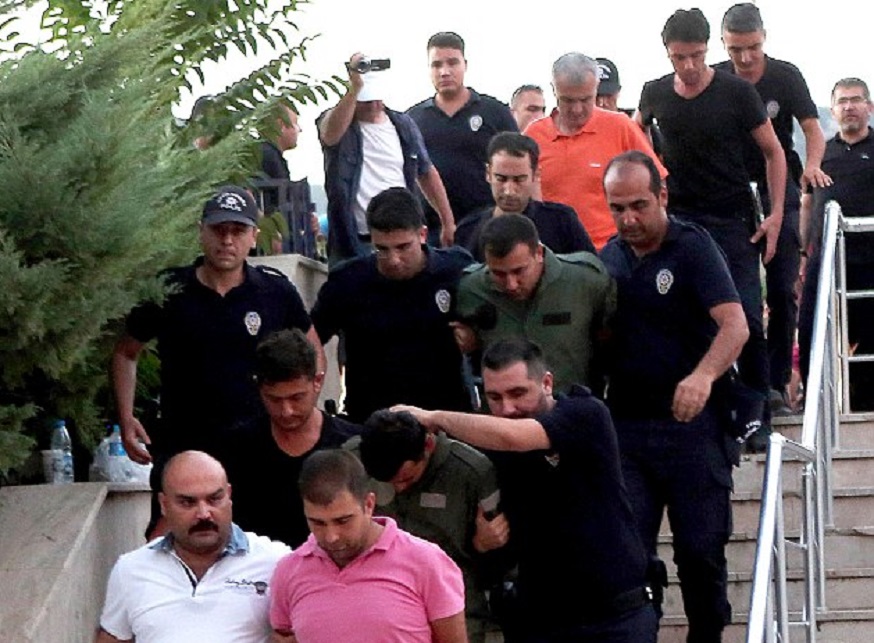
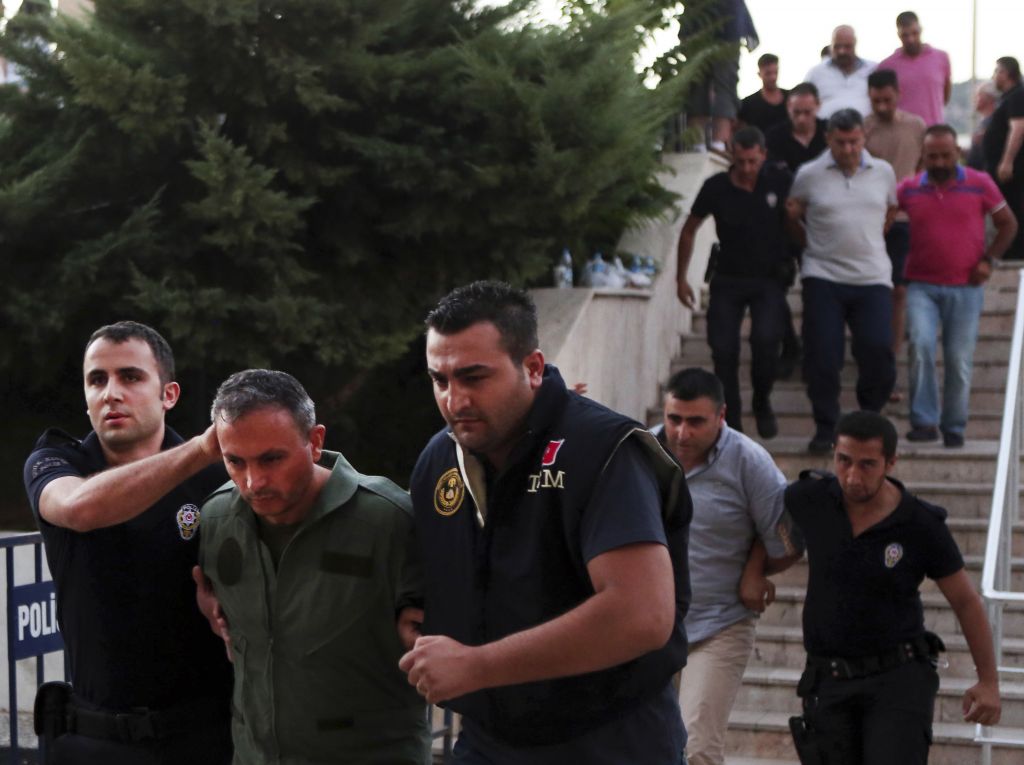 Several other top commanders involved in the coup attempt were also
detained in operations throughout the country. Akin Ozturk was among 70 generals and admirals being detainedThe commander of the 2nd
Army Gen. Adem Huduti and its executive officer and Malatya Garrison
Commander Avni Angun and the commander of the 3rd Army Gen. Erdal Öztürk
were detained in the operations.
Several other top commanders involved in the coup attempt were also
detained in operations throughout the country. Akin Ozturk was among 70 generals and admirals being detainedThe commander of the 2nd
Army Gen. Adem Huduti and its executive officer and Malatya Garrison
Commander Avni Angun and the commander of the 3rd Army Gen. Erdal Öztürk
were detained in the operations.
THE TALIBAN CONTROL OF HEROIN DRUG PRODUCTIONS IN AFGHANISTAN , AS THE TALIBAN RELIES MORE AND MORE ON DRUGS.THE OPIUM PRODUCTION HAS GROWN, THE TALIBAN HAS ASSUMED A BIGGER ROLE IN IT.DERIVING MUCH OF ITS INCOME FROM DRUG TRADE!
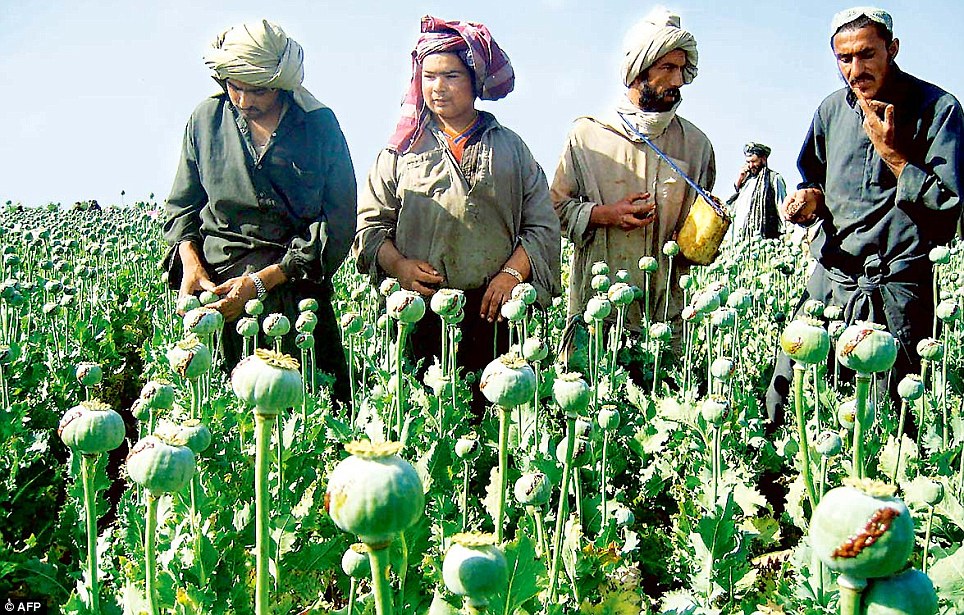
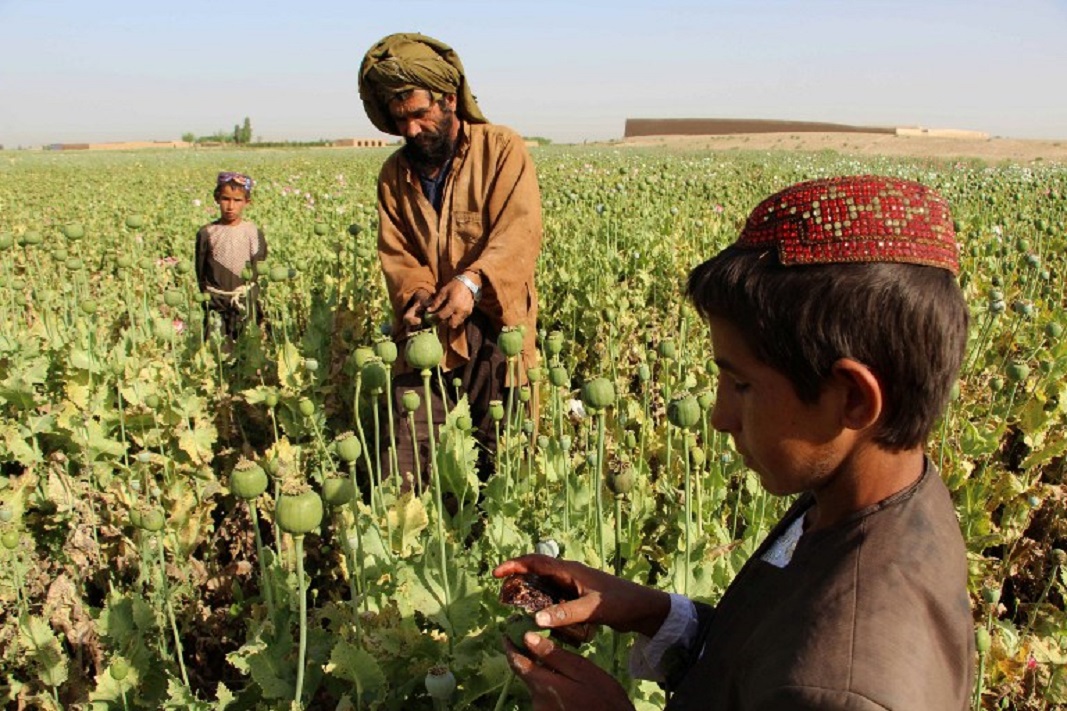
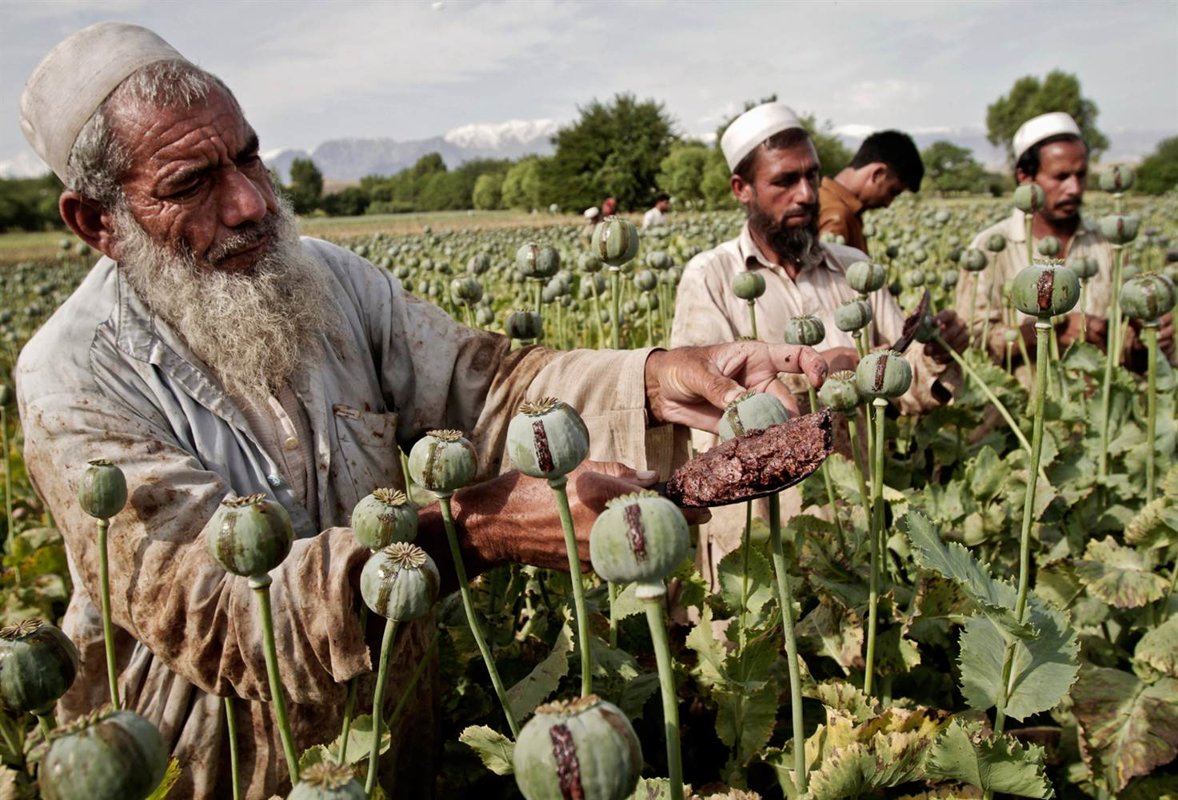 The Taliban which banned poppy cultivation when it ruled Afghanistan now appears to wield significant control over the war-torn country’s heroin production line, providing insurgents with billions of dollars.The southern province of Afghanistan, is not just the larger producer of opium but also the most restive province in the country. The armed insurgents continue to create problems for the government forces in the province.Drug smugglers in connivance with armed opposition groups are engaged in fierce armed clashes.
The Taliban which banned poppy cultivation when it ruled Afghanistan now appears to wield significant control over the war-torn country’s heroin production line, providing insurgents with billions of dollars.The southern province of Afghanistan, is not just the larger producer of opium but also the most restive province in the country. The armed insurgents continue to create problems for the government forces in the province.Drug smugglers in connivance with armed opposition groups are engaged in fierce armed clashes.
From poppy to heroin, Taliban moves into Afghan drug production. The Taliban which banned poppy cultivation when it ruled Afghanistan now appears to wield significant control over the war-torn country’s heroin production line, providing insurgents with billions of dollars.In 2016 Afghanistan, which produces 80 percent of the world’s opium, made around 4,800 tonnes of the drug bringing in revenues of three billion dollars.The Taliban has long taxed poppy-growing farmers to fund their years-long insurgency, but Western officials are concerned it is now running its own factories, refining the lucrative crop into morphine and heroin for exporting abroad.The Taliban need more money to run their war machine and buy guns, that is why they have taken control of drug factories.“More than 90 percent of all heroin consumed in the US is of Mexican origin. But in Canada more than 90 percent of the heroin consumed is of Afghan origin.Taliban, drug lords await $770m opium bonanza,Afghanistan is a hot spot for the Taliban, it’s the reason we are currently in a war over there. However, the main funding for the Taliban comes from the opium they grow in Afghanistan. They sell these drugs to private groups and other terrorist organizations. This money then goes to fund their battle against our troops. Currently the United States government is pursuing the possibility of intervening and spraying down the areas that grow the drugs with a chemical to kill them. They did this same thing to an extent in Columbia South America. The fact that drugs are funding the Taliban is an undisputed fact and needs to be addressed; however, is this route the one we should be taking on the issue? To answer this question we need to look at what happened when we did this before in Columbia. When we did begin the eradication attempts on Columbia, things went smoothly for a time, until we started noticing the aftereffects. Several things happened, firstly allot of the Columbian economy was based on the illegal trade of the narcotics. When we started killing the drugs their economy began to tumble causing economic crisis. Secondly the farmers of the drugs simply either replanted in another unknown hidden location, or they moved to a different country. This caused the drug crisis to proliferate. So, if we apply what we have seen in Columbia to Afghanistan, it’s clear that there must be another better option for conquering the Taliban and the drugs they grow.Apparently unable to defeat the Afghan government with conventional tactics alone, Taliban and terrorist groups operating in the country now try to sway the hearts and minds of the local population in their favor, seeking to drive a wedge between civilians and security forces.Everything they harvest is duly processed inside the country. They receive more revenues if they process it before it has left the country.Obviously we are dealing with very loose figures, but drug trafficking amounts to billions of dollars every year from which the Taliban is taking a substantial percentage.Poppies, which are cheap and easy to grow, make up half of Afghanistan’s entire agricultural output.Farmers are paid about $163 for a kilo of the black sap the raw opium that oozes out of poppy seed pods when they are slit with a knife.Once it is refined into heroin, the Taliban sells it in regional markets for between $2,300 and $3,500 a kilo. By the time it reaches Europe it wholesales for $45,000, according to a Western expert who is advising Afghan anti-narcotics forces and asked not to be named.The first step before it becomes heroin, such as acid anhydride, points to an escalation in Taliban drug activity.Sixty-six tonnes of the chemicals were seized in all of 2016, while 50 tonnes were impounded in just the first six months of 2017.
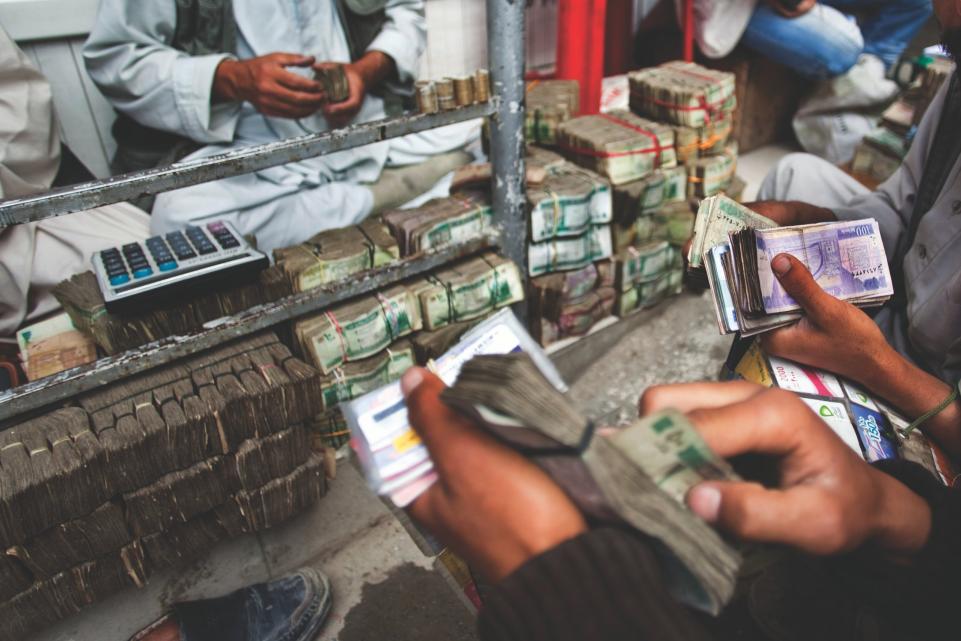
 How drugs finance Taliban’s war in Afghanistan,how the Afghan heroin trade is fuelling the Taliban insurgency.Without any doubt, there are local, regional and even international mafia groups involved in drug business inside Afghanistan.If they manage to crack down on local mafia gangs.
How drugs finance Taliban’s war in Afghanistan,how the Afghan heroin trade is fuelling the Taliban insurgency.Without any doubt, there are local, regional and even international mafia groups involved in drug business inside Afghanistan.If they manage to crack down on local mafia gangs.
Drugs for guns:Taliban leaders, in other words, are a lot richer than they used to be just a few years ago and the source of their sudden influx of wealth is no secret in Afghanistan and Pakistan. “The Taliban are more involved than ever in systematically promoting, financing, organizing, and protecting the drug trade.Drugs are ultimately providing the money, food, weapons, and suicide bombers to the insurgency and the good life to Taliban leaders in Quetta, Karachi, and across Afghanistan.”The drug trade, of course, has been an important part of Afghanistan’s economy for a long time exploited by former Northern Alliance warlords, corrupt government officials, and other major traffickers. Local Taliban leaders have long benefited as well. But now the Taliban’s central leadership has decided it wants in. And drug trafficking has become such a pervasive part of the organization’s mission that it raises an alarming prospect.Opium fields in Afghanistan are the main sources of revenue to armed insurgents and source of sustenance to poor farmers. Notwithstanding the efforts by government and its international partners to eradicate the menace, it has only increased over the years.Afghanistan is a victim of drug war spearheaded by drug mafias at the behest of armed opposition groups.The drug mafia, according to government officials, poses biggest threat to the country. “If drug production is stopped, the situation will also improve and it would be easier for the government to identify those who was leading the war.Drugs are used to fund the war against government. “It is one of the main sources of revenue for armed insurgents and there is no doubt about that.Who are the drug mafia?Experts believe the drug mafia in Afghanistan makes millions of USD every year by smuggling narcotic drugs, especially in the western provinces of Afghanistan, bordering Pakistan and Iran.The farmers get only 2-3 percent of the income generated from drugs and the rest goes to local and regional drug mafia groups who are connected to the international drug mafia industry.Without any doubt, there are local, regional and even international mafia groups involved in drug business inside Afghanistan.Majority of Taliban commanders, especially in Helmand province, are also into drug smuggling.Almost 98 percent Taliban commanders are also the hardcore drug smugglers.The drug smugglers, are supported by powerful people, and that is precisely why the smugglers have evaded arrest.It was during the cold war that the US first intervened in Afghanistan, backing Muslim militants who were fighting to expel the Soviet Red Army. In December 1979, the Soviets occupied Kabul in order to shore up their failing client regime; Washington, still wounded by the fall of Saigon four years earlier, decided to give Moscow its “own Vietnam” by backing the Islamic resistance. For the next 10 years, the CIA would provide the mujahideen guerrillas with an estimated $3bn in arms. These funds, along with an expanding opium harvest, would sustain the Afghan resistance for the decade it would take to force a Soviet withdrawal. Its opium production surged from around 180 tonnes in 2001 to more than 3,000 tonnes a year after the invasion, and to more than 8,000 by 2007. Every spring, the opium harvest fills the Taliban’s coffers once again, funding wages for a new crop of guerrilla fighters.At each stage in its tragic, tumultuous history over the past 40 years – the covert war of the 1980s, the civil war of the 90s and its post-2001 occupation – opium has played a central role in shaping the country’s destiny. In one of history’s bitter ironies, Afghanistan’s unique ecology converged with American military technology to transform this remote, landlocked nation into the world’s first true narco-state – a country where illicit drugs dominate the economy, define political choices and determine the fate of foreign interventions.The objective was to shut down a criminal activity, and where possible make arrests, collect evidence and effect a prosecution; these were actions designed to deliver a legal outcome and to strengthen the capacity of the Afghan government to enforce the law.To justify such a significant shift in responsibilities and to allow for the targeting and killing of those that had previously been viewed as the responsibility of law enforcement, there was a need to rewrite the script, and link the drugs trade and the Taliban and press that the two were inseparable; Taliban funding was the means by which this would be done.
THE DARK SIDE OF AMERICAN POPULISM.TRUMP'S AMERICA FIRST POLICY IS A RIGHT WINGS POLITICS,TO DESTROY WESTERN DEMOCRACY AND MAKING WHITES FEEL EMBATTLED AND AGGRIEVED IS CENTRAL TO THE TRUMP PRESIDENCY.
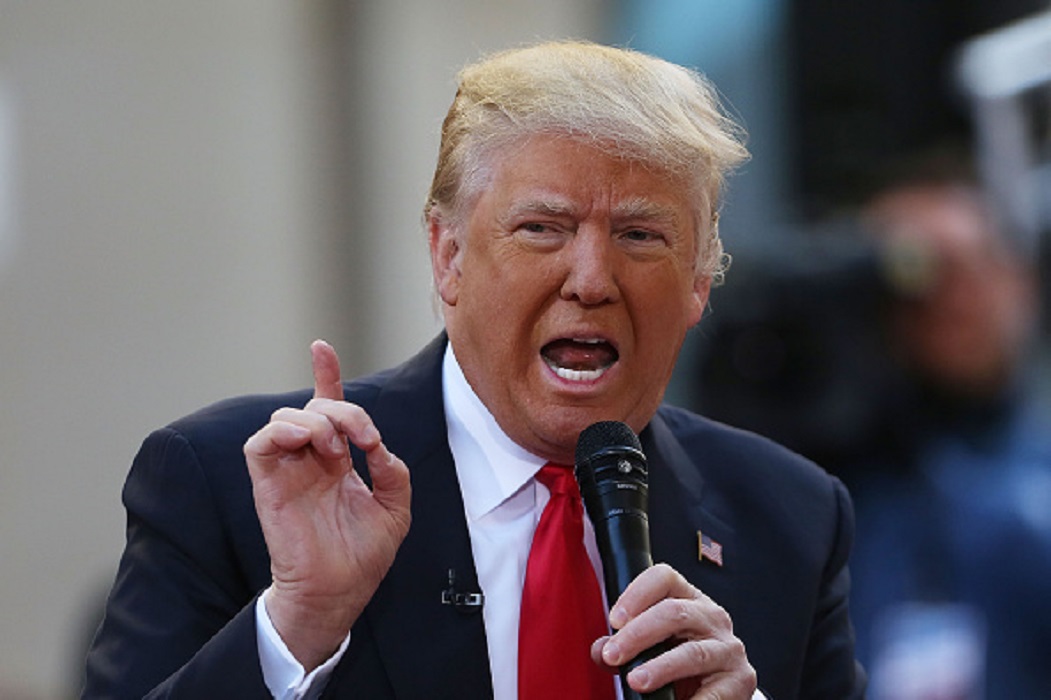 Democrats have suggested that Trump is simply unwilling to alienate
the segment of his white electoral base that embraces bigotry. The
president has forcefully rejected any suggestion he harbors any racial
or ethnic animosities.
Democrats have suggested that Trump is simply unwilling to alienate
the segment of his white electoral base that embraces bigotry. The
president has forcefully rejected any suggestion he harbors any racial
or ethnic animosities.
Trump’s harping on the interests of the middle class and working people, like Richard Nixon’s paeans to the silent majority, can be interpreted as narrowing down the category of “Americans” so as to contrast it against un-Americans dividing " them ” into those who are and aren’t in the middle class, those who do and don’t work, those who are voiceless and those whose voices are amplified by the media. But this interpretation is too one-sided, effacing the effervescence of so many Trump supporters that’s apparent in journalistic reports (see below). His supporters are thrilled that in Trump, they’ve found someone who expresses their concerns about the future of America. As we’ll see, these concerns fit the usual pattern of politics in modern nation-states, in which public policy is designed to ameliorate the social and economic problems of one’s conationals.During the 2016 campaign, Trump’s rhetoric was caustic and divisive. He described differences between groups as if they were essential and irreduceable; he named Mexicans and Muslims as having special attributes, lesser qualities, and who were in need of special measures, such as a “complete shutdown” on Muslims entering the US and a 2,000-mile border wall to keep out Mexican “rapists and murderers”Trump is a populist. But again, the policies he’s now pushing are conspicuously pro-elite. While a populist need not conform to any fixed economic agenda, it’s still worth asking: Is it unusual for a populist to ride a wave of anti-elite sentiment to power and then pivot immediately to policies that serve elite interests?Populism might be ideologically malleable, but one would expect there to be some consistency between what a candidate says on the trail and what she does in office.Trump met with his first foreign ally just a few days after winning the U.S. presidency. But it wasn’t one of the world’s leading statesmen who got the invitation to Trump Tower. It was Nigel Farage, a man once considered a footnote in British politics but who, in 2016, found himself on the snug inside of one of history’s hairpin turns.As the face of the United Kingdom Independence Party, a right-wing group on the fringe of British politics, Farage campaigned for 17 years for the U.K. to leave the European Union, styling himself as a “middle-class boy from Kent” who was not afraid to tell hard truths about the failures of the European project, from out-of-control immigration to the coddling of radical Islamism. On June 23, British balloters finally granted Farage his wish, voting to leave the E.U. in the stunning Brexit referendum. The result was one that Europe’s pundits, pollsters, bookies and politicians said would never happen. Farage then spent weeks in the U.S. stumping for Trump, who took to calling himself “Mr. Brexit.Trump is a populist. But again, the policies he’s now pushing are conspicuously pro-elite. While a populist need not conform to any fixed economic agenda, it’s still worth asking: Is it unusual for a populist to ride a wave of anti-elite sentiment to power and then pivot immediately to policies that serve elite interests? Populism might be ideologically malleable, but one would expect there to be some consistency between what a candidate says on the trail and what she does in office.
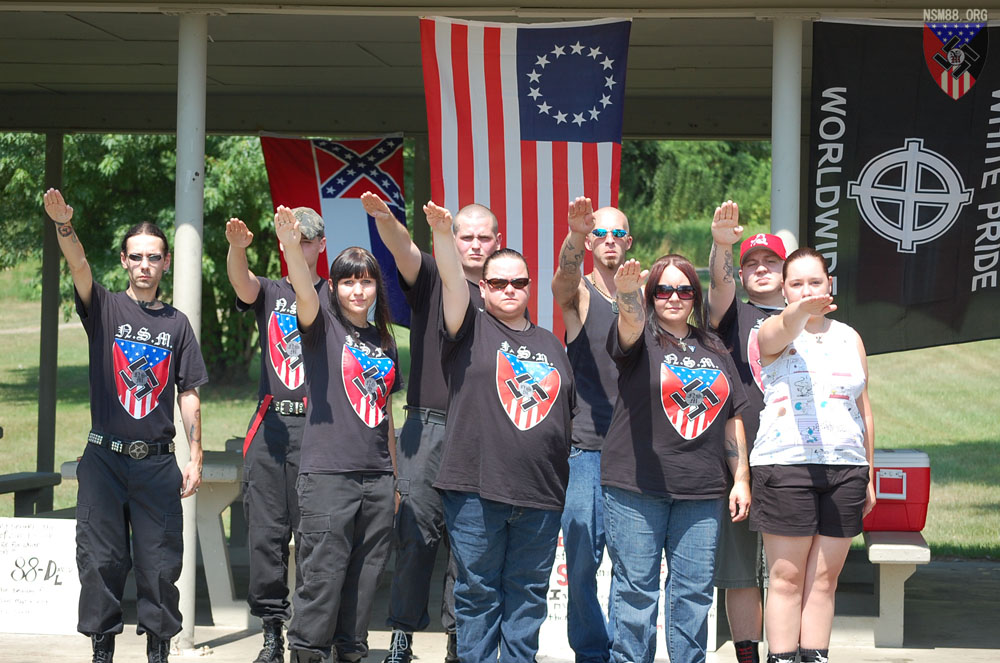
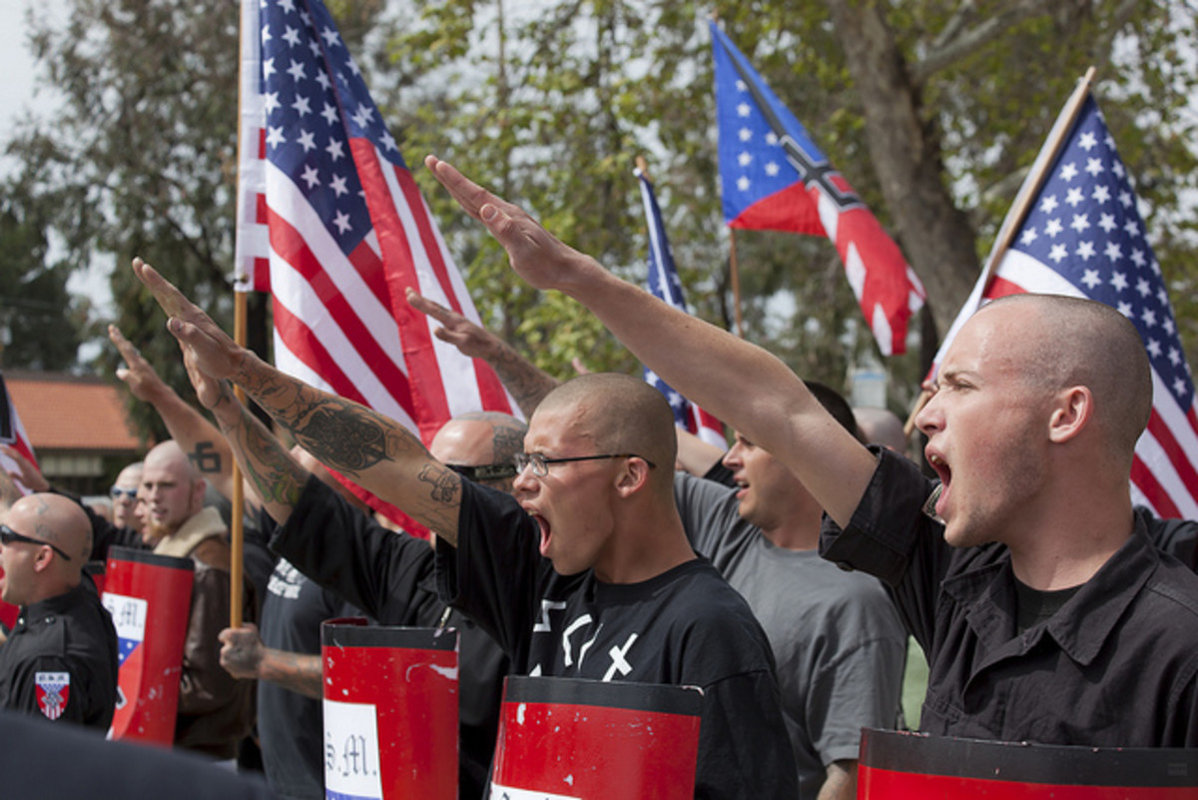
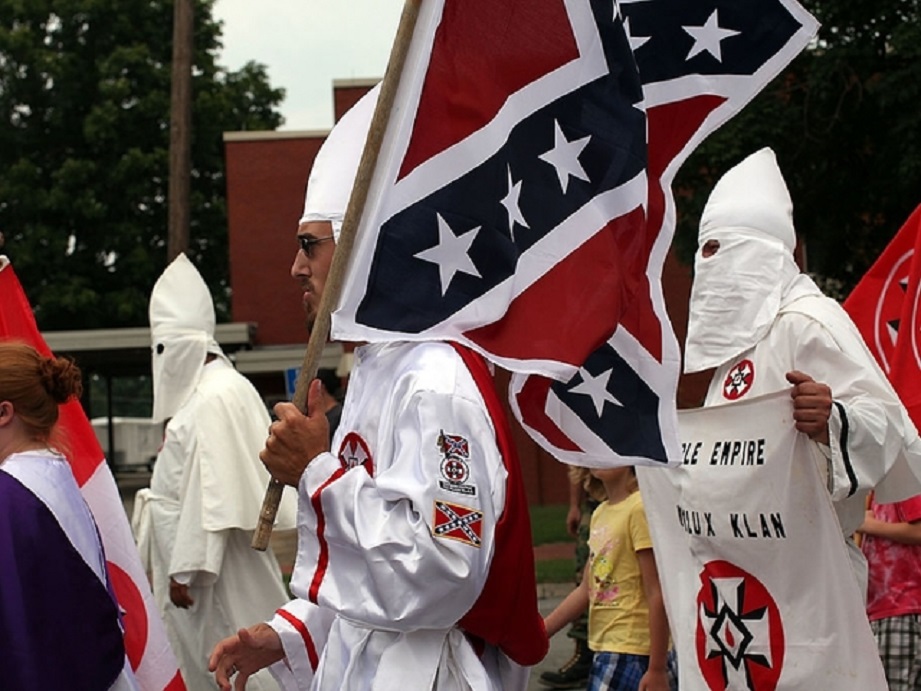 The North Carolina chapter of the Ku Klux Klan will hold a rally at
Charleston South Carolina’s Statehouse to protest efforts to
remove the Confederate battle flag. Tracking the evolution of what's worn by white supremacist groups specifically the KKK shows that they have reached what looks like the end stage of a longterm image overhaul. Racism is inextricable from the character of past- and current-day America, but the election of Donald Trump validated a group that used to feel the need to remain hidden. Accordingly, the clothing of white hate has changed: It, too, has become more mainstream.
The North Carolina chapter of the Ku Klux Klan will hold a rally at
Charleston South Carolina’s Statehouse to protest efforts to
remove the Confederate battle flag. Tracking the evolution of what's worn by white supremacist groups specifically the KKK shows that they have reached what looks like the end stage of a longterm image overhaul. Racism is inextricable from the character of past- and current-day America, but the election of Donald Trump validated a group that used to feel the need to remain hidden. Accordingly, the clothing of white hate has changed: It, too, has become more mainstream.
Sociotropic nationalism explains, too, which particular rats Trump wanted to kill. Trump promised to fight against free trade and immigration on the grounds that they were hurting Americans’ interests by causing economic and social problems “here at home.” Trump had ingeniously come up with a domestic policy almost entirely shaped by the fundamental sociotropic-nationalist binary, us versus them: protectionism to bring back American jobs from abroad; border control to prop up wages at home and keep out terrorists and criminals. If there’s one thing that everyone understands, one heuristic that the poorly informed can use to judge a politician, it’s a politician’s sheer commitment to helping the domestic “us.” What better metric for this commitment than the politician’s obsession with policing the geographical border between us and them? “Without borders,” Trump frequently emphasized, “we don’t have a country.” Trump’s policies, his behavior, his character, and his rhetoric are all “deplorable.” But if we stop our analysis with moral condemnation, we put a cordon sanitaire around him, letting the system that produced him off the hook. He didn’t come from Mars, and his success isn’t inexplicable. To the extent that the explanation isn’t his supporters are crazy or evil, then we have to recognize that something else is at work: that he seems, to many people, to be a politician who finally does what politicians are supposed to do.Trump doesn't seem to understand or believe that individual people choose (or are forced) to migrate. What the president keeps describing is a system where governments shuffle people around based on some non-existent dollar value, and the U.S. should be acquiring specific nationalities as though they were stocks. It's also hilarious that Trump can't wrap his head around why people from Norway, the happiest country in the world, with a robust social safety net and nationalized health care, wouldn't want to move here.But of course, even if the president had a basic grasp of how immigration worked, on literally any level, that wouldn't cover up how nakedly racist this is. And really, it's just a small step away from how racist he's already proven to be as president. We saw some of this already last December, when he allegedly said that all Haitians have AIDS, but the White House quickly came to his defense and denied it ever happened.
 Thousands gather with candles to march along the path that white supremacists took the prior on the University of Virginia Campus in Charlottesville, 16 August 2017.
Thousands gather with candles to march along the path that white supremacists took the prior on the University of Virginia Campus in Charlottesville, 16 August 2017.
This effect was obvious after Trump’s response to a white supremacist rally in Charlottesville, Virginia. After days of silence on the rally, in which dozens of people were injured and one counter-protester was killed, Trump condemned the actions of both the participants and those who protested them “violence on both sides”. White supremacists celebrated. Mr Trump later issued a statement condemning Nazi and white supremacist groups, before again returning to the rhetoric that blamed both sides.Historically, white supremacist beliefs have influenced a myriad of mass efforts to perpetuate racial and ethnic oppression. The mid-Atlantic slave trade imported millions of Africans to the U.S. for forced and involuntary labor, leading to multi-generational servitude and wrongful deaths. Southern Jim Crow laws mandated the legal segregation of public facilities for whites and African Americans, supporting the belief in black inferiority. The disenfranchisement of African Americans at the ballot box was exercised through unfair political gerrymandering, physical intimidation, and deceptive financial penalties, from the Reconstruction period to the modern civil rights movement.Charlottesville, Virginia is home to the University of Virginia, founded by Thomas Jefferson; he was a slave owner, but today stands as a symbol of the US’s egalitarian ethos and political myth. On the eve of the rally, the university’s Charlottesville campus became the site of a march of torch-bearing white supremacists, evoking the Klan rallies seen throughout the 20th century. Tense clashes between marchers and counter-protesters ensued, and the next day, the rally itself turned violent.Radical right marchers turned up along with citizen militia groups (their guns on full display thanks to open carry legislation) and clashed with anti-fascist and other groups who stood up to them. Then 20-year-old James Alex Fields Jr ploughed his car into a group of protesters, and has now been charged with the second degree murder of Heather Heyer, who died after he ran into her.The context for these events is as old as the US itself. The country was borne of violence: a revolution that overthrew British rule, violent suppression of the Native American population, a violent Civil War that took over 600,000 lives, and a philosophy of “manifest destiny” that expanded the American nation across a continent.Much of this violence was social and political. The Civil War has been seen as the true American revolution; it pitted a social and political order based on rugged individualistic capitalism against one of plantation economics and strong social hierarchy, including the system of slavery. The southern model was defeated, the slaves emancipated, and Confederate leaders and sympathisers left to mourn their project as a “lost cause”. But the culture of white supremacy was far from defeated, and radical right-wing social movements and organisations have troubled the US ever since.
But on August 12, some seven months into Donald Trump’s presidency, Charlottesville saw a far uglier side of the US on display: a Unite the Right rally bringing together people and organisations who resented the proposed removal of a statue of Confederate Civil War general, Robert E Lee. The context for these events is as old as the US itself. The country was borne of violence: a revolution that overthrew British rule, violent suppression of the Native American population, a violent Civil War that took over 600,000 lives, and a philosophy of “manifest destiny” that expanded the American nation across a continent.Much of this violence was social and political. The Civil War has been seen as the true American revolution; it pitted a social and political order based on rugged individualistic capitalism against one of plantation economics and strong social hierarchy, including the system of slavery. The southern model was defeated, the slaves emancipated, and Confederate leaders and sympathisers left to mourn their project as a “lost cause”. But the culture of white supremacy was far from defeated, and radical right-wing social movements and organisations have troubled the US ever since.The most notorious group, the Ku Klux Klan, was borne of Southern Democrats’ resentment of emancipation; over the years, it has been invigorated by other radical right groups founded on a powerful ideology of “Christian Identity”, a commitment to the racial superiority of white people and a mission to secure white power and dominance. (The Southern Poverty Law Centre has spent decades documenting and mapping their prevalence, discourses and actions across the US.)Trump failed to name the right-wing violence as white supremacy, or to specifically condemn it; instead, he lamented the violence on all sides.He even managed to stay on the economy when the conversation first turned to Charlottesville. When asked about CEOs leaving his advisory council over his failure to condemn neo-Nazi and KKK violence, he responded, “We want jobs, manufacturing in this country. They’re outside of the country, they’re having their product made outside. We want products made in the country.
This special section of the Seattle Civil Rights and Labor History Project documents the history of Washington State's 1920s chapter of the most infamous white supremacist organization in American history, the Ku Klux Klan (KKK).The Washington State Klan during the 1920s was part of the second of three waves of KKK activity in America. The second KKK was founded in 1915 and gained significant membership immediately following World War I. Though short-lived, it was a powerful anti-immigrant, anti-Catholic, anti-radical, white supremacist organization that promoted "100 percent Americanism." The second KKK claimed over 4 million members across the country; briefly dominated state legislatures of Colorado, Indiana, and Oregon; and in 1924 shaped presidential politics and helped pressure politicians to pass the most severe immigration restriction in the history of the United States. Following immigration restriction and a series of leadership scandals, the second KKK collapsed and was largely moribund by 1928.The second KKK was a mass movement that invoked the memory of and built upon the first KKK, which was a terrorist organization founded by white supremacists in the U.S. South. The first KKK's violent "night riding"-- in which hooded vigilantes used lynchings, whippings, and torture to intimidate recently freed slaves and their white allies -- played a crucial role in the disenfranchisement of African Americans at the end of the Civil War in the 1860s and 1870s and laid a foundation for the rise of Jim Crow segregation in the 1890s and 1900s. The second KKK also helped train some of the leaders who later formed the third KKK, a mainly Southern organization that rose up in the decades after World War II to murder and terrorize people in African-American communities, particularly civil rights movement activists. Klan members' hoods, white robes, and burning crosses made them icons of American white supremacy and terrorism, and their legacy haunts us to this day.The Washington State KKK during the 1920s was founded by organizers from Oregon, which had one of the strongest Klan chapters in the country at the time. The State Klan organized a series of massive public rallies in 1923 and 1924 that ranged from 20,000 to 70,000 people. While they publicly disavowed violence, Klan members participated in violent intimidation campaigns against labor activists and Japanese farmers in Yakima Valley and probably elsewhere. They put forward a ballot initiative in 1924 to prohibit Catholic schools that voters soundly defeated. And though most of the State's Klan chapters collapsed in rancor following the defeat of their anti-private school initiative, a strong presence persisted in Whatcom and Skagit Counties throughout the 1930s. In the 1930s, some prominent leaders in the region's KKK went on to become involved in the facist Silver Legion, or "Silvershirts," a national movement that, while small, was quite active in Washington State. And there is evidence that the Klan in Bellingham helped pioneer intimidation practices that paved the way for anti-communist witch-hunts in the 1940s.
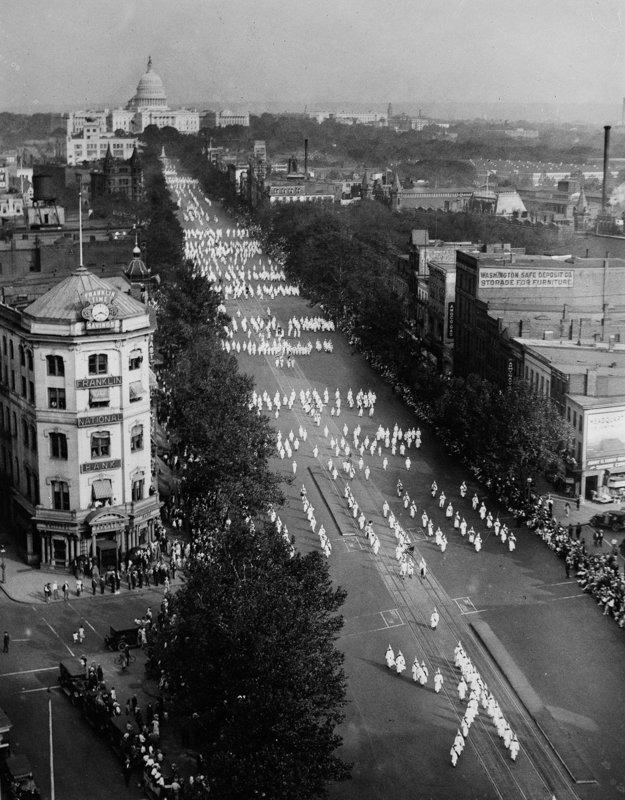
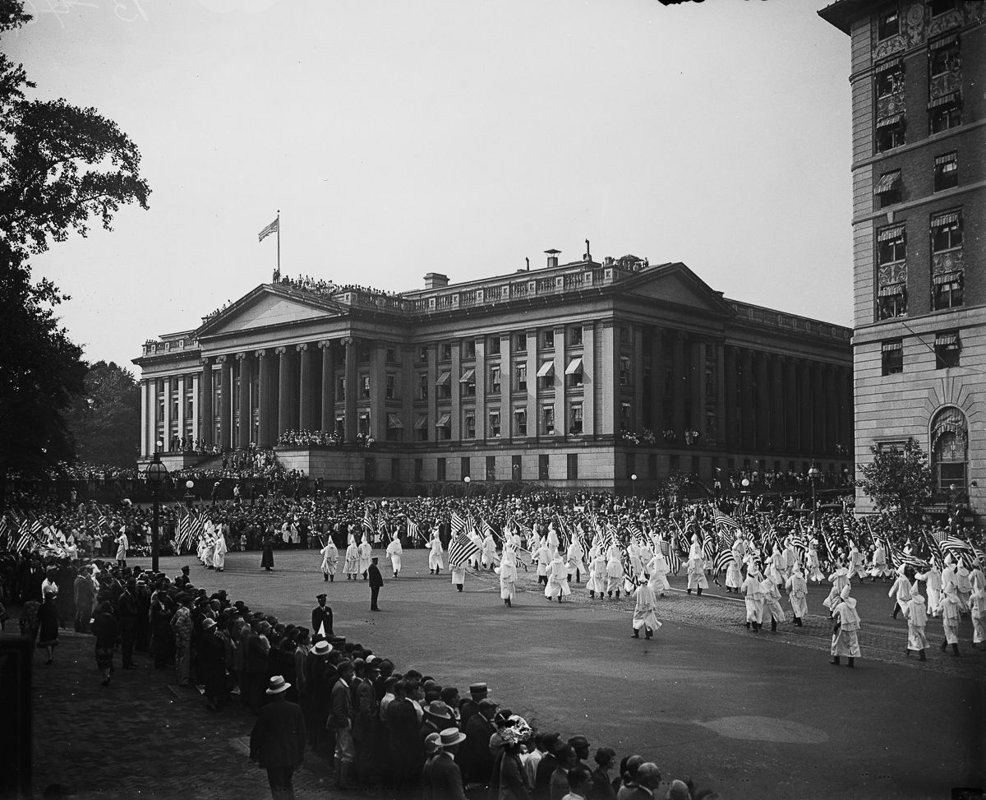
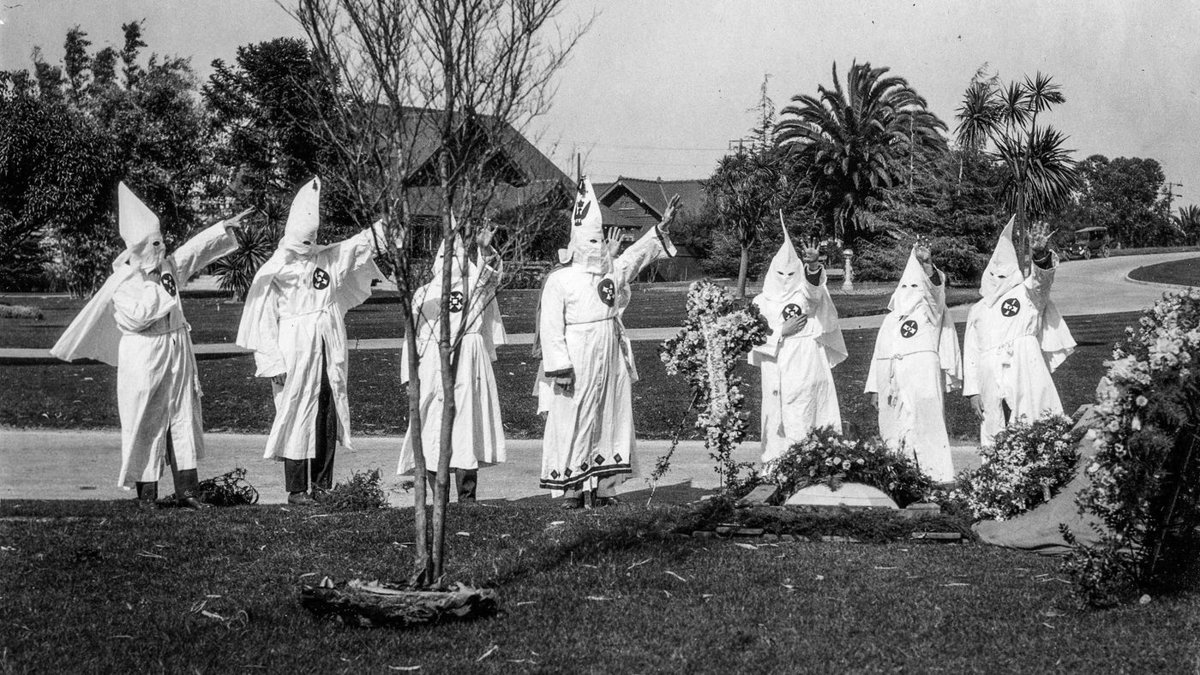 In the early 1920s, the Ku Klux Klan was at the peak of its membership, numbering 3 million strong. The growth of the hate group was fueled by the 1915 release of the silent film Birth of a Nation, which portrayed members as heroes, coinciding with the widespread xenophobia following the devastation of World War I.The KKK's hatred was directed not only against black people, but also against European Catholic and Jewish immigrants flocking to the U.S. after the war.In 1925 and 1926, the Klan descended on Washington, D.C. for two massive marches.
In the early 1920s, the Ku Klux Klan was at the peak of its membership, numbering 3 million strong. The growth of the hate group was fueled by the 1915 release of the silent film Birth of a Nation, which portrayed members as heroes, coinciding with the widespread xenophobia following the devastation of World War I.The KKK's hatred was directed not only against black people, but also against European Catholic and Jewish immigrants flocking to the U.S. after the war.In 1925 and 1926, the Klan descended on Washington, D.C. for two massive marches.
SOME PEOPLE CURRENTLY IN DISCUSSION WITH INTERNATIONAL CRIMINAL LAWYERS TO RESOLVE ISSUE BY DRAFTING LAWSUIT AGAINST THE LEADERS OF MYANMAR'S HUMANITY ICON AUNG SAN SUU KYI AND CHIEF GENERAL OVER ROHINGYAS GENOCIDE.
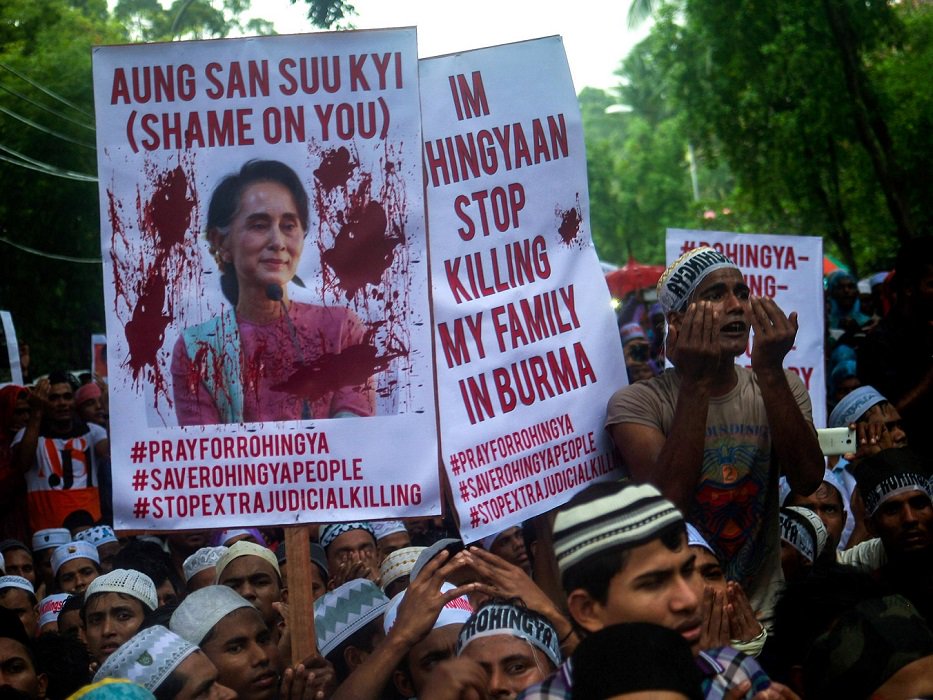
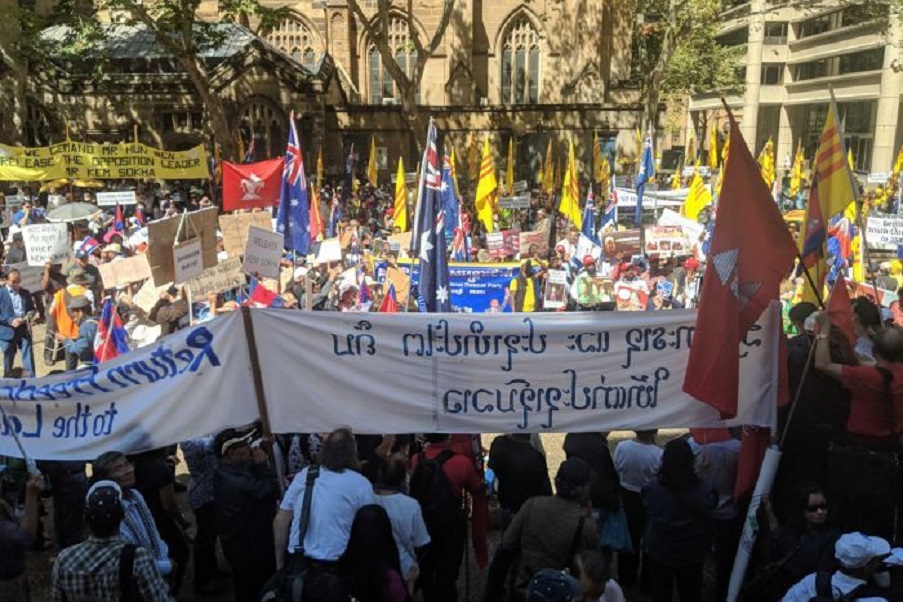
In Rakhine Province of Myanmar (Burma) cleansing of people belonging to the Rohingya Tribe (mostly Muslims and few Hindus and Buddhists), has been going on for last two decades. But this cleansing project of Rohingyas is in full steam now by the Myanmar army and foot-soldiers of the Fascist Buddhist organizations with coming to power of Aung San Suu Kyi, a Nobel Prize recipient for fighting against military rulers of the country. Ironically, this Nobel laureate now supervises genocide of Rohingyas in collaboration with the country’s army and fascist Buddhist cadres.The rampaging killer/raping/maiming/burning gangs sponsored by the Burmese State, Army and Fascist Buddhist organizations have evoked worldwide condemnation including severe repudiation from world forums including UN. Myanmar’s State Counsellor and de facto leader Aung San Suu Kyi in a joint statement said, “It is important to maintain security and stability along the long land and maritime borders of India and Myanmar…India stands with Myanmar over the issue of violence in the Rakhine state which has led to loss of innocent lives.” This statement remained silent on the mass cleansing of the Rohingyas but expressed grave concern on the ‘terrorist’ activities of a section of Rohingyas in self-defence. In a more shocking development the RSS/BJP Indian Government has issued instructions to deport nearly 40,000 Rohingyas who escaped to India while under attack for being security threat.The inimical attitude of the Indian rulers towards Rohingyas is neither accidental nor sudden. It does not seem to be the fall-out of some grave security threat which might have cropped up in the recent past. The rampaging killer/raping/maiming/burning gangs sponsored by the Burmese State, Army and Fascist Buddhist organizations have evoked worldwide condemnation including severe repudiation from world forums including UN. Myanmar’s State Counsellor and de facto leader Aung San Suu Kyi in a joint statement said, “It is important to maintain security and stability along the long land and maritime borders of India and Myanmar…India stands with Myanmar over the issue of violence in the Rakhine state which has led to loss of innocent lives.” This statement remained silent on the mass cleansing of the Rohingyas but expressed grave concern on the ‘terrorist’ activities of a section of Rohingyas in self-defence. In a more shocking development the RSS/BJP Indian Government has issued instructions to deport nearly 40,000 Rohingyas who escaped to India while under attack for being security threat.The inimical attitude of the Indian rulers towards Rohingyas is neither accidental nor sudden. It does not seem to be the fall-out of some grave security threat which might have cropped up in the recent past. The rampaging killer/raping/maiming/burning gangs sponsored by the Burmese State, Army and Fascist Buddhist organizations have evoked worldwide condemnation including severe repudiation from world forums including UN. Myanmar’s State Counsellor and de facto leader Aung San Suu Kyi in a joint statement said, “It is important to maintain security and stability along the long land and maritime borders of India and Myanmar…India stands with Myanmar over the issue of violence in the Rakhine state which has led to loss of innocent lives.” This statement remained silent on the mass cleansing of the Rohingyas but expressed grave concern on the ‘terrorist’ activities of a section of Rohingyas in self-defence. In a more shocking development the RSS/BJP Indian Government has issued instructions to deport nearly 40,000 Rohingyas who escaped to India while under attack for being security threat.The inimical attitude of the Indian rulers towards Rohingyas is neither accidental nor sudden. It does not seem to be the fall-out of some grave security threat which might have cropped up in the recent past. The rampaging killer/raping/maiming/burning gangs sponsored by the Burmese State, Army and Fascist Buddhist organizations have evoked worldwide condemnation including severe repudiation from world forums including UN. Myanmar’s State Counsellor and de facto leader Aung San Suu Kyi in a joint statement said, “It is important to maintain security and stability along the long land and maritime borders of India and Myanmar…India stands with Myanmar over the issue of violence in the Rakhine state which has led to loss of innocent lives.” This statement remained silent on the mass cleansing of the Rohingyas but expressed grave concern on the ‘terrorist’ activities of a section of Rohingyas in self-defence. In a more shocking development the RSS/BJP Indian Government has issued instructions to deport nearly 40,000 Rohingyas who escaped to India while under attack for being security threat.The inimical attitude of the Indian rulers towards Rohingyas is neither accidental nor sudden. It does not seem to be the fall-out of some grave security threat which might have cropped up in the recent past. The Buddhist Rakhine made the false claim against the minority Muslim Rohingya that three Muslim youths raped and murdered a 26 year old woman. It was totally wrong as the minority Muslims did not do this against the Buddhist Rakhine. The woman was raped and killed by a gang of Buddhist Rakhine, one of whom was her boyfriend. There was a dispute between the woman and her boyfriend. The boyfriend tried his best to convince her to be his girlfriend again, but she refused and took a new boyfriend. Then, the ex-boyfriend, accompanied by his two close friends, took revenge by raping and killing her.The Buddhist Rakhine killers placed the dead body near a Muslim village without any knowledge of the murder. The Buddhist Rakhine and the Quaffer Burmese (Myanmar) authority accused Muslims of killing the woman. As a result, three innocent Muslim youths were arrested. One was beaten to death, and the other two were sentenced to death by the court. The government has shown the world that they created a fake issue to instigate a real event against Muslims.The situation of the Muslim Rohingya prior to the beginning of this genocideIn recent months, Rakhine extremists and xenophobes have released anti-Rohingya propaganda inside and outside of Burma by harping on the old slogan, “Rohingya is not a nationality in Burma. They are illegal immigrants from Bangladesh,” with intent to exterminate them ultimately.
Violence between Burma’s (Myanmar’s) mostly Buddhist army and Muslim ethnic Rohingyas in Rakhine State has sharply escalated in the last four days, to the point where it is feared that it may have reached a dangerous turning point.Starting in 2011, Buddhists have been attacking Muslims in villages across Burma, particularly the 1.1 million ethnic Rohingyas in Rakhine State. Mobs of Buddhists have attacked Muslims, conducting atrocities including torture and rape, killing hundreds and forcing hundreds of thousands to leave their homes to flee from the attacks. In some cases, the Buddhists have burned entire Rohingya villages to the ground.The current round of violence was triggered on Friday when Rohingya insurgents carried out a series of coordinated attacks against 30 Burma police outposts and an army base. Using knives, some guns and homemade explosives they killed at least a dozen security force members.The army responded with a sweep of violence against Rohingyas, causing thousands of them to flee their villages and head for the Bangladesh border, where they hoped to cross and reach a refugee camp. The Foreign Ministry of Bangladesh said Saturday that “thousands of unarmed civilians” from Rakhine state had gathered near its border and were “making attempts to enter Bangladesh.” The Burmese army shot them as they were fleeing, including women and children, killing dozens. However, Bangladesh already has 400,000 Rohingyas in its refugee camps and its border guards are refusing to allow any more to enter, and so the Rohingyas trying to flee are hiding out along the border between the two countries. However, an estimated 2,000 Rohingyas have made the crossing.Aung San Suu Kyi and Myanmar military chief discuss transfer of power.Pro-democracy leader holds one-hour meeting with top general Min Aung Hlaing to talk transition after her election victory.Aung San Suu Kyi has held direct talks with Myanmar’s top general for the first time as her party prepares to form the government in a country where the military retains considerable influence after decades of rule.Earlier in the day, the Nobel laureate also held talks with the president, Thein Sein, to discuss the transfer of power to her National League for Democracy (NLD), which swept to victory in elections in November. The support of the military will be crucial for the NLD to govern . Pope Francis said he wept hearing the plight first-hand of Rohingya refugees in Bangladesh, adding that this meeting was a condition set for his trip to Myanmar and Bangladesh.The Rohingya meeting was a highly symbolic gesture of solidarity with the Muslim minority fleeing violence in Myanmar, and the pontiff told journalists on his plane flying back to Rome that the refugees cried as well."I knew that I was going to meet the Rohingyas but I did not know where and how, for me it was one of the conditions of the trip," he said.The usually forthright pontiff walked a diplomatic tightrope during his four days in Myanmar -- the first papal visit to the country -- avoiding any direct reference to the Rohingya in public while appealing to Buddhist leaders to overcome "prejudice and hatred".In Bangladesh he addressed the issue head-on, meeting a group of Rohingya refugees from the squalid camps in southern Bangladesh in an emotional encounter in Dhaka."What Bangladesh has done for them is enormous, it's an example of welcome," he said. "I wept, I tried to do it in a way that it couldn't be seen. They wept too.""I told myself 'I cannot leave without saying a word to them'".The pope told the Rohingya: "In the name of all those who have persecuted you, who have harmed you, in the face of the world's indifference, I ask for your forgiveness."The pope referred to the refugees as Rohingya, using the term for the first time on the tour in Bangladesh after the archbishop of Yangon advised him that doing so in Myanmar could inflame tensions and endanger Christians.The word is politically sensitive in mainly Buddhist Myanmar because many there do not consider the Rohingya a distinct ethnic group, regarding them instead as interlopers from Bangladesh."If I had used the word during an official speech I would have slammed the door," he said, adding: "They already knew what I thought. For me the most important thing is that the message gets through."The pope said he was "very satisfied" with his meetings in Myanmar and hinted that he expressed his opinion far more freely in private conversations with the country's leaders than in his public appearances.More than 620,000 Rohingya have crossed into Bangladesh since a militant attack on police posts in late August sparked a deadly crackdown by the Myanmar military.They have given consistent accounts of mass rape, killings and villages deliberately burned to the ground by soldiers and Buddhist militia. The two countries last month signed an agreement to begin repatriating refugees to Myanmar, but rights groups say they are concerned about plans to house them in camps away from their former homes -- many of which have been destroyed.During his tour the pope led well-attended open-air masses in Bangladesh and Myanmar, which both have small Christian populations.Rights groups have raised concerns about the process, including where the minority will be resettled after hundreds of their villages were razed, and how their safety will be ensured in a country where anti-Muslim sentiment is surging.The signing of the deal came ahead of a highly-anticipated visit to both nations from Pope Francis, who has been outspoken about his sympathy for the plight of the Rohingya.The stateless Rohingya have been the target of communal violence and vicious anti-Muslim sentiment in mainly Buddhist Myanmar for years.They have also been systematically oppressed by the government, which stripped the minority of citizenship and severely restricts their movement, as well as their access to basic services.
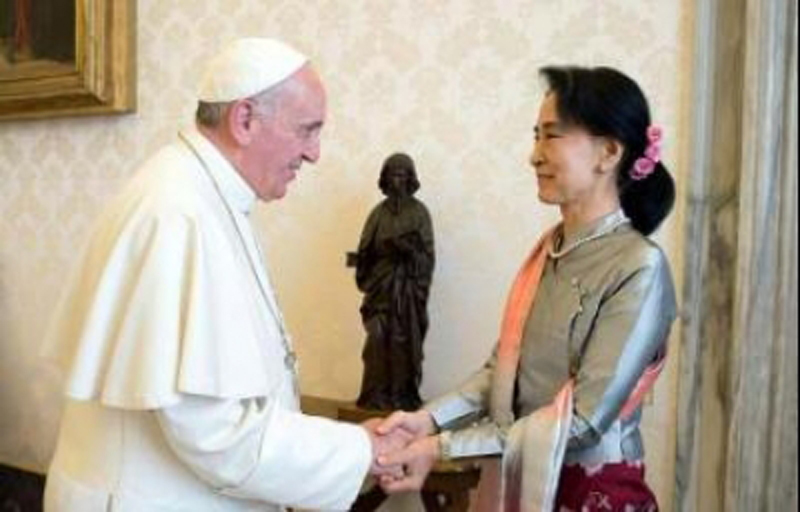 Pope Francis faces diplomatic test in Myanmar visit, where Rohingya flee alleged ethnic cleansing. Pope Francis is known for being outspoken in his support for the poor and downtrodden, particularly refugees.But on this occasion, he is expected have to choose his words carefully. Even using the term "Rohingya" could inflame tensions, the pope has been warned.
Pope Francis faces diplomatic test in Myanmar visit, where Rohingya flee alleged ethnic cleansing. Pope Francis is known for being outspoken in his support for the poor and downtrodden, particularly refugees.But on this occasion, he is expected have to choose his words carefully. Even using the term "Rohingya" could inflame tensions, the pope has been warned.
Myanmar: Why its military dictatorship still survives,the roots of Burma's military dictatorship and the opposition, led by Aung San Suu Kyi.The recent release from house arrest of the iconic Burmese opposition leader Aung San Suu Kyi generated headlines around the world. But more than 2,000 of her colleagues and others remain in detention – a fact which continues to highlight the mutually hostile relationship between the military government and its opponents.Burma (officially known as Myanmar) has the world’s longest surviving military dictatorship. What are the factors responsible for this – and what are the origins of the internal political conflict that has plagued the country for so long?Unlike most Asian and African countries, Burma did not win its independence by conventional civilian-based political agitation. Modern Burma was born partly out of an Allied military struggle against Japanese occupation – a struggle which, by 1945, also involved Burmese forces led by the leaders of what became the country’s post-independence army.A half century of military dictatorship has officially ended in Burma, or Myanmar. The cost has been high, with brutal war and systematic repression finally giving way to nominal civilian rule. Yet taking the final steps toward democracy may be as difficult as making the transition so far.For years it seemed like this day would never come. In 1962 the mystical military strongman Ne Win took control. The junta called an election in 1990, which gave a landslide victory to Aung San Suu Kyi, daughter of a respected independence leader, and her National League for Democracy. The junta voided the results and redoubled repression.But six years ago the so-called State Peace and Development Council transformed itself into a nominally civilian regime, with the military receding into the background. Suu Kyi, now a Nobel laureate, was released from house arrest. The transition was marred by imposition of a constitution which cemented military power, continuing violations of civil and political liberties, and wide scale persecution of the Muslim Rohingya. But free elections were held last November, in which the NLD overwhelmed candidates from the regime’s Union Solidarity Development Party, including cabinet members, party chairman, and parliamentary speaker.To that extent, Burma’s iconic military heritage is similar to that of Robert Mugabe’s Zimbabwe or to mid to late 20th-century Indonesia or even to the Caudillo (military leadership) tradition in post-independence 19th-century South America.In Burma the embryonic military, known as the Burma Independence Army, was first formed during the Second World War by anti-colonial Burmese nationalists in collaboration with the Japanese. Under Japanese occupation it became the Burma Defence Army (1942) and then the Burmese National Army (1943). As the war began to turn against Japan, the BNA switched sides and, supporting the Allies, became the Patriotic Burmese Forces.
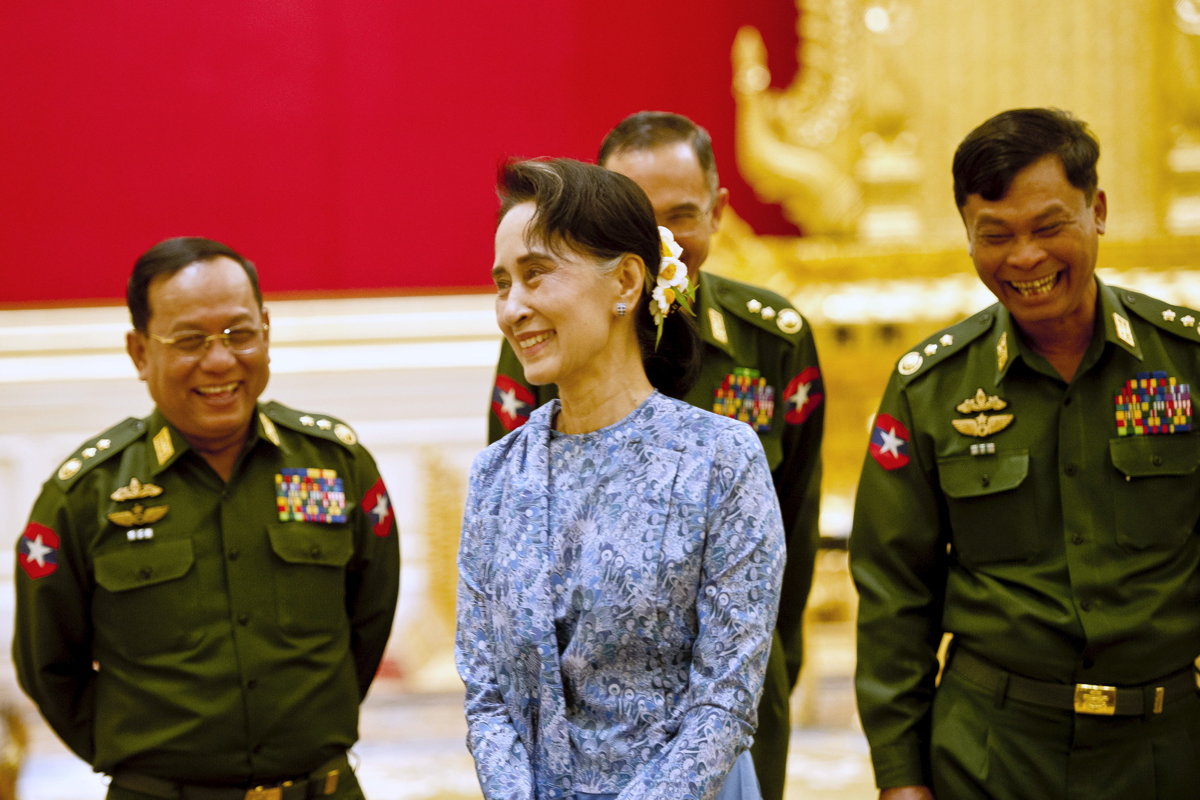 Aung San Suu Kyi and Myanmar military chief discuss transfer of power.Aung San Suu Kyi has held direct talks with Myanmar’s top general for the first time as her party prepares to form the government in a country where the military retains considerable influence after decades of rule.Earlier in the day, the Nobel laureate also held talks with the president, Thein Sein, to discuss the transfer of power to her National League for Democracy (NLD), which swept to victory in elections in November. The support of the military will be crucial for the NLD to govern .
Aung San Suu Kyi and Myanmar military chief discuss transfer of power.Aung San Suu Kyi has held direct talks with Myanmar’s top general for the first time as her party prepares to form the government in a country where the military retains considerable influence after decades of rule.Earlier in the day, the Nobel laureate also held talks with the president, Thein Sein, to discuss the transfer of power to her National League for Democracy (NLD), which swept to victory in elections in November. The support of the military will be crucial for the NLD to govern .


